| TRUE |
Chair |
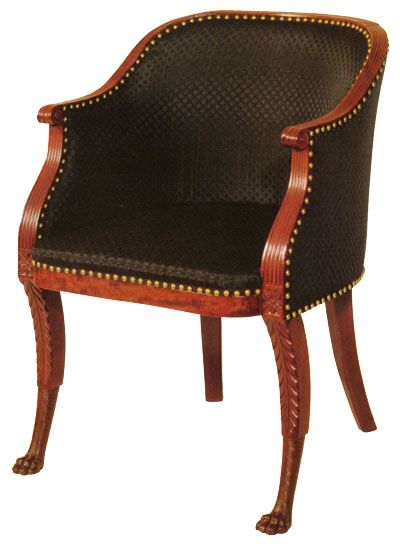 |
1810-1820 |
Probably Duncan Phyfe |
New York |
Mahogany, pine (unidentified softwood), horsehair upholstery |
32 x 24 x 24" |
|
Purchase, 1976 |
According to notes of Berry Tracy, this chair is said to have been made for John Brevoort in 1817. Purchase, Mrs. John Kane of Tuxedo, NY. Purchased from Israel Sack, 11/23/1976. |
0 |
|
A similar chair, probably a mate, was auctioned at Christie's New York on January 16, 1998, lot 283. That chair retains an old and possibly original finish and appears to have a similar upholstery history to Boscobel's chair. |
This bergere-type easy chair has a reeded mahogany cap outlining the barrel-back frame. The half-upholstered mahogany-veneered front rail bows forward. Scrolled handholds project at the arm terminals. The saber-shaped front legs have waterleaf carving, carved fur begins just below midpoint. The legs end in animal paw feet that appear to be carved from the solid. The chair frame is made of thick mahogany rails. The sweep rear legs continue above the rails to form the rear stiles. Upholstered in replacement black horsehair (formerly T 77.27). |
Upholstered by Sack Conservation Company in black horsehair acquired from Scalamandre per Sack invoice of May 31, 1977 (see T 77.27) |
Furniture |
17 |
| TRUE |
Sofa |
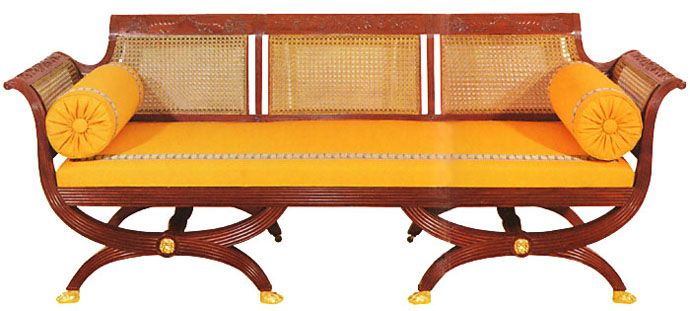 |
1815-20 |
Probably Duncan Phyfe |
New York City |
Mahogany, cherry [?] medial braces, cane, wool moreen upholstery |
31 1/8 x 98 x 24 1/2" |
|
Purchase, 1970 |
Believed to have been made for Nathaniel Prime (1768-1840) of New York City, thence by descent to Julia Haskell, of Garrison, NY. Purchased by William C. Kennedy for Boscobel in 1970. |
0 |
|
Similar sofas are in the collection of The Metropolitan Museum of Art; Museum of Fine Arts, Boston; and a private collection (according to Peter Kenny, 9/98). Also see F 76.4 (set of 12 chairs), F 76.7 (stools), and F 76.48 (sofa). |
Carved mahogany sofa with caned back in three rectangular panels. The crest rail rolls backward and is carved into three panels: a central panel of bow-knotted crossed leaf sprays flanked by panels exhibiting pairs of fruit-and-grain-filled cornucopias. Reeding on the posts of the back extends into the crest rail to divide the panels. The arms roll outward and have caned sides. The crest-like tops of the arms are carved panels of foliage like the central panel of the crest. The front seat rail of the sofa is reeded. The frame is reinforced by four medial stretchers. The sofa stands on paired curule legs, also reeded, that terminate in a molded cuff immediately above cast brass paw feet. A gilded lion's head mask decorates the crossing of each curule base. Upholstered in yellow reproduction wool moreen with blue and off-white woven silk tape. |
A copy of this sofa was made in the twentieth century (see F 76.48). |
Furniture |
10 |
| TRUE |
Set of twelve side chairs |
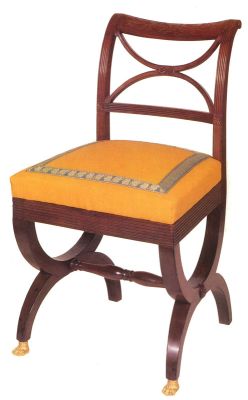 |
1815-20 |
Probably Duncan Phyfe |
New York City |
Mahogany, tulip poplar medial braces, white pine seat frames [CHECK], cane, wool moreen upholstery |
32 3/4 x 17 3/4 x 16 1/4" Overall dims: H: 32-5/8 W: 18 D: 22-3/4 |
1/12: chair number "XII", seat frame "XI". "Benjamin Nov 1925" on inside of proper left medial brace. "Hagen" and "repaired by E F Hagen 2/3 E 26" on outside of proper right medial brace. "May 1, 192" in pencil on inside of proper right seat rail, the last number of the date covered by a new corner block. "Hagen new rosette / new cross" in pencil on inside of front rail. 2/12: chair number "XXIII", seat frame "VIII". 3/12: chair number "II", seat frame "I". 4/12: chair number "XXII", seat frame "X". 5/12: chair number "XVII", seat frame "XVII". 6/12: chair number "XVIII", seat frame "XVII". 7/12: chair number "XXIIII", seat frame "XXIIII". "Benjamin Nov 1925" in pencil on outside of proper right medial brace. "Hagen"[illegible] 26" in pencil on inside of proper left medial brace. 8/12: chair number "XIII", seat frame "VII". 9/12: chair number "XX", seat frame "XX". "Benjamin [illegible]" on outside of proper left medial brace. "Hagen [illegible]" on inside of proper right medial brace. 10/12: chair number "III", seat frame "III". 11/12: chair number "XI", seat frame "III". "Hagen 2/3 26" in pencil on inside of front rail. 11/12 [there are two of this number, none with 12/12]: chair number "1", seat frame "IIIIII". "Hagen 2/3 E 26" in pencil on inside of proper left seat rail. |
Purchase, (4) 1970, (8) 1976. |
Believed to have been made for Nathaniel Prime (1768-1840) of New York City, thence by descent to Julia Haskell of Garrison, NY, and Sarah B. Anderson, Hingham, MA, from whom the set was purchased in 1970 and 1976. |
0 |
|
The Metropolitan Museum of Art has similar suite of curule-based furniture, by family tradition made for New York merchant Thomas Cornell Pearsall. Another pair of curule side chairs is in the Diplomatic Reception Rooms, The Department of State, Washington, DC. A side chair at Winterthur (64.24.2), see Montgomery, p. 124-125. A pair of chairs from the Prime set was auctioned at Sotheby's New York in January 1994. Also see F 76.10 (sofa) and F 76.7 (stools). |
Set of twelve curule-based side chairs from a set that originally numbered at least twenty four. The crest rail rolls backward and is bowed in the center. It is carved with crossed leaf sprays en suite with sofa F 76.10. Two circle segments forming a curule shape joined with a rosette within an octagon form the chair back. The rear stiles are reeded from the stay rail to the crest and have rosettes within squares at the juncture of the reeded stay rail. The reeded seat frame has two front-to-back braces half-dovetailed into front and rear seat rails. The curule shaped legs at each side are joined by a turned medial stretcher. The front legs terminate in gilt brass paw feet. The seat is caned. A framed seat, added to the chair at a later date, is upholstered in yellow wool moreen with blue and off-white woven silk tape. It fits in place atop the caned seat. |
As of 2/16/2018 three of the chairs are in the rear drawing room and nine are in the front drawing room [kc] |
Furniture |
11 |
| TRUE |
Chest of Drawers |
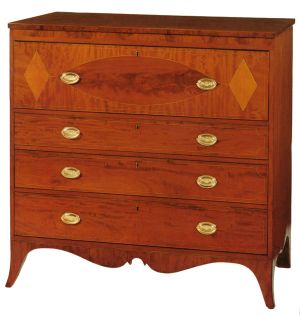 |
1800-c. 1808 |
Michael Allison (1773-1855) |
New York City |
Mahogany, satinwood, light and dark stringing, tulip poplar, white pine, brass hardware. |
45 x 45 1/2 x 22 3/4" |
Label inside top drawer reads: "M. AL[LISON]/CABINET[MAKER] / NO. 42, VESEY STREET / (NEAR THE BEAR MARKET) / NEW-YORK / Who has a general assortment of warranted / ready made furniture o[n hand.]" with wigglework border. Original oval brasses marked "H J" |
Purchase, 1977 |
Mrs. Elsie E. Bishop Purchase, Frederick W. Stanyer 12/3/76 |
0 |
|
Northeast Auctions, August 5-7, 2011, pg. 144 |
The chest of four drawers has a deep top drawer with three shallower drawers below, graduated in size from shallow at the top to deep at the bottom. The top drawer is veneered with a central oval panel of figured mahogany outlined with light wood stringing, flanked by inlaid diamond panels of satinwood. Background mahogany veneer on this drawer has mitered corners. The three veneered drawers below are outlined with light wood stringing. The skirt has a central concave element flanked by deep ogees that flow into French feet. The framed top supports a thin mahogany board and has cross-banded edges. A frieze of matched veneer panels separates the top from the upper blade of the large drawer. The back of the chest has a wide vertical batten in the center into which side panels are channeled. Drawer fronts are veneered white pine; drawer sides and bottoms are tulip poplar. Original brasses with eagle and garland design. |
Mr. Berry Tracy's notes state, " In New York between 1800 and 1810, a distinctive model of bureaus evolved with a deep top drawer, called by the cabinetmakers a "tablet drawer". This deep drawer was intended for storage of bulky materials such as coverlets and blankets. Since the late 19th century, the drawer has been called by the antiquarians and furniture enthusiasts a blanket drawer, relating it in thought and use to its earlier prototype, the blanket chest, which had a deep upper compartment and a hinged lid. The eyes of the cabinetmaker of neo-classical New York, the deep drawer became the frieze of an entablature analogous in concept to the tablet and cornice of an architectural looking glass or mantle piece. Accordingly, he treated this visually awkward space with currently fashionable, decorative veneer patterns and inlays, making it a successful focal point of the entire bureau. This bureau, which bears the printed label of Michael Allison, shows his address at 42 Vesey Street, where he first opened his shop in 1800. He remained there until 1816 when he moved to 50 Vesey Street. Numerous labeled examples of similar Allison bureaus have appeared and disappeared on the market in the last twenty years. Like the Boscobel examples, they all have eagle brasses and satinwood diamond panels, either stripped or plain and variously inlaid with a rose, lily of the valley, eagle, shell or feather and cross". |
Furniture |
62 |
| TRUE |
Sofa |
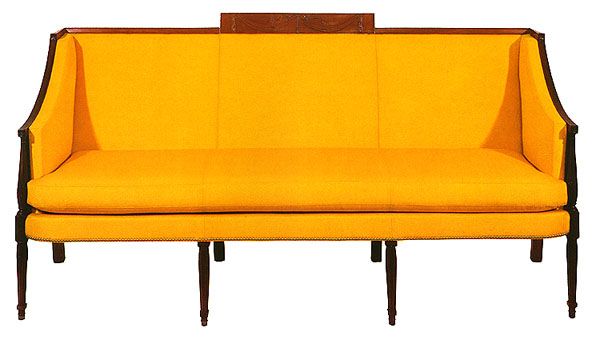 |
1805-1815 |
Unknown |
New York City |
Mahogany, cherry [?] medial braces, ash rails, wool moreen upholstery |
40 x 79 x 25" |
|
Purchase, 1960 |
Israel Sack, Inc., New York, NY |
0 |
See Phelps, Warren, "Setting the Record Straight, Slover and Taylor, New York Cabinetmakers," Antiques, LXXX (October 1961) 350-351 (in file)0 |
See Joseph Butler book (1985)Field Guide to American Antique Furniture page 232 (JP) |
The square-back upholstered sofa has exposed mahogany framing the back. A projecting rectangular panel in the center of the crest is carved with drapery and a central tassel. The tops of the side arms are reeded and curve downward to meet a freestanding baluster-turned arm support carved with reeding and stylized leaves. Carved rosettes decorate the ends of the arms. The four front legs are turned and reeded and leaf carved. They terminate in square cuffs above turned and tapered feet. The four rear legs are square in section and flare backward. Three cherry cross braces reinforce the seat frame. Upholstered in reproduction wool moreen. |
Attributed to Slover and Taylor, New York, by Israel Sack, Inc., but that attribution requires substantiation. Abraham Slover & Jacob Taylor: c. 1792-1805 (in partnership 1802-1805) New York. |
Furniture |
1 |
| TRUE |
Set of armchair and three side chairs |
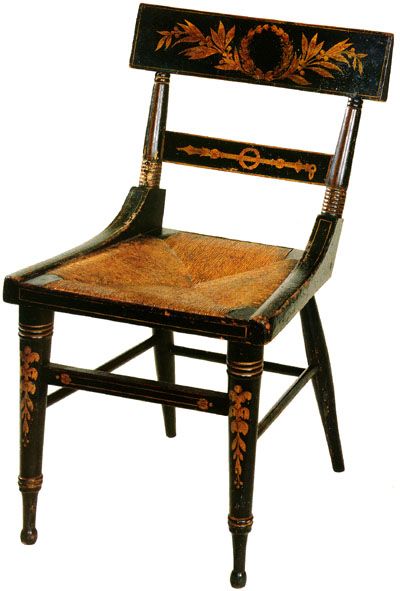 |
1825-1840 |
Unknown |
New York or Albany |
Mahogany, maple, ash, tulip poplar |
32 x 22 x 18"--Arm 33 x 18 x 16"--Side |
|
Purchase, 1962 |
Presumed descent in the Dyckman-Cruger families. Sold in the Henderson House sale, Parke-Bernet Galleries 10/62, lot 125, where the chairs are identified as "ex-collection, Douglas Robinson." Sold with the six side chairs no. F 64.6. |
0 |
|
|
The armchair and three side chairs have a broad "tablet" crest rail, rolled back at the top and gently bowed across the front, supported by turned rear posts joined by a flat stay rail. The side seat rails are klismos shaped. The seat is rushed. The chair has two heavy turned and tapered front legs joined by a flat stretcher and lighter turned rear legs joined to the front legs and to each other by single turned stretchers. The chair is painted dark green with stenciled gold and red leaf sprays emanating from a central wreath on the crest, leafage down the legs and a arrow device on the back slat. The present dark green color was probably blue originally and has since turned green as varnish yellowed. See also F 64.6 |
|
Furniture |
23 |
| TRUE |
Pair of armchairs |
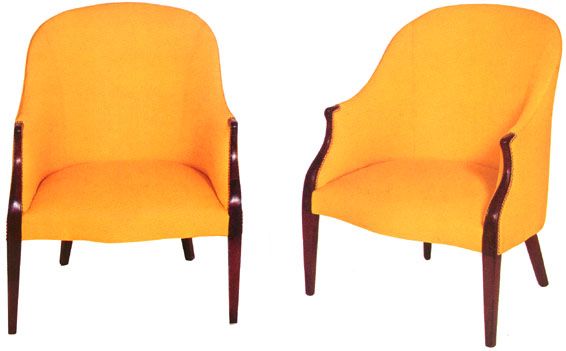 |
1800-1825 |
Unknown |
Probably England |
Mahogany, beech, wool moreen upholstery |
39 1/4 x 29" |
|
Purchase, 1976 |
Boscobel Restoration, Inc. Board minutes from 1976 list "Pair of Horsehoe Oval Back Armchairs from Livingston House" Oral tradition of descent in the Livingston Family, possibly from Clermont, home of Robert Livingston Callendar House sale, Tivoli, NY Purchase, O. Rundle Gilbert, 1969 |
0 |
|
|
The pair of mahogany "cabriole" or "bergere" armchairs has a curved and upholstered back and sides with an arched crest. The carved molded front face of the handhold and ogee curve below are faced in mahogany that continues down to the square tapered front legs. The front seat rail is serpentine shaped. Upholstered in reproduction yellow wool moreen. |
|
Furniture |
3 |
| TRUE |
Sofa |
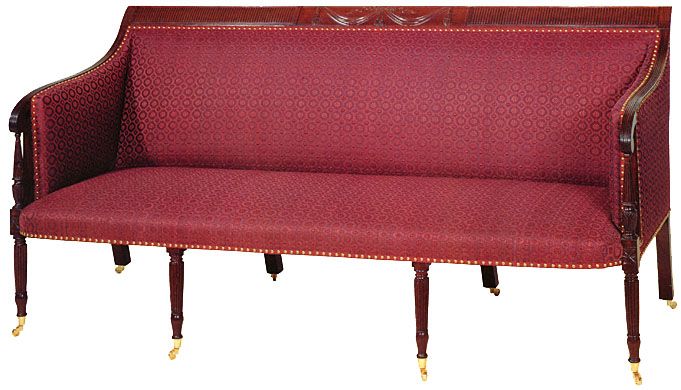 |
1805-1815 |
Possibly Duncan Phyfe |
New York City |
Mahogany, tulip poplar, ash, white pine |
37 x 78 x 33" |
|
Purchase, 1977 |
Purchase, Joe Kindig, York, PA 1977 |
0 |
|
|
Carved mahogany square-back sofa has a rolled crest rail with a central panel of bow-knotted drapery swags flanked by vertical fluting. The straight sides and arms are curved along the reeded mahogany top. The downward rolled handholds join the top of a freestanding turning with stylized leaves carved into the urn-shaped base. The upholstery covers the front rail. The sofa stands on four turned and reeded front legs that end in bulbous feet with brass ferules and casters. The four rear legs are square in cross section and flare backward. Four curved braces running front to back are dovetailed into the seat frame. Upholstered in reproduction red patterned horsehair (T 77.16). |
The Tracy catalogue identifies the date of this sofa as "c. 1811" but offers no supporting evidence. |
Furniture |
4 |
| TRUE |
Set of four side chairs |
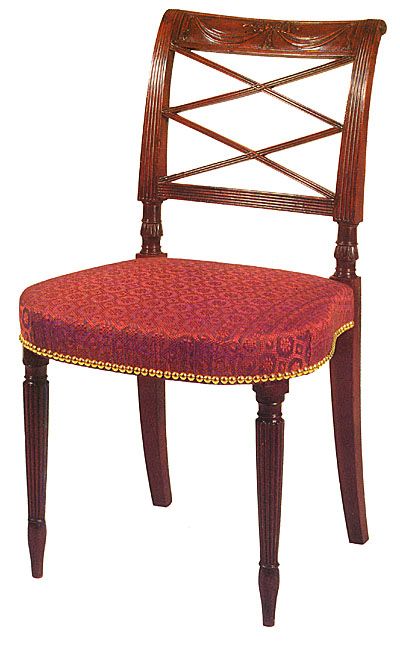 |
1805-15 |
Probably Duncan Phyfe |
New York City |
Mahogany, mahogany veneer, ash, maple, gumwood, horsehair upholstery |
33 x 19 1/8 x 17 1/4" |
Chair "A" has "VIIII" scratched into the inside of the cross braces. "B" has "X". "C" has "I". "D" has "III". Each chair bears a label of "WALTER VOGEL / FINE ANTIQUE FURNITURE", a dealer in western New York, pasted to the inside of the proper right cross brace. "D" also bears the date "Mar. 17 1932" in pencil on the label. |
Gift of Rufus K. Dryer II, 1978 |
Rufus K. Dryer II, Rochester, NY |
0 |
Nancy McClelland, Duncan Phyfe and the English Regency 1790-1830, New York, 1939. Page 276, plate 263. |
|
Set of four double-crossback side chairs. The rolled crest bows slightly across the front and is carved with drapery supported in the middle by a bowknot and tassels. The reeded rear stiles roll backward slightly and are supported between the seat rails and stay rail by a columnar element above stylized leaves carved into the front and sides but not the back. The seat is balloon-shaped. The turned and tapered front legs are reeded and stand on bulbous turned feet. The rear legs are square in section and flare backward. Upholstered in reproduction red patterned horsehair cloth (formerly T 77.16). |
Fabric acquired from Old World Weavers, 3/8/77. |
Furniture |
5 |
| TRUE |
Set of one armchair and 6 side chairs |
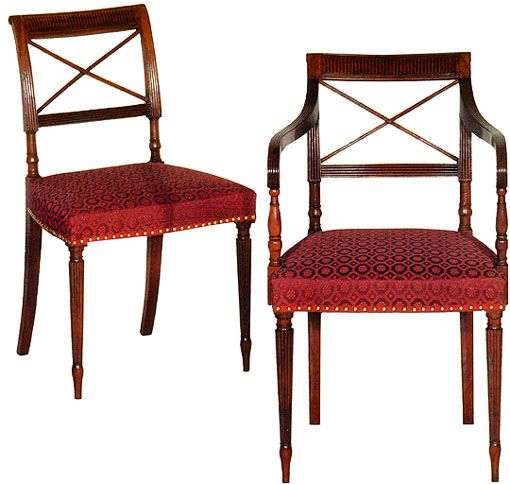 |
1805-1815 |
Possibly Duncan Phyfe |
New York City |
Mahogany, mahogany veneer, ash, tulip poplar, horsehair upholstery |
32 1/2 x 19 1/2 x 17" |
|
Purchase, 1976 |
Purchase, Clifford Buisch, Rochester, NY 1976. The invoice specifies 5 side chairs and 1 armchair, although Boscobel collection records, presumably from about that time, list 6 side chairs, which is how the set is published in Tracy. |
0 |
|
|
Set of seven carved mahogany chairs, comprising one arm and six side chairs. The back is a single cross or X shaped splat set within reeded stiled that roll backward gently. The rolled crest bows gently and has vertical flutes carved into the panel. The bowed stay rail is reeded. The chair back is supported on columnar elements below the stay rail. The ash seat rails bow outward slightly and are covered by upholstery. The straight rear seat rail is mahogany veneered. Two medial braces are half-dovetailed into the front and rear rails. A reproduction red horsehair cloth (formerly T 77.16). |
Fabric acquired from Old World Weavers, 3/8/77 (formerly T 77.16) |
Furniture |
7 |
| TRUE |
Armchair |
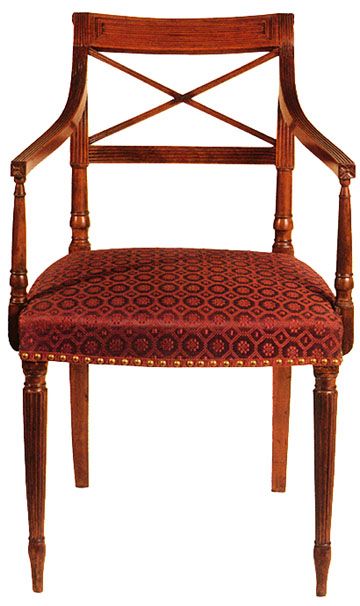 |
1805-20 |
Possibly Duncan Phyfe |
New York City |
Mahogany, mahogany veneer, ash, maple, gumwood or tulip poplar, horsehair upholstery |
33 1/4 x 20 5/8 x 17 1/3" |
"X" is marked on the inside of each cross brace. |
Purchase, 1962 |
Tradition of ownership in the Dyckman family Purchased from John Conover, Ossining, NY, in 1961 among a large group of objects reportedly from Cruger and Dyckman families. Relationship to Cruger and Dyckman families is unsubstantiated. |
0 |
|
Mate to this chair at Winterthur (57.1043). See Charles Montgomery, no. 70, p. 123. |
Carved mahogany armchair has a rolled-back rectangular crest rail with two bands of paired reeds around a center band of three horizontal reeds. The arms have four reeds set within a squared edge molding and terminate in X shaped rosettes. The single cross back is lapped and made of elements decorated with three reeds. The turned front legs are reeded except for the inside segment. The rear rail is ash with mahogany veneer. Two scooped maple braces run from the front to the rear rail. The seat is upholstered in reproduction red horsehair cloth (formerly T 77.16). |
Fabric acquired from Old World Weavers, 3/8/77 (formerly T 77.16). |
Furniture |
8 |
| TRUE |
Pair of side chairs |
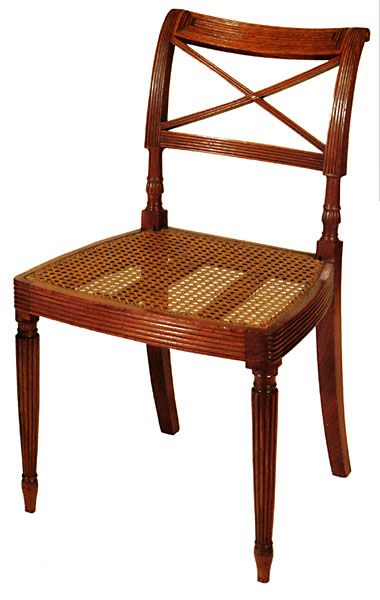 |
1805-1820 |
Unknown |
New York |
Mahogany, tulip poplar, cane |
31 7/8 x 18 7/8 x 16 3/8" |
|
Purchase, 1962 |
Ex collection Douglas Robinson, Parke-Bernet Galleries, sale 2127, October 5-6, 1962, lot 107. Possible descent in the Henderson family. |
0 |
|
Berry Tracy Collection, Sold Feb. 1, 1985 for $3,300 Sotheby's Auction |
The pair of carved mahogany caned side chairs have single cross backs and a slightly rolled and concave crest rail. The rectangular crest rail has carved double reeds around a center "motif" of three horizontal reeds with hollowed out ends. The rear stiles below the lower back rail are turned columns with a flared and reeded element below. The seat rails are reeded on the outside. The turned front legs are reeded and terminate in swelled feet. Two tulip poplar cross braces are dovetailed into the front and rear rails. There appear to be no chair numbers on these chairs. |
|
Furniture |
9 |
| TRUE |
Pair of stools |
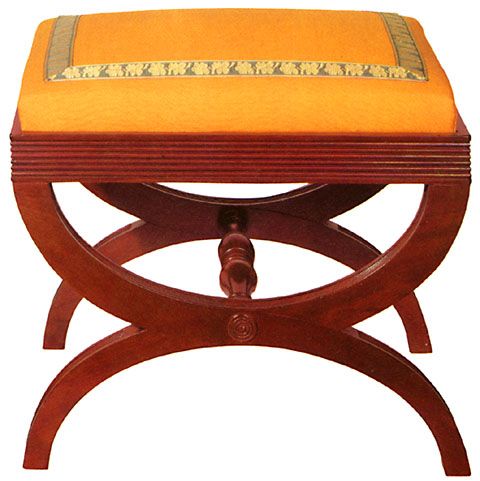 |
c. 1925 |
Probably Ernest Hagen Company |
New York City |
Mahogany, ash rails, white pine seat frame, wool moreen upholstery |
15 7/8 x 15 3/4 x 20 1/2" |
|
Purchase, 1976 |
Mrs. Julia Haskell, a descendent of Nathaniel Prime Purchase, William C. Kennedy 1976 |
0 |
|
For other Prime pieces, see F 76.10 (sofa), F 76.4 (chairs) and F 76.43 (stool from Sarah Anderson). |
Pair of carved mahogany curule based stools, with rectangular, reeded seat frame above reeded curule supports joined by a baluster turned stretcher. The slip seat is upholstered in reproduction yellow wool moreen (formerly T 77.2). |
These stools are listed as "2 Benches" on William C. Kennedy invoice, and were purchased with two sofas and four chairs. Another curule based stool, F 76.43, purchased from Julia Haskell's sister Sarah Anderson, is also supposed to have come from Nathaniel Cox Prime, but has a different stretcher and is upholstered over the rail. |
Furniture |
12 |
| TRUE |
Stool |
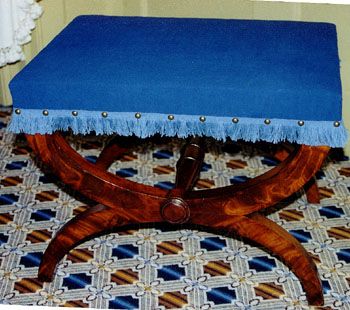 |
1825-35 |
Unknown |
New York City |
Mahogany, mahogany veneer, ash, and wool upholstery |
16 1/2 x 16 1/2 x 21" |
|
Purchase, 1976 |
Acquired in 1976 from Mrs. Alan N. (Sarah Benjamin) Anderson, a direct descendant of Nathaniel Prime. For other Prime furniture, see F 76.10 (sofa), F 76.4 (chairs), and F 76.7 (stools). |
0 |
|
For other Prime pieces, see F 76.10 (sofa), F 76.4 (chairs) and F 76.7 (stools from Julia Haskell). |
Carved mahogany rectangular stool with a curule base. The legs are veneered and joined by a turned stretcher. The seat is upholstered in reproduction blue wool formerly T 77.33) , with blue tape and fringe; on a plain curule base with angular turned stretcher. |
|
Furniture |
0 |
| TRUE |
Pair of stools or ottomans |
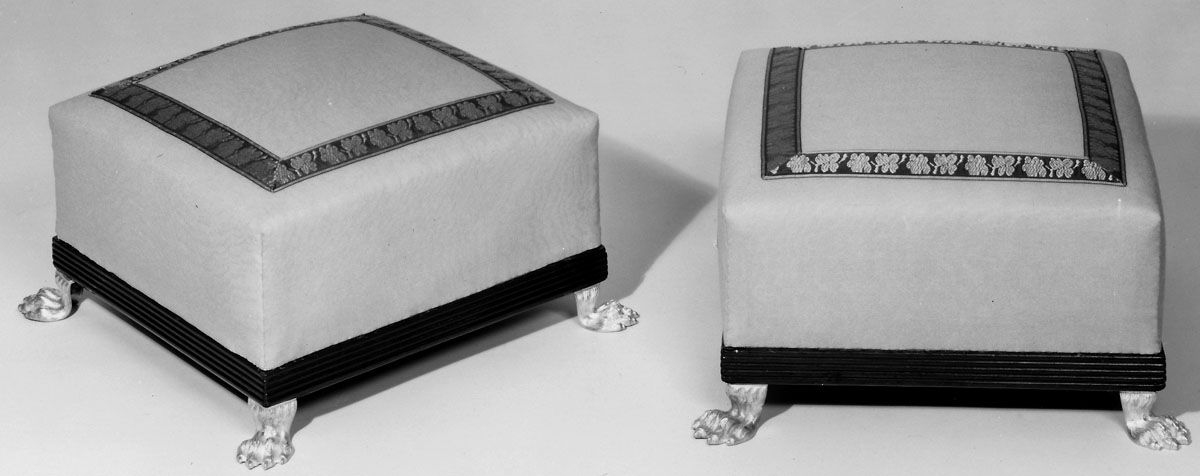 |
1815-1830 |
Unknown |
New York |
Mahogany, white pine, gilt brass, wool moreen upholstery |
9 x 15 x 15" |
|
Purchase, 1976 |
Purchase, Barbara DeSilva, Garrison, NY |
0 |
|
|
Pair of square mahogany stools, sometimes called "ottomans." The upholstered boxes are trimmed along the bottom edge with mahogany molding decorated with four reeds and stand on cast brass and gilded animal paw feet. Upholstered in reproduction yellow wool moreen with blue and off-white woven silk tape. |
|
Furniture |
13 |
| TRUE |
Armchair |
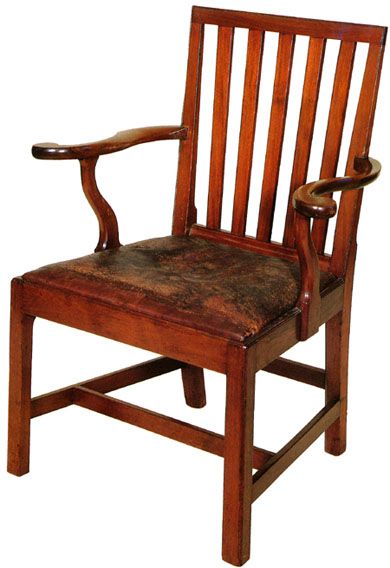 |
1780-1800 |
Unknown |
Probably New York |
Mahogany, unidentified softwood (probably Atlantic white cedar), cherry seat frame, leather |
38 x 30 1/2 x 23" |
"Douglas" is all that is still legible in an ink inscription on a 20th century label pasted on the inside of the rear seat rail. |
Purchase, 1976 |
Unsubstantiated oral history of ownership by Peter Corne (1722-1807), Elizabeth Dyckman's grandfather. Sold by Parke-Bernet Galleries, from Henderson House, sale 2127, October 5th & 6th, 1962, lot 301, as Robinson-owned with the notation "Collection of Peter Corne". Purchase, Reader's Digest (William C. Kennedy) 9/15/76 |
0 |
|
|
The mahogany armchair has a slightly flaring square back enclosing five vertical slats set into a shoe with a cove molding. A bead is cut into the outer edge of the rear stiles and crest rail. The ogee or S shaped arms are attached to ogee arm supports. The trapezoidal slip seat fits within rectangular seat rails with molded top edge. The front legs are marlborough with a bead in the outer corner. "H" stretchers and a single stretcher between the rear legs. The slip seat is upholstered in old, replacement dark red leather. |
Other very similar chairs are known with reliable histories of ownership in Litchfield, Conn., and in Islip, Long Island. |
Furniture |
14 |
| TRUE |
Armchair |
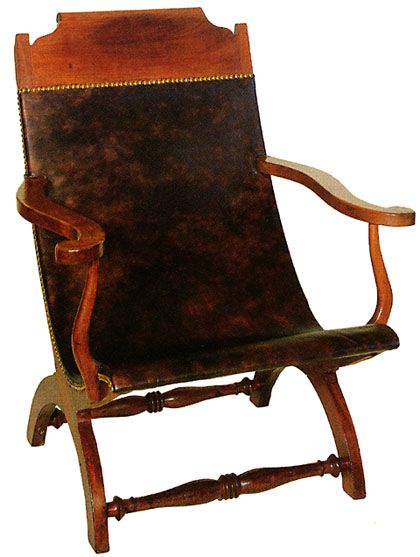 |
1805-1840 |
Unknown |
Probably Mexico |
Mahogany, leather |
37 x 29 x 30" |
|
Gift of Berry B. Tracy, 1978 |
|
0 |
Diane Ehrenpreis, " The Seat of State: Thomas Jefferson and the Campeachy Chair," in American Furniture, edited by Luke Beckerdite (Hanover, NH: University Press of New England for the Chipstone Foundation, 2010), pp. 25-53 Priddy, Erby and Huffman, "The one Mrs. Trist would chuse": Thomas Jefferson, the Trist Family and the Monticello Campeachy Chair" in American Furniture, edited by Luke Beckerdite (Hanover, NH: University Press of New England for the Chipstone Foundation, 2012, pp. 22-56 |
See Puig, American Craftsmen and European Tradition, fig. 11. El Mueble Mexicano: Artes de Mexico 16, no. 118 (1969) illustrates three examples demonstrating a broad tradition of this form in Mexican furniture (figs. 105, 121-22). The Thomas Jefferson Memorial Foundation has campeachy chairs owned by Jefferson. Winterthur has a reeded example in the manner of Duncan Phyfe (64.143) made of mahogany, with a tulip poplar front seat rail and a hard pine bottom stretcher. |
Mahogany curule-based lolling chair, also called a "campeachy" or "Spanish" chair, with brown leather sling seat, serpentine arms on S-shaped arm supports. Turned stretchers join the bottoms of the front and rear legs. The crest rail rolls back in the center section and has ogee shaping where it joins the rear stiles. The tops of the stiles are chamfered toward the rear. |
"Campeachy" refers to Campeche, a state in southeast Mexico comprising most of the Yucatan peninsula. |
Furniture |
15 |
| TRUE |
Side Chair |
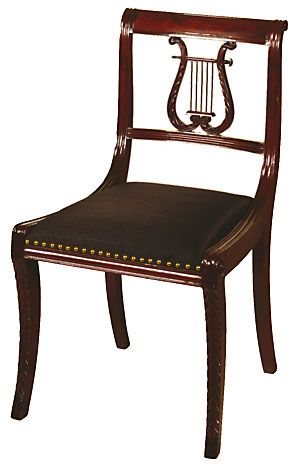 |
1815-1825 |
Probably Duncan Phyfe |
New York City |
Mahogany, mahogany veneer, brass, ebony, ash, tulip poplar, horsehair |
33 x 19 x 18" |
"VIII" is stamped into the top of the front seat rail and into the slip seat frame. |
Gift of Berry B. Tracy, 1978 |
Unsubstantiated history of descent in the Henderson family. Benjamin West Frazer Berry B. Tracy |
0 |
Nancy McClelland, Duncan Phyfe and the English Regency, 1795-1830, p 280, pl. 267. Tracy A. Keegan, "Musical Chairs…and More," Colonial Homes, vol. 25, (April/May) p. 58. |
A set of seventeen lyre-back chairs made for Charles Ludlow are owned by The Metropolitan Museum of Art (5) and the Henry Ford Museum (12). See McClelland. Berry Tracy Collection, sold Feb. 1, 1985 for $12,100, Sotheby's Auction |
The mahogany side chair has a lyre back with stylized leaf carving on the lyre and five brass-rod strings with an ebony key. The rectangular crest rail, with a figured mahogany inset panel, rolls back at the top and is slightly bowed. The rear stiles are molded and curve into the tops of the side seat rails. The front seat rail is ash with a molded mahogany facing. The front saber legs have stylized leaves carved into them that come within 1-1/2 inches of the floor. The trapezoidal slip seat, upholstered in black horsehair cloth outlined with brass nails, is held in place by screws through the centers of the front and rear seat rails. The mahogany veneered ash rear seat rail is installed with double tenons. |
This chair is part of a large set made between 1815 and 1820 for the Henderson family, most of which is still owned by descendants. For information about lyres in New York furniture, see Philip D. Zimmerman, "The American Sofa Table," Antiques 155, no. 5 (May 1999): 749-51. |
Furniture |
16 |
| TRUE |
Two armchairs and four side chairs |
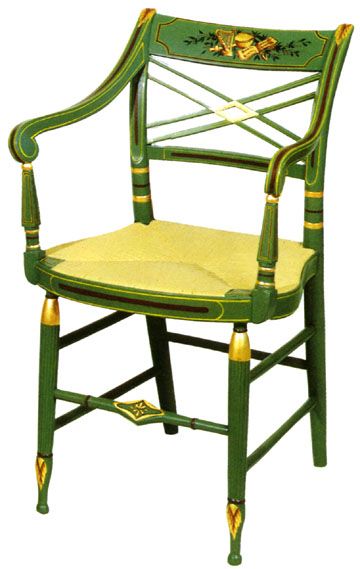 |
1805-1820 |
Unknown |
New York |
Maple, ash, whitewood, rush |
Arm--32 1/2 x 20 x 16 1/4" Side--32 1/2 x 19 x 16 1/4" |
|
Purchase, 1976 |
Acquired from dealer Robert Herron of Austerlitz, NY, who stated that the chairs came from the Fulton Ludlow House in Claverack, NY. |
0 |
|
Abigail Adams Smith Museum, New York, NY, has a similar settee, painted red. The Wunsch collection of the New York State Museum has a set of fancy furniture with similar leg turnings, painted red, with landscapes painted on the crest rails. |
The assembled set of six green fancy chairs includes two arm chairs from different sets and four matching side chairs. All of the chairs have thumb backs and rectangular crest rails painted in gold with musical trophies on a green ground. The balloon shape rush seats have thin casings attached to the outside edges. The reeded front legs are turned and tapered, ending in ball feet. All chairs were repainted in 1977. |
Twelve green and gold cross back chairs and a pair of settees to match were purchased by Elizabeth Dyckman from New York chairmaker Henry Dean on January 15, 1808. The Tracy catalogue states that five of these six chairs were believed to have come from Boscobel, but a review of evidence does not support this claim. Six reproduction chairs and two settees were made to match (F 77.10). According to Fred Stanyer (January 29, 1999) the six old chairs came in a cream, black and gold paint finish, and he did not know if they were stripped to the wood before being repainted. The green color was based on a set of green painted furniture at the Henry Ford Museum. Chair back cross pieces replaced by Englehard & Koenig Inc, 402 E. 70th St. New York, 2/28/77 Decorative painting done by William Bartsch, Wallkill, NY, 6/7/77 Rush seats by Rose LaMesa, Winsted, CT, 6/1/7 |
Furniture |
19 |
| TRUE |
Settee |
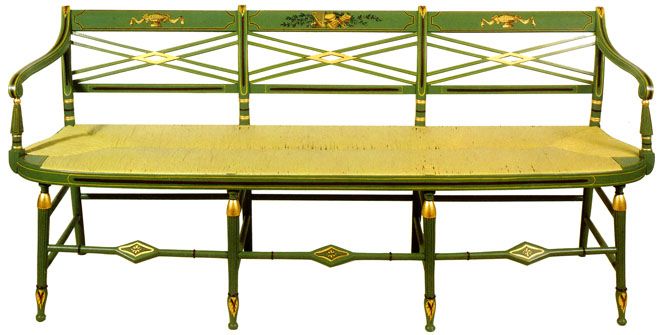 |
1977 |
Unknown |
New York |
Maple, ash, whitewood |
Settee--32 1/2 x 72 1/2 x 20 3/4" |
|
Reproduction, 1977 |
|
0 |
|
|
Suite of reproduction paint-decorated rush-seat fancy seating, comprising two three-back settees and six side chairs, made to match F 77.9 |
Settee copied from a cross-back settee of 1808-1810 in the Abigail Adams Smith Museum, New York. According to Fred Stanyer (January 29, 1999), the settee was based on one at Israel Sack, Inc., New York, NY. |
Furniture |
20 |
| TRUE |
Sampler |
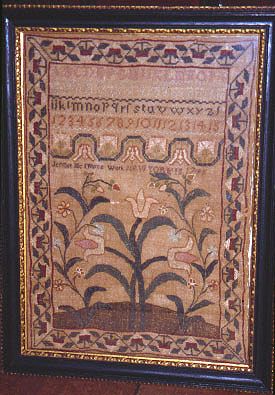 |
1795 |
Jennet McIntire |
New York |
Linen, wool |
17 x 12" (sight) |
"Jennet McIntires work NEW YORK in 1795" in needlework across upper middle. |
Purchase, 1977 |
Mrs. Valentine Parker, The Cupola, Ridgewood, NJ 10/77 |
0 |
|
|
Framed sampler, on linen ground cloth, embroidered in dark green and shades of orange and brown wool, with central floral motif and alphabet and numbers above. Signed "Jennet McIntires work NEW YORK in 1795". |
|
Textiles |
0 |
| TRUE |
Pair of card tables |
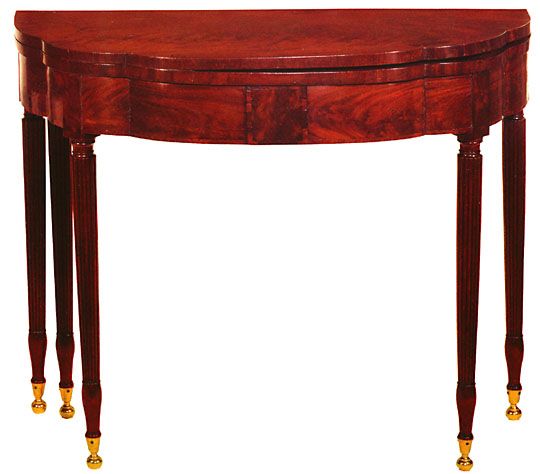 |
1805-1820 |
Possibly John Dolan or Michael Allison |
New York |
Mahogany, cherry, white pine, brass ferrules |
29 1/2 x 36 x 17 1/2" |
|
Purchase, 1976 |
Ex-collection, Metropolitan Museum of Art Israel Sack, Inc, New York, NY 5/76 |
0 |
|
Similar tables labeled by John Dolan can be found in the Museum of the City of New York(illustrated as fig. 6 in Philip D. Zimmerman, "New York Card Tables, 1800-1825," in American Furniture 2005 [Chipstone], p. 123) as well as in the Gracie Mansion Collection, New York, NY. Michael Allison stamped a double elliptic card table of this form. Card table with reeded legs and treble elliptic top labeled by Dolan in Antiques 80, no.4 (October 1961):298. |
The pair of card tables with a triple elliptic top and frame and five legs. The frame is made of five laminated layers of white pine with book-matched figured mahogany veneer on the outside. A square panel with cross-banded border marks the center of the front. The table stands on five reeded and tapered legs with swelled feet ending in brass ball ferules. The fifth leg is attached to a cherry swing rail to support the hinged top leaf. The fixed top is made of four pine boards glued up to create the width. The ends have oblique battens. The hinged top is veneered on both sides. |
The Dolan attribution, first advanced in the Tracy catalogue, is complicated by a couple of similar tables labeled by Allison, which need to be examined for structural comparisons, as do the two labeled Dolan examples at the Museum of the City of New York and Gracie Mansion. Dolan is listed as a cabinetmaker in New York City directories from 1802-1814. From 1815-1824 Dolan ran a hardware store. |
Furniture |
26 |
| TRUE |
Bed |
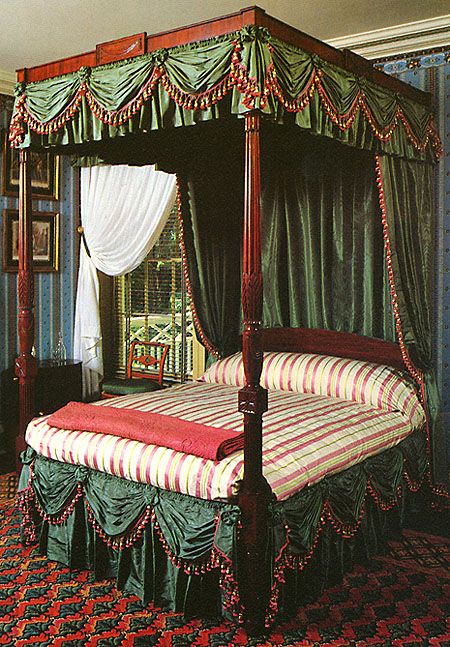 |
1805-1820 |
Possibly Duncan Phyfe |
New York City |
Mahogany |
100 1/2 x 77 3/4 x 59 3/4" |
|
Purchase, Bed: 1977 Cornice: Gift of Thomas Kyle, 1977 |
Descended in the Tatham family of New York. Bedstead purchased from Fenton. L.B. Brown, New York City, 11/1/76, who stated that it was made for the Tatham family, owners of the Tatham "Shot" tower during the 18th century in lower New York City. Cornice: Gift of Thomas Kyle, Goshen, NY 1977 |
0 |
|
A bed with nearly identical carved footposts is in a private collection in Waterford, VA, 1999. This bed has Alexandria, VA, provenance back to at least 1850. |
High post bedstead of carved mahogany with cornice from another source. High headposts, reeded, slightly swelling, with fluted collars flanking an arched headboard; the footposts reeded with upright acanthus collars and an urn-form member with drapery swags, rosetted dies below, on stop-fluted supports continuing to reeded baluster legs. Flat paneled tester with central medallion. |
The posts and rails are numbered with chisel marks around the bed, with the numbering beginning and ending at the proper left head post. |
Furniture |
49 |
| TRUE |
Bed |
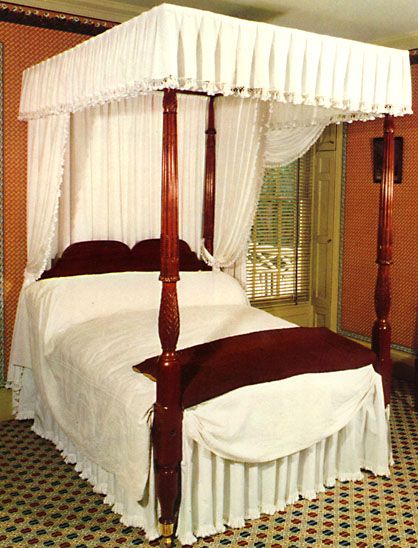 |
1810-1820 |
Unknown |
New York City |
Mahogany |
95 x 78 x 59 3/4" |
|
Purchase, 1976 |
Purchased from Joe Kindig, York, PA, 9/9/1976 |
0 |
|
|
Carved mahogany tester bedstead with matching head and footposts, all with reeded sections enriched with wheat ears and leaf collars above baluster members carved with upright stylized water leaves, on turned legs ending in brass caps, double-arched headboard, tester. Reproduction white striped dimity curtains. |
|
Furniture |
50 |
| TRUE |
Secretary Bookcase |
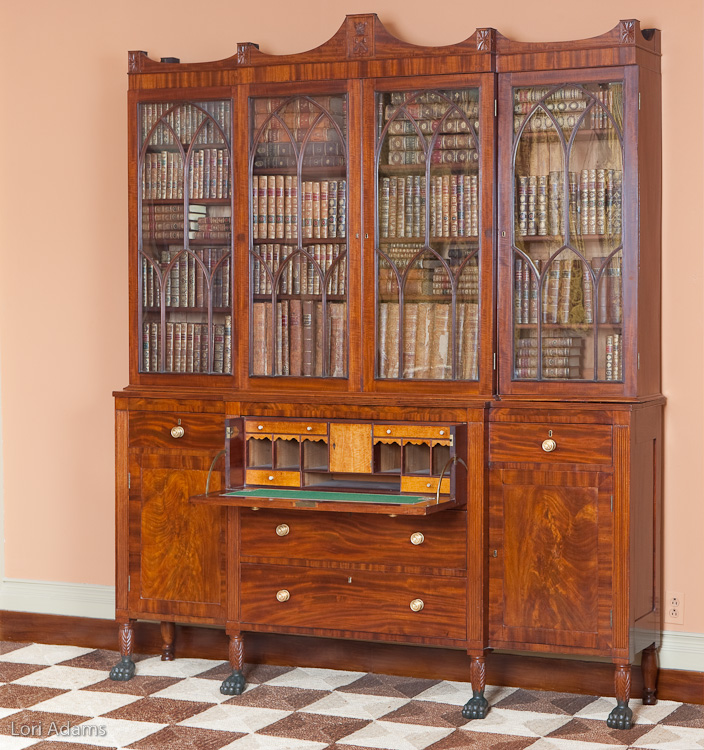 |
1810-1820 |
Unknown |
New York City |
Mahogany, satinwood, tulip poplar, white pine |
94 1/2 x 78 1/2 x 16 5/8 (center), 14 5/8 (wings)" |
|
Purchase, 1977 |
Descended in the family of Thomas Witter Chrystie, a New York attorney William Few Chrystie Parke-Bernet Galleries, Inc., January 13-15, 1949, lot 436 Purchased from Joe Kindig, York, PA, 8/9/1976. |
0 |
F. Lewis Hinckley, A Directory of Antique Furniture (New York: Crown, 1953) p. 353, fig. 1097. Charles Knowles Bolton, Bolton's American Armory (Boston: F. W. Faxon Co., 1927) p. 34. |
|
The secretary bookcase has a one-piece cornice that fits over the three-part bookcase section, screwed together, that in turn sits on the one piece base. The cornice has a central armorial armorial panel bearing the arms of the Chrystie family. Four stylized rosettes mark the tops of the sides of each bookcase section. The bookcase doors have pointed arch glazing bars and open to adjustable shelving. The middle of the three sections projects slightly. The lower case is deeper than the upper. The projecting center section has three drawers, the top one of which is a secretary or writing drawer with hinged drawer front, baize writing surface, and interior of small drawers and pigeonholes. The interior drawer fronts are satinwood veneer on mahogany. At each side of the center drawers are cupboard doors with a single drawer above. Reeded panels decorate the end and middle stiles of the lower case. The top of the lower case is reeded. The lower case stands on turned legs. The legs in front are carved with stylized leaves and end in animal paw feet (replaced in 2009) painted an antiqued bronze color. The rear feet are uncarved and end in ball feet that bear remnants of early paint, probably an antiqued bronze. The back boards of each section are framed panels. The side panels of the lower case are recessed. The drawer fronts in the lower case are mahogany veneer on white pine with tulip poplar sides and bottoms. |
The top center tablet depicts the Chrystie coat of arms, which consists of a phoenix rising from flames and a crest with a chevron dividing three wells. The family motto was "malo mori quam foedari." This representation is seen on a bookplate of Thomas Witter Chrystie. |
Furniture |
72 |
| TRUE |
Cellarette |
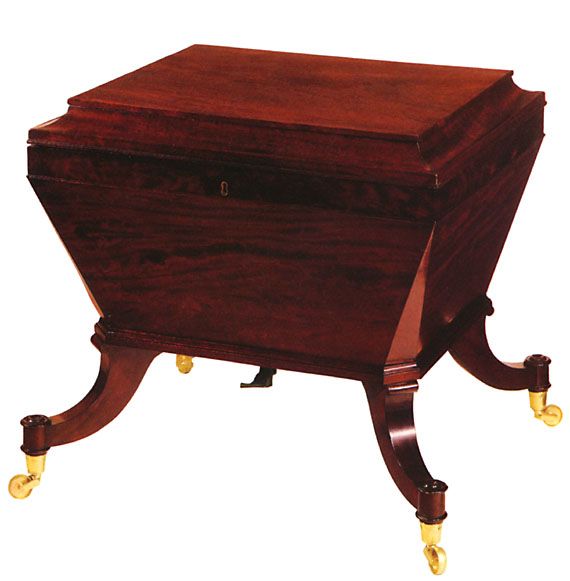 |
1815-1830 |
Possibly Duncan Phyfe |
Probably New York City |
Mahogany, pine, zinc lining, brass spigot |
22 3/16 x 26 3/16 x 23 1/2" |
|
Purchase, 1976 |
Undocumented history of ownership and use in the Callendar House, Tivoli, N Y; home of the Johnston-Livingston family, 1810-1820 Purchase, O. Rundel Gilbert, Garrison, NY 5/1/76 |
0 |
|
|
Mahogany cellarette, or wine cooler, the hinged top with covered edge opening to a zinc lined interior, the truncated case with chamfered corners and scrolled supports ending in gilded brass casters. |
|
Furniture |
42 |
| TRUE |
Sideboard |
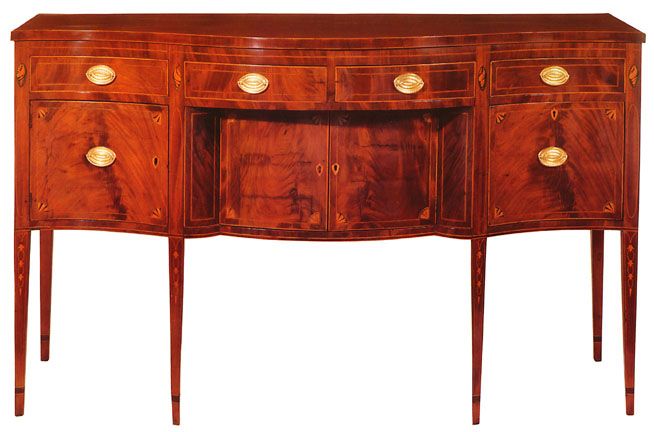 |
1790-1810 |
Unknown |
New York |
Mahogany, tulip poplar, white pine, light and dark stringing and inlays. |
28 x 69 1/2 x 42 3/4" |
|
Purchase, 1970 |
Purchase from Teina Baumstone, 807 Madison Ave., New York, NY 1970 |
0 |
|
|
The mahogany and mahogany veneer six-legged sideboard has a serpentine front. The conforming top is framed and has a cross-banded edge. The top tier of four drawers includes two side-by-side drawers in the center section above recessed bowed cupboard doors flanked by rectangular panels and a cupboard door on the proper right and a large drawer on the proper left. Oval shells are inlaid near the top of each leg stile. The cupboard doors have inlaid fans in the corners. String inlays border the drawers, doors, and other elements. Bellflowers are inlaid on the square tapering legs which also have banded cuffs. The drawers and outer cupboard door have oval brasses in the centers. The drawer fronts are white pine with mahogany veneer. Drawer sides and bottoms are tulip poplar. |
Mr. Berry Tracy's notes refer to this as the oldest sideboard in the Boscobel collection. He states that it is typical of the best New York case furniture of the Hepplewhite taste. Brasses appear to be original. Through tenons in the backboards have longitudinal wedges. |
Furniture |
38 |
| TRUE |
Pembroke Table |
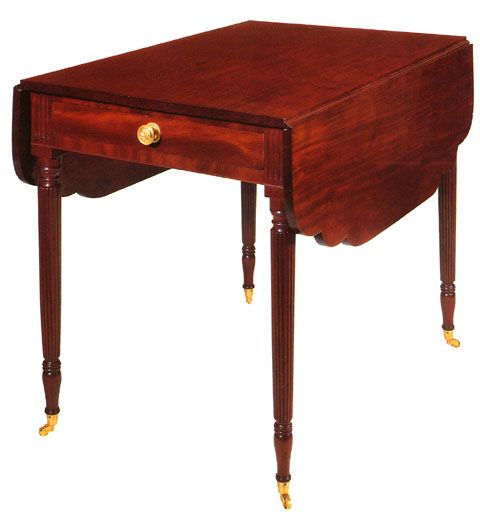 |
1813-1820 |
Probably Charles Christian or Elisha Blossom Jr. |
New York City |
Mahogany, tulip poplar, cherry, white pine. |
29 x 24 1/2 (leaves down) x 46 1/2 (leaves up) x 36" |
|
Purchase, 1970 |
Purchased from William C. Kennedy Assoc, Inc. in 1970. |
0 |
|
|
The mahogany drop-leaf Pembroke or breakfast table has "elliptic" leaves (with three lobes in each corner) and stands on four reeded and tapered legs with multiple rings at the bottom, ending in bulbous turnings and brass casters. A triangular hinged "fly" supports each hinged table leaf. A mahogany veneered drawer is at one end and a false drawer at the other. The drawer front is white pine and the sides and bottom appear to be tulip poplar. The tops of the leg stiles flanking the drawer opening have an unusual treatment of four flutes, which also occur on a table labeled by Christian. |
Charles Christian (working 1798-1826) labeled a very similar table illustrated in Peter M. Kenny, "From New Bedford to New York to Rio and Back: The Life and Times of Elisha Blossom, Jr., Artisan of the New Republic," in American Furniture 2003 (Chipstone), pp. 239-269, fig. 13. Elisha Blossom, Jr., (1789-1823) worked for Christian. |
Furniture |
33 |
| TRUE |
Tall Clock |
 |
1789-1796 |
Effingham Embree, (1759-1817) |
New York City |
Mahogany, light and dark inlays, tulip poplar, brass and iron |
8' 4" x 19 1/2" x 9 5/8" |
"Effingham Embree / NEW YORK" painted on dial; "WILSON" stamped into false plate; "G. Layman [?] - 3 - 75" in pencil across top inside of door, probably identifying someone who worked on the clock in 1975. |
Purchase, 1976 |
Purchased from Joe Kindig, York, PA, 8/9/1976. |
0 |
Mary Ellen Embree LeBien, Embree Remembered: The Extraordinary Lives and Times of Robert and Effingham Embree (n.p.: by the author, 2002), p. 73. |
|
The inlaid and veneered mahogany tall case clock has a removable bonnet with a high arched pediment having a shallow arched roof in the center. Three plinths support removable brass finials. A six-pointed star is inlaid in light and dark wood above an inlaid eagle with out swept wings, some details of which are painted on. The arch headed door of the bonnet has an inlaid keystone. Freestanding fluted columns mark the front corners, and engaged columns mark the rear corners. The narrow waist has engaged and fluted quarter columns in the front corners. The rectangular door has a scalloped top, figured mahogany veneer panel bordered by stringing, and inlaid quarter fans in the bottom corners. The nearly square base panel is also veneered with stringing and fans in all four corners. The white-painted iron dial has floral sprays in each corner and a cottage scene painted into the arch above the chapter ring. A figure on a swing in this scene rocks back and forth with the pendulum movement. Inlaid mahogany tall-case clock: the case with a shaped cornice fitted with three ball finials enclosing an inlaid eagle and keystone, mock flutes at the sides, the arched dial fitted with figural automaton in the form of a girl on a swing, minute and date registers and maker's name below within capitals at the sides, the trunk inlaid with round fluted stiles, fan spandrels at the lower, the base also with fan spandrels. |
|
Furniture |
82 |
| TRUE |
Looking Glass |
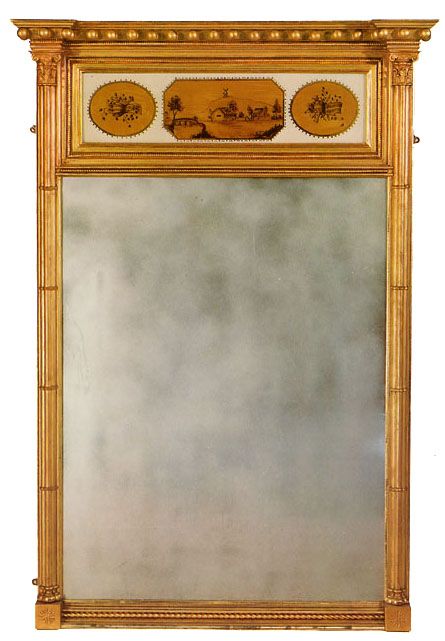 |
1800-1810 |
Unknown |
Boston or New York |
Gilt gesso on pine, glass |
62 x 38 1/2" |
|
Purchase, 1976 |
Purchased from Israel Sack, Inc. Invoice states "Purchased by Joseph Tilden in 1801 for his new house in Boston where he and his bride Suzannah Linzee were to live - descended in these families." A Joseph Tilden (1779-1853) married Suzannah Linzee in Boston on May 18, 1802. See John William Linzee, Jr., "The History of Peter Parker and Sarah Ruggles of Roxbury, Mass. And Their Ancestors and Descendents" (privately printed, 1918), p. 79. Purchased by Boscobel from Julius Lowy, New York, NY 4/12/77 |
0 |
|
Berry Tracy Collection, Sold Feb. 1, 1985 for $3,080, Sotheby's Auction |
Pair of looking glasses with large, gilded, molded flat top cornices with rope inserts and pendant balls; upper panel with gilded frame and rope borders enclosing églomisé panels of white background centered with chamfered rectangles depicting buff colored cottage scene with bridge flanked by gilded bordered ovals with buff colored musical motifs; clustered side columns with rope borders. |
Portraits of the Tildens deaccessioned 10/14/99, Christie's, New York. |
Furniture |
76 |
| TRUE |
Portrait |
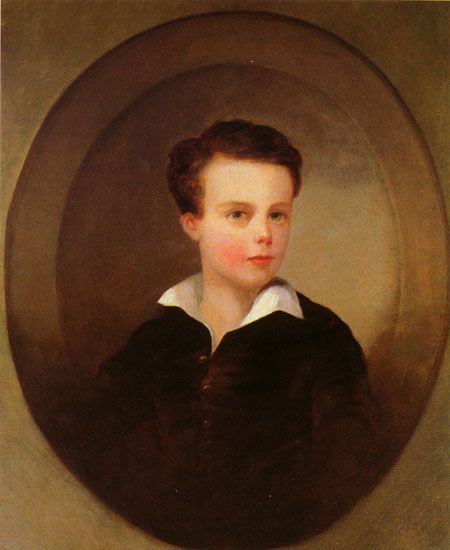 |
c. 1805 |
Unknown |
New York |
Oil on canvas, gilded frame |
26 1/2 x 21 1/2" |
|
Purchase, 1961 |
Purchased in 1961 from John Conover, Todd Place, Ossining, NY. Conover identified that subject as "Peter Corne Dyckman" on the invoice, which also lists a silver ladle engraved "SMD" for States M. Dyckman, as well as other items without Dyckman provenance. Frame purchased from Kennedy Antiques and Interiors, 6/5/1961. |
0 |
|
|
Portrait of Peter Corne Dyckman (1797-1824). Oil on canvas bust of young boy wearing a white shirt and coat rendered in black and brown, all within an oval painted frame against a greenish gray ground. The costume, hair style, and apparent age of the child suggest a date of about 1805. |
Peter Corne Dyckman, named for a maternal great grandfather, was the only son and surviving child of Elizabeth Corne and States Dyckman. He lived for only one year after his mother's death in 1823. He married Susan Matilda Whetton, by whom he had one child, Eliza, who later married Col. John Cruger. The costume and hair style seen in the portrait suggests a date of about 1805, making Peter eight years old at the time of the sitting. |
Paintings |
114 |
| TRUE |
Barrel Organ |
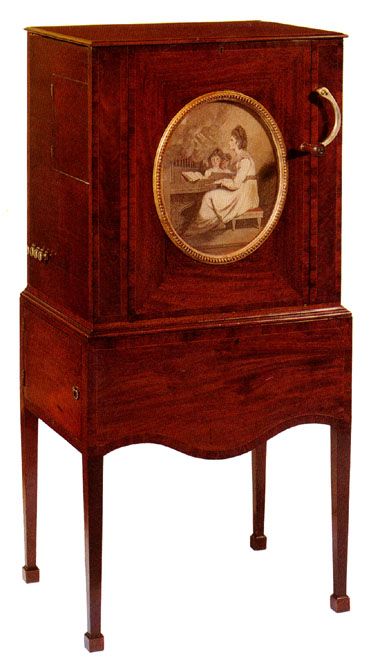 |
1790-1798 |
Longman & Broderip (1767-1798) |
London |
Mahogany, pine, oak, light wood stringing |
22 1/4 x 16 3/8 x 46 1/4" |
Longman & Broderip, London No 26 Cheapside & No 18 Haymarket, London Manufacture, Repairs and sell wholesale retail Organs, Piano Fortes, Harpsichords, Spinnets, Violins, Guitars, Flutes, Fifes, Horns, Clarinets, and Any Other Kind of Musical Instrument Also Engraved Print, The Greatest Variety of Music by the most Approved Masters. We import the best Roman Strings, & Genuine German Wire. Large Allowance to Merchants, Captains of ships & Others who take for sale. Second label: Barrel one; 1. Royal Family Minuet 2. Minuet de la Cour 3. Nancy of the dale 4. Je Suis, Lindor 5. Tenducis Rondo 6. Maid of the Mill 7. The Rondeloy 8. Death of Robin Gray 9. La Virginellla 10. Top Sails Shiver in Shiver in Ye Wind Barrel 2: 1. The Myrtle Green 2. Gloster House 3. Hamstead Heath 4. Robinson Crusoe 5. La Bernoise 6. Les Trois Graces 7. La Galatea 8. La Germanique 9. Les Allemande Favouri 10. The Swiss Allemande Barrel 3: 1. Feltons Variations 2. God Save the King 3. The Lord My Pasture 4. Easter Hymn 5. Evening Hymn 6. Burton New 7. Bedford 8. Angels Hymn 9. The 100 Psalm 10. The 104 Psalm |
Purchase, 1962 |
Purchased from Ginsburg & Levy, New York, NY, 5/29/1961. |
0 |
|
|
The rectangular barrel organ has an upright organ case on a deep-skirted base or stand. The base stands on square tapered legs ending in thick molded block feet. The underside of the front rail is serpentine. A cupboard door at one end accesses a storage space for two unused song barrels. The upper case has a hinged cover that accesses the playing mechanism. The exterior front has an attached oval frame enclosing a colored engraving of a lady with children at a keyboard organ. A brass hand crank in the upper right corner activates the organ. Four organ stops may be controlled in the lower left corner of the left (I.e., proper right) side of the organ case. A hinged door on that side accesses the song barrel. The organ mechanism has fifteen hammers. Three song barrels or logs, marked "No. 1", "No 2", and "No 3" in black ink on one end are interchangeable by disconnecting the barrel via brass levers. A paper label applied to the underside of the hinged top lists ten melodies for each of the three barrels. The front and back panels of the organ case are removable to access the works. |
An organ valued at $8.00 appears in the Dyckman inventory of 1806. It was valued at L35 when shipped aboard the "Commerce" on September 30, 1803. The original Boscobel barrel organ has since returned to England where it was used as partial payment for a debt by a Dyckman descendent. See correspondence with the Rev. C.C. Kevill-Davies in the object folder. Longman's and Broderip listed in Grove's Dictionary of Music and Musicians. |
Furniture |
84 |
| TRUE |
Pembroke Table |
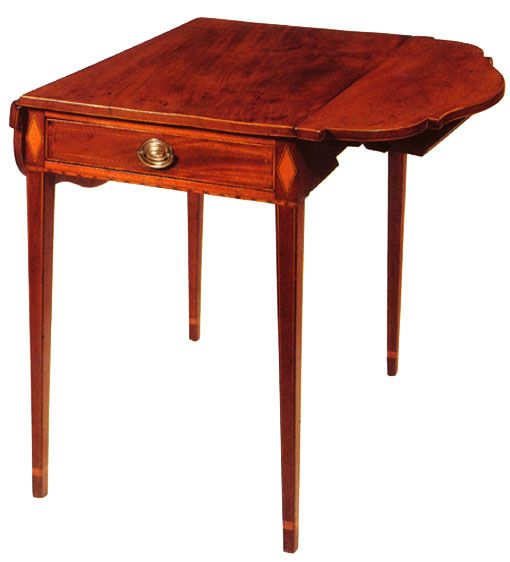 |
1795-1805 |
Unknown |
New York City |
Mahogany, tulip poplar, white pine, cherry, brass. |
28 5/8 x 20 1/4 (leaves down) x 39" (leaves up) |
Brass bails marked "HJ", probably for Thomas Hands and William Jenkins of Birmingham, England, in partnership between 1791 and c. 1805. |
Purchase, 1961 |
Israel Sack, Inc., New York, NY 5/1/61 |
0 |
|
|
The inlaid mahogany drop-leaf table has a rectangular fixed leaf with two leaves with inset quarter-round corners and serpentine sides. The table top edges are inlaid with stringing. Stringing borders the top. A triangular fly made of cherry supports each hinged leaf. The table has one drawer made of tulip poplar with a white pine drawer front veneered in mahogany with stringing and an oval brass. Diamonds inlaid into the leg stiles flank the drawer and sham drawer at the opposite end. The bottom edges of the end rails are inlaid in a lozenge or diamond pattern that extends across the legs. The legs are square tapered with stringing and have cuffs near the bottoms. |
|
Furniture |
31 |
| TRUE |
Portrait, "States Morris Dyckman" |
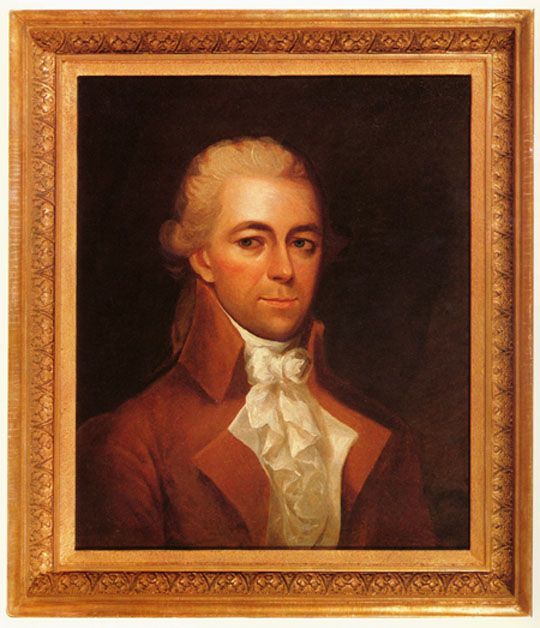 |
c. 1785 |
Unknown |
English |
Oil on canvas, gilded frame |
23 9/16 x 19 1/2" |
|
Purchase, 1962 |
Purchased from Rev. Henry Dyckman through Mrs. Richard Dyckman, Plainfield, NJ 1962 |
0 |
|
|
Portrait of States Morris Dyckman: Bust of subject with powdered hair, wearing a brown coat and white cravat. In original frame. |
|
Paintings |
115 |
| TRUE |
Chest of Drawers |
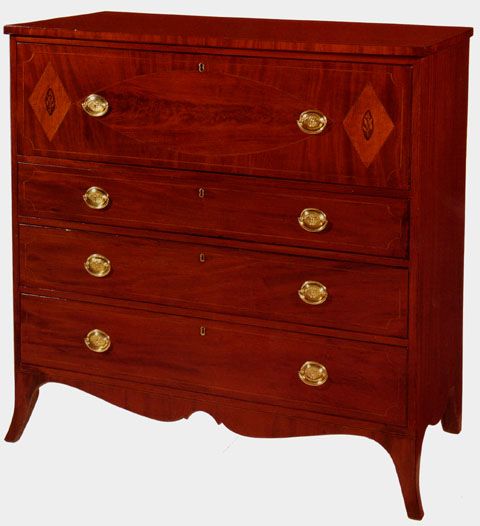 |
1800-1810 |
Probably Michael Allison |
New York City |
Mahogany, satinwood, tulip poplar, white pine, original eagle brass pulls. |
45 5/8 x 45 1/4 x 22 1/4" |
Brass bails are stamped "H.J.," probably for Thomas Hands and William Jenkins of Birmingham, England, in partnership between 1791 and c. 1805. |
Purchase, 1962 |
Purchased by William.C. Kennedy, 11/12/62, at Parke-Bernet Galleries, October 5-6, 1962, lot 300. Ex collection, Douglas Robinson. |
0 |
Deanne Levison, "The Symbolism of Floral Inlay," Antiques 145, no. 5 (May 1994), p. 707, pl. VII. |
|
The chest of four drawers has a deep top drawer with three shallower drawers below, graduated in size from shallow at the top to deep at the bottom. The top drawer is veneered with a central oval panel of figured mahogany outlined with light wood stringing, flanked by inlaid diamond panels of satinwood (possibly maple or other indigenous wood) with ovals containing inlaid rosebuds. The three veneered drawers below are outlined with light wood stringing. The skirt has a central concave element flanked by deep ogees that flow into French feet. The framed top supports a thin mahogany board and has cross-banded edges. The back of the chest has a wide vertical batten in the center into which side panels are channeled. Drawer fronts are veneered white pine; drawer sides and bottoms are tulip poplar. Original eagle brasses are marked "HJ" The second drawer from the top, being the shallowest of all four drawers, was originally fitted to serve as a writing drawer with a slide on the top and places for writing equipment. |
|
Furniture |
63 |
| TRUE |
Cased bottle set |
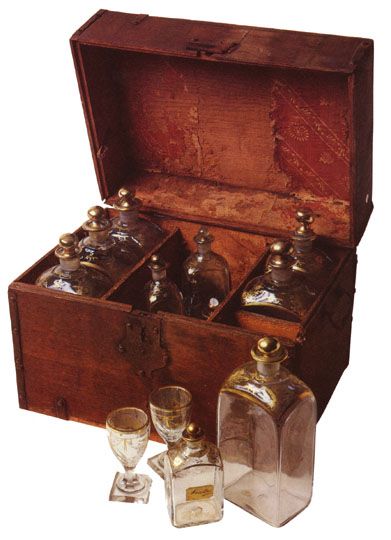 |
1780-1810 |
Unknown |
Probably Germany |
oak, pine, glass, paper, iron |
Case: 11 x 15-1/4 x 11 |
|
On Loan from Department of Parks, City of New York |
On loan from the Department of Parks, City of New York, 1966 |
0 |
|
|
The rectangular case is fitted inside for six gold decorated rectangular decanters, six half-pint decanters, some with "brandy" paper labels on them, two wine glasses and probably two cordials or a funnel all fitted in a wooden tray. (An 1960s photograph shows the case with a broken tumbler which does not appear to belong to this set.) The case is bound in iron straps and has an iron lock and handles. The interior is lined with figured red wallpaper, now faded. |
Dimensions cont.: 2 wine glasses: 4 1/8 x 1 7/8" H 6 decanters: 9 1/2 x 3 3/4 x 2 3/4" H 6 decanters: 5 1/8 x 2 1/4 x 1 3/4" H Cased moved to Library 3/27/2008, glass contents temporarily stored inside F 76.26. [JP] As of 2/2/2018, the glass bottles are in the Dressign Room inside F 76.26 [kc] |
Glass |
102 |
| TRUE |
Wardrobe |
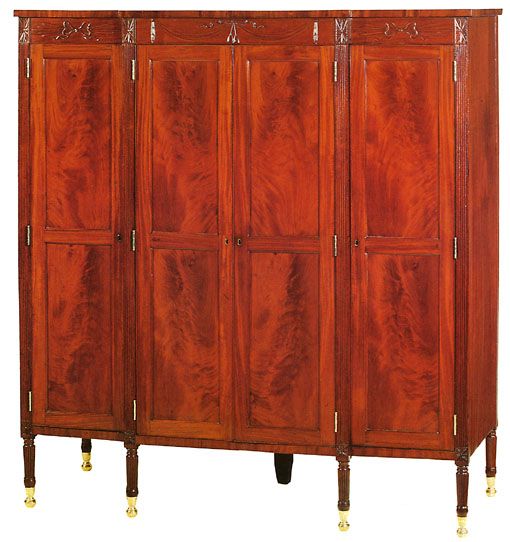 |
1810-20 |
Probably Duncan Phyfe |
New York |
Mahogany, tulip poplar, white pine, brass. |
65 3/4 x 61 x 22 1/2" |
|
Purchase, 1976 |
Purchased from Carol Galbraith, Mt. Vernon, NJ 8/16/76. The original accession worksheet recommends inquiries about whether the wardrobe came from Montclair, N.J., but there is no follow-up. |
0 |
|
|
The mahogany wardrobe has a double-door cupboard in the center flanked by separate cupboards, each slightly recessed and accessed by a single door. The cornice frieze is carved in the center with a bow knot and two tassels supporting swags. A bow knot with lightning bolts is carved in each side panel. Rectangular stylized rosettes mark the sides of each of these three panels and the tops of reeded stiles. Additional rosettes mark the bottoms of the reeded stiles. The wardrobe stands on six turned legs, the front four of which are reeded. All end in brass ball feet. Each of the narrow rectangular doors as two panels, one above the other, each covered with brilliantly figured, book-matched mahogany veneers. Each section opens to three fixed shelves above the bottom board of the wardrobe. The wardrobe top is framed with cross banded edges. The back is made of three tulip poplar fielded panels set into the case sides and two middle stiles. |
Berry Tracy, Federal Furniture and Decorative Arts at Boscobel, p. 93, wrote "The zenith of American wardrobes in the Boscobel collection is the "winged wardrobe" (70) attributed to the workshop of Duncan Phyfe. In the New York Price Book of 1810 it was, with the winged bookcase, the most expensive piece of furniture of its time. In this rare example are seen the finest elements of Phyfe's work in design and carving. The tablet of the frieze has the carved rosettes, drapery (70A), and thunderbolt motifs seen on Phyfe's sofas and chairs. On the door panels, a studied arrangement of densely figured mahogany flame veneers soars upward as in a holocaust and gives a note of excitement to the otherwise sober, but perfectly elegant, expression of the master." |
Furniture |
70 |
| TRUE |
Dumbwaiter |
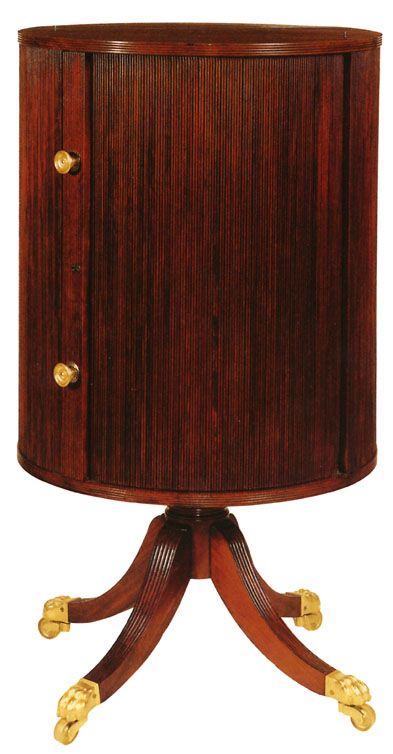 |
1810-1820 |
Possibly Duncan Phyfe |
New York City |
Mahogany, tulip poplar, pine. |
44 x 24" |
|
Purchase, 1976 |
Purchased from Edward J. Holden, Hyde Park, NY, 9/9/76 |
0 |
|
Winterthur has two NYC dumbwaiters, both smaller and not fully enclosed, as this one is. |
The cylindrical tambour dumbwaiter has a circular top and bottom, reeded on the outside edge and joined by tambour strips. The interior is a separate cylindrical drum formed by four evenly spaced boards creating three shelves and assembled with eight vertical members around the outside and staggered verticals near the center axis around which this drum rotates. The interior shelves are accessed through a sliding tambour door with two brass pulls. The cylindrical unit stands on four out swept legs with reeded tops, ending in cast brass paw feet and casters. On the top are two original metal pins which may have stabilized a fitted mahogany or Sheffield tray. |
A note in the object folder states that fragments of early newspaper dated 1811 and identified as New York cover some of the canvas tambour backing, but these fragments have not been observed as of 5/12/04. |
Furniture |
41 |
| TRUE |
Dining Table |
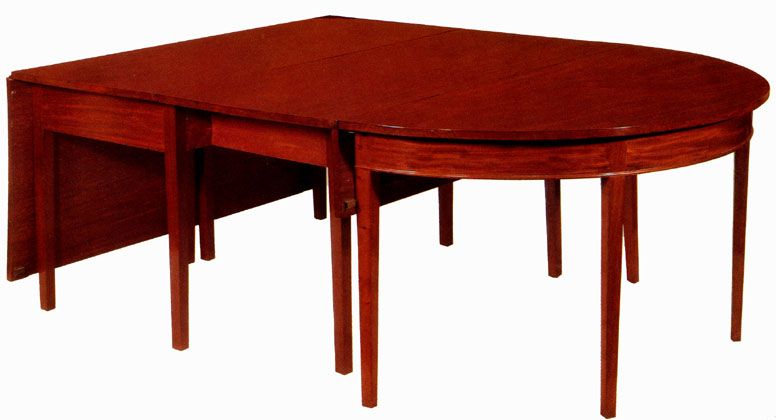 |
1790-1815 |
Unknown |
New York |
Mahogany, mahogany veneer, ash, maple, white pine |
281/2 x 55 1/2 (leaves up) x 70 1/2 (leaves down) x 24 1/2. |
"Part of James (?) / Henderson's dining / table (in hall)" written on an old "jelly" label attached to the underside of one end section. |
Purchase, 1977 |
Descended in the Henderson family of New York, and said to have been used originally at Boscobel. Purchased from Benjamin West Frazier, Garrison, NY 1/5/77. |
0 |
|
|
The three-part mahogany dining table has an eight-legged rectangular center section with deep rectangular hinged leaves supported by two swing legs on each side that swing from hinges near the middles of the side rails. The frame of each half-round end section is made of laminated pine with mahogany veneer. Each has a shallow hinged leaf that is supported by triangular maple flies. An astragal molding runs along the bottom of the table frame. The legs are square tapered. The top overhangs the table frame more than most other dining tables made in this period. |
|
Furniture |
47 |
| TRUE |
Sideboard |
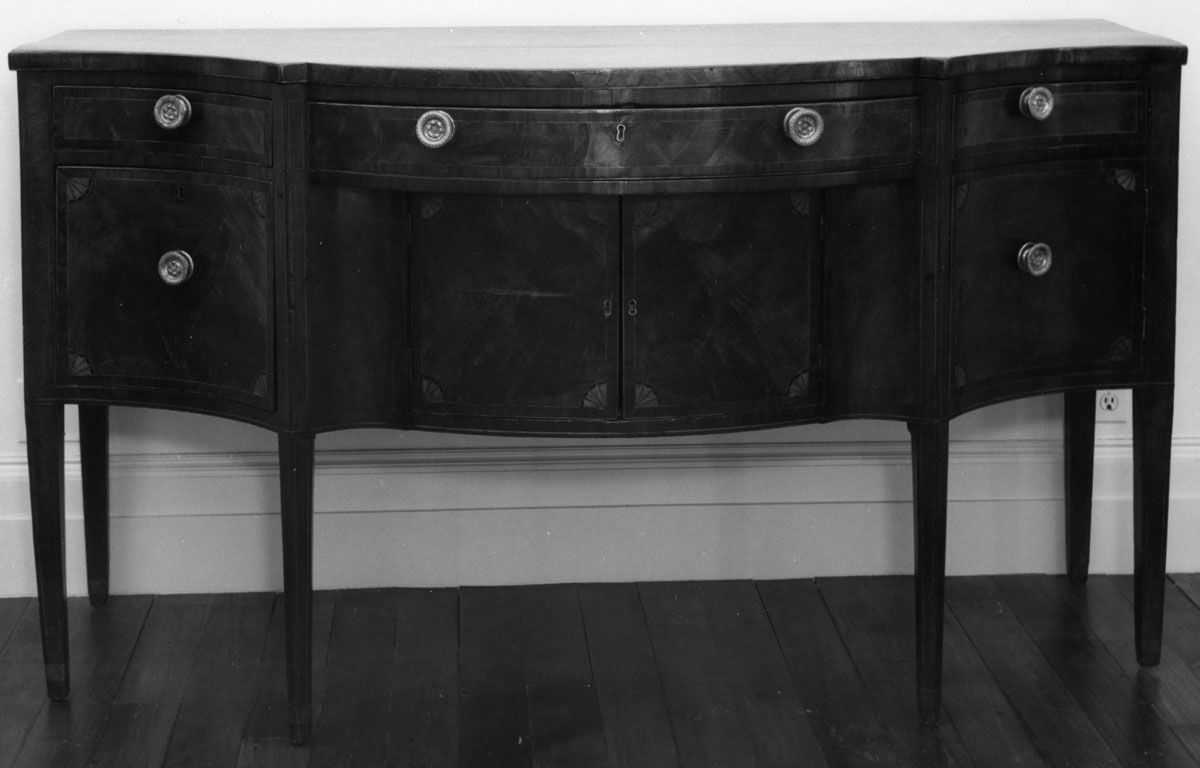 |
1790-1815 |
Robert Wallace |
New York City |
Mahogany, mahogany veneer, light and dark inlays, white pine, tulip poplar, maple, brass |
40 5/8 x 72 6/8 x 31 6/8" |
"Robert Wallace, Joiner / AT THE SIGN OF THE THREE TREES / IN BEAVER STREET" printed on a paper label affixed to underside of proper right top drawer bottom. |
Purchase, 1961 |
Supposedly from the Livingston collection at Clermont. Referred to in the Livingston inventory (don't know which one) as the Dyckman sideboard. Purchased through Fred Johnston, Kingston, NY Purchase, William C. Kennedy 11/27/61 |
0 |
|
|
The six-legged mahogany sideboard has a serpentine shaped top with bowed center drawer above recessed bowed cupboard doors. The proper right side has a shallow drawer above a square drawer fitted in the rear for six bottles. The proper left side has a shallow drawer above a cupboard door. The center legs and stiles are shaped to conform to the serpentine (i.e., they are five-sided). The stamped brass pulls are replacements in original holes, now partially filled. |
Reference to this piece does not appear in the Robert R. Livingston inventory of 1813, or the Robert L. Livingston (son-in-law) inventory dated 1832-40. According to Robert A. Slater, partner of Johnston Antiques, October 1999, the sideboard was purchased at the sale of Victor Livingston, River Road, Ulster County, in the spring of 1960. |
Furniture |
0 |
| TRUE |
Dining Table |
 |
1805-15 |
Unknown |
New York |
Mahogany, white pine, maple, rosewood banding, gilt brass cup casters. |
29 x 53 1/2 x (center open) 71 3/4 (center closed) x 24 1/2" |
|
Purchase, 1976 |
Purchased from Israel Sack, Inc., New York, NY 9/16/76, who attributed the table to Duncan Phyfe. |
0 |
|
|
The three-part mahogany dining table has an eight-legged rectangular center section with deep rectangular hinged leaves supported by two swing legs on each side. The frame of each elliptic end section is made of laminated pine with mahogany veneer. Each end section has a deep rectangular hinged leaf that is supported by two swing legs with maple rails. The legs are turned and reeded with swelled turnings near the bottom and casters. Cross banding runs along the bottom of the table frames and across the leg stiles. Dining Table; in three parts, with round reeded legs, elliptical ends, cross banded apron with spandrel blocks at each leg on cup casters. When fully extended this table has twenty legs and seats 16 to 18 guests. Carved and inlaid mahogany with pine, tulip poplar, and rosewood banding. |
One section of this table is in the Entrance Hall. There is some confusion, with the cards, of the possibility that this table is also known as F 76.1. |
Furniture |
43 |
| TRUE |
Work Table |
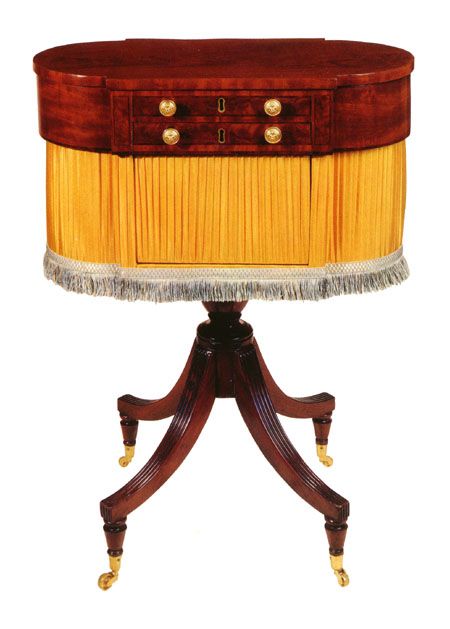 |
1805-20 |
Unknown |
New York |
Mahogany, mahogany veneer, rosewood banding, tulip poplar, and silk. |
31 1/2 x 24 x 12 3/4" |
"Edgar / S. O." in pencil on underside of drawer bottom. |
Purchase, 1976 |
Purchased from Ronald A. De Silva, New York, NY, 5/22/76. |
0 |
|
Similar tables illustrated in Nancy McClelland, Duncan Phyfe and the English Regency, 1795-1830, pl. 143; and Charles Cornelius, pl. 30. |
The mahogany and mahogany veneer work table has a rectangular center section and astragal ends. The hinged top of conforming shape is veneered inside and out and has mahogany cross-banded edges. Rosewood banding outlines the perimeter of the top, the drawers, and the rectangular panels at each side. The top drawer is false; the back of the table has a false façade that duplicates the front. Inside, the table has a hinged and adjustable baize-covered writing surface and compartments for writing materials. A large square drawer, partially covered in front with pleated silk (formerly T 77.3), fits into the center of the table and is suspended on side runners. Reeded "sweep" legs are dovetailed into the bottom of the baluster-turned center shaft and terminate in short, vertical turned feet set into brass caster. |
According to Mr. Berry Tracy's notes, the New York Price Books spelled "work table' in two words. Sheraton hyphenated the term ladies work table in 1802 and our modern dictionaries spell it out as one word, defining it as "a table at which work is done; especially a small table with drawers for needlework." The most feminine of the work tables in the Boscobel collection is a classical example of the "pillar and claw," "astragal end," model with an accordion pleated silk "bag" below a handsome case containing compartments for sewing equipment as well as a writing surface. Work tables of this richness and intricacy were the central accoutrement of polite, feminine society. At the appropriate time, the ladies of the household would collectively engage themselves with needlework in a sitting room or parlour, or perhaps with writing a note or reading aloud to each other. |
Furniture |
29 |
| TRUE |
Pair of card tables |
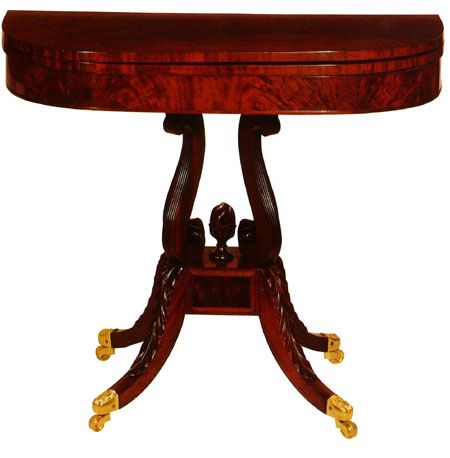 |
1815-25 |
Unknown |
New York |
Mahogany, mahogany veneer, tulip poplar, white pine, ash, brass fittings. |
30 x 36 x 18" |
|
Purchase, 1976 |
Purchased from Joe Kindig, York, PA, 8/9/1976. |
0 |
Illustrated as figs. 15, 26 in Philip D. Zimmerman, "New York Card Tables, 1800-1825," in American Furniture 2005 (Chipstone), pp. 128, 134. |
Similar card tables, attributed to Phyfe, are in the collections of the Albany Institute of History and Art, as well as the Taft Museum. Ginsberg & Levy advertised a library table with a similar base and pineapple finial in Antiques 102, no. 1 (July 1972), p. 11. |
The D-shaped frames are constructed of three laminated layers of wood in front, dovetailed to a rear rail. The frame sides are veneered and have an applied molding strip along the bottom edge. The frames support D-shaped hinged top leaves that swivel on a threaded iron spike . The top leaf of each table is veneered with matching mahogany. Veneers inside the folding tops match only in color and grain character, but not pattern. The table frames attach to four half-lyres or S-shaped supports, each reeded on the outside and having roundels applied to each side of the lower scroll. The bottoms of the supports are tenoned into a rectangular base or plinth that stands on four sweep legs attached to the corners. Each leg has stylized acanthus carving on the top surface and ends in a brass capped foliate foot and caster. A finial with a swirl rising from stylized acanthus leaves is doweled into the center of each base. Veneered panels decorate the sides. Secondary woods are covered with a red "mahoganizing" wash. |
|
Furniture |
27 |
| TRUE |
Looking Glass |
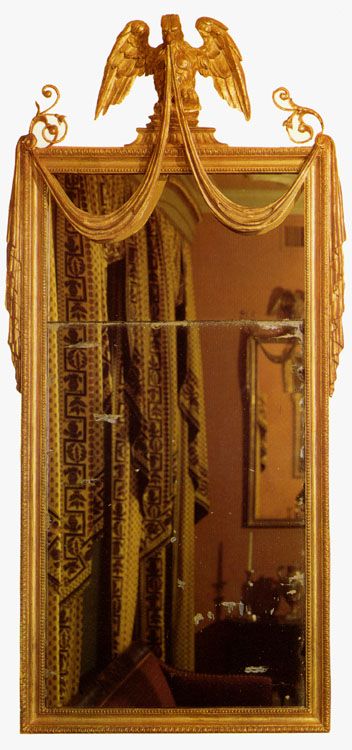 |
c. 1800 |
Unknown |
England |
Gilt gesso on pine |
62 x 29 1/2" |
|
Purchase, 1977 |
Purchased from Richard T. Button, New York, NY, 10/11/77 |
0 |
|
|
Pair of George III carved and gilded pier mirrors: each has an upright bead, leaf and dart frame, crested with a perched eagle with spread wings bearing drapery swags in its beak, leaf scrolls in corners. |
|
Furniture |
78 |
| TRUE |
Fire Screen |
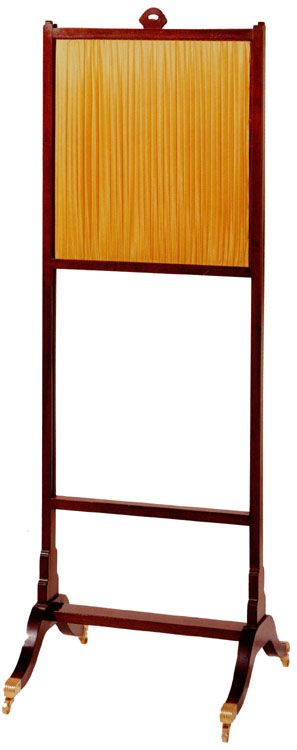 |
1810-25 |
Unknown |
Probably New York City |
Mahogany; tulip poplar (not confirmed); silk |
54 1/2 x 18 10/16" |
|
Purchase, 1976 |
Purchased from Joe Kindig, York, PA, 8/9/1976. |
0 |
|
|
The "horse" fire screen, so called because of the design of the base, has two slender upright supports joined at the top by a rail and near the bottom by another rail An adjustable sliding screen, upholstered in pleated yellow silk (formerly T 77.4), slides within a channel in the uprights. The screen has a pierced handle or finial at the center top. The base is made of two pairs of out swept feet ending in brass caps and casters, and joined by a broad rail. The uprights are laminated at each side of the base to achieve greater width and stability and are tenoned through the feet in one wide tenon. |
The presence of tulip poplar, which is noted in the accession file, has not been confirmed as of 10/28/08. It may be used in the screen frame now upholstered with yellow silk. |
Furniture |
85 |
| TRUE |
Pair of tilt-top stands |
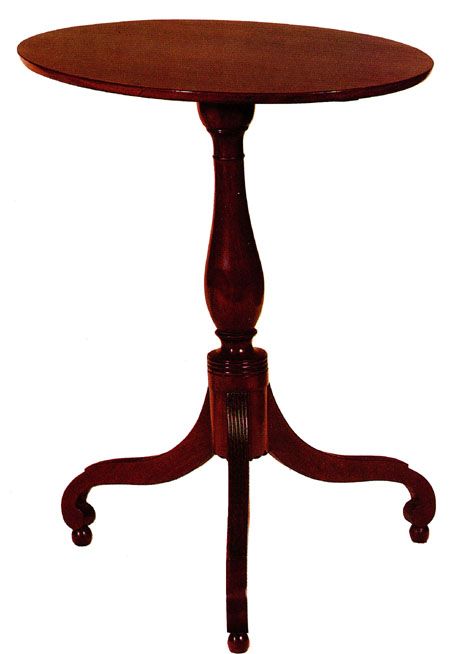 |
1810-25 |
Unknown |
New York region |
Mahogany, cherry, brass snaps |
26 x 23 x 17 3/4" |
|
Purchase, 1976 |
The two stands were purchased separately: (a) from Beverly Kelly, Garrison, NY, 10/2/76; (b) from Ronald S. Kane, 1775 Broadway, New York, NY, 11/24/76. |
0 |
|
|
The two stands, acquired from different sources, appear to be a pair. Each stand has an oval top. The oval tops are hinged to the shaft by wooden pintails projecting from a cherry (possibly maple) block affixed to the top of the baluster-turned mahogany shaft. The baluster turning is separated from the cylindrical base by a narrow reel turning. Three S-shaped legs are dovetailed into the bottom of the shaft. The legs are reeded on the top and stand on balls applied to the undersides of the bottom scrolled ends. The two tables are made from similarly colored and grained mahogany. All aspects of workmanship appears to be identical from one table to the other: edges of top have the same bevel, cleats are shaped the same, bevel on the underside of the top block matches, reeded and raised panels on the legs match. The ball feet differ slightly from table to table. The brass snaps differ, although each snap appears to be original to the table. |
|
Furniture |
37 |
| TRUE |
Side Table |
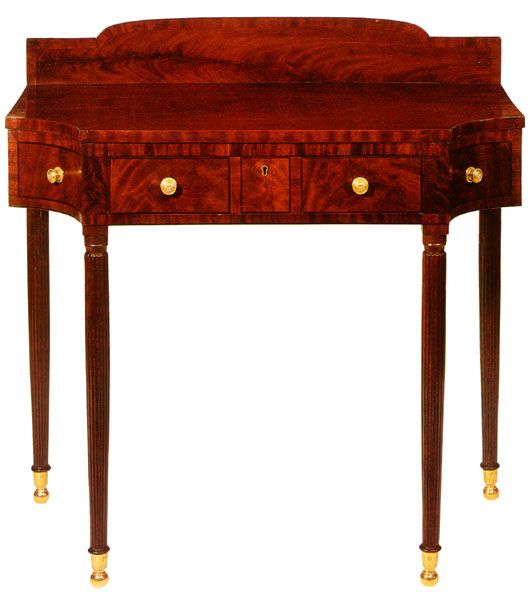 |
1815-1820 |
Possibly Thomas Blake? |
New York |
Mahogany, mahogany veneer, dark stringing, tulip poplar, white pine, brass. |
36 x 35 5/16 x 19 3/4" |
"Thomas J Blake / 727 [127?] / Washington Ave / Albany NY" is scratched into the outside of the rear rail on the proper left end. "Thomas Blake" is scratched into the proper right end, too. Illegible pencil inscriptions occur on the back of the splashboard near the center. |
Purchase, 1976 |
Purchased from Joe Kindig, York, PA, 8/9/1976, who attributed the table to Michael Allison.. |
0 |
|
The small center "tablet" drawer is similar in plan to that on the 1810 bureau labeled Michael Allison in the collection of The Metropolitan Museum of Art. |
The rectangular side or serving table has concave or hollow front corners and a splashboard across the back that has an elliptic center. The table has three small drawers across the middle section and false drawers in each concave section. The narrow center "tablet" drawer is veneered to appear as a drawer within vertical dividers, but the drawer front abuts the flanking drawer fronts. The table stands on four turned and reeded legs ending in brass ferrule feet, which appear to be original. The back of the table is slightly bowed indicating that it originally stood in a similarly shaped space. |
|
Furniture |
39 |
| TRUE |
Wardrobe or French press |
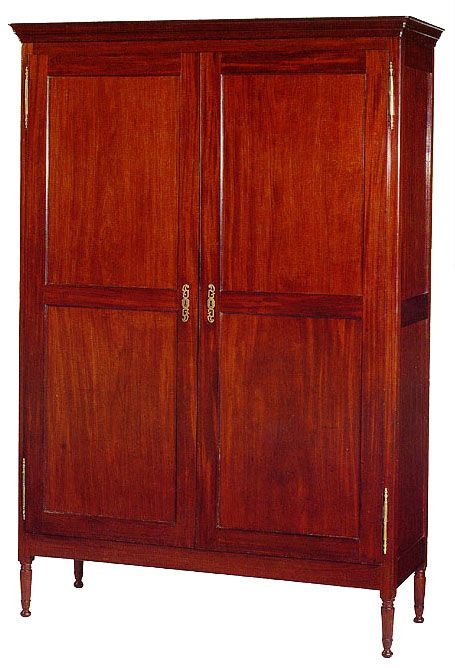 |
1810-1820 |
Unknown |
New York City |
Mahogany, tulip poplar, white pine. |
83 1/2 x 54 1/2 x 20 3/4" |
|
Purchase, 1976 |
Undocumented tradition of ownership in the Livingston family of Callander House in Tivoli, NY Purchase, O. Rundle Gilbert 5/1/76 |
0 |
Peter M. Kenny, "From New Bedford to New York to Rio and Back: The Life and Times of Elisha Blossom, Jr., Artisan of the New Republic," in American Furniture 2003 (Chipstone), pp. 239-269, fig. 6. |
See F 76.27 |
The rectangular case has a molded, slightly projecting removable cornice, above paired full length two-panel cupboard doors and two-panel case sides. The back of the wardrobe is framed into four panels. The interior has 6 full-width pull-out shelves, 3 above and 3 below 2 side-by-side drawers. The corner stiles of the case extend down to become turned legs, ending in foot turnings that mimic brass ferrules. The drawer fronts, which have scratch-beaded edges, have what appear to be original stamped oval brass backplates with running leopards and bail handles. The drawer fronts, which have scratch-beaded edges, have what appear to be original stamped oval brass escutcheons with running leopards and bail handles. |
This press looks like F 76.27, but many differences in construction and in leg turnings suggest that the two were made by different cabinetmakers. On February 27, 2003, the additional images were entered into the record. They are described as follows: Frame 2) Brass, Frame 3) Feet, Frame 4) Back View, Frame 5) Interior View |
Furniture |
68 |
| TRUE |
Corner Basin Stand |
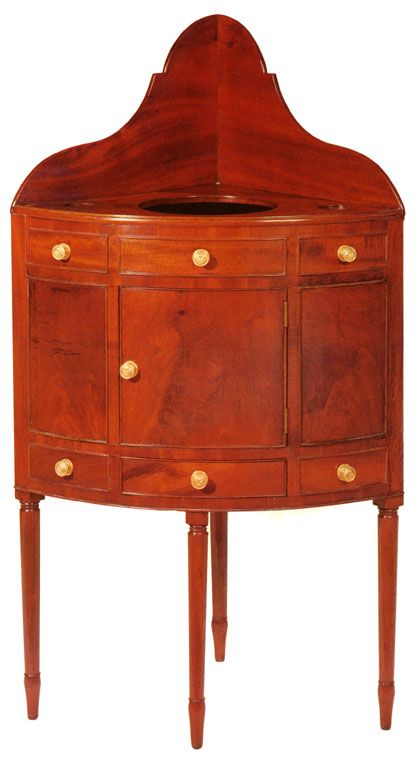 |
1805-20 |
Unknown |
New York |
Mahogany, mahogany veneer, tulip poplar, maple |
46 1/2 x 26 x 18 3/8" |
|
Purchase, 1976 |
Purchased from Thomas Kyle, Goshen, NY, 1/22/76. |
0 |
|
|
The corner basin stand has a high splashboard with ogee curved sides that peak in the corner. The top of the bowed case is pierced with basin and soap receptacles. The front of the case has a range of three false drawers across the top and above a false cupboard door between side panels. Two false drawers along the bottom of the case flank and working drawer in the center. The case stands on four turned legs ending in swelled and tapered feet. |
|
Furniture |
55 |
| TRUE |
Chest of Drawers |
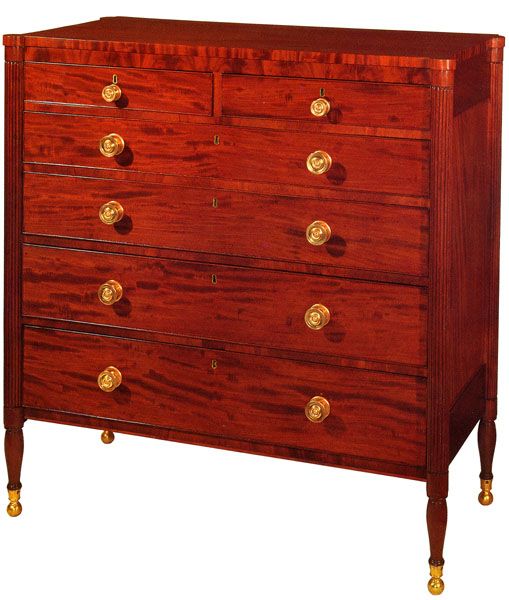 |
1810-20 |
Unknown |
New York |
Mahogany, mahogany veneer, white pine, tulip poplar, and brass |
48 x 45 1/4" |
|
Purchase, 1977 |
Purchased from Thomas Kyle, Goshen, NY, 4/12/77. |
0 |
Peter Kenny, Lannuier, fig. 34, pp. 71-72. |
|
The chest of drawers has five tiers, the topmost of which has two side-by-side drawers. The four full-width drawers below are graduated in size. All drawers are veneered with cock beading and have white pine fronts and tulip poplar sides and bottoms. Outset reeded columns mark the corners of the case and extend down to become baluster turned legs with brass ferrule feet, which appear to be original. The chest top is a white pine frame with a thin mahogany board on top and mahogany cross banding around the edges. The proper left top drawer is divided into compartments, namely three small square units on each side of a large central square and a long, narrow compartment across the back. The proper right top drawer has similar compartments retrofitted. |
|
Furniture |
65 |
| TRUE |
Field bed |
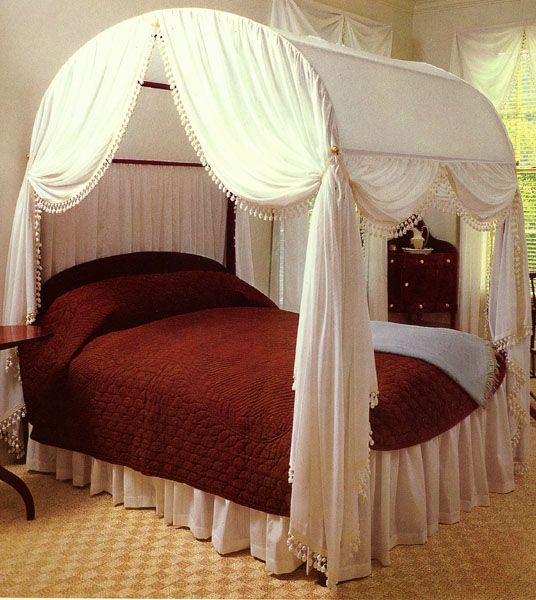 |
1805-1810 |
Unknown |
New York |
Mahogany, maple rails |
82 1/2 x 78 1/4 x 54 1/4" |
|
Purchase, 1976 |
Previously owned by Dorothy Grey, Millbrook, NY Purchased, John C.R.Thompkins, Millbrook, NY 10/1/76 |
0 |
|
|
Field bed: mahogany, four post bed with arched tester, the headposts ring-turned and baluster turned on ring-turned tapering legs. |
|
Furniture |
51 |
| TRUE |
Tilt-top Stand |
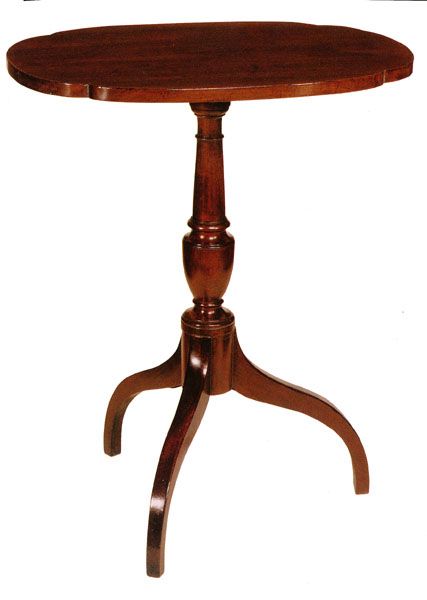 |
1810-1820 |
Unknown |
Probably New York region |
Mahogany, oak |
29 x 24 1/4 x 18" |
|
Purchase, 1976 |
Purchased from Thomas Kyle, Goshen, NY, 12/20/76 |
0 |
|
|
The stand has a four-lobed or double-elliptic top that tilts on pintails. The shaft is a tapered column separated from an urn by a ring. Three ogee curved legs are dovetailed into the base of the shaft and end in down-turned feet. An iron plate or "spider" attached to the underside of the shaft holds the legs in place. |
|
Furniture |
36 |
| TRUE |
Set of two armchairs and 12 side chairs |
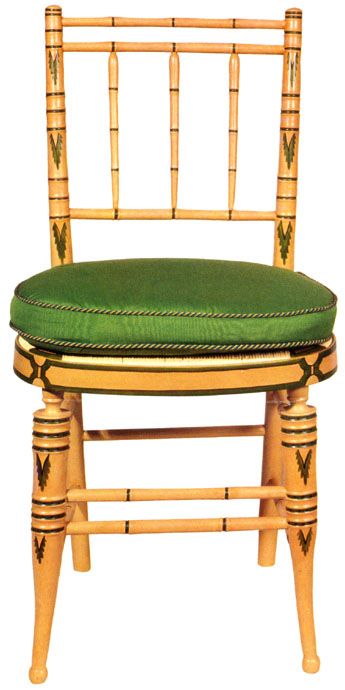 |
1815-1830 (modern painted surface) |
Unknown |
Probably New York region |
Maple, ash, rush |
35 1/2 x 18 x 16" |
|
Purchase, 1976 |
Purchased from Sage House Antiques, Red Hook, NY, 9/18/76 Cushions were purchased from Scalamandre, see T 77.6. |
0 |
|
A set of ten similar fancy chairs, with a label dated 1819 from cabinetmaker George W. Skellorn of Manhattan, were sold at Sotheby's on January 24, 1995, Sale 6660, lot 2101. |
Set of 12 painted and decorated fancy chairs: consisting of 2 arm chairs and 10 side chairs, bamboo turned with rush seat. Painted ivory with green highlights. Green fabric cushions or "squabs" made of wool and cotton in a moiré pattern with narrow green, blue and gold twisted braid (reproduction fabric, see T 77.6). The turned front legs form a narrow neck at top and taper from a wide diameter at the top to slightly out swept ball feet. |
Mr. Berry Tracy wrote the following about the fancy chairs in the mansion: " By 1805, painted chairs and settees of Sheraton derivation had superseded the common Windsors in popularity and production. They were admired not only for their beauty, lightness and strength but because they could be had much cheaper than mahogany chairs. They were sometimes made of curled maple, but usually highly ornamented by skilled hands on either red, black, bright green, or straw colored ground, and had caned or rushed seats. Mrs. Dyckman apparently favored the fancy furniture in the initial period of furnishing her home, for a bill of 1807 from William Palmer in New York indicates that she purchased 12 bamboo fancy chairs and in 1808, a bill from Henry Dean shows she purchased 12 cross back green and gold fancy chairs with two settees to match. The making of fancy painted furniture was a separate trade from that of working in mahogany. The tradition of painted decoration continued in handwork of a different character in the 1820s as seen in the Livingston family benches and later the Dyckman/Cruger chairs." |
Furniture |
18 |
| TRUE |
Bed Steps |
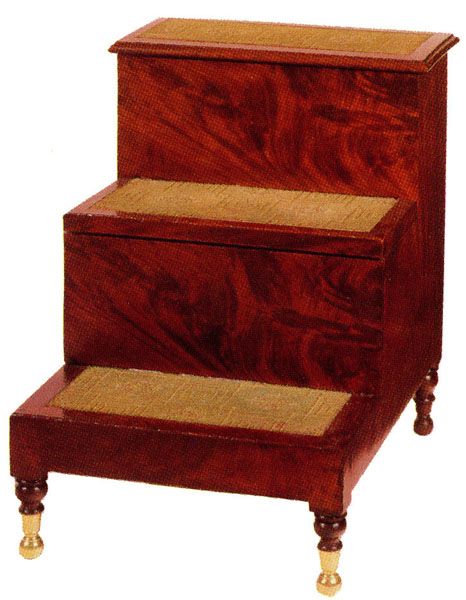 |
1815-1830 |
Unknown |
New York |
Mahogany, mahogany veneer, tulip poplar, white pine, brass, wool carpet |
24 1/2 x 19 x 24" |
|
Purchase, 1976 |
Israel Sack, Inc., New York, NY 11/19/76 |
0 |
Illustrated as fig. 8 in Philip D. Zimmerman, "New York Card Tables, 1800-1825," in American Furniture 2005 (Chipstone), p. 124. |
Charles F. Montgomery, Federal Furniture, no. 446. |
The three steps stand on turned feet ending in brass ferrule feet. The uppermost step is hinged and opens to a storage compartment. The middle step slides out, supported on the bottom step. The middle step tread is also hinged and opens to a contoured seat with a round hole from which a chamber pot was suspended. Each step has 19th-century Brussels carpeting. See Montgomery, Federal Furniture, no. 446, for similar set. Described in the 1810 New York price book as "two feet three inches wide, two feet high, three steps, solid ends, back and front rail framed into four plain legs, . . . Lipped and lined with carpet, fronts of ditto veneered." Options include "hinging the middle step, and a night stool to draw out" and "preparing and hinging the top for a pot cupboard." [listed in 1834 price book] |
|
Furniture |
52 |
| TRUE |
Wardrobe or French press |
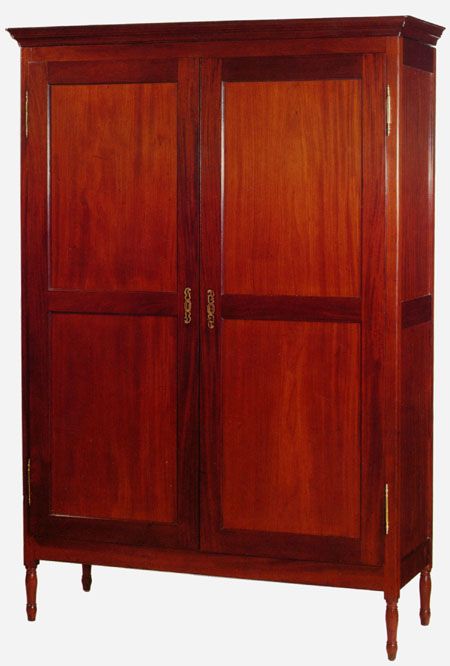 |
1810-20 |
Unknown |
New York City |
Mahogany, tulip poplar, white pine. |
83 1/2 x 54-1/2 x 20 3/4" |
|
Purchase, 1976 |
Oral history of use in the Hewitt house in Cooper Square in New York, NY Purchased from Moira Filley, Far Hills, NJ 10/30/76 |
0 |
|
see F 76.26 |
The rectangular case has a molded, slightly projecting removable cornice, above paired full length two-panel cupboard doors and two-panel case sides. The back of the wardrobe is framed into four panels. The proper right half of the interior has two stacked drawers in the center, each with an original oval lion brass, and fixed shelving above and below. The proper left side is open for hanging clothes from brass hooks and with a shelf at the bottom. The corner stiles of the case extend down to become turned legs. The plain drawer fronts have what appear to be original stamped oval brass backplates with running leopards and bail handles. The cupboard doors have elaborate, pierced brass escutcheons. |
This press looks like F 76.26, but many differences in construction and in leg turnings suggest that the two were made by different cabinetmakers. February 27, 2003, the additional images were entered into the record. They are described as follows: Frame 2) Feet, Frame 3) Back view, Frame 4) Interior view |
Furniture |
69 |
| TRUE |
Secretary Bookcase |
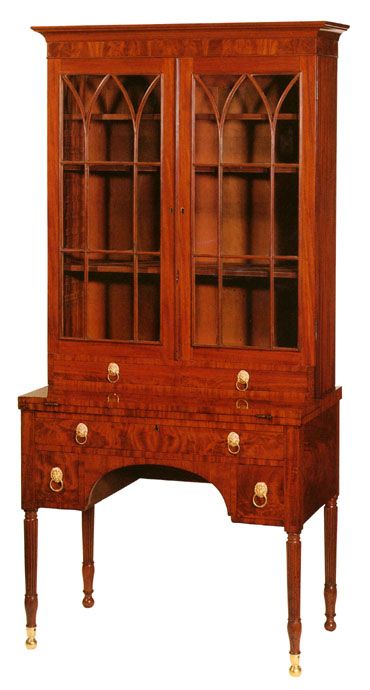 |
1810-20 |
Probably Duncan Phyfe |
New York |
Mahogany, tulip poplar, white pine |
75 x 43 5/8 x 20 1/8" |
|
Purchase, 1976 |
Descended in the Verplanck family through Mrs. Gertrude Kneveles. Purchased from Fenton L.B. Brown New York, NY, 11/1/76, who states on his invoice that the secretary descended in Verplanck family. The original accession record also identifies ownership by Mrs. Gertrude Kneveles and use in Mount Gulian, the Hudson River seat of the Verplanck family in Fishkill, N.Y., but offers no further substantiation. |
0 |
|
|
The secretary bookcase is in two parts. The upper bookcase section has three adjustable shelves behind glazed doors with pointed arch mullions below a veneered frieze and simple cove cornice. Two side-by-side drawers are at the bottom of the upper case. The proper left drawer is fitted for writing implements. The lower case has a folding writing flap that is supported by the full-width drawer immediately below. The bottom-most drawers at each side have mahogany veneers on mahogany drawer fronts. The center of the lower case has an arched kneehole with small square drawers at each lower side. The lower case stands on turned and reeded legs terminating in brass ferule feet on the front legs and rear mahogany feet in the same profile. Drawer pulls are cast lion's heads. Upper case backboards are two vertical fielded panels. Lower case has a single horizontal backboard. |
|
Furniture |
74 |
| TRUE |
Set of five side chairs |
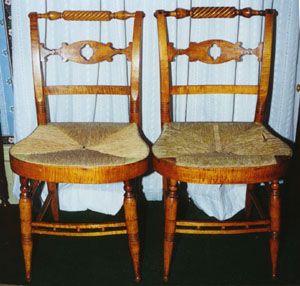 |
1815-30 |
Unknown |
Probably New York |
Maple, ash, rush seat |
33 x 18 x 16" |
|
Purchase, 1976 |
Purchased from Robert Herron, Austerlitz, NY, 7/25/76. |
0 |
|
|
Balloon-shaped, rush-seated side chairs with rolled-back rear stiles joined by a rope-turned crest rail flanked by urn turnings. The uncarved slat has a quatrefoil pierced into the central oval panel. An undecorated, narrow slat joins the stiles below. The rush seat has a thin maple casing applied to the outside. Turned front and rear legs are joined by two rungs on the sides, one rung in the rear, and a pair of bowed rungs in front with three ball spacers between them. The three chairs displayed in Mrs. Dyckman's Room are accompanied by loose green silk moiré cushions (T 77.26). Two chairs are stored in Rod House Rm. 4 |
One of the chairs was moved from Mrs. Dyckman's Bedroom to the Dressing Room on 8/27/02. Two chairs were deaccessioned Restored by Sack Conservation, Long Island City, NY in 1977. |
Furniture |
22 |
| TRUE |
Fire Screen |
 |
1805-20 |
Unknown |
New York City |
Satinwood, tulip poplar, silk, wool, brass fittings |
47 x 15 1/2" |
|
Purchase, 1976 |
Purchased from Fenton L.B. Brown, New York 11/1/76, whose invoice lists descent in the "Van Rensselaer-Westerlo" families. |
0 |
|
|
The fire screen is a pole with urn finial set into a reeded columnar shaft in turn mounted on a triangular platform with concave reeded sides that stands on three cast brass paw feet. The moveable screen is a double folding rectangular panel with veneered edges. Tiny brass serpent-like clasps, rings and screw hold the two halves together. Inside, the panels have wool needlework; outside, the panel has pleated green silk (formerly T 77.25). |
|
Furniture |
86 |
| TRUE |
Pembroke table |
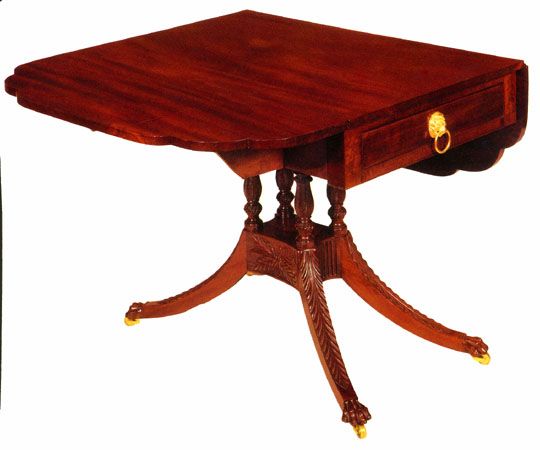 |
1815-1825 |
Unknown |
New York |
Mahogany, mahogany veneer, tulip poplar, maple, white pine |
29 x 24 1/2 (leaves down) x 49 1/4 leaves up) x 36" |
Underneath, on medial brace, is the 1936 label of "H. Ben Pae, Cabinetmaker and Restorer of Antique Furniture, Poughkeepsie, New York." |
Purchase, 1976 |
Purchased from Israel Sack, Inc., New York, NY, 5/27/76, who attributed the table to Duncan Phyfe. |
0 |
|
|
The rectangular table frame supports a center leaf to which are hinged leaves with three lobes, called "triple elliptic," each supported by two triangular brackets, or "flies," hinged to each side of the table frame. A drawer opens on one end; the opposite end has a false drawer. A hand recess under the center bottom of the drawer provides a means of opening the drawer without use of the present cast brass lion's head pulls, which are probably later additions. The table frame is supported by four baluster turned and leaf-carved colonnettes set into a deep platform from which spring four outward-curved legs with stylized water leaves carved on the tops. The legs end in carved paw feet and stand on brass casters, which appear to be original. |
|
Furniture |
32 |
| TRUE |
Basin Stand |
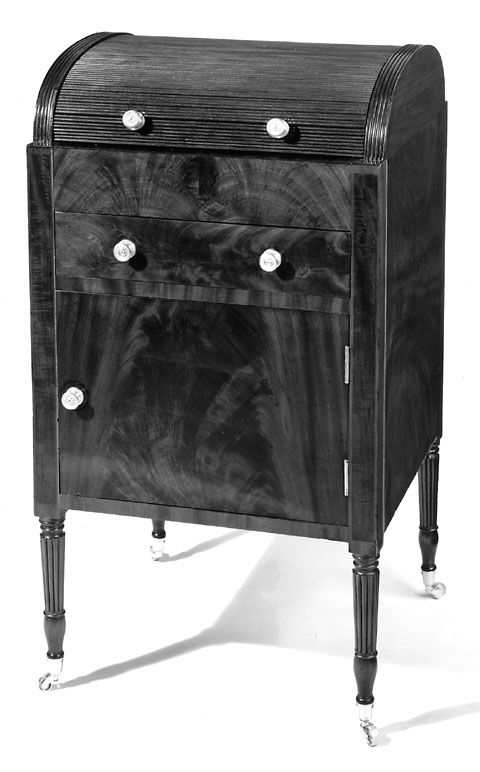 |
1805-20 |
|
New York City |
Mahogany, mahogany veneer, tulip poplar, white pine. |
35 1/2 x 18 5/8 x 18" |
An engraved calling card tacked on the inside of a drawer front reads: "Mr. Johnson C. Pierce". |
Purchase, 1976 |
Purchased from Israel Sack, Inc., New York, 5/27/76 |
0 |
|
This basin stand is very similar to the one in the Dining Room, F 76.19. |
The veneered basin stand has a cylindrical tambour top, covering wash stand board, with pierced circles for basin receptacles. The single drawer below has book-matched veneer panels. The cupboard door opens to storage. The basin stands on reeded legs terminating in brass casters. The front face of the legs have rectangular inset panels. Sides (below the arched section), front rails, drawer front, and door are veneered. |
The basin stand illustrated in the Tracy catalogue is F76.19, not F76.42, although the text describes this stand. |
Furniture |
59 |
| TRUE |
Chest of Drawers |
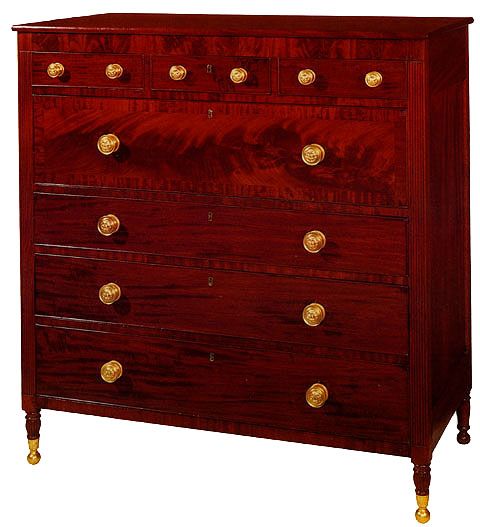 |
1810-1825 |
Possibly James Stymets (sp?) |
New York City |
Mahogany, tulip poplar, white pine. |
48 3/4 x 46 1/4 x 22 5/8" |
"James / Stymets / New York" in pencil on outside bottom of proper right top drawer. -per PZ. JC is not convinced of that deciphering |
Purchase, 1976 |
Purchased from Thomas Kyle, Goshen, NY, 11/8/76. |
0 |
|
|
The chest of drawers has five tiers of cock-beaded drawers. The uppermost has three shallow side-by-side drawers with veneered and cock-beaded fronts. The second drawer from the top is the deepest and features a figured mahogany veneer within crossbanding. The three drawers below are graduated in depth from shallow at the top to deep at the bottom. The fronts of the stiles have reeded panels. The stiles end in inverted baluster turnings that are reeded. The front legs have brass ferrule feet. The rear feet are solid mahogany turned to the profile of the front feet. The side panels of the case are recessed. The back is made of three tulip poplar boards, the middle board of which is grooved on each side to receive the flanking boards. The solid top board of the chest is made of brilliantly figured plum-pudding mahogany. Drawer pulls are stamped lion's masks. |
To date, nothing is known about James Stymets, although many Stymets lived in New York City from the mid eighteenth century on. |
Furniture |
66 |
| TRUE |
Work Table |
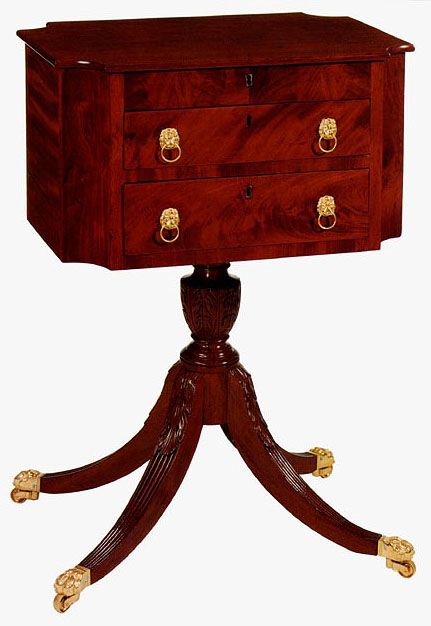 |
1817-19 |
Joel Curtis |
New York City |
Mahogany, mahogany veneer, tulip poplar, white pine. Brass |
33 x 22 1/4 x 16" |
"J. CURTIS / CABINET MAKER / 153 / Chamber Street / NEW YORK" printed in ink on paper label applied to top center of well for hinged writing surface. The shallower drawer has pencil numbers on the outside bottom board, perhaps representing cost calculations of a journeyman. |
Purchase, 1976 |
Ex-collection Charles K. Davis Purchased from Israel Sack, New York, NY, 11/19/76. |
0 |
Illustrated as pls. 183 and 184 in Nancy Mc Clelland, Duncan Phyfe and the English Regency (New York: William R. Scott, 1939), p. 199-200. |
|
The mahogany work table has a rectangular case with inset quarter round corner and two graduated drawers below a veneered frieze with a central keyhole to lock the hinged lid. The lid opens to a rectangular well that stores a hinged writing surface covered in green baize. The writing surface stands on a hinged mahogany support that fits into slots to adjust the writing height. Compartments for writing implements are on each side of the writing surface. The drawer fronts are mahogany veneer on solid mahogany. Drawer sides and bottoms are tulip poplar. An urn-shaped turned and leaf-carved shaft has four out-sweeping legs dovetailed into the bottom. The upper third of the legs is leaf-carved to match the urn. The rest of the legs is reeded. The legs end in cast brass paw feet and casters. |
Joel Curtis is listed in New York City directories at the address on the label from 1817 to 1819. |
Furniture |
73 |
| TRUE |
Pembroke Table |
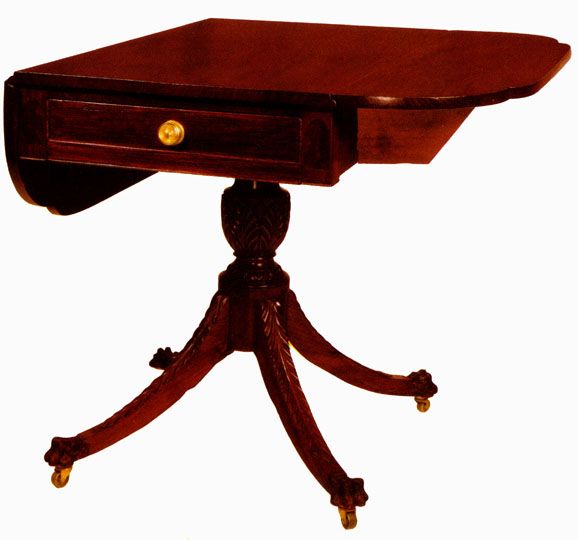 |
1810-20 |
Unknown |
New York |
Mahogany, maple, ash, tulip poplar, white pine. |
30 x 22 3/8 x 35 3/4" |
|
Purchase, 1976 |
Purchased from Ronald A. DeSilva, Garrison, NY, 6/17/76. |
0 |
Illustrated as fig. 36 in Philip D. Zimmerman, "New York Card Tables, 1800-1825," in American Furniture 2005 (Chipstone), p. 139. |
|
The carved mahogany drop-leaf or Pembroke table has double-elliptic leaves supported by two triangular flies on each side. A cockbeaded drawer is in one end and a sham drawer front in the other. Tombstone-shaped mahogany inlays flank the drawers. The urn shaped standard is carved with thick imbricated leaves. A carved water-leaf molding runs around the base of the urn. Four "sweep" legs decorated with water-leaf carving on the tops are slotted into the bottom of the standard. The legs terminate in carved hairy paw feet with a rectangular collar on the tops of the feet only. A hand recess to pull out the drawer indicates that the brasses are later additions. |
|
Furniture |
35 |
| TRUE |
Chest of Drawers |
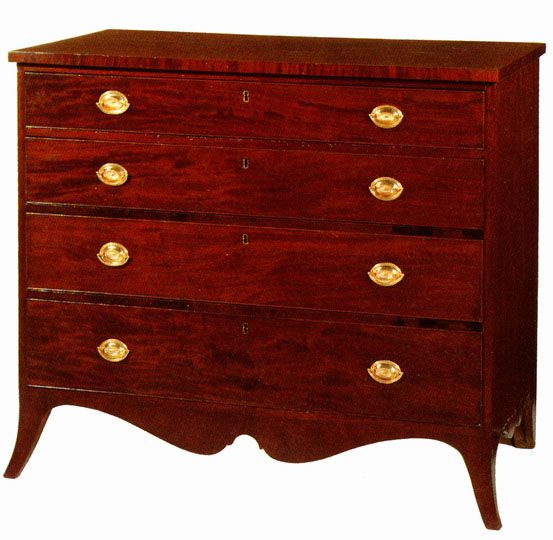 |
1800-1815 |
Unknown |
New York region |
Mahogany, mahogany veneer, tulip poplar, white pine |
37 7/8 x 43 1/4 x 22" |
|
Purchase, 1976 |
From the Fulton-Ludlow house, Claverack, New York. Purchased from Thomas Kyle, Goshen, New York, 11/8/76, who acquired the chest from the Fulton-Ludlow House Auction in Claverack, New York, in 1974. |
0 |
|
|
The rectangular chest of drawers has four graduated, veneered drawers with cock-beading. Drawer fronts are white pine, and sides and bottoms are tulip poplar. The case stands on tapered and flared bracket "French" feet in front and straight bracket feet in back. The front skirt continues the curves of the feet into long ogees, which meet in the center with a half-round or arch. |
|
Furniture |
64 |
| TRUE |
Bed |
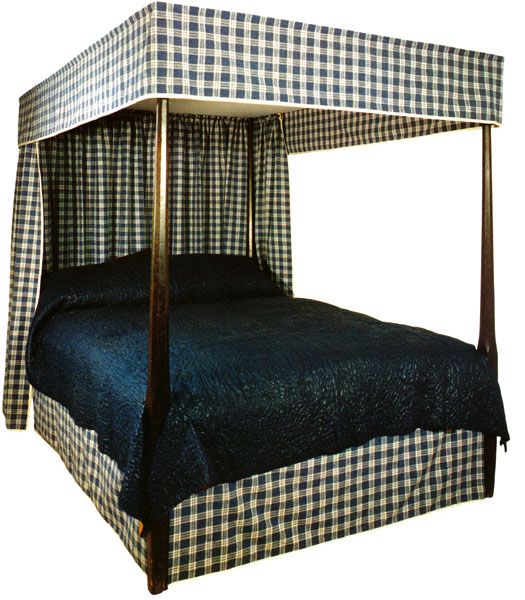 |
1780-1800 |
Unknown |
American |
Maple, pine, painted green |
72 3/4 x 83 1/4 x 59 1/4" |
|
Purchase, 1976 |
Purchase, Lewis Scranton, Killingworth, CT 11/4/76. |
0 |
|
|
Painted maple pencil post bedstead: with tapering octagonal head and footboards, a triangular headboard, a flat tester, the whole on square tapering legs painted dark green. |
|
Furniture |
54 |
| TRUE |
Two side chairs |
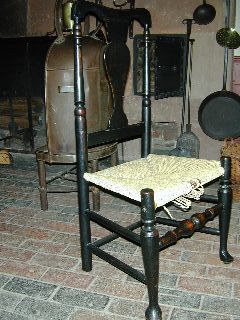 |
1780-1810 |
Unknown |
New York |
Maple, ash, rush |
40 x 21" |
|
Purchase, 1977 |
Purchased from Lewis W. Scranton, Killingworth, CT, 5/7/77. |
0 |
|
see F 77.2 |
An assembled pair of yoke back side chairs called "fiddle-backs" in their time. Each has a yoked crest rail above a solid vasiform splat set into a stay rail. The rear posts have columnar turnings with balls above and balusters below. The"trumpet"-turned front legs have reels below cylinder turnings at the tops of the legs. They terminate in offset turned pad feet. The ring-and-ball turned front stretcher has elongated balls at each end. Two side rungs and one rear rung brace the legs. Rush seat. Painted black. Chair "A" has a double ball at the top of the rear post and thinner rear posts than chair "B"; chair "B" has a single ball, and the stay rail is pegged. The "instep" of the foot of chair "A" approximates a 45-degree angle, whereas that on chair "B" is a sharper right angle. These two chairs differ from F 77.2 most notably in construction of the seat frame. |
|
Furniture |
25 |
| TRUE |
Table |
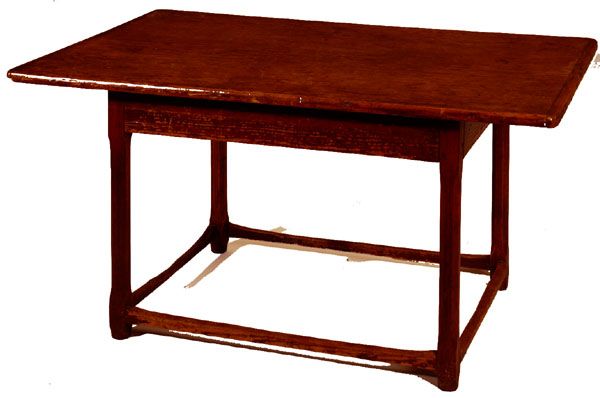 |
1750-1800 |
Unknown |
Mid-Atlantic or New England regions |
Maple and white pine |
25 1/2 x 31 1/4 x 48 1/2" |
"67 Petersville Rd" in pencil in the center underside of the top. |
Purchase, 1977 |
Purchased from Marguerite Riordan, Stonington, CT, 5/20/77 |
0 |
|
|
Pine tavern table with rectangular top with breadboard or batten ends extending over a plain rectangular frame on chamfered square legs joined by box stretchers. |
|
Furniture |
0 |
| TRUE |
Butler's tray and stand |
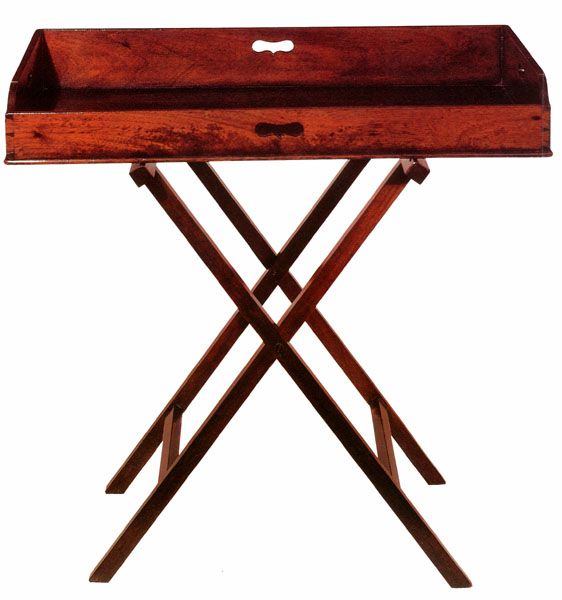 |
early 19th century (stand later) |
Unknown |
Probably England |
Mahogany |
tray: 34 x 21 x 2 3/4" stand open: 27 3/4 x 26 1/4" stand closed: 36 x 22" |
|
Purchase, 1977 |
Tray, Purchased from Thomas Kyle, Goshen, NY 2/28/77 (with different stand) Stand, Purchased from Toby's Antiques, Norfolk, CT 12/31/76 |
0 |
|
|
THIS OBJECT SHOULD BE RENUMBERED AS TWO OBJECTS. The rectangular butler's tray has dovetailed corners. The front and back sides are pierced for hand grips. The bottom board is screwed to the undersides of the sides with what appear to be machine-made screws. The folding mahogany stand is modern (probably 1875-1925) and not original to tray. |
According to Mr. Berry Tracy's notes: "Mahogany butler's trays and stands are found listed in all the New York Price books from 1796 through 1817, as well as in most early 19th century inventories, including that of Dyckman. Perhaps because of their heavy usage and vulnerability, American survivals are seldom seen. The butler's tray and stand in the Boscobel collection emerged only recently under the eaves of the attic of a Hudson River Federal period homestead, where it had survived the ravages of recent generations. It fits the descriptions of the New York Price books perfectly." |
Furniture |
46 |
| TRUE |
Banjo clock |
 |
1810-30 |
Benjamin Smith (agent) |
Boston, Massachusetts |
Mahogany, white pine, gilt, gesso, brass works, glass. |
33 1/2 x 10 x 4" |
"Smiths / New York" painted on dial. "Sea Nymph" on lower panel. |
Purchase, 1977 |
Ex-collection George Frelinghuysen Purchased from Spencer and Judd Antiques, Essex, CT, 9/15/77 |
0 |
|
|
The banjo or wall clock has a round face with brass bezel, painted dial, and cut steel hands. A gilded acorn finial is mounted above the clockface. The face stands above a narrow neck that tapers towards the top. It encloses a glass panel decorated with reverse painting. Pierced brass brackets are attached to each side. The rectangular base of the clock has a door with another painted panel depicting Aurora passing over the sun and labeled "the sea nymph." Brass works. |
Willard's patent banjo clock made in Boston, MA, and sold by Benjamin Smith's New York clock store. |
Household Items |
83 |
| TRUE |
Corner Basin Stand |
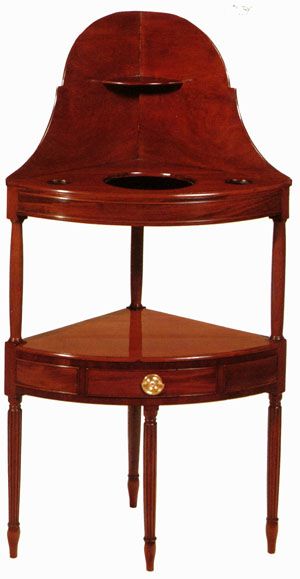 |
1805-20 |
Unknown |
New York |
Mahogany, tulip poplar, white pine |
48 x 24 3/8 x 17 5/8" |
|
Purchase, 1977 |
Purchased from Trump & Co. Flourtown, PA, 1/26/77 |
0 |
|
|
The corner basin stand has a high arched and shaped splashboard with a small quarter-round shelf attached near the midpoint. The upper shelf is pierced for a basin in the center and a soap receptacle at each side. The three turned corner posts have swelled turnings between the upper and medial shelves. The medial shelf is attached to a frame that incorporates a drawer in the center with a drawer-like panel at each side. The drawer has a brass pull. A fourth leg is attached to the center of lower rail. All four legs are tapered and end in swelled and tapered feet. The three front legs are also reeded. |
|
Furniture |
57 |
| TRUE |
Card Table |
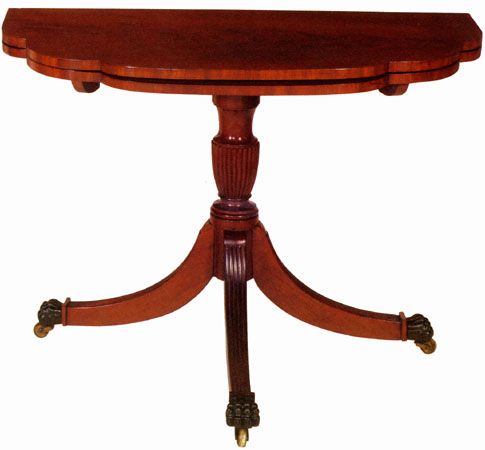 |
1805-15 |
Unknown |
New York City |
Mahogany, mahogany veneer, cherry, tulip poplar, white pine, brass, iron |
28 1/2 x 36 x 17 3/4" |
|
Purchase, 1977 |
Purchased from Joe Kindig, York, PA (a possible swap) 12/9/77 |
0 |
Illustrated as figs. 9, 11-14 in Philip D. Zimmerman, "New York Card Tables, 1800-1825," in American Furniture 2005 (Chipstone), pp. 124-27. |
|
Pair of "pillar and claw" card tables with treble-elliptic tops, reeded urn columns or "pillars," and three reeded legs with claw feet on brass casters. The two side legs swing back on internal iron rods when the cherry "flies" or brackets are opened to support the top. Card tables of this design were called "mechanical", now referred to as "trick-leg" card tables. The table leaves are veneered on the outside in matching flame mahogany veneers and on the inside in "plum-pudding" mahogany. The fixed table leaf is made of white pine with angled mahogany battens. The carved toes, the outer extremities of which are laminated, are painted dark green ("verd antique"). The brass casters and all iron fittings appear to be original. |
The pair is separated, one(b) is in the Front drawing room, and the other(a) is in the Rear drawing room. |
Furniture |
28 |
| TRUE |
Portrait, "Peter Corne" |
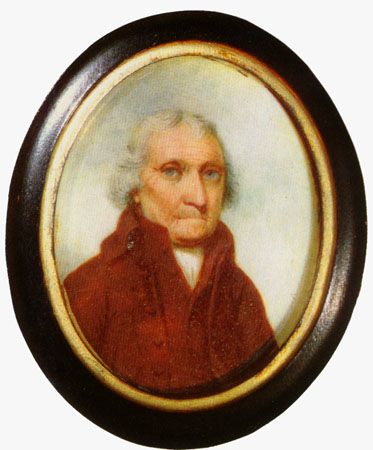 |
c. 1805 |
Unknown |
American |
Oil on ivory |
2-3/4 x 2-1/4" |
|
Purchase, 1978 |
Descended from Peter Corne to his daughter Elizabeth Corne De Girancourt, to her daughter Elizabeth Kane to her son Pierre Corne Kane, to his son Grenville Kane, to his granddaughter Mrs. Sybil Baker Carton (nee Sybil Baker, possibly Penelope Winslow Baker or Mrs. Ross W. Baker), from whom Boscobel purchased the miniature. Purchased from Mrs. Ross W. Baker of Oyster Bay, New York. |
0 |
|
See a similar portrait of Peter Van Schaack (1747-1832) of Kinderhook, NY, at the New-York Historical Society, acc. No. 1845.1. |
Peter Corne (1722-1807) by an unidentified artist. Miniature oil on ivory. Oval, with narrow gold frame mounted on rectangular plaque. |
|
Paintings |
113 |
| TRUE |
Center Table |
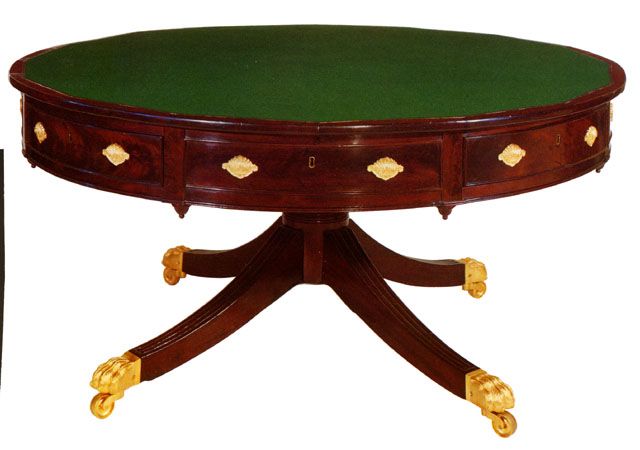 |
1810-25 |
Unknown |
New York |
Mahogany, tulip poplar, white pine, gilt brass, and green baize. |
29 3/4 x 59 1/4" |
"I K P / of [?] / Washing--" in black paint on underside of one large drawer. |
Purchase, 1979 |
This table originally purchased by James Kirke Paulding, for his house 8 miles north of Poughkeepsie. Passed to his son, James Nathaniel Paulding, remained in his house, "The Dormers" in Cold Spring, NY until his death. It was then acquired by Mrs. Pell's Mother from the daughters of James Paulding. Boscobel purchased the table from Elizabeth H. Pell. Cold Spring, NY 1/22/79 |
0 |
|
|
Circular, mahogany New York writing table: with four false drawers alternating with four working drawers and brass repousse escutcheons of classical form of acanthus leaf and reeded motif. The circular form sits on a sphere shaped base terminating in four splayed, reeded legs ending in brass paw feet with casters. The top is inset, with an octagonal green wool baize cover, trimmed with a leather border of gilt Greek key fret on a red ground. |
According to family tradition, it is believed that it was on this table that James Kirke Paulding wrote his famous "Salmagundi Papers." |
Furniture |
71 |
| TRUE |
Portrait |
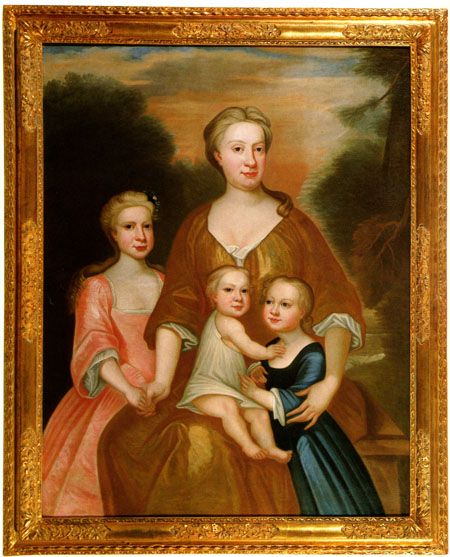 |
c. 1720 |
Attributed to John Watson |
American |
Oil on canvas, in original frame |
53 x 41" |
|
Purchase, 1976 |
Purchase, Joseph Alsop, a descendant, Washington, D.C. 1976. |
0 |
American Colonial Portraits: 1700-1776. National Portrait Gallery, Smithsonian Institution. 1987: page 127, John Watson, 1685-1768 on the Henderson portraits followed by a piece on Watson. |
|
Portrait of Mrs. James Henderson (nee Thysje Benson) seated wearing a brown dress, three children about her, with a landscape in the background. |
The Henderson portraits are now attributed to John Watson (1685-1768) on the basis of a notation in Watson's account book in the collection of the New York Historical Society. Mary Black also speculated that Watson himself removed his sketch of the two girls from Dr. Henderson's portrait, placing them in Mrs. Henderson's composition instead. If this is correct, then the baby in her lap is Elizabeth's Dyckman's grandmother. |
Paintings |
117 |
| TRUE |
Portrait |
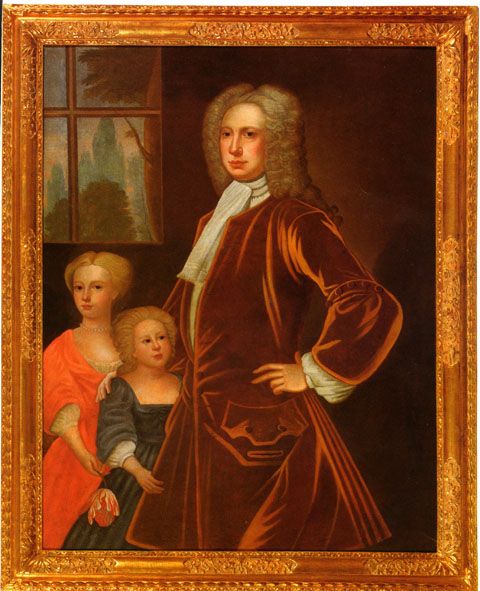 |
c. 1720 |
Attributed to John Watson |
American |
Oil on canvas, original frame. |
53 x 41" |
|
Purchase, 1976 |
Directly decsended from James Henderson to Elizabeth and Peter Corne Mrs. George Douglas, Mrs. Harriet Douglas, Elizabeth Mary Douglas Monroe, Mrs. William Rose Robinson, Douglas Robinson, and the Daniel Robinsons from whom it was purchased, CA 11/16/76 |
0 |
Black, Mary: "Tracking Down John Watson," American Art and Antiques Magazine, Sept./Oct. 1979, pages 78-85. |
|
Dr. Henderson standing, powdered hair, wearing a brown velvet coat, two children at his right and a window showing scenery in the backround. |
|
Paintings |
118 |
| TRUE |
Painting |
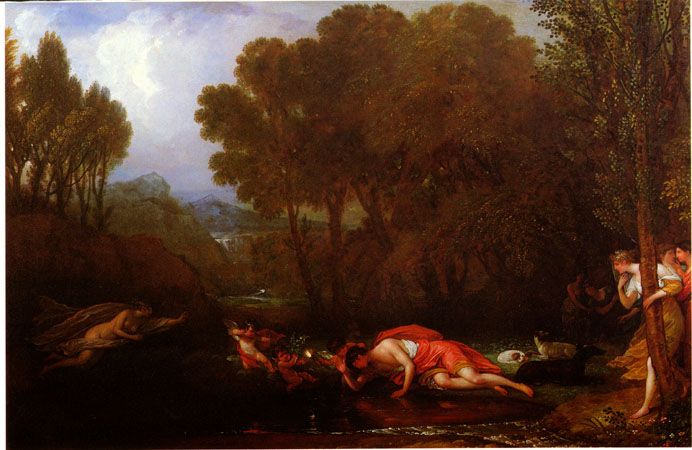 |
1808 |
Benjamin West |
English |
Oil on canvas, on wood |
23 1/2 x 36" |
Signed and dated lower left: B.West 1808. |
Purchase, 1962 |
Newman at Oxford Street, London until artist's death in 1820 Purchase, Hirschl & Adler Galleries, New York, NY 12/22/62 |
0 |
Chew, Paul, 250 Years of Art in Pennsylvania: p. 46 No. 132, plate 6. |
|
Oil on canvas on wood, view of Narcissus gazing at his reflection in a pool of water, signed and dated lower left; B.West 1808. |
Exhibitions: Westmoreland County Museum of Art. |
Paintings |
123 |
| TRUE |
Hall lamp |
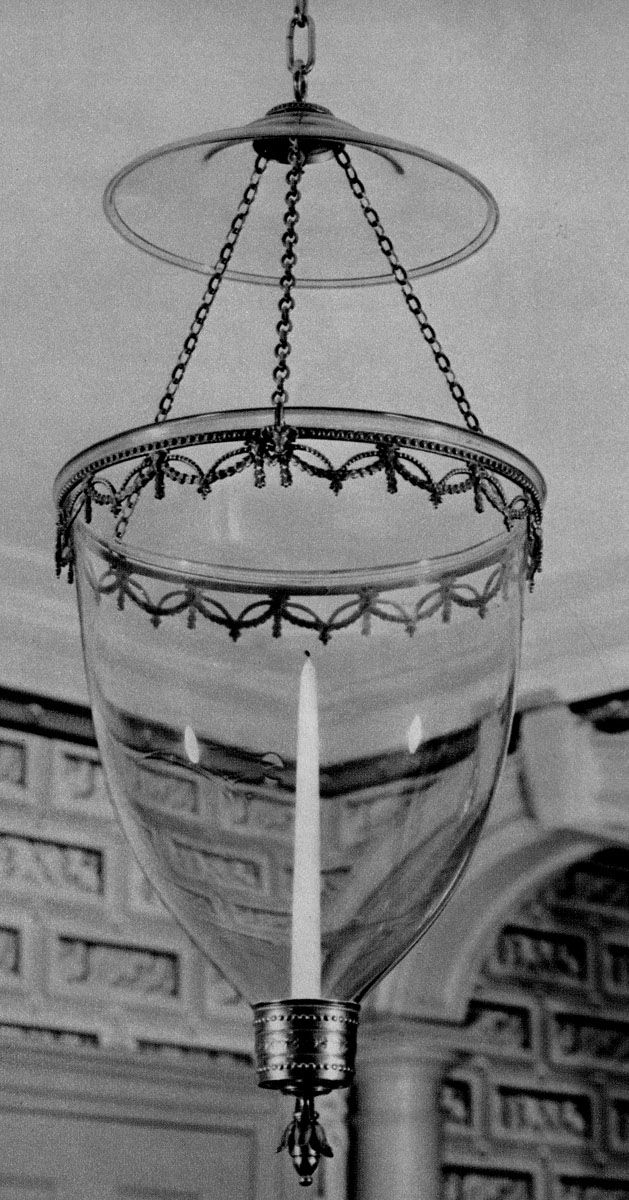 |
1790-1815 |
Unknown |
England |
Glass, brass |
36 1/4 x 15 1/4" |
|
Purchase, 1976 |
Purchased from Ginsburg & Levy Inc., New York, NY 9/16/76 |
0 |
|
|
The hall lamp and smoke glass hangs from a metal chain. The domed smoke glass has a folded edge. The lamp portion tapers from a folded rim at the top to a pointed bottom which is fitted with a brass cylindrical candle socket that terminates in a finial. The cast brass holding ring at the top of the lamp is an ornate swag. |
See H. Parrott Bascot, Nineteenth Century Lighting Candle Powered Devices: 1783-1883, no. 316, p.222 for image of lamp when owned by Ginsburg & Levy |
Lighting |
88 |
| TRUE |
Chandelier |
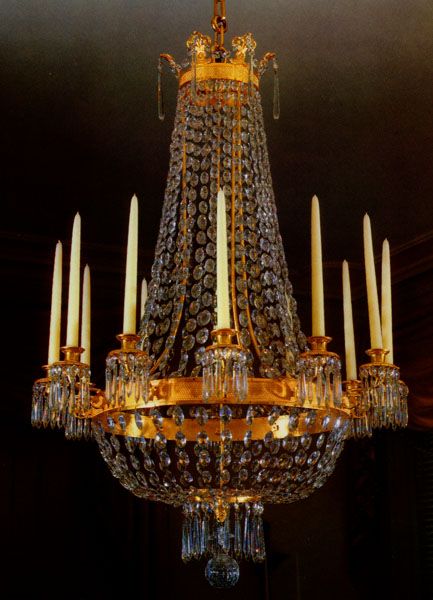 |
1810-1835 |
Unknown |
Probably England |
Glass and ormolu brass |
42 3/4 x 28" |
|
Purchase, 1977 |
Purchased from Gerald Speyer, 18 Motcomb Street, London 1/4/77 |
0 |
|
|
Chandelier: crystal and ormolu, oval cut crystal lusters suspended to form a bead-like support for circular ormolu band from which twelve candle arms are held. |
Pictured in H. Parott Bascot, Nineteenth Century Lighting Candle-powered Device: 1783-1883, fig. 312, p.220 |
Lighting |
90 |
| TRUE |
Looking Glass |
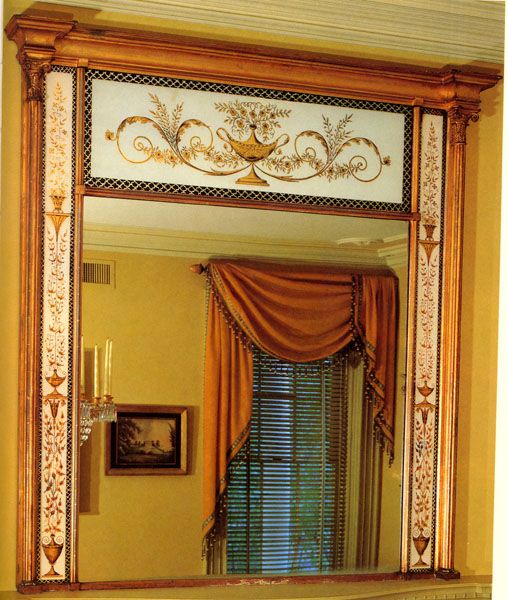 |
c. 1800-10 |
Unknown |
American |
Gilt-gesso on pine, eglomise tablets |
65 1/4 x 59 1/2" |
|
Purchase, 1981 |
Purchase, from The Metropolitan Museum of Art, New York, NY 4/17/81 |
0 |
|
|
Carved and gilded overmantle looking glass with eglomise decoration: with projecting coved cornice above an eglomise panel depicting a neo classical urn flanked by rinceaux, similar eglomise panels at the sides flanked by corinthian colonettes. |
|
Furniture |
80 |
| TRUE |
Looking Glass |
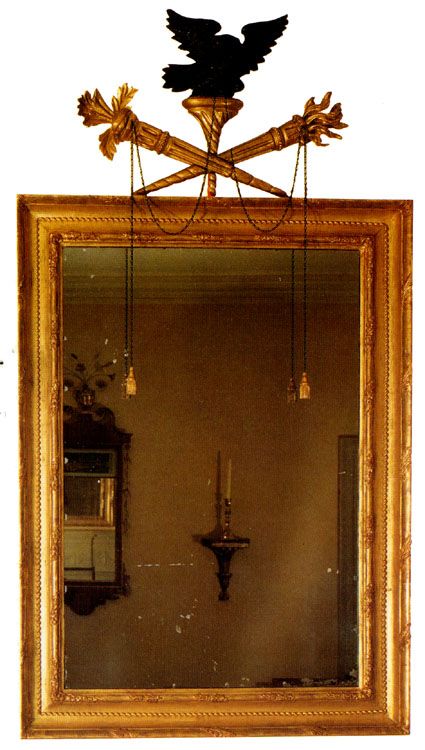 |
c. 1820 |
Unknown |
American |
Gilded wood, glass |
70 x 37 3/4" |
|
Purchase, 1971 |
Descended in the Wetherill Family of Philadelphia (gift of Fenton L. Brown) to the Met. Purchased, from The Metropolitan Museum of Art 4/17/81 |
0 |
|
|
Carved and gilded gesso pier mirror: coved frame with applied rope banding, the crest in the form of a perched ebonized American eagle above two crossed torches, flanked by tasseled chains suspended from the beak of the eagle. |
|
Furniture |
81 |
| TRUE |
Chandelier |
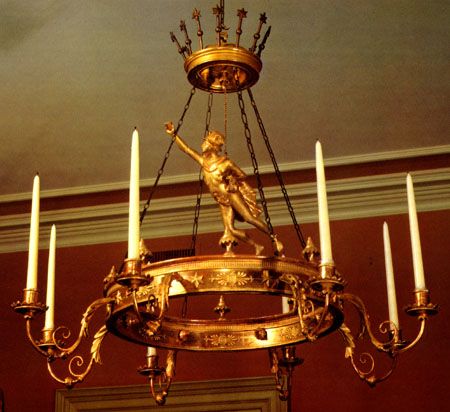 |
1805-1820 |
Unknown |
England |
Gilded wood, composition, iron and metal |
36 x 39" |
|
Purchase, 1976 |
Purchase, David Paton, London 12/14/76 |
0 |
Barbara Bielenberg, "Neo-Classical Lighting Devices at Boscobel," Rushlight 49, no. 4 (December 1983) H. Parrott Bacot, Nineteenth Century Lighting, Candle-Powered Devices: 1783-1883, no. 344. |
|
Gilded wood and metal Regency chandelier: eight light in the form of an anulus applied with anthemion motifs and having eight floral finials, supporting eight foliated scrolling candlearms and centering a figure of Mercury; the whole suspended by chains from a crown. Tracy gives a date of 1807 and attributes chandelier to William Holland, but files contain no substantiation of either. |
|
Lighting |
91 |
| TRUE |
Tilt-top breakfast or tea table |
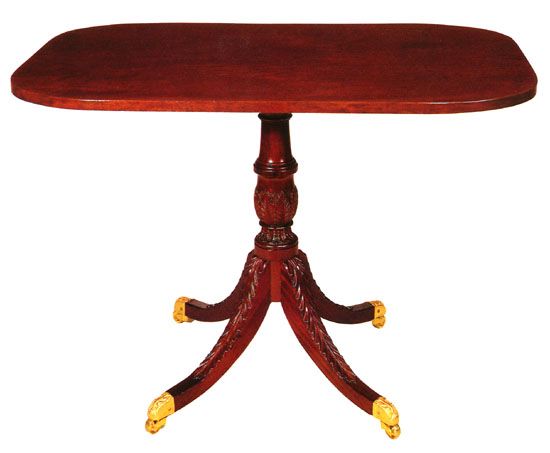 |
1810-1820 |
Probably Duncan Phyfe |
New York |
Mahogany |
29 7/8 x 42" |
|
Purchase, 1977 |
Descended in the Van Rensselaer, Livingston, and Strong families in Albany and Greenbush, NY 1805-10, and was acquired from a direct descendant. According to Miss Cornelia Livingston Van Rensselaer Strong, the table probably came from the Albany town house of the seventh Patroon, Stephen Van Rensselaer, who married Catherine Livingston. The table then passed to the ownership of Miss Katherine Westerlo Van Rensselaer who was the last Van Rensselaer to own Vly House at Greenbush, New York, across the river from Albany. This house was built in 1767 and demolished in 1926. The furniture was left to Mrs. Cornelia Livingston Van Rensselaer Strong who allowed Nancy McClelland to illustrate the table in her book, Duncan Phyfe and the English Regency, published in 1939. The present Miss Strong is her daughter and namesake, the table was acquired from her brother, Woodbridge, to whom she had given it. **This information needs to be verified Purchased by Boscobel from Fenton Brown, through F. Bealy, Essex, CT, 5/16/77 |
0 |
McClelland, Nancy Vincent. Duncan Phyfe and the English Regency, 1795-1830, New York: W. R. Scott, Inc. 1939. p.303, pl. 292. |
|
The rectangular top made of figured "plum pudding" mahogany has rounded corners. It is hinged to a block attached by double tenons to the top of a shaft. The shaft is turned to a column above a baluster carved with encircling water leaves. Four curved, or "swept," legs with water-leaf carved top surfaces are dovetailed into the base of the shaft. The legs end in foliated cast brass caps and casters, which appear to be original. |
|
Furniture |
44 |
| TRUE |
Basin Stand |
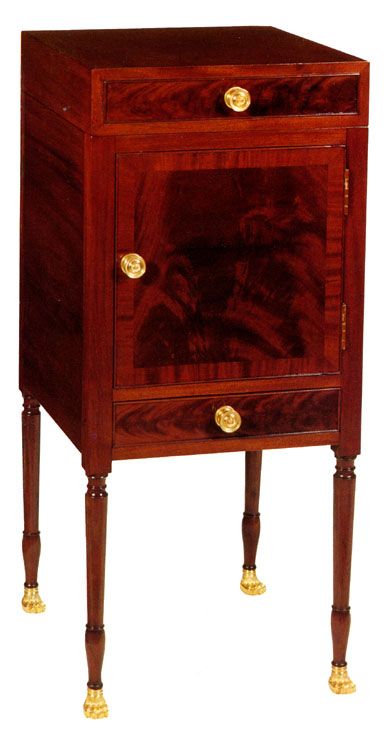 |
1810-20 |
Unknown |
New York City |
Mahogany, mahogany veneer, tulip poplar, white pine, brass paw feet |
36 x 15 3/4 x 15 3/4" |
|
Purchase, 1977 |
Purchased from, Israel Sack, Inc., NY, New York 1/28/77 |
0 |
|
Winterthur Museum, 57.1054 (See Montgomery, cat. no. 363). |
Mahogany washstand with a hinged top opening to a surface pierced for basin and soap receptacles. The front of the top is veneered and has applied beading and cross banding to simulate a drawer. The cock-beaded cabinet door has a veneered panel and cross banding. The veneered drawer at the bottom has cock-beading. The turned legs are tapered and end in bulbous turnings above cast brass animal paw feet slipped around wooden pin extensions. The case sides are solid mahogany. |
|
Furniture |
56 |
| TRUE |
Seascape |
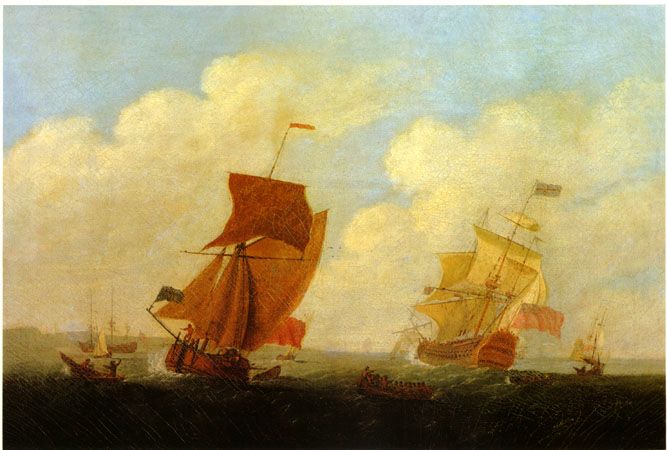 |
1785-1815 |
Unknown |
English |
Oil on canvas, wood frame |
27 1/2 x 35 1/2" |
|
On Loan from Department of Parks, City of New York |
According to family tradition, the painting was acquired by Dyckman on one of his visits to England. On loan from Dyckman house Museum since 1966. |
0 |
|
|
Oil painting of British naval engagement: by unidentified artist, depicting a sea battle between a victorious British man-o-war and floundering enemy ship. |
There is some debate as to the identity of the artist: perhaps the work of Francis Swaine or in "the style of" Francis Swaine. See correspondence in file. |
Paintings |
126 |
| TRUE |
Painting |
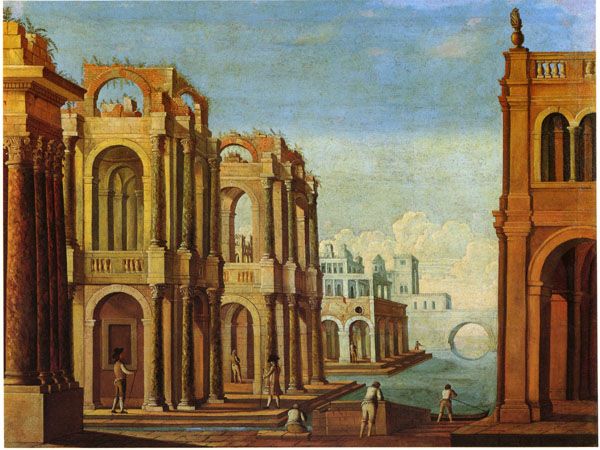 |
Late 18th century |
Unknown |
Italian |
Oil on canvas, gilded wood frame. |
33 x 44" |
One of the pair monogrammed A.S.F. and dated 1795 |
Purchase, 1963 |
Purchase, William C. Kennedy 11/12/63 |
0 |
|
|
Painting, oil on canvas, an architectural view with figures in the foreground. |
Frame is gilded wood, and unusually fine and rare. Not original to the paintings. Reframing done on March 26, 1964 for William C. Kennedy. |
Paintings |
128 |
| TRUE |
Painting |
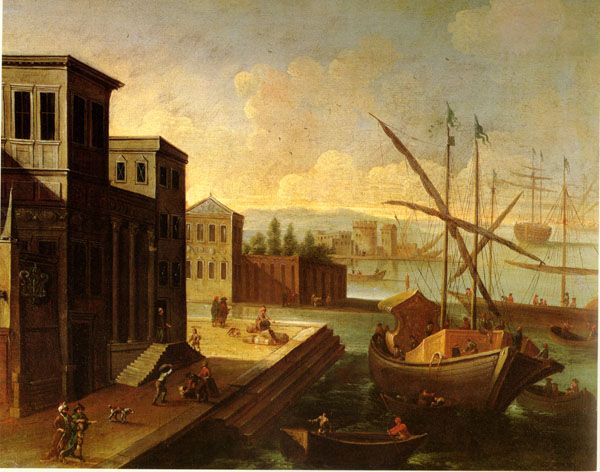 |
1790-1800 |
Unknown |
Italian |
Oil on canvas, gilded frame |
33 1/8 x 41 1/2" |
|
Purchase, 1963 |
Purchase, William C. Kennedy 11/23/63 |
0 |
|
|
Painting of architectural view: city view with ship and with figures in the foreground. |
Frame, gilded wood, is unusually fine and rare. Not original to the painting. Reframing done in March 26, 1964 for William C. Kennedy. |
Paintings |
127 |
| TRUE |
Portrait |
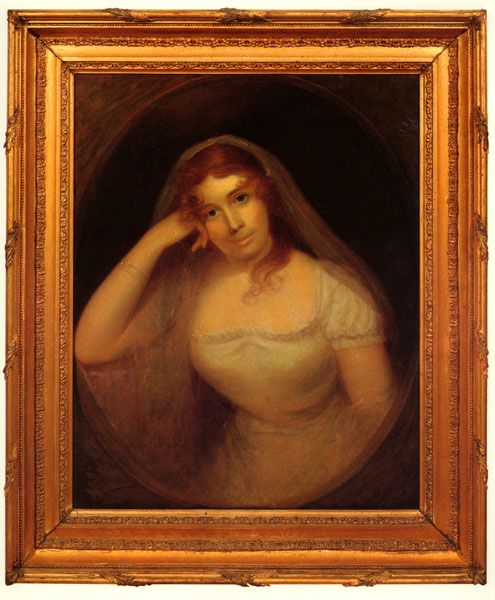 |
c. 1800 |
Unknown |
American |
Oil on canvas, gilded wood frame |
33 x 19 1/2" |
|
Purchased from Mrs. Douglas Robinson of Henderson House in 1962 (see letter in file) |
Formerly owned by/on loan to the Dyckman House Museum, Broadway & 204th Street, Parks Department, City of New York. |
0 |
|
|
Portrait of Elizabeth Corne Dyckman: the subject seated at half length and wearing a white dress, a shawl over her head; within a tromp- l'oeil oval. Original frame. |
Elizabeth was about 24 years old when this was painted. |
Paintings |
116 |
| TRUE |
Set of serving utensils |
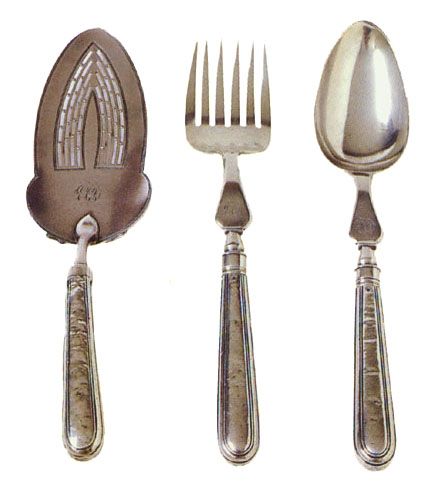 |
1802-3 |
William Eley & William Fearn |
London, England |
Silver |
Serving fork: 10-7/8 x 2; Serving spoon: 10-3/4 x 2-1 /8; Fish Server: 10 7/8 x 2 3/4" |
Each is marked with five hallmarks including date letter "G". The spoon and fork also have three hallmarks on the handle. Each has "ECD" engraved in script. |
Gift of Mr. and Mrs. Fred D. Thompson, 1961 |
Shipped aboard the "Commerce", September 30, 1803. Gift of Mr. and Mrs. Fred D. Thompson, 1961. |
0 |
|
|
fish server, serving fork, and serving spoon. The fish server has a decoratively pierced blade. The serving fork has six tines. The serving spoon has a pointed oval bowl. The handle of each is cased in silver. |
|
Silver |
105 |
| TRUE |
Ladle |
 |
1784-5 |
William Simmon |
London, England |
Silver |
13 3/8 x 3 1/4" |
"SMD" engraved on tip of handle. Five London hallmarks include "i" date letter for 1784-85 and king's head. |
Gift of Mr. and Mrs. Fred D. Thompson, 1961 |
* Provenance needs to be confirmed. Purchased by Mr. Dyckman from John Folgham & Son, London, 1788. Purchased by Mrs. Fred D. Thompson, through John Conover, Ossining, NY, 1961 |
0 |
|
|
Large silver ladle with "SMD" cypher and scallop shell shaped bowl. |
Stored in F 76.27 [JP] |
Silver |
0 |
| TRUE |
Set of six dessert spoons |
 |
c. 1803 |
Unknown |
England |
Silver |
7" L |
Monogrammed "ECD" |
Gift of Mr. and Mrs. Fred D. Thompson, 1961 |
Purchased from Dyckman heirs by John Conover of Ossining, NY 1961 Gift of Mr. and Mrs. Fred D. Thompson |
0 |
|
|
Set of six silver dessert spoons with pointed oval bowls, notched shoulders, and fiddle-back handles. "ECD" cypher engaved on underside of handle. |
|
Silver |
106 |
| TRUE |
Spoon |
 |
1802-3 |
Eley & Fearn |
England |
Silver |
5" L |
"ECD" on handle. |
Gift of Mrs. Fred D. Thompson |
Purchased from Dyckman heirs by John Conover, Ossining, NY 1961 Gift of Mrs. Fred D. Thompson |
0 |
|
|
Silver spoon: shovel shaped, neo-classic type with flat back turning handle, shovel shaped bowl. "ECD" cypher on handle. Bowl is gilt. |
|
Silver |
106 |
| TRUE |
Pair of ladles |
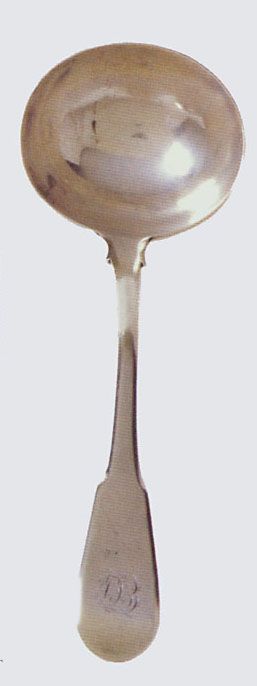 |
c. 1803 |
Eley & Fearn |
London, England |
Silver |
6 7/8" L |
"ECD" |
Gift of Mr. and Mrs. Fred D. Thompson, 1961 |
Boscobel origin Gift of Mrs. Fred. D Thompson, 5/13/61 |
0 |
|
|
Pair of ladles with oval bowls, notched shoulders, and fiddle-back handles. "ECD" cypher engraved on top of handle. "a" HAS NOT BEEN LOCATED AS OF 12/4/02 As of 2/16/2018 "a" is in the Butler's Pantry. |
|
Silver |
106 |
| TRUE |
Pair of mugs |
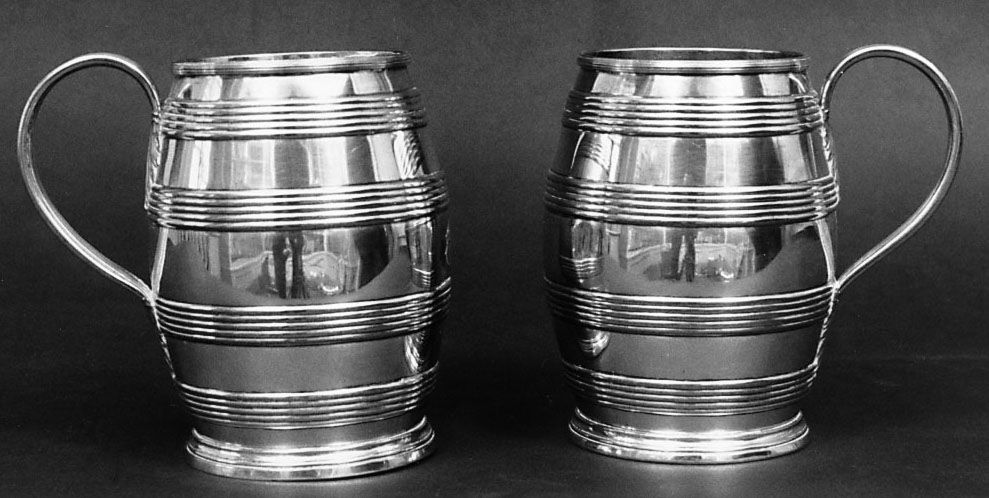 |
c. 1800 |
Unknown |
England, probably Sheffield |
silver plate, glass |
5 7/8 x 6" |
"ECD" |
On Loan from Department of Parks, City of New York |
"Two plated quart muggs" were among goods shipped on board the "Commerce", September 30,1803. On loan from Department of Parks, City of New York, Dyckman Farm House. |
0 |
|
|
Pair of silver-plated glass-bottomed mugs: marked "ECD". Bulbous shape, decorated with four bands of horizontal rings. Strap handle. |
|
Silver |
110 |
| TRUE |
Wine Coaster |
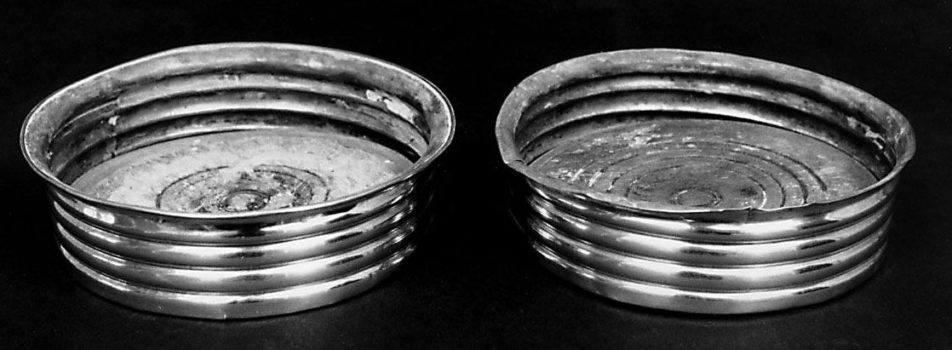 |
c. 1788 |
Unknown |
England, probably Sheffield |
Silver plate and wood |
1 1/2 x 5 1/4" |
|
On Loan from Department of Parks, City of New York |
Purchased by S.M.D. and shipped to New York on board the "Montgomery" in 1788 or 1789. On loan from NYC Dept of Parks Dyckman Farm house |
0 |
|
|
The pair of silver-plate bottle coasters has a circular wood base with turned decorative rings to which a ribbed and silvered body with flared rim attaches. |
|
Silver |
110 |
| TRUE |
Tea Service |
 |
c. 1800 |
Attributed to Coalport |
England |
Porcelain |
|
|
On Loan from Department of Parks, City of New York |
Descended in the Cruger family On loan from the Dyckman Farmhouse, Department of Parks, City of New York |
0 |
|
|
Porcelain partial tea set in rose-colored and gilded "rose and scale" pattern with key fret border on white porcelain body. The set consists of a covered oval teapot and oval tray, oval creamer, oval lidded sugar bowl, 2 cylindrical coffee cups, 3 tea cups, and 4 saucers. |
John Rose is attributed as maker. |
Ceramics |
96 |
| TRUE |
Dinner Service |
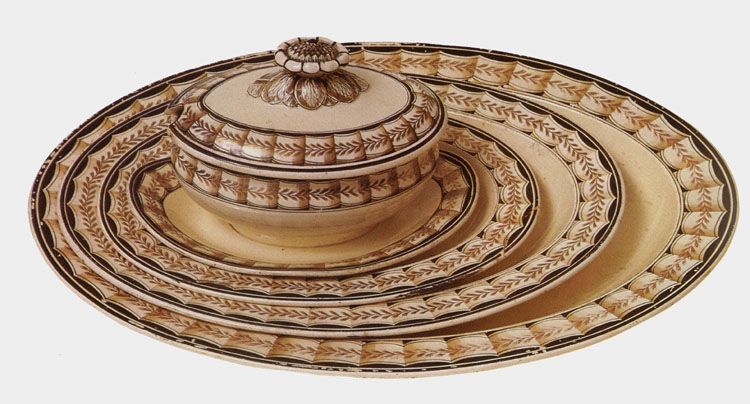 |
c. 1800 |
Probably Wedgwood |
England |
Creamware |
|
|
On Loan from Department of Parks, City of New York |
Permanent loan, Dyckman Farm House, NYC Dept of Parks. |
0 |
Robin Reilly, Wedgwood: A New Illustrated Dictionary, Antique Collectors Club Limited, 1995-Under the listing for Flute and Wreath Pattern it says: "One of Wedgwood's most distinguished Queen's ware patterns, known also as Lag and Feather, consisting of a fluted ribbon decorated with a continuous feathery wreath. It has been made in many colour versions, sometimes with gold, and was reproduced in red and black enamel on bone china c.1885. The earliest version of this pattern is no.289, enamelled in dark brown and red. Similar patterns were made by other potters including Leeds and Spode." |
The tureen, from Reilly's own collection is listed as a "Queen's ware sauce tureen and fixed stand, decorated with Flute and Wreath pattern in brown and red, with a pair of matching ladles, one pierced. Ladle length 6 1/2 in. c. 1790-5. |
Wedgwood creamware part dinner service in "lag-and-feather" pattern, decorated in sepia and gold. Dinner service consists of one sauce boat and cover with artichoke finial, four 10-inch dinner plates, and three graduated oval platters. |
Three plates are displayed in the Butler's Pantry. Two oval platters are also in the Butler's Pantry. One large oval platter is in the Butler's Pantry under the tureen. The covered dish and one dinner plate are located in the States Brewer Room. |
Ceramics |
94 |
| TRUE |
Tea Service |
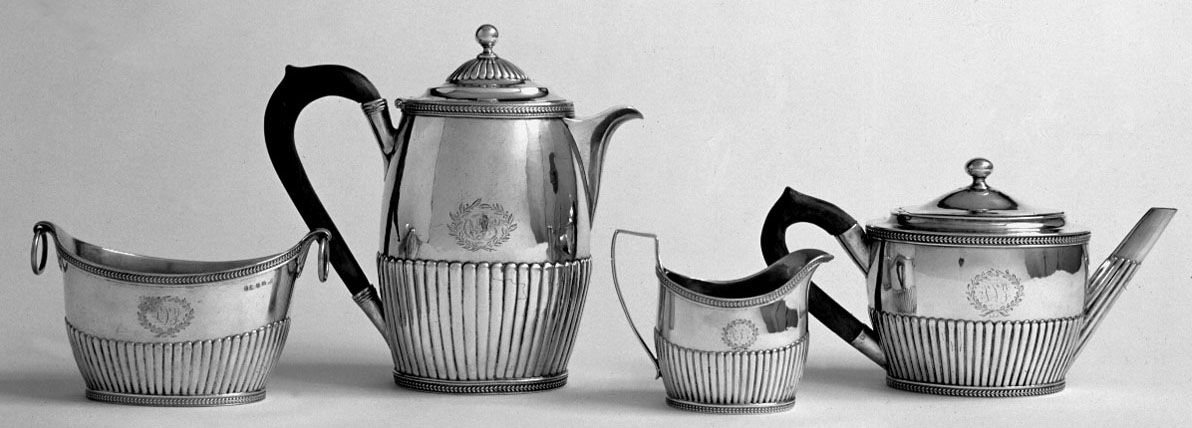 |
1800, 1803 |
Richard Crossley, John Eames |
London, England |
Silver |
|
|
Gift of Mr. and Mrs. Fred D. Thompson |
Formerly on loan, originally placed in the mansion in 1966. Gift of Mr. and Mrs. Fred D.Thompson 10/27/78 |
0 |
|
|
Silver tea service consisting of an oval lidded teapot, oval sugar basin, and oval milk pot by Richard Crossley, London, 1800; and a matching oval coffee pot, made by John Eames, London, 1803. All objects have fluting around the lower part of the bodies and gadroon borders at the top. All are monogrammed "ECD". |
|
Silver |
103 |
| TRUE |
Tea chest and canisters |
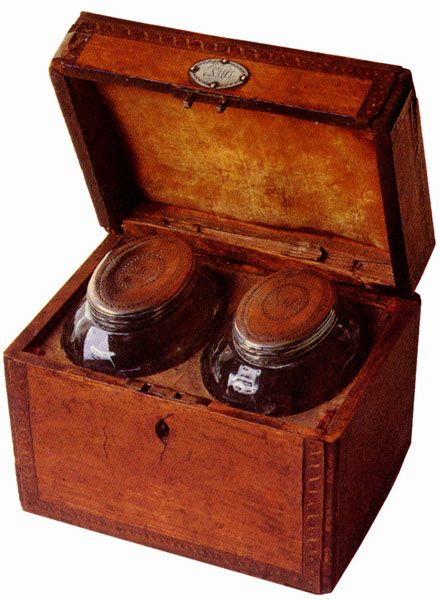 |
c. 1786 |
Unknown |
London, England |
Glass, silver, pine, satinwood veneer, inlays |
Box: 6 x 7-1/4 x 5-3/8; canisters: 4-7/8 x 4-1/8 x 2-7/8 |
|
On Loan from Department of Parks, City of New York |
Purchased from John Folgham, London, September 6, 1786 On loan from Dyckman House, Department of Parks, City of New York |
0 |
|
|
Pair of oval cut-glass tea canisters (or caddies) with vertically faceted sides and three equally spaced horizontal cut bands. The oval silver-mounted openings have hinged lids with bright-cut engraved bands and a central oval enclosing script initials "SMD". Three London hallmarks, lacking a date letter, include a raised "PC" in a recessed rectangle. The rectangular box with hinged lid has satinwood veneer sides and top and inlaid bands in a guilloche pattern at all of the edges. A silver handle is mounted in the center of the top, and an oval silver mount, engraved with script initials "SMD", is mounted above the keyhole, which shows no evidence of having had an escutcheon. The interior is fitted to receive the oval tea canisters and lined in velvet, originally a salmon-pink color, now faded to a tan. |
A bill of sale from John Folgham, London, September 6, 1786, lists "1 Tea Chest with 2 oval cut glass canisters & silver mounts" for 17.17.6. In small display case [JP] |
Glass |
101 |
| TRUE |
Portrait of States Morris Dyckman |
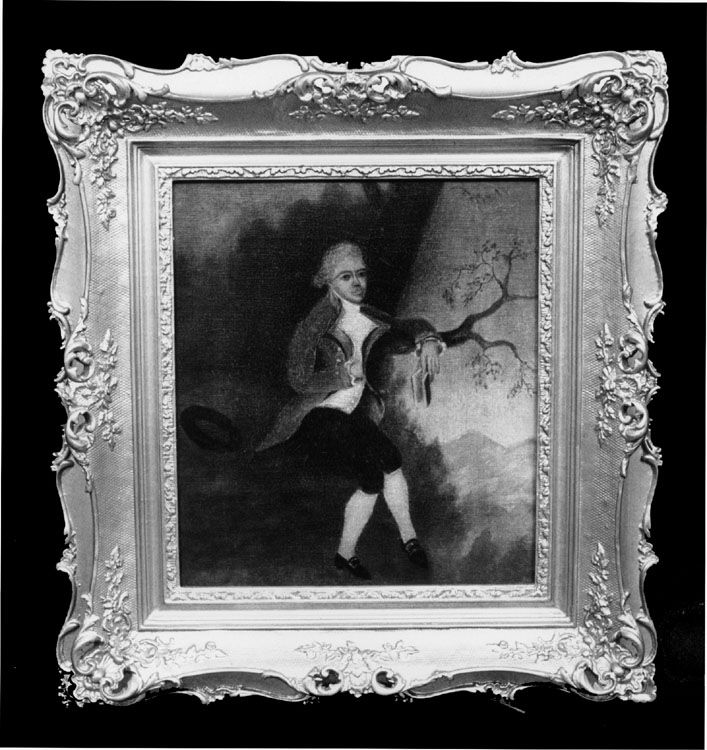 |
19th century |
Unknown |
United States |
Oil on canvas |
11-1/2 x 10-1/8 |
|
On Loan from Department of Parks, City of New York |
On Loan from Department of Parks, City of New York. |
0 |
|
|
The small oil painting of States Morris Dyckman shows him wearing a brown coat in a tree with his left arm supported by a tree limb and a book in that hand. An oval object, possibly meant to be a hat, lies on the ground behind and to the right of the subject. Features of the face and dress appear to have been drawn from the full-sized Dyckman portrait of c. 1785 (A 62.2). The painting exhibits very modest skill. The subject's legs are anatomically incorrect, the fingers unnaturally long and straight, and the face and overcoat executed in outline. The modern frame is painted brown and has a silver liner. |
File photographs show the painting in an ornate gilded frame. This painting may represent a very late copy that romanticizes Dyckman, his library, and his association with "Boscobel" and/or the "Old Royal Oak." The historic and artistic value of this painting is uncertain. Mary Black did not comment on the painting when she evaluated and wrote about the other paintings in the early 1980s. |
Paintings |
0 |
| TRUE |
Portrait |
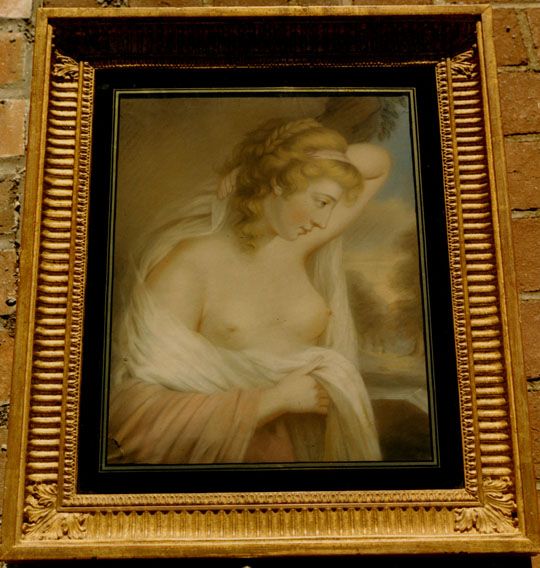 |
1800-25 |
Unknown |
Probably England |
Pastel on paper, with verre églomisé mat. |
15 3/4 x 12 1/2" |
|
On Loan from Department of Parks, City of New York |
On loan from the Department of Parks, City of New York 1966 Frame purchased from William. C. Kennedy, 3/26/64 |
0 |
|
|
Pastel on paper half-portrait of a bare-breasted woman with a thin gauze-like material around her shoulders and over one arm. Her blonde hair is braided. In a modern gold frame under glass with black and gold border. |
Mary Black, Curator of Painting, Sculpture and the Decorative Arts, New -York Historical Society, in her notes on the Boscobel paintings states: "The pastel drawing of a semi-nude nymph was received on loan from Dyckman Farmhouse where it had been misidentified as a portrait of Elizabeth Dyckman. It is tempting, though perhaps misleading, to associate the drawing with "an Astarte painted on glass in a gold frame", purchased from J.K. Smith by States Dyckman in London on March 5, 1783. The pastel retains its églomisé mat, but has been reframed. |
Prints/Drawings |
0 |
| TRUE |
Platter |
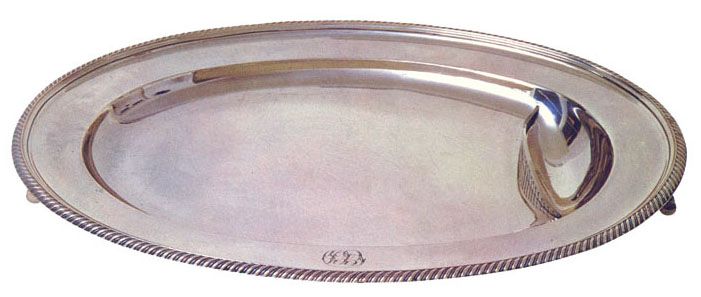 |
c. 1800 |
Unknown |
English |
Sheffield plate |
2 5/8 x 22 3/8 x 16 1/2" |
Monogrammed "ECD". |
On Loan from Department of Parks, City of New York |
There is a bill of sale, from Walter Smith, London, dated 11/28/1803. On loan from Department of Parks, City of New York. |
0 |
|
|
Two Sheffield Plate oval platters: with gadrooned edge and monogrammed "ECD". |
|
Silver |
109 |
| TRUE |
Snuffbox |
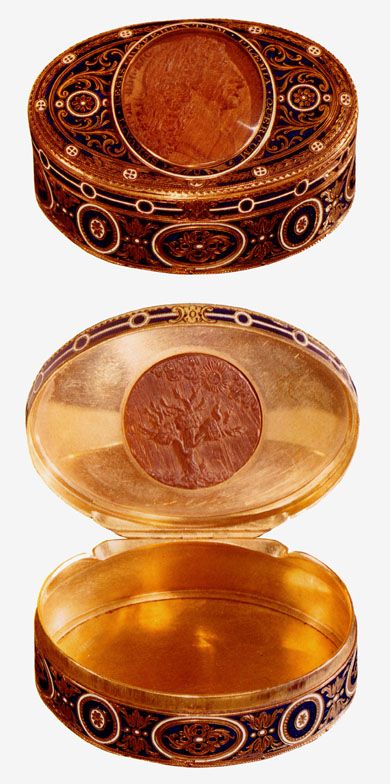 |
1798-99 or 1778-79 |
Lewis Pantin |
London |
Gold, enamel, wood |
1 1/4 x 3 1/8 x 2" |
Carved in the wood around the portrait of Charles II: "CAROLI II D. G. MAG. BRIT. FRAN. ET. HIB. REX" In gold letters around the wood portrait: "SERVATI REGIS REFERENTEM PRAEMIA QUERCUM" Makers mark "LP" for Louis Pantin |
Purchase, 1981 |
From December 1966 until June 1981, this snuff box was on indefinite loan from Mrs. Louise M. Robinson of 3 East 72nd Street, New York. After she died it was sold to Boscobel by her son Douglas Robinson. |
0 |
|
|
Gold and enamel oval snuffbox decorated with blue and white opaque enamel in neo-classical floral designs. The lid inset with relief carved wood portrait medallion of Charles II of England on the obverse and the Royal Oak on the reverse. |
On September 7, 1803, States Morris Dyckman wrote to his wife's grandfather, Peter Corne: "In one of my journeys to Ireland I had the good fortune to procure a small piece of the Royal Oak which once protected a Monarch, out of which I have had two Snuff Boxes made." |
Ceramics |
92 |
| TRUE |
Hot Water Urn |
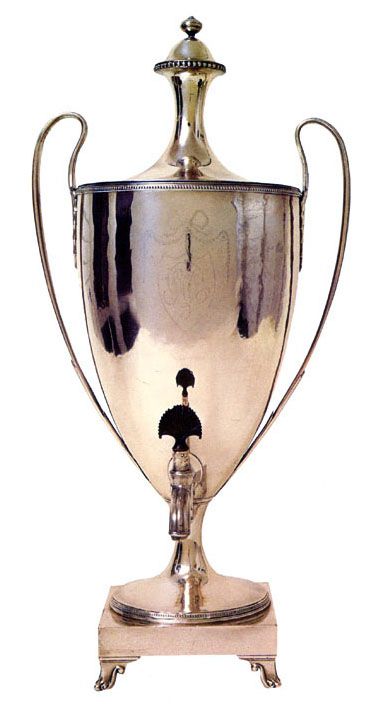 |
c. 1788 |
Unknown |
England, probably Sheffield |
Silver plate |
21 x 10 3/4" |
|
On Loan from Department of Parks, City of New York |
A "plated tea urn" was shipped aboard the "Hope" in 1788 by Mr. Dyckman. Loan from the Department of Parks, City of New York. |
0 |
|
|
Silver plate hot water urn in an urn shape with a loop handle at each side. The urn body sits on a narrow stem that flares outward and surmounts a square base on four bracket feet. The lid flares inward to support a small domed top with button finial. A spout projects from the front at the base of the body. Monogrammed "SMD" within a garland and shield. |
Tea urn designed with a tube inside to hold a heavy iron weight which was heated in the fire and inserted into the tube to maintain hot water for tea. |
Silver |
112 |
| TRUE |
Candle Snuffer |
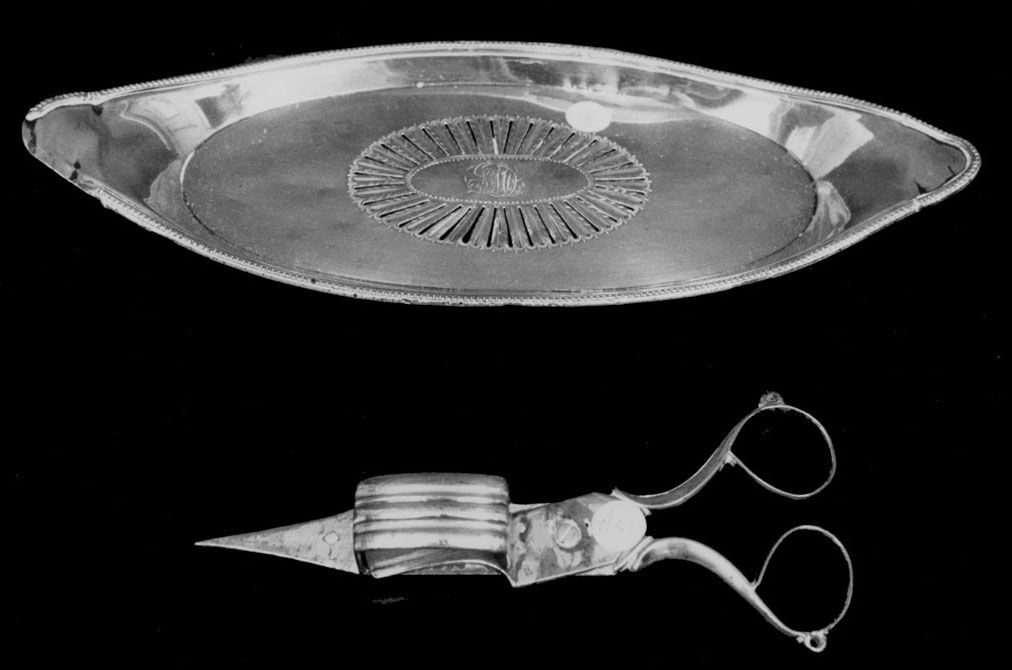 |
c. 1790 |
Unknown |
England, probably Sheffield |
Silver and silver plate |
snuffer: 1 x 6 1/4" tray: 10" |
|
On Loan from Department of Parks, City of New York |
Dyckman family collection, possibly from John Folgham; sales slip dated 5/13/1787 refers to such a snuffer. On loan from the Department of Parks, City of New York |
0 |
|
|
Silver candle snuffer on silver-plate tray: marks on snuffer are illegible, tray is boat shaped with gadrooned edges and "SMD" cypher. |
|
Silver |
110 |
| TRUE |
Jug |
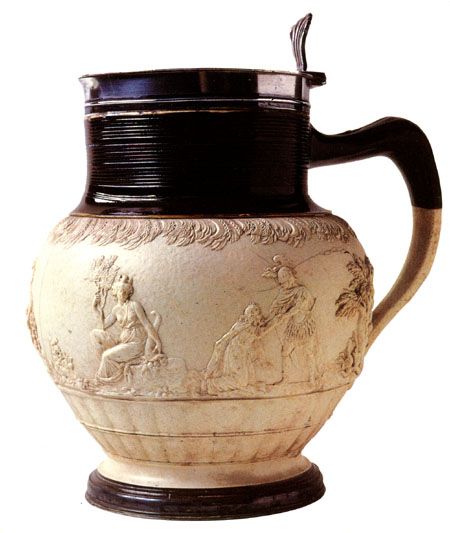 |
c. 1800 |
Williams Adams |
Tunstall and Stoke, Staffordshire, England |
Stoneware and silver |
8 x 7 7/8" |
"ADAMS" impressed [WHERE?]; "ECD" engraved [WHERE?] |
On Loan from Department of Parks, City of New York. |
On loan from The Department of Parks, City of New York. |
0 |
Chaffers, William. Marks and Monograms on Pottery and Porcelain: vol.2 pp.54-7. |
Godden, John A. Illustrated Encyclopedia of British Pottery and Porcelain, Crown' 66, shows a very similar jug on page 6. |
Silver mounted stoneware jug: monogrammed "ECD", ovoid and relief molded with an allegorical frieze, brown glazed collar and hinged silver cover. |
See bill from William Watson: Goldsmith, Jeweler, and Watchmaker, London, June, 17,1802. Probable silversmith of jug is John Robins, London 1803. |
Ceramics |
95 |
| TRUE |
Dessert Service |
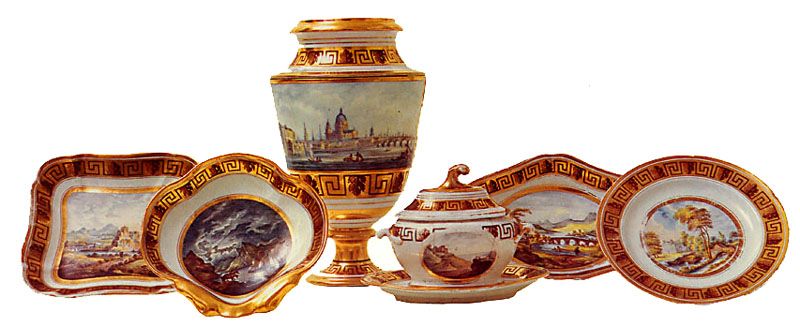 |
c. 1800 |
Coalport |
Staffordshire, England |
Porcelain |
See file |
Most pieces marked on the reverse with the location name of the depicted scene. |
On Loan from Department of Parks, City of New York |
Purchased by States Morris Dyckman, bill of sale dated September 24, 1803, from Sharpus and Co. London. On loan from The Department of Parks, City of New York. |
0 |
Godden, Geoffrey, A. FRSA, An Illustrated Encyclopedia of British Pottery and Porcelain, 1966, pp.91-92 Godden, Geoffrey, A. Coalport & Coalbrookdale Porcelains, 1970 |
Wells collection Los Angeles County Museum of Art |
Part of a "rich dessert service painted in landscapes to order": Coalport porcelain purchased from Sharpus and Co., London. White and gold porcelain with red and gold key-fret border enclosing landscape medallions. The lobed-edge dessert plates show scenes of Glenarm, Wolerton, Sion House, Fonthill, Moccas Court, Loughborough, Windermere Lake, Lambris Lake and Taymouth. 18 pieces in all. |
This Sharpus was a dealer, not to be confused with an earlier potter of like name. Ice pail and three plates (Wolerton, Fonthill and Sion House) are in the Museum Room. |
Ceramics |
93 |
| TRUE |
Pair of candelabra |
 |
1803 |
Unknown |
England |
Ormolu (gilded brass) and lead glass |
33" H |
|
On Loan from Department of Parks, City of New York |
Purchased by States Morris Dyckman, from John Blades, in September 1803. On loan from Department of Parks, City of New York. |
0 |
Barbara Bielenberg, "Neo-Classical Lighting Devices at Boscobel," Rushlight 49, no. 4 (December 1983) |
|
Each candelabra has a glass columnar shaft mounted on an open four-legged ormolu base. The shaft supports four candlearms joined by cut glass swags. : One pair, four light cut standards crested with a waterfall and supporting four scrolling candle arms; hung with lusters. |
This candelabra, when purchased in 1803, cost 45 pounds. See bill in meeting room wall. Gilt, as referred to in the bill from John Blades, refers to silver gilt, which in Connoisseur's Encyclopedia is described as follows: Silver gilt, silver with applied surface of gold. The traditional technique of mercury gilding consists of painting on an amalgam of mercury and gold. The former is driven off with heat and the gold adheres to the silver. |
Lighting |
111 |
| TRUE |
Set of four standing salts |
|
1790-1810 |
Unknown |
England or Ireland |
lead glass |
3 3/8 x 4 x 2 1/2" |
|
Gift of Mr. and Mrs. Fred D. Thompson, 1961 |
Boscobel origin, possibly purchased from John Blades in 1803 Purchased from John Conover, Ossining, NY Gift of Mr. and Mrs. Fred D. Thompson, 5/15/61 |
|
|
|
Four cut glass standing salts with stepped oval foot, faceted body, band of cut lozenges, and vandyke rim. The underside of the foot is star or ray cut. |
|
Glass |
|
| TRUE |
Set of four Dishes |
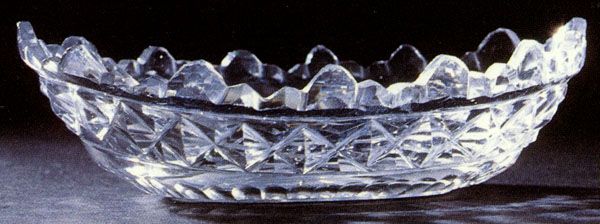 |
1780-1800 |
Unknown |
England or Ireland |
lead glass |
1 1/2 x 5 x 3 3/8" |
|
Gift of Mr. and Mrs. Fred D. Thompson, 1961 |
Believed to be of Boscobel origin, possibly from John Blades, London. Purchased from John Conover, Ossining, NY Gift of Mr. and Mrs. Fred D. Thompson 5/15/61 |
0 |
|
|
Four oval dishes with diamond-cut sides and, trefoil or "Vandyke" cut rim. |
|
Glass |
98 |
| TRUE |
Covered punch bowl and stand |
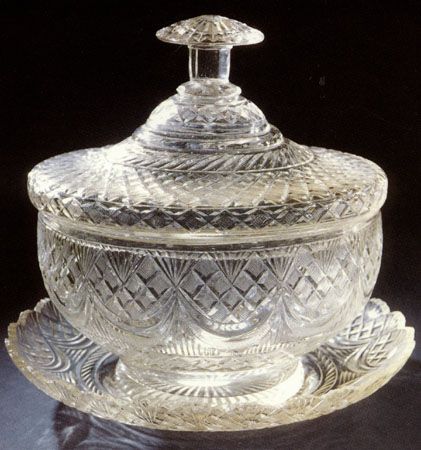 |
1820-1835 |
Unknown |
Northern Europe, probably Belgium |
nonlead glass |
Punch bowl: 11 x 10 1/4" Stand: 1 7/8 x 12" |
|
Gift of Mr. and Mrs. Fred D. Thompson, 1961 |
Peter Corne Dyckman Gift of Mr. and Mrs. Fred D. Thompson 5/13/1961, who purchased it from John Conover, Ossining, NY, in 1961. |
0 |
|
See Joseph Philippe," Le Val-Saint-Lambert: Ses Cristalleries et l'art du verre en Belgique" (Liege: Libraries Halbart, 1974), no. 32, pp. 70-71. |
Cut glass covered punch bowl and stand in a swags-and-strawberry-diamonds design. The cover has a section cut out to accommodate a punch ladle. |
This punch bowl is said to have been a wedding gift to Peter Corne Dyckman and his bride, Susan Matilda Whetten, c. 1821-22. |
Glass |
99 |
| TRUE |
Sideboard |
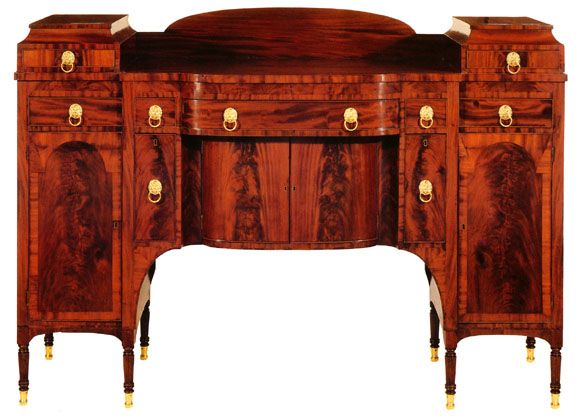 |
1810-20 |
Unknown |
New York City |
Mahogany, mahogany veneer, white pine, tulip poplar, brass |
53 x 76 1/4 x 28" |
|
Purchase, 1976 |
Ex collections: Mrs. J. Amory Haskell, Robert Sack. Purchased from Ronald De Silva, Garrison, NY 5/22/76 |
0 |
|
Similar to a sideboard deaccessioned from Boscobel and sold at Northeast Auctions, August 3-4, 2002, lot 898 (acc. no. F 82.1). Another similar sideboard with reeded stiles surmounted by rosette plaques, formerly in the collection of Berry B. Tracy, was sold at Christie's New York, October 8, 1997, Lot 97. Another sideboard was at the sale of the John Hay Whitney estate, Sotheby's NY, April 21, 1999 (see photos in file). |
Veneered mahogany rectangular, 8-leg, pedestal end sideboard. An arched splashboard above the center top connects raised pedestals with deeply coved moldings at the top and housing a single drawe. The case center is swelled in front and has a long narrow drawer above recessed cupboard doors, the whole flanked by narrow drawers above bottle drawers. The case ends have single drawwers above deep cupboard doors with crossbanding forming an arched panel. The side board stands on turned and reeded legs with brass ferrules. White pine drawer fronts with tulip poplar sides and bottom. |
This type of pedestal-end sideboard was illustrated in the frontispiece of the 1810 New York cabinetmaker's price book. |
Furniture |
40 |
| TRUE |
Pair of Pembroke tables |
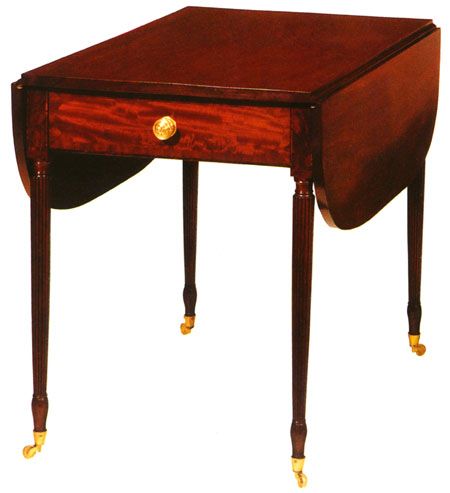 |
1805-1815 |
Unknown |
New York |
Mahogany, mahogany and rosewood veneer, tulip poplar, cherry, white pine |
28 1/2 x 34 5/8" |
"BEEKMAN" printed in ink on a jelly label applied to the underside of the drawer blade of each table. |
Purchase, 1976 |
Beekman family Purchased from Joe Kindig, York, PA /25/76 |
0 |
|
|
The pair of mahogany Pembroke tables has hinged leaves with rounded corners, each of which is supported by two triangular flies made of cherry on each side. The frame has a drawer in one end and a sham drawer in the other, each of which has a brass pull. The white pine drawer fronts have mahogany veneered rectangular panels with astragal ends, bordered by cross banding. A narrow band of rosewood runs along the bottom of the drawer front and across the legs. Rosewood banding surrounds rectangular mahogany veneer panels at the tops of the legs. The drawer front extends down below the drawer sides to hide the drawer blade joining the legs. The turned, tapered legs are reeded and end in bulbous feet with brass casters. |
|
Furniture |
34 |
| TRUE |
Set of one rocking armchair and 3 side chairs |
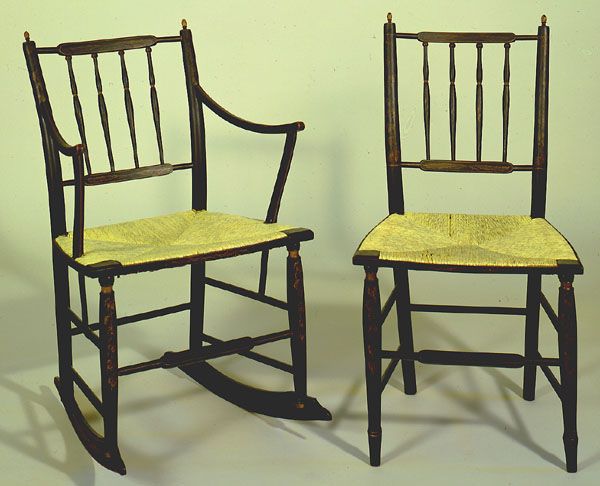 |
1810-1825 |
Unknown |
New York or Southern New England |
maple, rush seats |
See Dimensions in Notes section |
|
Purchase, 1961 |
Purchased from W.C. Kennedy Antiques, 6/10/61 |
0 |
|
|
The set of three turned side chairs and matching rocking armchair have rear posts bent backward at seat level. The posts have acorn finials. The chair backs are formed by a crest and stay rail into which four turned "double-baluster" spindles are tenoned. The turned front legs have reels at the top and swell slightly in the upper portion. They are joined by a turned stretcher having a rectangular tablet in the center. The sides have two turned stretchers and the back has one. The armchair has sweep arms supported by an inclined upright that joins the upper side stretcher. Applied strips of wood encase the sides of the rush seat. The legs seat casings, crest and stay rails are painted with gilded foliage and striping on a black ground. The rush seat is painted a cream color. |
F 61.14.1 formerly F 61.14 rocking armchair located in Sill's Bedroom F 61.14.2 formerly F 61.15 located in the Guest bedroom F 61.14.3 formerly F 61.16 located in the Guest bedroom F 61.14.4 formerly F 61.17 located in the Upstairs back hallway .1: 35 1/2 OH x 20-5/8 OW x24-1/4 OD .2: 35-7/8 OH x 18-3/8 OW x 21 OD .3: 35-7/8 OH x 18-3/4 OW x 19-1/2 OD .4: 35-1/2 OH x 18-3/8 OW x 19-1/2 OD |
Furniture |
0 |
| TRUE |
Cupboard |
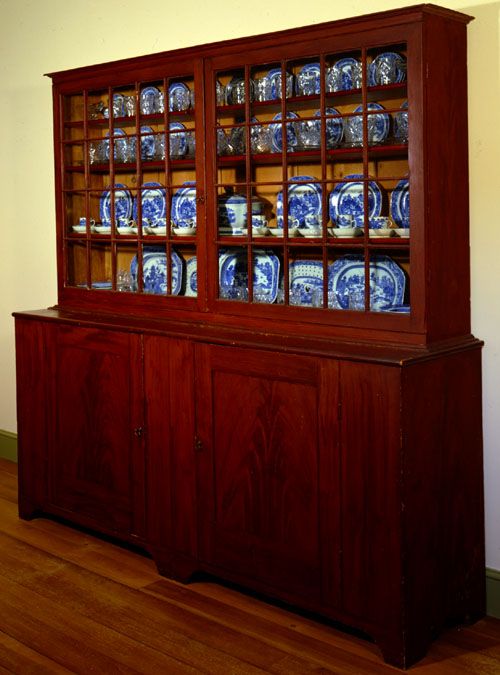 |
1800-1820 |
Unknown |
Possibly Cooperstown area of NY |
white pine |
83 1/4 x 84 1/2 x 20 1/2" |
|
Puchase, 1961 |
June 10, 1961, bill of sale from William C. Kennedy lists "Painted and grained large cabinet, with green tinted glass doors, From Lakelands, Cooperstown, N.Y. American, 1800. Lakelands was a house built in 1804 by John Myers Bowers. An early accession card states that this cupboard was purchased from Mary Allis on 6/10/61, but evidently that is incorrect. |
0 |
|
|
Mahogany-grain painted three-part cupboard. The lower section is made in two halves, vertically seamed in the center. The stepped-back upper section with molded cornice has glazed and mullioned doors with 20 panes each that open to three fixed shelves. Each lower section has a cupboard door with painted crotched mahogany figure that opens to two fixed shelves inside. The panels within the door frames have scratch beads cut around the edges. The cupboard stands on straight bracket feet in the corners and center front. |
|
Furniture |
0 |
| TRUE |
Cupboard |
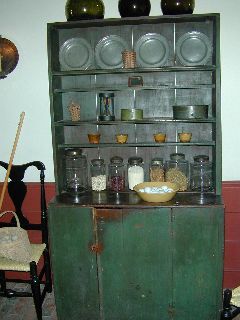 |
1740-1780 |
Unknown |
American |
Pine |
62 x 39" |
|
Purchase, 1961 |
Purchase, Mary Allis, Bronson Road, Greenfield Hills, Fairfield, CT 5/29/61 |
0 |
|
|
Painted pine cabinet with four open shelves above a lower cupboard, painted green. |
|
Furniture |
0 |
| TRUE |
Tankard |
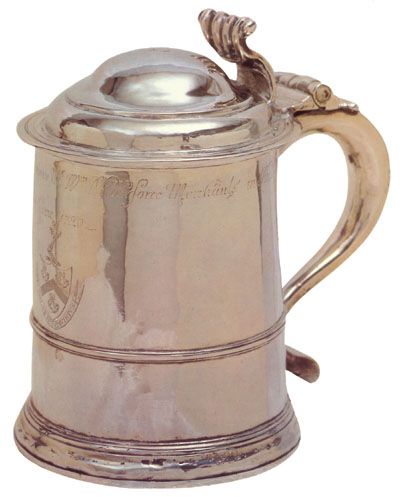 |
1719-20 |
John Sanders |
London |
Silver |
7 3/8 x 7 1/8" |
"The Gift of Mr. Jno. Thornton & Mr. Wm. Wilberforce Merchants of Hull / Mr. Robt Thornton Mercht in Londn. to Mr. Peter Corne 1720" engraved around front of body near top. Four hallmarks on body near top to right of handle include lion's head, Britannia, date letter "D", and "SA" maker's mark. "SA" on lid and on handle spine. |
Purchase, 1978 |
Purchased from Mrs. Ross Baker, 167 Ivy Street, Oyster Bay, NY 5/3/78 |
0 |
|
|
Silver tankard with domed lid and scrolling handle. The body of the tankard opposite the handle is engraved with a shield surmounted by a mailed arm holding aloft a hunting horn. The shield divided in the top section by three similar horns at the lower area by a ribbon banner bearing the inscription, "Sola Juvativirtus." The double-domed lid is attached with a five-part hinge and surmounted by a molded thumbpiece. The body has a mid-rib and molded base. |
Maker is identified in Seymour B. Wyler, Old Silver, p. 149. |
Silver |
108 |
| TRUE |
Pair of candelabras |
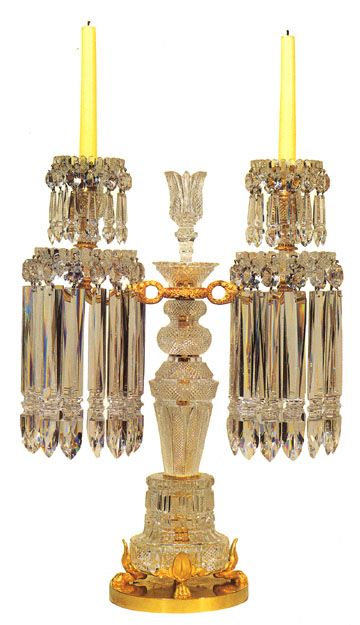 |
1805-1820 |
Unknown |
England |
Ormolu (gilt brass) and glass |
21 1/2 x 15 1/4 " 6 5/8" diam. at base |
|
Purchase, 1978 |
Purchased from Marvin Alexander, New York, NY, on 9/1/78 |
0 |
Barbara Bielenberg, "Neo-Classical Lighting Devices at Boscobel," Rushlight 49, no. 4 (December 1983) |
|
Pair of two-light candelabras, with cut glass standard supported by an inner ormolu shaft, on ormolu paw feet on a disk base. Two candle arms with two tiers of cut glass pendants, supported by cast ormolu arms. NOTE: The different pieces of glass that make up the shaft may not be in the correct order. Some elements may also be inverted. |
|
Lighting |
87 |
| TRUE |
Looking Glass |
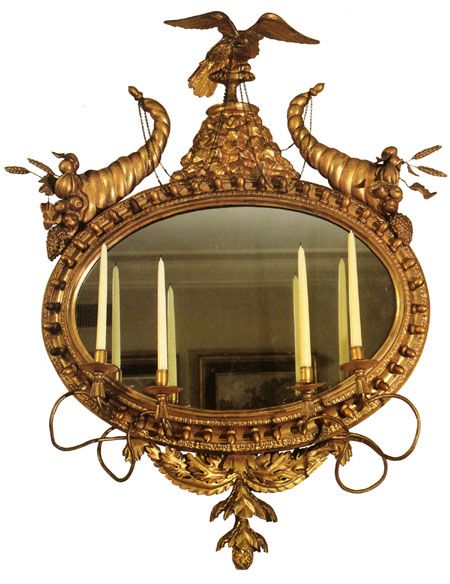 |
1810-1820 |
Unknown |
New York or Albany |
Wood and glass |
54 x 36" |
|
Purchase, 1977 |
Israel Sack, Inc., New York, NY 5/27/76 |
0 |
|
|
Gilded overmantle mirror, carved oval frame studded with acorns, the lower section with four candle arms and leaf carved and gilded pendant; the upper section with spread winged gilded eagle on mound houlding chain connected to flanking carved and gilded cornucopia. |
The flat glass and reverse molding is typical of the work being done in Albany during this period. |
Furniture |
79 |
| TRUE |
Looking Glass |
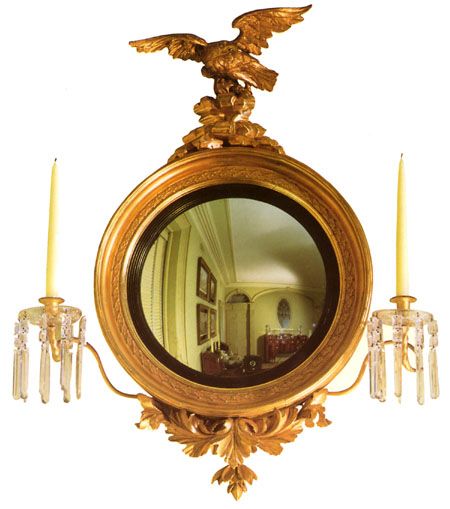 |
1800-10 |
Unknown |
American |
Gilded wood and glass |
36 x 32" |
|
Purchase, 1977 |
Purchase, George Subkoff, 835 Broadway, New York, NY 5/12/77 |
0 |
|
Nutting, Wallace. Furniture Treasury: Macmillan, 1961. Plates no. 3169 and 3171 show very similar girandoles made by C.R. Morson, New York. |
Girandole mirrors: One pair of gilded, convex mirrors with eagle surmounts and sconce arms. |
A sterling silver button hook, nail file, shoe horn, and broken handle, bearing the monogram "GCMc," were found with the broken glass pieces. These are not accessioned. |
Lighting |
77 |
| TRUE |
Chandelier |
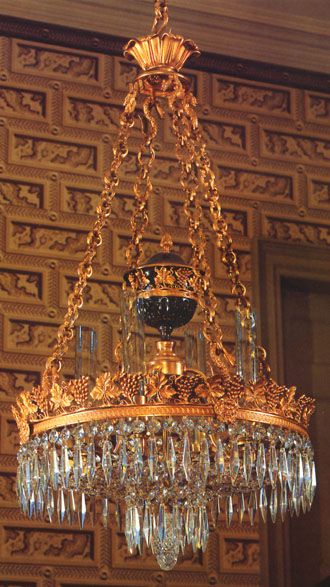 |
1805-15 |
Unknown |
Birmingham, England |
Patinated bronze and gilt |
42 x 22 1/2 " |
|
Purchase, 1977 |
|
0 |
Barbara Bielenberg, "Neo-Classical Lighting Devices at Boscobel," Rushlight 49, no. 4 (December 1983) |
|
Patent lamp: bronze and gilt Argand type chandelier in circular form, with urn shaped patinated bronze oil font above a gilded hoop supporting pendant crystal drops. Lamp is in the Regency style, Argand type and burned spermacetti (whale oil). The urn at the top is a font for the oil, and the glass dish under the font catches the drips. |
A painting "The Dinner Party" by Henry Sargent (MFA Boston), shows a similar lamp with a pully and counterweight system for raising and lowering the lamp. Ours is designed to be worked by a winch from the attic. |
Lighting |
89 |
| TRUE |
Dressing glass |
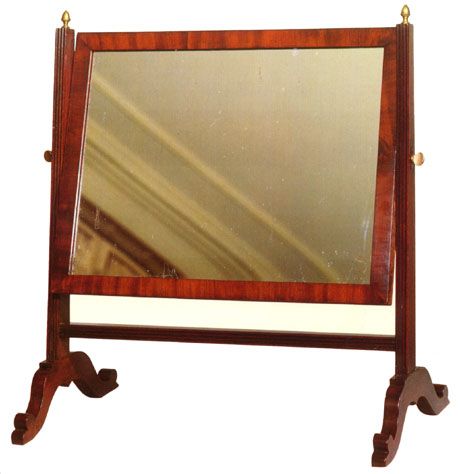 |
1818-19 |
Ambrose Crane |
New York City |
Mahogany, mahogany veneer, tulip poplar, European pine (or deal) |
21 x 19 x 10 3/4" |
"AMBROSE CRANE, / IMPORTER & MANUFACTURER / OF / PRINTS AND / /LOOKING-GLASSES, / NO. 135 / BROADWAY NEW YORK / NEAR THE CITY HOTEL" printed on a paper label attached to the backboard of the looking glass. |
Purchase, 1977 |
Purchased from Brewster Board, Washingtonville, New York 5/1/77 (by Berry Tracey, with Dick Button per Mr. Button 4/9/18) Boscobel exhibition June 17-September 10, 2012 Through the Cheval Glass: A Study of Form and Attribution |
0 |
Exhibition catalogue June 17- September 10, 2012 Through the Cheval Glass: A Study of Form and Attribution |
John Steen dressing glass illustrated in John Scherer, New York Furniture, no. 43, p. 45. |
The dressing mirror has a rectangular looking glass that pivots between two reeded uprights with brass finials. The uprights angle backward slightly and are joined by a stretcher and each attached to shaped feet. The looking glass frame appears to be tulip poplar and the backboards European pine or deal. NOTE: Crane's dates should be checked in NY directories. |
Ambrose Crane was engaged in sale of looking glasses in New York City from 1816-1819. (He is listed in the New York City Directory in 1818-19. A May 27 1816 advertisement in the New-York Evening Post listed him in business with a Stephen Spencer under the firm of Spencer, Crane & Co., at 126 Broadway. On September 24, 1817 Ambrose Crane advertised in the New -York Evening Post “that he has established a LOOKING GLASS STORE, No. 135 Broadway, (2 doors north of City Hotel) . . . . He is now opening an elegant assortment of Looking Glass Plates from the Royal Manufactory at paris, which he is framing in the most superb and fashionable style. LIKEWISE, Engravings/Dressing and Turmeux [sic] glasses/ Barometers, thermometers and Hydrometers/ Microscopes/ Painters, Glaziers and Varnishers Tools/ Brushes and Burnishers/ And a large assortment of German Looking Glass Plates, wholesale and retail.” a trumeau glass (proper spelling) is one of those rectangular looking glasses with a looking glass plate below and a painted decorative tablet above, something like nos. 76 and 80 in the Boscobel book |
Furniture |
60 |
| TRUE |
Hot-Water Dish |
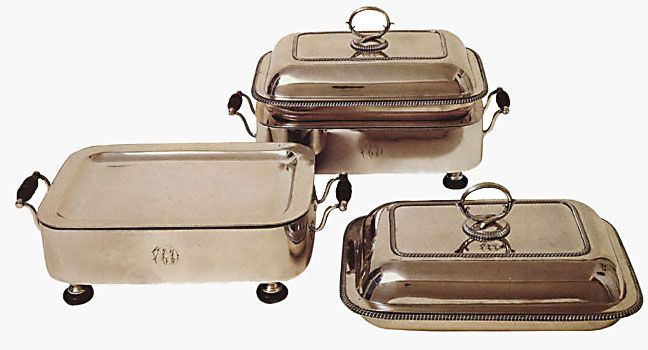 |
c. 1803 |
Unknown |
England, probably Sheffield |
Silver plate |
6 3/4 x 14 1/8 x 8" |
|
Purchase, 1961 |
Bought by States Morris Dyckman in England: see Walter Smith bill dated, November, 28, 1803. Boscobel purchased from John Conover, Ossining, NY 5/13/61 |
0 |
|
|
The silver-plate rectangular four-part hot-water dish stands on four button feet and has shaped fruitwood handles on each end. The hot-water warming dish is fitted with a conforming cover that supports a similarly shaped serving dish with a domed cover. The serving dish and cover have gadrooned borders; the cover has a loop handle. The base is monogrammed "ECD". |
Part of a set of four made for States Dyckman. See S 66.9, S 66.11, S 61.17. |
Silver |
107 |
| TRUE |
Hot-Water Dish |
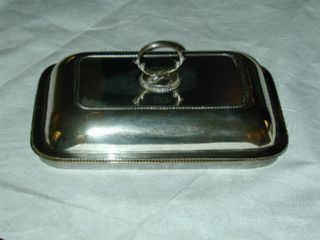 |
c. 1803 |
Unknown |
England, probably Sheffield |
Silver plate |
8 x 14 1/2 x 8" |
|
On Loan from Department of Parks, City of New York |
Purchased by States Morris Dyckman in England. See bill from Walter Smith dated 11/28/1803. On loan from Department of Parks, City of New York. |
0 |
|
|
EDIT: The silver-plate rectangular four-part hot-water dish stands on four button feet and has shaped fruitwood handles on each end. The hot-water warming dish is fitted with a conforming cover that supports a similarly shaped serving dish with a domed cover. The serving dish and cover have gadrooned borders; the cover has a loop handle. The base is monogrammed "ECD". George III Sheffield plate hot - water container with tray and dome top: This is an incomplete article, which is missing the food container. Present set consists of three pieces. |
Part of a set of four made for States Dyckman. See S 66.11, S 66.17, S 61.17. 10/2/2002 Unpacked from Curatorialstorage room. 2/26/2003 Hot-water container (S 66.9 a) currently being stored in the Dining Room. |
Silver |
107 |
| TRUE |
Hot-Water Dish |
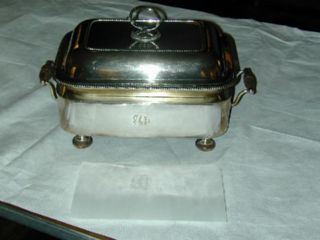 |
c. 1803 |
Unknown |
England, probably Sheffield |
Silver plate |
6 3/4 x 14 1/8 x 8" |
|
On Loan from Department of Parks, City of New York |
On loan from Department of Parks, City of New York. |
0 |
|
|
The silver-plate rectangular four-part hot-water dish stands on four button feet and has shaped fruitwood handles on each end. The hot-water warming dish is fitted with a conforming cover that supports a similarly shaped serving dish with a domed cover. The serving dish and cover have gadrooned borders; the cover has a loop handle. The base is monogrammed "ECD". |
Part of a set of four made for States Dyckman. See S 66.9, S 66.17, S 61.17. |
Silver |
107 |
| TRUE |
Dish Cover |
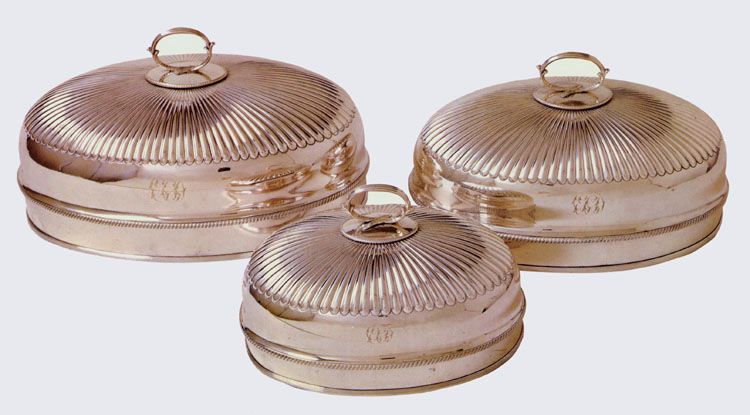 |
c. 1803 |
Unknown |
English |
Silver |
a: 7 3/4 x 13 x 10 1/8" b: 6 7/8 x 11 5/8 x 8 1/4" |
|
On Loan from Department of Parks, City of New York |
|
0 |
|
|
Two dome-shaped covers for platters: fluted dome ending with gadrooned edges, Sheffield. Monogrammed "ECD". |
Part of a set of four made for States Dyckman. See S 66.9, S 66.17 These constitute two of four domes purchased by States Dyckman from Walter Smith. The other two are in the museum. All are identical except for size. [PZ S 66.6 AND S61.11 DISCREPANCY] |
Silver |
104 |
| TRUE |
Dish Cover |
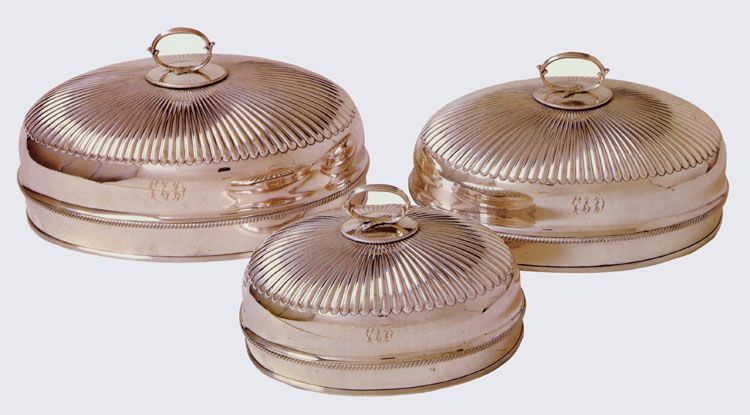 |
c. 1800 |
Unknown |
English |
Sheffield plate |
(a) 10 x 18 7/8 x 14" (b) 9 1/4 x 16 3/4 x 12 1/2" |
Monogrammed "ECD" |
On Loan from Department of Parks, City of New York |
See bill of sale from Walter Smith, London, dated 11/28/1803 On loan from Department of parks, City of New York |
0 |
|
|
Pair of George III Sheffield plate dish covers: Gadrooned and with reeded rims. Monogrammed "ECD". |
Two other dish covers exactly alike except for size are in the pantry. |
Silver |
104 |
| TRUE |
Vase |
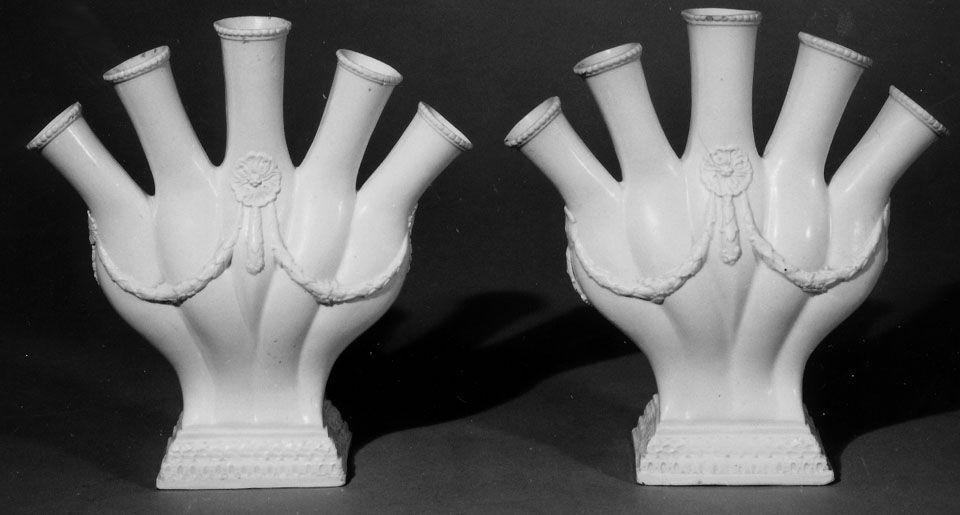 |
c. 1790 |
Unknown |
English |
Pottery |
9" H |
|
Purchase, 1961 |
Purchase, Elinor Merrell Antiques, 18 East 69th Street, New York, NY 5/23/61 |
0 |
|
|
Finger vases: two five spouted Leeds finger vases with relief molded swags. |
|
Ceramics |
0 |
| TRUE |
Jardiniere |
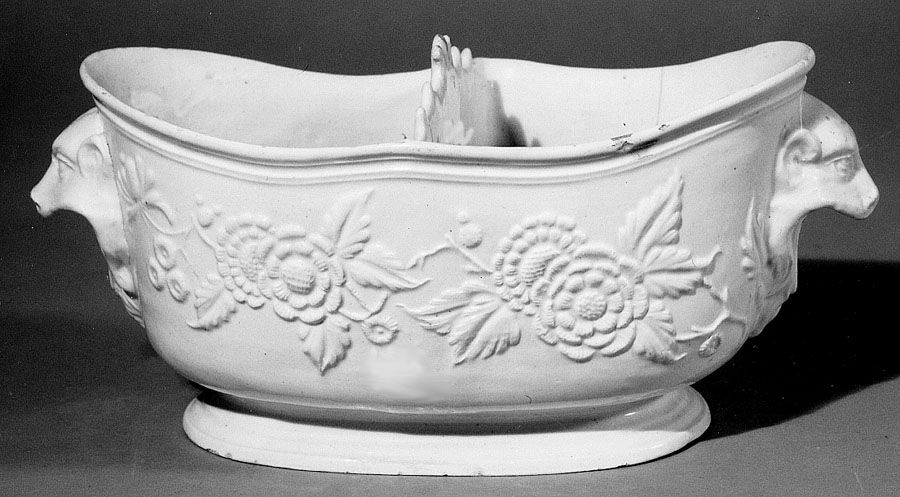 |
c. 1790 |
Unknown |
English |
Pottery |
11" L |
|
Purchase, 1961 |
Purchase, Elinor Merrell Antiques, 18 East 69th Street, New York, NY 5/23/61 |
0 |
|
|
Jardiniere: Creamware relief-molded, oval, divided in center, animal-head handles, raised floral clusters on sides. |
|
Ceramics |
0 |
| TRUE |
Bowl |
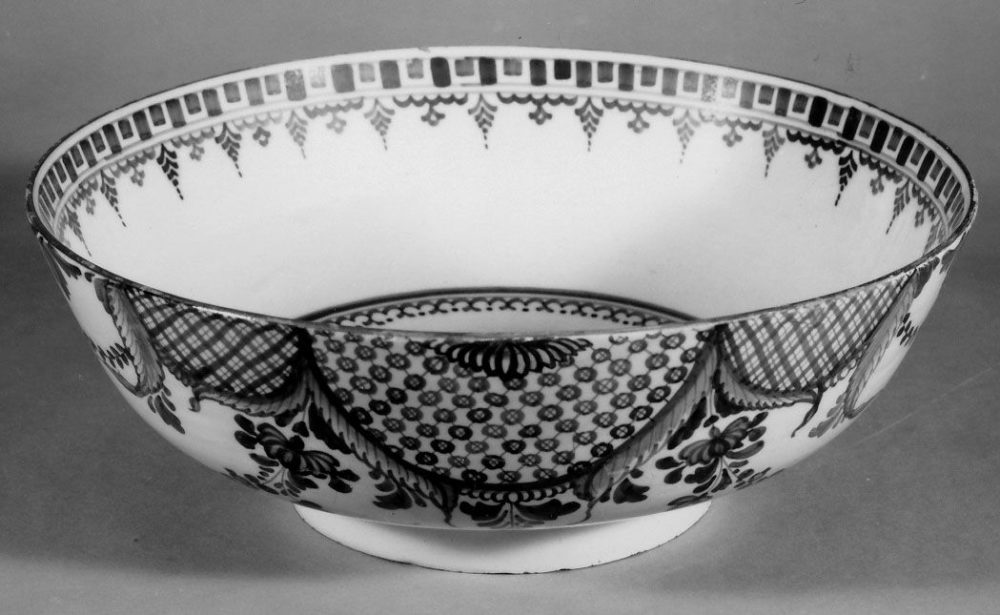 |
c. 1760 |
Unknown |
English |
Pottery |
12 x 4 1/2" |
|
Purchase, 1961 |
Purchase, William C. Kennedy, 1961 |
0 |
|
|
Large blue and white Lambeth delft bowl. Blue decoration on off white, blue swags and cross hatching. |
LOCATION UPDATE:C 61.15 BOWL MOVED TO DINING ROOM MARCH 2007, REPRODUCTION BOWL IS IN CURATORIAL STORAGE ROOM Boscobel has copied this bowl for sale in the museum shop. Complete Encyclopedia of Antiques (Connoisseur) describes delftware as earthenware coated with a glaze made opaque by the addition of tin ashes, named after Delft in Holland, which became an important center of manufacture in the 17th century. This bowl, made in England at Lambeth and characteristically spelled with a small "d" in comparison to the Dutch Delft spelled with a large"D". A reproduction of this bowl is currently in the Front Drawing room. 8/99 During inventory, was unable to locate (YB). UPDATE: C 61.15 is installed in Dining Room as on 4/2007. Reproduction stored in Brewer Room as of 8/2007. |
Ceramics |
0 |
| TRUE |
Dinner Service |
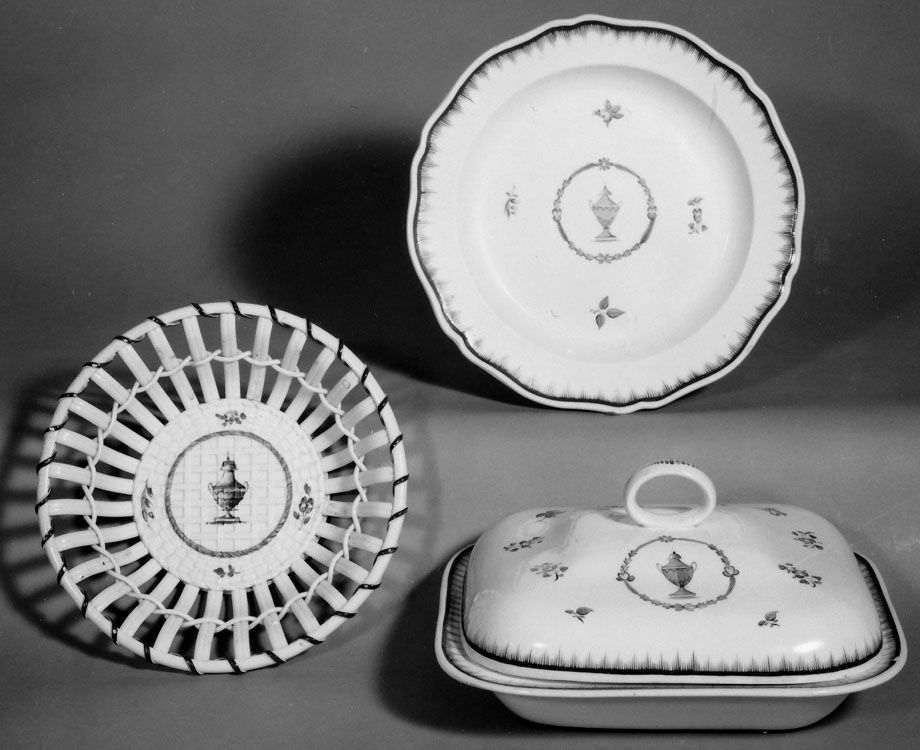 |
c. 1800 |
Unknown |
English |
Creamware |
See description |
The name Herculaneum is impressed on the bottom of some of the pieces. |
Purchase, 1961 |
Purchase, William C. Kennedy 9/18/61 |
0 |
For further research on this particular pottery, see these resources: Godden, Geoffrey A. Illustrated Encyclopedia of British Pottery and Porcelain. Crown, 1966. Plate.308-10. Smith, Alan. Illustrated Guide to Liverpool Herculaneum Pottery. Praeger, 1970. Godden, Geoffrey. British Porcelain. Barrie and Jenkins, 1974, pp.258-61, ill.307-10. Chaffers, William Reeves. Marks and Monograms on Pottery and Porcelain:Reeves, 1965. pp.31-32 |
|
"Herculaneum" dinner service comprising of 78 pieces. Painted with serpentine frilled rims in blue, centering a neo-classic urn and sprigs. Pieces include: (18) 10' plates, (26) 9 1/2" soups, (1) 11 1/2 " oval platter, (3) 13' oval platters, (2) 18 1/2" oval platters, (2) 17 1/2 " oval platters, (1) two handles plate on stand, (2) 15" round chargers, (2) 11 1/2" round chargers, (1) 6' sauce boat, (1) 8' stand, (1) cover, (2) 8' compote, (2) 11' compote without stand, (2) 8" gravy pitcher on stand, one chipped, (1) 8 1/2" basket dish, (1) 3' mustard pot with cover, (1) 10" rectangular covered vegetable dish, (1) oval platter with lace edge, (1) 10' oval shell dish, (4) 8" square dishes, (2) 17 1/2" round chargers. |
There are fragements of a handle and lid in the sliding glass cabinets in the curatorial storage room [kc] |
Ceramics |
0 |
| TRUE |
Inkwell |
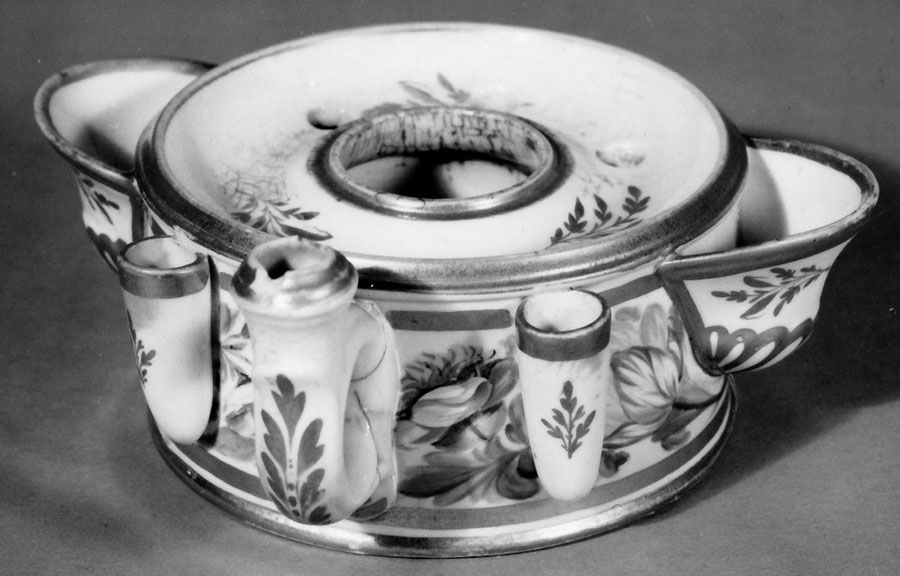 |
c. 1815 |
Spode |
English |
Porcelain |
6 1/2 x 2" |
|
Purchase, 1961 |
Purchase, Elinor Merrell Antiques, 18 East 69th Street, New York, NY 5/25/61 |
0 |
|
|
Inkwell: White and gold porcelain, decorated with many colored flowers and feathers. Two ear- like appendages for ink, three quill holders attached to the sides. |
|
Ceramics |
0 |
| TRUE |
Bowl |
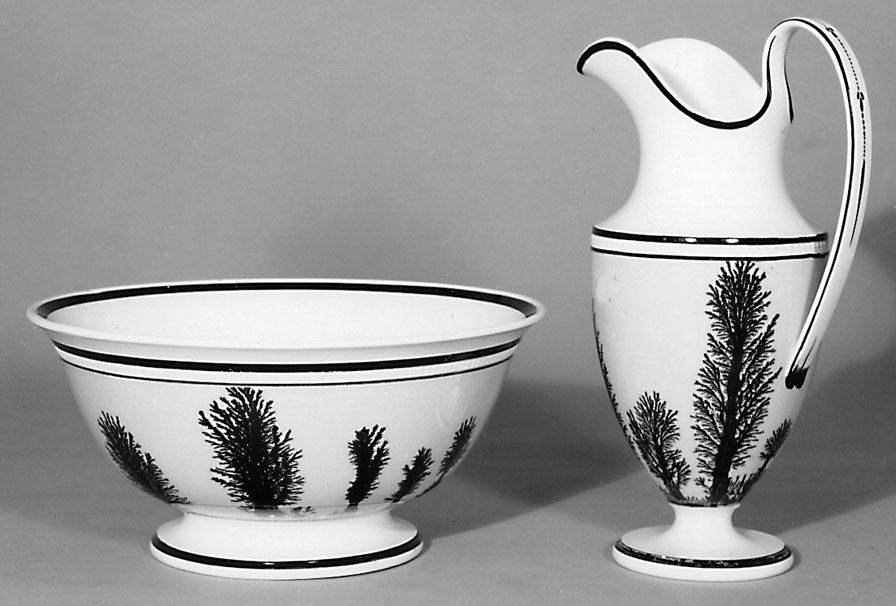 |
1800-30 |
Creil |
France |
glazed earthenware |
Pitcher: 10 x 5 1/2" Bowl: 6 x 10" |
stamped "CREIL" |
Purchase, 1961 |
Purchase, William C. Kennedy, 6/6/61 |
0 |
Connoisseur, Regency, Connoisseur Period Guide: Reynal & Co., 1958, p.99 Godden, Geoffrey A. Encyclopedia of British Pottery and Porcelain: Crown, 1966. Pl.342, 296. See also reprints in the ceramics file on Mocha ware and Creil. |
|
Pitcher and bowl: Helmut shaped ewer and wash bowl, decorated with sponged tree forms on a pale apricot ground. |
This type of pottery is often referred to as Mocha ware, which, according to the Complete Encyclopedia of Antiques, compiled by the connoisseur, Hawthorne '62, is described as follows: Ware decorated with colored bands into which tree, moss, or fern-like effects have been introduced by means of a diffusing medium, described by William Evans (1846) as "a saturated infusion of tobacco in stale urine and turpintine" made from about 1780-1914. Named for Mocha quartz. |
Ceramics |
0 |
| TRUE |
Vase |
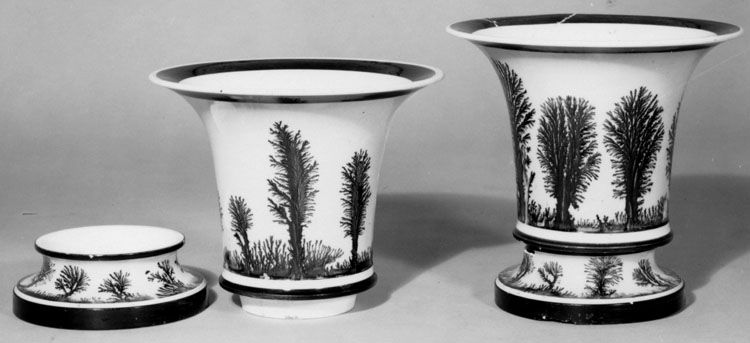 |
1800-30 |
Unknown |
French |
Pottery |
6 1/2" H |
|
Purchase, 1961 |
Purchase, William C. Kennedy, 6/6/61 |
0 |
|
Northeast Auctions November 17-18, 2012 lot 674 |
Cachepots: one pair on stands, mocha color, decorated with sponged tree forms. |
Referred to as Creil when appraised by Sotheby Parke Bernet in 1974. |
Ceramics |
0 |
| TRUE |
Dish |
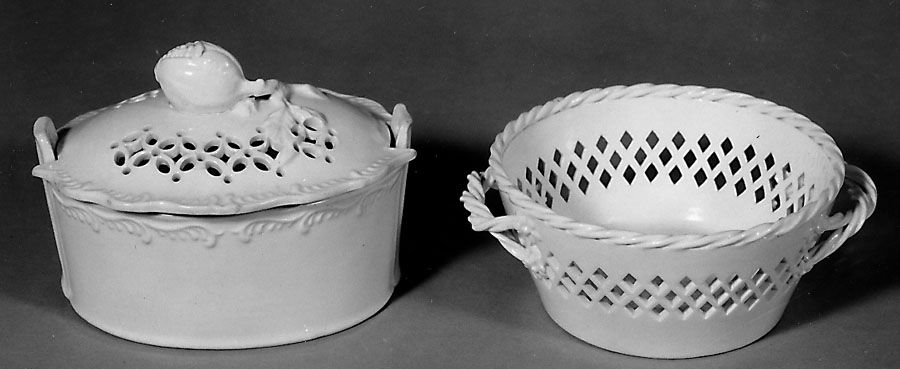 |
c. 1800 |
Unknown |
English |
Pottery |
|
|
Purchase, 1961 |
Purchase, William C. Kennedy 5/19/61 |
0 |
Godden, Geoffrey A. British Pottery and Porcelain: Crown: 1966, pp.192-200 ,ill. |
|
Leedsware pierced dishes: bon bon dish and covered box, oval in shape. |
S.P.B. in their 1977 appraisal referred to these articles as a Butter Tub and a Small Two Handled bowl. |
Ceramics |
0 |
| TRUE |
Wine Coaster |
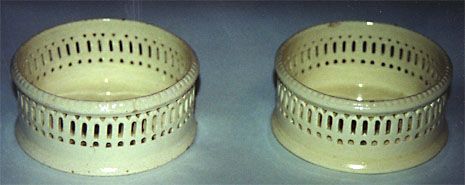 |
Late 18th century |
Unknown |
English |
Pottery |
3 1/4" diam. |
|
Gift of Mr. and Mrs. Fred D. Thompson, 1961 |
Possibly an original possession of the Dyckman's from Boscobel. John Conover, Ossining, NY Gift of Mr. and Mrs. Fred D. Thompson, 5/13/61 |
0 |
|
|
Creamware coasters: Set of four Leeds coasters with pierced trellis sides. |
STORED IN CUPBOARD LOCATED IN PANTRY. |
Ceramics |
0 |
| TRUE |
Child's rocking armchair |
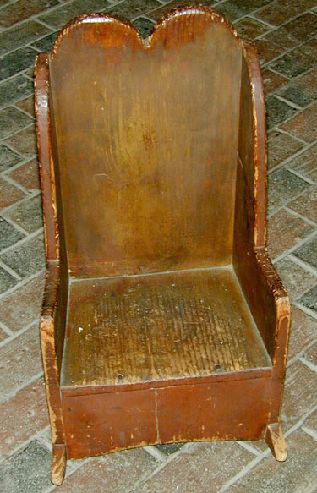 |
1800-1875 |
Unknown |
probably Mid Atlantic region |
white pine, Atlantic white cedar |
25 x 12 1/2" |
|
Purchase, 1961 |
Purchased from Mary Allis, Fairfield, CT 5/29/61 |
0 |
|
|
The child's rocking armchair is made of boards nailed together. The crest is double-arched. The sideboards enclose the sides form the tops of the arms, and extend to applied rockers. The chair is painted red. Roseheaded nails hold a piece of wood to the back of the front rail, which has split, but nails used elsewhere are flatheaded. |
|
Furniture |
0 |
| TRUE |
Table |
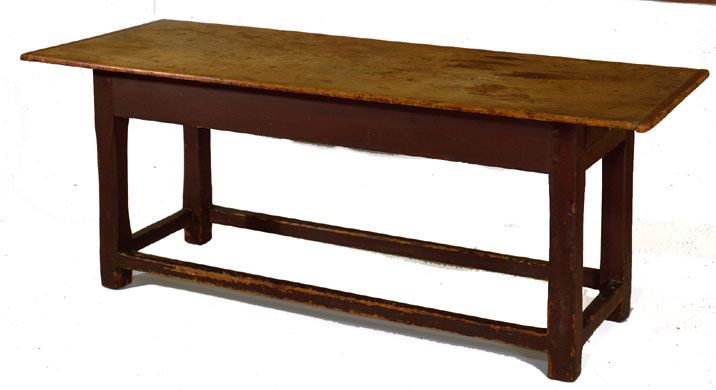 |
1800-1850 |
Unknown |
Northeastern United States |
White pine |
28 1/2 x 75 1/2" |
|
Purchase, 1961 |
Purchased from Mary Allis, Bronson Road, Greenfield Hills, Fairfield, CT 5/29/61 Early accession records record provenance as Pennsylvania but offer no supportive evidence. |
0 |
|
|
Rectangular table with a one-board pine top with battens at each end. Legs are square in section with light chamfers in the middle and joined by thick box stretchers. Side rails are tenoned into the legs and held with large pins. Drawers in each end are assembled with nails only; no dovetails. Present tear-drop pulls are replacements. Painted red. |
|
Furniture |
0 |
| TRUE |
Engraving |
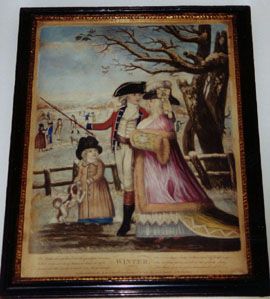 |
1786 |
Unknown |
English |
Paper |
14 x 10 1/4" |
|
Purchase, 1961 |
Published in 1786 by Robert Sayer, Map, chart, and bookseller, No. 53 Fleet Street, London. Purchase, William C. Kennedy 6/10/61 |
0 |
|
|
Four colored mezzotints in period frames: Spring, Summer, Autumn, Winter. |
Colored mezzotints contain the following: Spring [A 61.2 a]: Come then ye virgins and ye youths whose hearts have felt the raptures of refining love Oh come, and while the rosy footed May Steals blushing on, together let us tread The morning dews and gather in their prime fresh blooming flowers to grace thy braided hair and thy loved bosom that improves the sweets. Vide Thomasons, Seasons Summer [A61.2 b]: Now swarms the village o'er the jovial mead The rustic youth, brown with meridian toil Healthful and strong, full as the summer rose Blown by prevailing suns, the rudy maid Half naked, swelling on the sight, and all her kindled graces burning o'er her cheek. Autumn [A 61.2c]: Hence from the busy joy resounding field in cheerful error let us tread the maze of Autumn unconfined, and taste revived the breath of orchard big with bending fruit obedient to the breeze and beating ray From the deep-loaded bough a mellow shower Incessant melts away. Winter [A 61.2 d]: On blithsome frolics bent, the youthful swains While every work of man is laid at rest Fond o'er the river crowd and as they sweep on sounding skates a thousand different ways In circling poise, swift as the winds along The then gay lad is maddened all to joy. |
Prints/Drawings |
0 |
| TRUE |
Engraving |
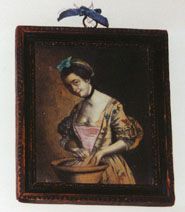 |
Late 18th century |
Unknown |
English |
Paper |
5 1/4 x 4 1/8" |
|
Purchase, 1961 |
Purchase, William C. Kennedy 6/12/61 |
0 |
|
|
Two mezzotints in period wooden frames: [a] The dairymaid churning, printed for John Bowles at no. 13 in Cornhill, colored with blue paint. [b] Lady's maid soaping linen, M--pinx published as the law directs, 2nd oct 1769, for Craighton Bowles Hunts churchyard, London, colored. |
|
Prints/Drawings |
0 |
| TRUE |
Basin Stand |
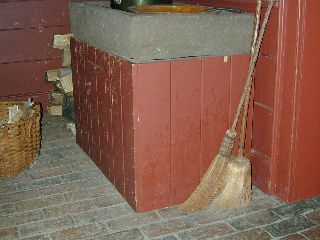 |
c. 1800 |
Unknown |
American |
Sandstone and wood |
36 x 22 x 24" |
|
Purchase, 1970 |
Purchased separately: Base: Mary Allis, Fairfield, CT 1961 Sink: I.M. Wiese 9/14/70 |
0 |
|
|
Sandstone sink and base: rectangular sink with red painted wooden base with cupboard door. |
|
Furniture |
0 |
| TRUE |
Pail stand |
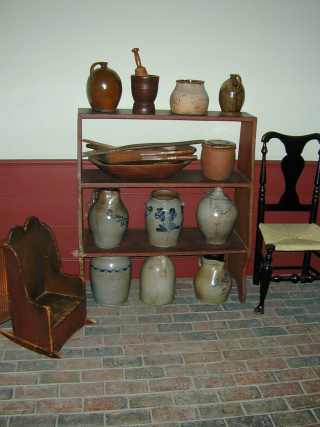 |
1775-1820 |
Unknown |
American |
Wood |
44 x 39 1/2" |
|
Purchase, 1961 |
Purchase, Mary Allis, Fairfield, CT 5/29/61 |
0 |
|
|
Three tiered pail stand: with three graduated shelves and shaped closed sides, referred to as an ale bench. |
|
Furniture |
0 |
| TRUE |
Engraving |
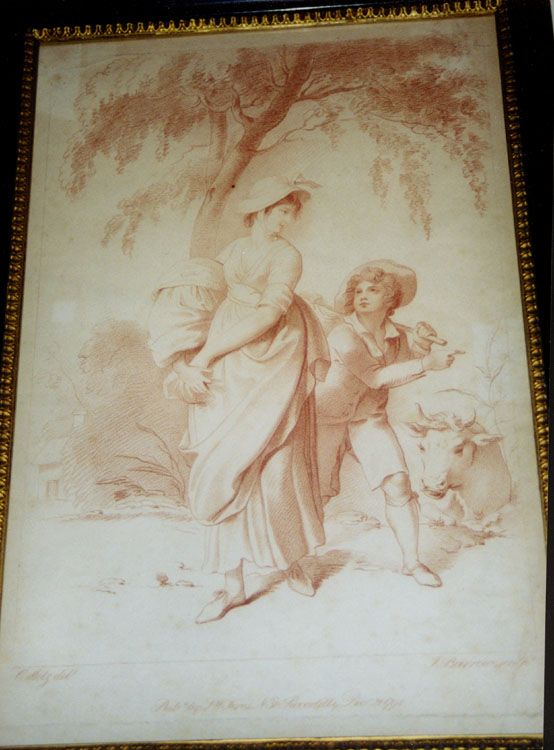 |
1798 |
J. Barrows |
English |
Paper |
16 x 10 1/2" |
|
Purchase, 1961 |
Published, London, by S.W. Fores (1761 - 1838), no. 5 Piccadilly, December 21, 1798. Purchase, William C. Kennedy 1961 |
0 |
|
|
The Harvesters: sanguine engraving, medium upright folio, framed. Engraved by J. Barrows after C. Metz.[Metz, Gonrad M., 1755-1827] |
|
Prints/Drawings |
0 |
| TRUE |
Pembroke table |
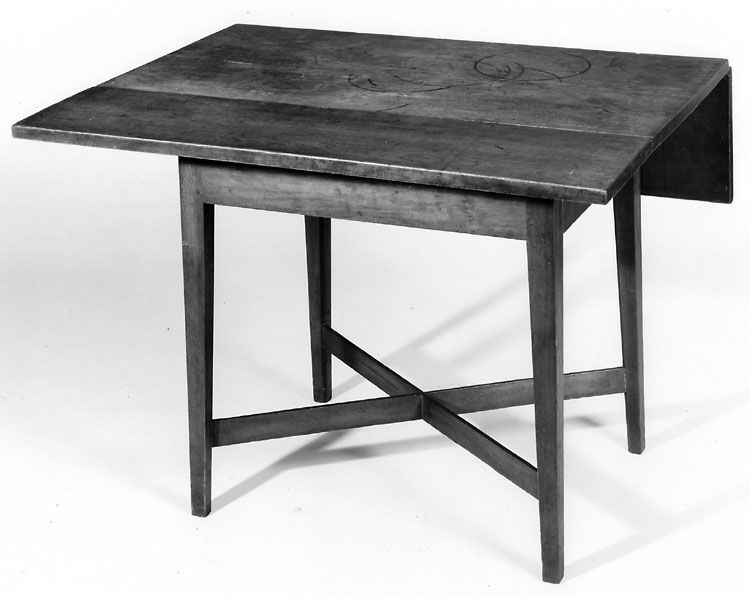 |
1810-1830 |
Unknown |
Probably Pennsylvania |
Cherry, Atlantic white cedar(?) |
27 1/2 x 36 3/4" - open: 36-7/8 x 36-7/8 |
|
Purchase, 1961 |
Purchased from William C. Kennedy, 6/10/61 |
0 |
|
|
The rectangular Pembroke table has a deep, undecorated frame and square-tapered legs joined by cross stretchers lapped in the center. The legs are tapered on the two inside surfaces only and are chamfered along the inside edge. The center fixed top is made of two boards glued edge to edge and reinforced from underneath by an original butterfly inlay that appears to be made of Atlantic white cedar. Rectangular cleats are dovetailed into the center boards (note small wood fills visible along the long side at the top of the legs opposite the swivel). These cleats fit inside the table frame and are affixed to each end rail by two wooden pins. The two rectangular leaves adjoin the fixed center leaf with rule joints and are each attached by two original iron hinges. The leaves are supported in an upward position by shaped cherry battens that swivel. |
|
Furniture |
0 |
| TRUE |
Candlestand |
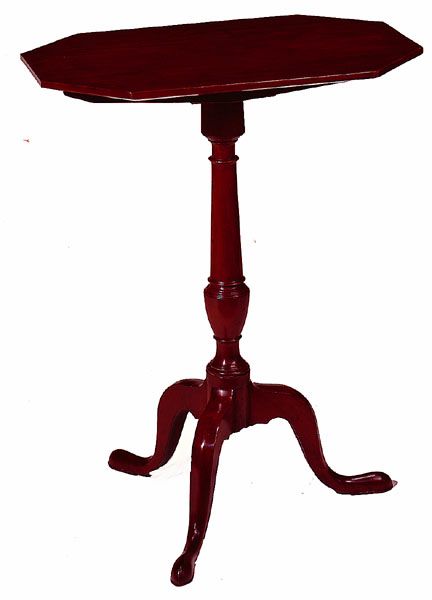 |
1800-1820 |
Unknown |
New England |
Mahogany |
28 1/2 x 22 x 15 (top) |
"This table belonged / to my great grand / mother on my / father's side. / Florence Way [May?] Green-- /" in ink on paper label affixed to the top of the column. |
Purchase, 1961 |
Purchased from Israel Sack Inc., New York, NY 5/1/61 |
0 |
|
|
The rectilinear top with canted corners is chamfered on the underside and hinged to a block attached to the top of a column and urn standard. Three cabriole legs ending in plain feet with carved pads on the bottom are dovetailed into the cylindrical bottom of the standard. The column has a ring at the top, and the urn has a reel below. All parts are made of mahogany. |
|
Furniture |
0 |
| TRUE |
Fruit Cooler |
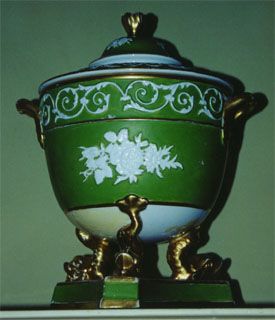 |
1815-20 |
Unknown |
English |
Porcelain |
11 1/2" H |
|
Purchase, 1961 |
Purchase, Parke-Bernet, New York, NY 5/12/61 |
0 |
Chaffers, William. Marks and Monograms on Pottery and Porcelain: William Reeves '66, p.76-78. |
|
Fruit coolers: One pair, green, white and gilt fruit coolers. Two handled urns, relief molded with foliations, on three gold dolphin feet. |
These fruit coolers have been authenticated by Mr. Geoffrey Godden. See letter of 9/8/71.(letter not in file) Maker is attributed to John and William Ridgeway of Cauldon Place. |
Ceramics |
0 |
| TRUE |
Set of four candlesticks |
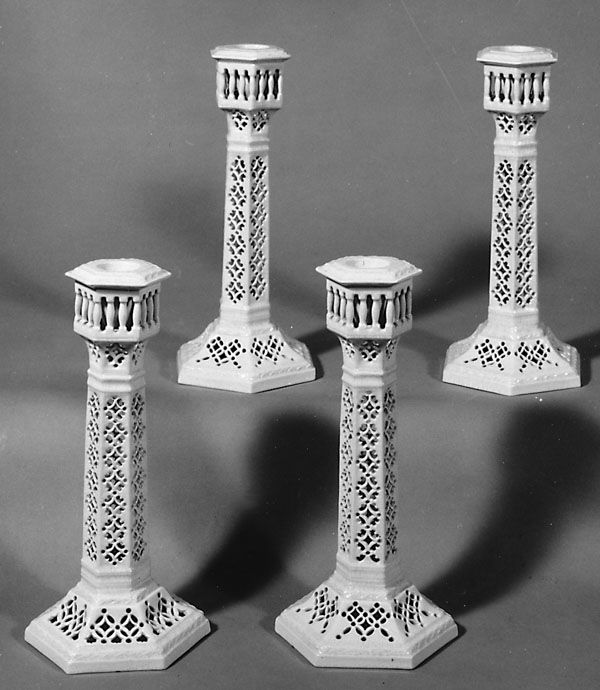 |
1888-1916 |
Leeds |
Leeds, England |
Creamware |
10 3/4 x 7" |
marked "LEEDS POTTERY" inside base |
Purchase, 1961 |
Purchased from William C. Kennedy 6/11/61 |
0 |
See Godden, Geoffrey A., British Pottery and Porcelain (Crown 1966), p.192. |
|
Set of four hexagonal creamware candlesticks with openwork trellis design. |
|
Lighting |
0 |
| TRUE |
Compote or incense burner |
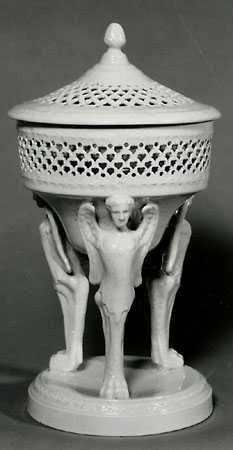 |
1890-1915 |
Probably Leeds Pottery |
Leeds, England |
Creamware |
13" H |
|
Purchase, 1961 |
Purchased from William C. Kennedy 6/11/61 |
0 |
See Godden, Geoffrey A., British Pottery and Porcelain (Crown 1966), p.192. |
|
Lidded compote with delicate openwork on the cylindrical body and on the lid below the finial. The body is raised on three caryatid supports that stand on a round base. Unmarked, but creamware body and glaze appears to be the same as C 61.19. |
According to file, this compote is attributed to Leeds. |
Ceramics |
0 |
| TRUE |
Dish |
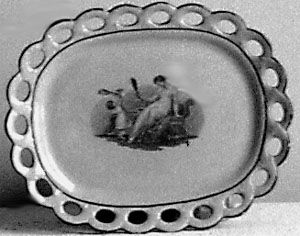 |
1800-30 |
Unknown |
French |
Pottery, soft paste |
8 x 6 1/2" |
|
Purchase, 1961 |
Purchase, William C. Kennedy 6/6/61 |
0 |
|
|
Oval dish: Tan, transfer printed dish with pierced scalloped border, transfer printed in black. Subject is a woman and child holding badminton raquets. Referred to as "Creil' in Sotheby Parke-Bernet appraisal. |
As of 2/1/2018 this is located in Mrs. Dyckman's Room in a drawer of F 76.24 [kc] |
Ceramics |
0 |
| TRUE |
Dinner Service |
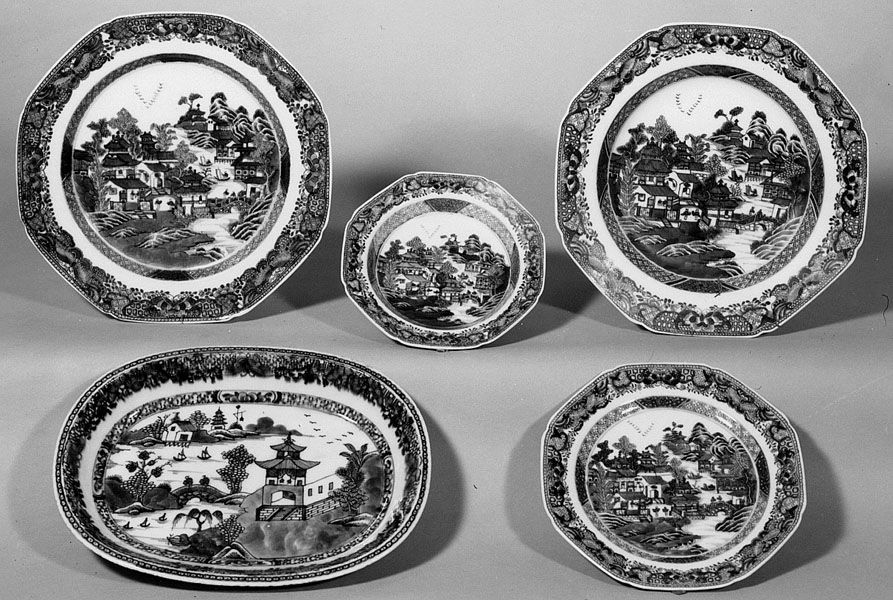 |
1800-1840 |
Unknown |
China |
Porcelain |
See file |
|
Purchase, 1961 |
Purchase, William C. Kennedy 6/10/61 |
0 |
New Haven Colony Historical Society, an exhibition of China Trade Porcelain; p.49 |
|
Blue and white dinner service: Nanking, China trade dinner service with Fitzhugh border. Pattern shows variations of typical Nanking pattern with Fitzhugh butterfly border, showing the life cycle of the silk worm. Cups are scalloped and highlighted with gold edges. |
The Fitzhugh border referred to in this case is considered the most unusual. It is made up of varied diapered sections seperated by butterflies and stylized flowers, with Greek frets and leafed branchlets, and an inner border of hexogonal forms. The border referred to in the other card is more commonly seen in Nanking ware. The exhibition of China Trade Porcelain Catologue for March, 1968 has a definition for Nanking as follows: "Underglazed blue and white, varying greatly in the quality of the porcelain and in the design of the borders and panels. It generally appears thinner, less rough and more carefully decorated than Canton. Gold over-glaze is sometimes used as highlighting. Two central and distinct designs are observed. [1] Island design, 3 islands, 3 boats and birds flying in formation. A houseboat approaching an island and a man on the island engaged in fishing. [2] Bridge design, with single span bridge, a solitary man on the bridge, and a small boat carrying one man in addition to several islands, trees and buildings. There are,however, several variant designs which fall in neither category,especially on bowls, teapots and the like where and irregular surface had to be decorated. The two stripe border has an outer, dark blue close mesh network with a spot in the corner of each mesh. The inner stripe consists of a close row of spear-like posts alternating with round topped posts. This "Nanking Border" is common on Fitzhugh as on Nanking porcelain. |
Ceramics |
0 |
| TRUE |
Set of six portrait engravings |
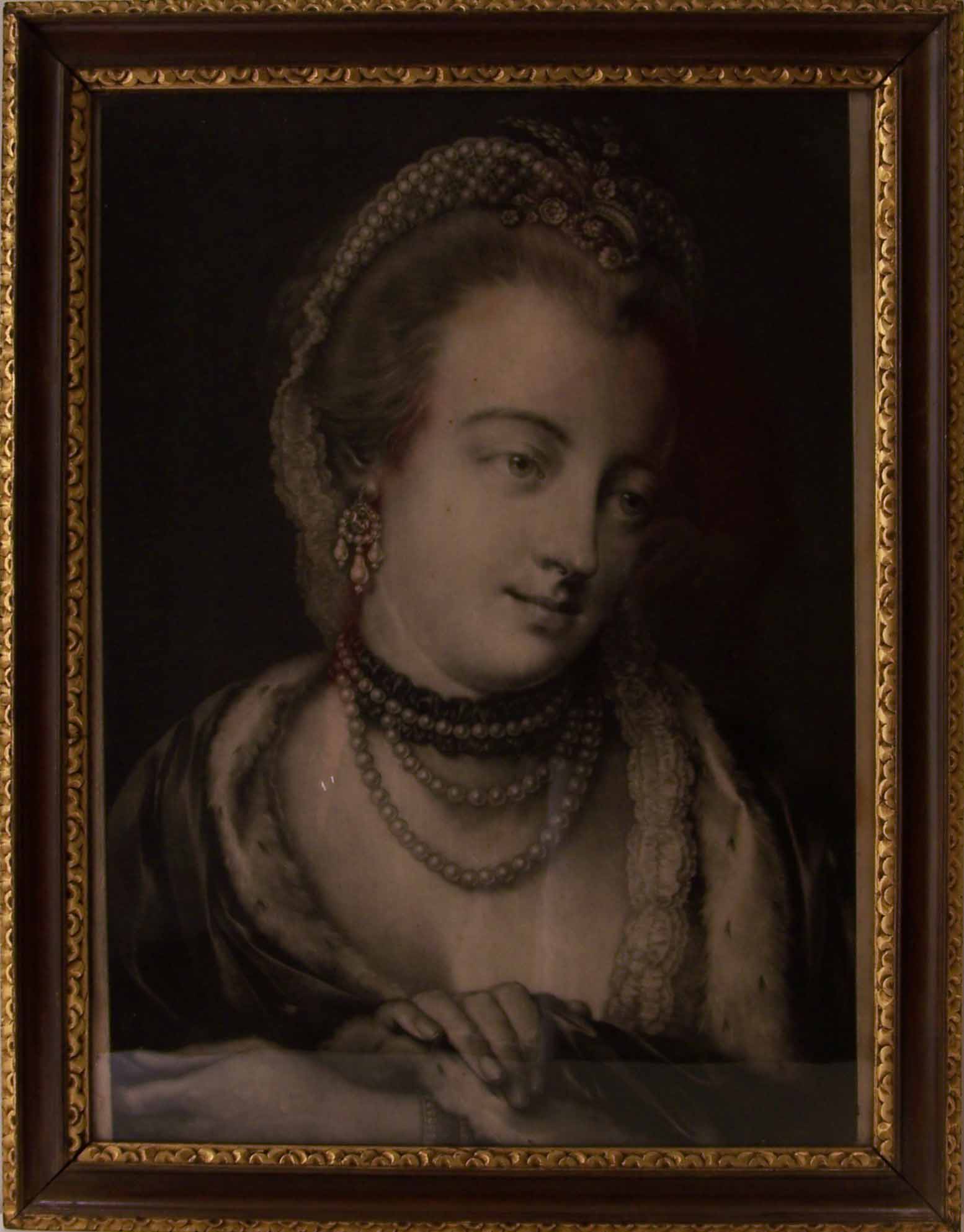 |
1760 |
Thomas Frye |
London, England |
Mezzotint on paper |
18-7/8 x 13-7/8 (engraving), 22-3/4 x 17-3/4 (frame) |
|
Purchase, June 8,1961 |
Purchase, William C. Kennedy 6/12/61 |
0 |
|
|
Set of six mezzotint engravings by Thomas Frye (c. 1710-1762) showing five gentlemen and Queen Charlotte. ".F." appears within the engraved field along the bottom of each image. Published Hatton Garden in 1760. The frames appear to be of eighteenth century origin but have been completely refinished. The glass in each frame appears to be old. |
|
Prints/Drawings |
0 |
| TRUE |
Engraving |
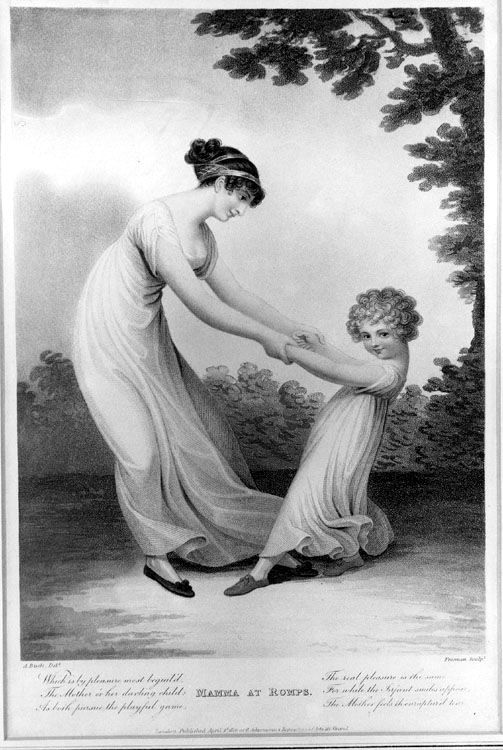 |
1809-10 |
Unknown |
English |
Paper |
9 1/2 x 11 1/4" |
|
Purchase, 1961 |
|
0 |
|
|
Six mezzotints: four in sepia, two colored. Depicting the stages of a child's life. Four are framed vertically, two horizontally. Each engraving has a 5-8 line poem relating to the picture at bottom flanking title. |
Based on the drawing of the English artist, Adam Buck (1759-1833) [added 9/2/2008 by JP] |
Prints/Drawings |
0 |
| TRUE |
Painting |
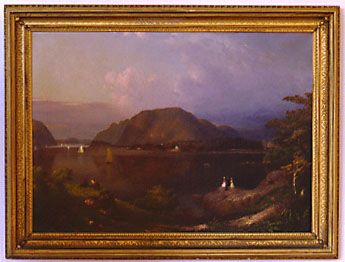 |
c. 1855 |
Victor DeGrailly |
New York |
Oil on canvas |
26 x 36" |
|
Purchase, 1967 (on loan to the Putnam History Museum since 1967) |
Purchased from John Vesey, New York 12/4/67 Loaned to The Putnam County Historical Society, 12/13/67 as per loan receipt in file. |
0 |
|
|
View of Cold Spring from West Point, painted by Victor DeGrailly (active 1840-1870). |
DeGrailly was a Frenchman who painted in the United States from 1840 to 1870, frequently copying Bartlett paintings. |
Paintings |
0 |
| TRUE |
Pembroke table |
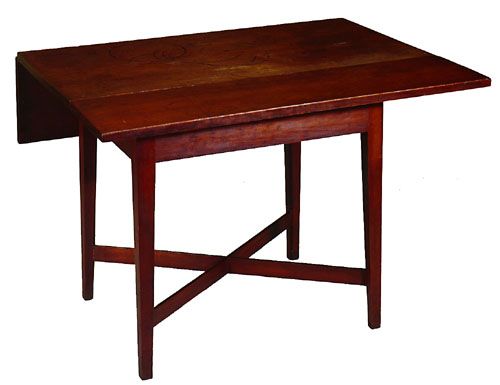 |
1810-1830 |
Unknown |
Mid-Atlantic region |
Cherry, oak |
27-7/8 x 33-1/4 x 20-1/4 (37-1/2 open) |
|
Purchase, 1962 |
Purchased from William C. Kennedy 7/27/62 |
0 |
|
|
The rectangular table has a two-board fixed top and two hinged rectangular leaves that are supported by swivels mounted into the tops of the side rails. The side rails of the table frame are oak. The table stands on four square tapered legs joined by cross stretchers lapped in the center. The legs are tapered on the two inside surfaces only. |
|
Furniture |
0 |
| TRUE |
Dinner Service |
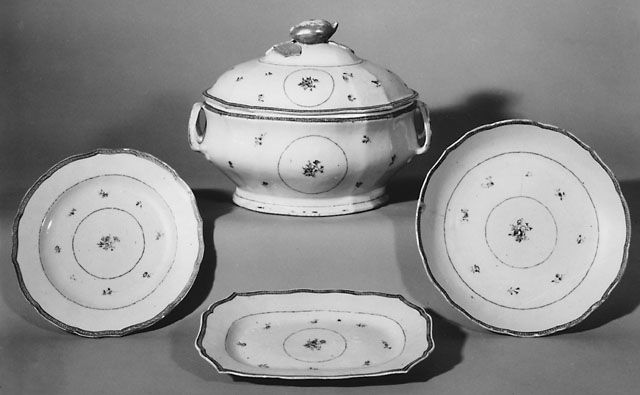 |
1800-1825 |
Unknown |
Chinese |
Porcelain |
See notes |
|
Gift of Mrs. Lila Acheson Wallace, 1964 |
Gift of Mrs. Lila Acheson Wallace 1964 |
0 |
|
|
Chinese Export Dinner Service: tiny aubergine sprigs on pale grey ground, rim bandings, gold trim, consisting of forty pieces. |
LOCATION UPDATE: ONE PLATE AND ONE SMALL PLATE MOVED TO MRS. DYCKMAN'S BEDROOM. BROKEN PLATE DEACESSIONED IN 2006 TO NORTHEAST AUCTION. Dinner service consists of: 2 serving dishes, 1 soup tureen, 12 soups, 9 plates, 4 platters, 1 strainer, 7 sauce dishes, 3 smaller plates, 1 gravy boat, 1 broken piece which is in storage. This service is stored in cabinet (F 61.13). |
Ceramics |
0 |
| TRUE |
Child tender or restrainer |
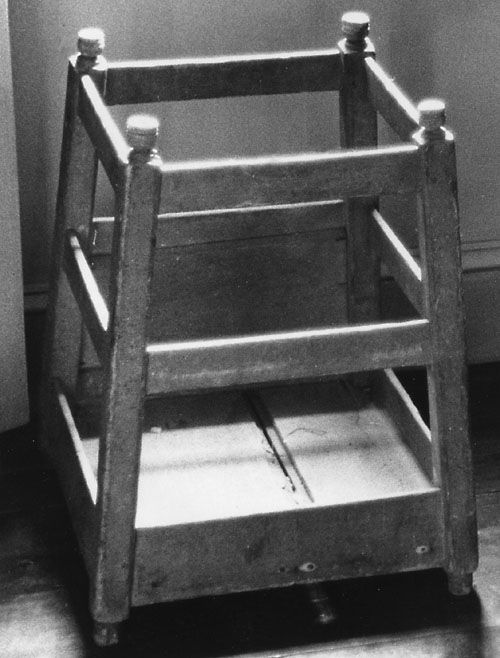 |
1775-1825 |
Unknown |
Northeast United States |
Pine |
21 3/4 x 17 1/4 x 17-1/4 |
|
Purchase, 1970 |
Purchase, William C. Kennedy, 1970. |
0 |
|
|
Square child's tender or restrainer made of four uprights canted inward with turned finials and feet. The sides a made of three slats tenoned into the uprights, the top-most of which is pinned. The bottom is made of two boards, joined with a tongue and groove. The object is painted gray. |
|
Furniture |
0 |
| TRUE |
Urns |
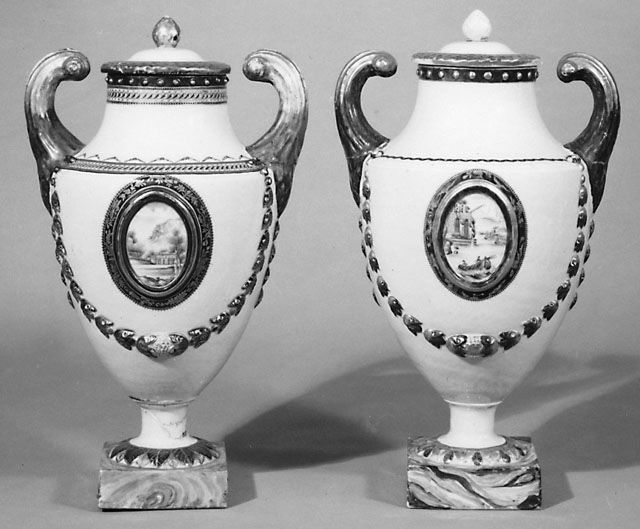 |
c. 1790 |
Unknown |
Chinese |
Porcelain |
17 1/4" H |
|
Purchase, 1976 |
Purchase, Art Exchange Inc, New York, NY 12/8/76 |
0 |
|
Berry Tracy Collection, Sold Feb. 1, 1985 for $7,425 Sotheby's Auction |
Pair of pistol-handled Chinese export urns: with covers, sepia landscape reserves. |
This is not a matched pair. Different prices were paid for each. |
Ceramics |
0 |
| TRUE |
Engraving |
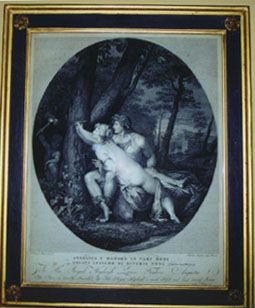 |
1795 |
Raphael Morghen |
Italy |
Laid paper [CHECK THIS] |
14 3/16 x 18 5/16" |
Dated Rome 1795 and inscribed "To His Royal Highness Prince Frederic Augustus this plate is humbly inserted by his Royal Highness' much obliged and devoted servant, Alex Day." |
Purchase, 1976 |
Purchase, Sotheby Parke Bernet, New York, NY 11/3/76 |
0 |
|
http://www.artoftheprint.com/artistpages/morghen_raphael_angelicaandmedoro.htm |
Engraving by Morghen, Raphael (Florence, 1758 - 1833), after Matteini, Theodorus. Angelica E Medoro in Varj Modi Legati Imsiem E Di Diversi Nodi (Orlan fur Cant. XIX Stan. 36) In black and gold Greek Revival frame with rosettes. |
|
Prints/Drawings |
0 |
| TRUE |
Basin Stand |
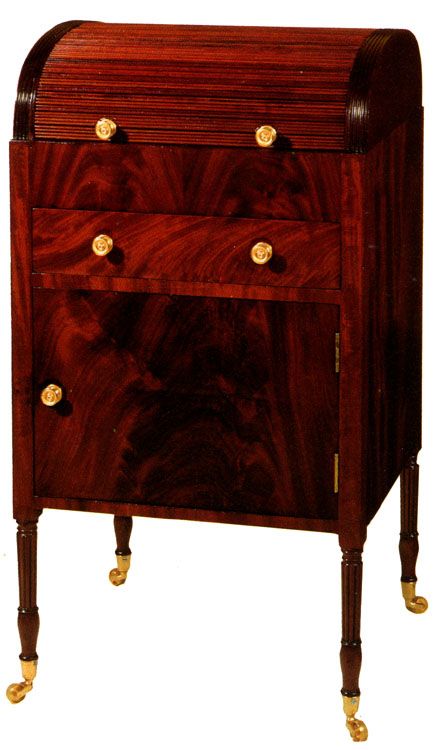 |
1805-20 |
unknown |
New York City |
Mahogany, mahogany veneer, tulip poplar, white pine |
36 1/4 x 18 7/8 x 17 7/8" |
|
Purchase, 1976 |
Purchased from Joe Kindig, York, PA 10/1/76 |
0 |
|
This basin stand is very similar to F 76.42. |
The veneered basin stand has a cylindrical tambour top, covering wash stand board, with pierced holes (including square hole in back left) for basin receptacles. The single drawer below has book-matched veneer panels. The cupboard door opens to storage. The basin stands on reeded legs terminating in brass casters. The front face of the legs have rectangular inset panels. Sides (below the arched section), front rails, drawer front, and door are veneered. |
This basin stand is illustrated as catalogue number 59 in Tracy, "Federal Furniture," but the caption describes basin stand F 76.42. |
Furniture |
59 |
| TRUE |
Vase |
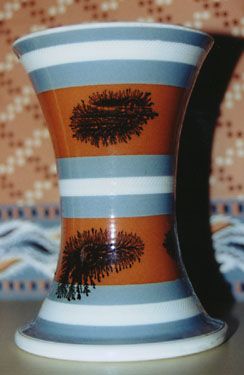 |
1800-20 |
Unknown |
English |
Pottery |
3 1/4" H |
|
Purchase, 1977 |
Purchase, Ronald DeSilva, Garrison, NY 1/18/77 |
0 |
|
|
Spill vases: hour glass shape in banded creamware in rust, blue and white with black. |
This pottery is referred to as Mocha Ware. It is described as follows by Dr. Edwin A. Barber: A variety of white crockery, which is crudely decorated with sea weed or tree-like designs in black, brown, green, and other colors, usually on a tinted zone which is outlined with lines or narrow bands of darker color, while occasionally at top or bottom of a piece will be found in another tone of a different tint. Reprints of articles about Mocha Ware are on file at Boscobel. |
Ceramics |
0 |
| TRUE |
Urn, covered |
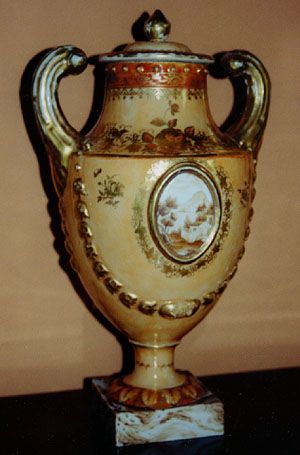 |
1795 |
Unknown |
China for Export |
Porcelain |
15" H |
|
Purchase, 1977 |
Purchase, Bernard & S. Dean Levy, New York, NY 3/31/77 |
0 |
|
Metropolitan Museum of Art 54.87.34 a,b and 54.87.35a, b |
Pistol-handled urns: one pair with covers, Chinese export in peach color with decoration in sepia and gold, with bellflowers and scenes in ovals on marbelized bases. |
Exhibited: Winterthur Museum [WHEN?] |
Ceramics |
0 |
| TRUE |
Bottle and Basin |
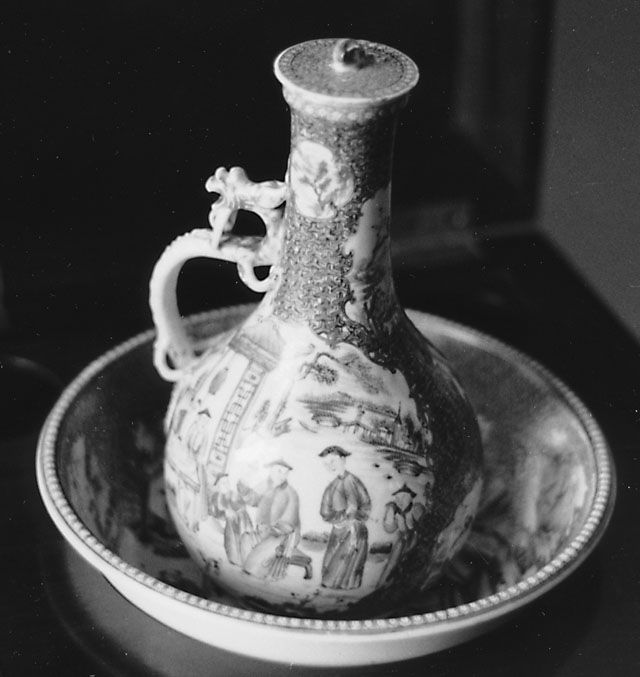 |
Late 18th century |
Unknown |
China for Export |
Porcelain |
Basin: 10" diam., Bottle: 11" H. |
|
Purchase, 1977 |
Purchase, Cora Ginsberg, Inc. New York, NY 6/6/77 |
0 |
Antiques Magazine. October '67 pp.530-535, The Rose Medallion and Mandarin Patterns in China Trade Porcelain. |
|
Chinese export basin and bottle: fine quality painting of Chinese figures in a semi-western landscape. |
|
Ceramics |
0 |
| TRUE |
Engraving |
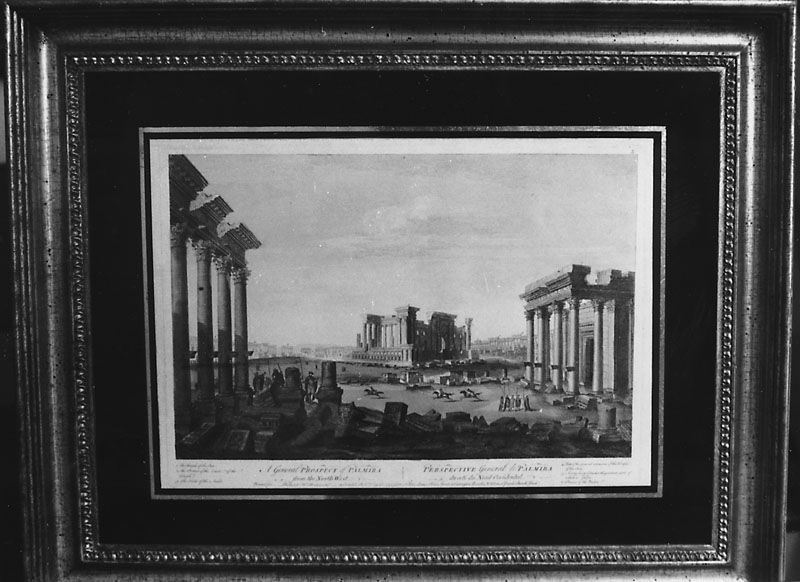 |
c. 1800 |
Unknown |
English |
Paper |
11 1/4 x 15 1/2" |
|
Purchase, 1977 |
Purchase, The Old Print Shop, Inc., 150 Lexington, New York, NY 1/19/77 |
0 |
|
|
General Prospect of Palmira from the North West: Printed for Robert Wilkinson, & Co. In black and gold period frame. |
|
Prints/Drawings |
0 |
| TRUE |
Tea Service |
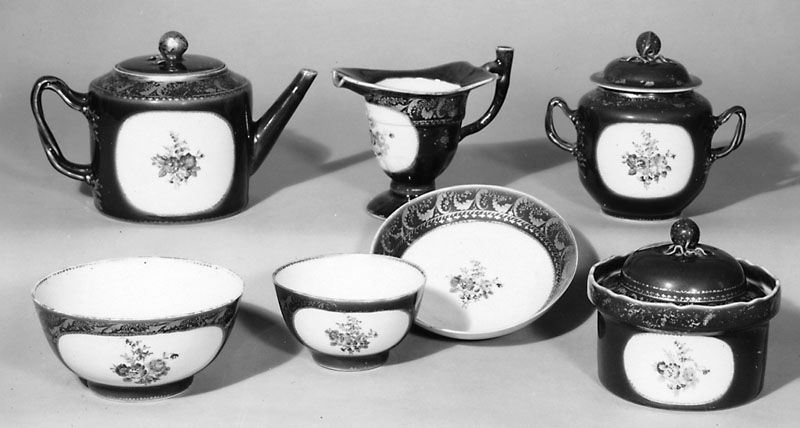 |
c. 1815 |
Unknown |
Chinese |
Porcelain |
|
|
Purchase, 1977 |
Purchase, Ronald De Silva, Garrison, NY 6/9/77 |
0 |
|
|
Chinese export tea service: deep blue with multi colored flowers in oval reserves, gold decoration. The invoice refers to this set as "Sevres pattern". Tea set consists of the following: 2 tea pots with covers, 1 sugar bowl with cover, 1 tea caddy with cover, 1 creamer, helmut shaped, 1 waste bowl, 12 handleless cups, and 12 saucers. |
|
Ceramics |
0 |
| TRUE |
Pair of Jardinieres |
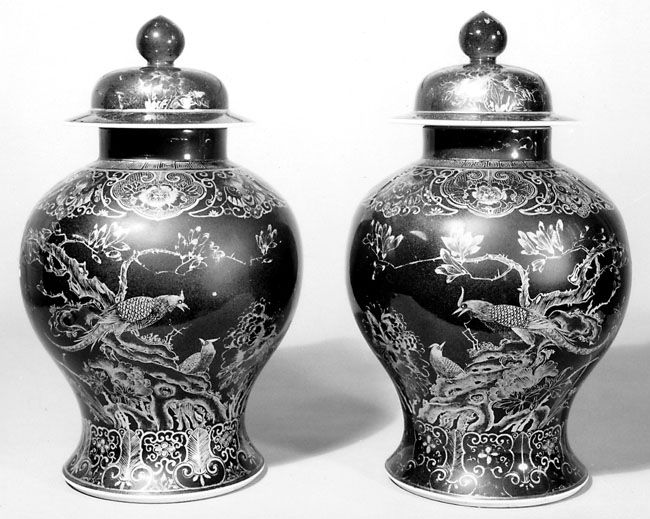 |
c. 1800 |
Unknown |
Chinese |
Porcelain |
16 1/2" H |
|
Purchase, 1977 |
Purchase, Bernard and S. Dean Levy, New York, NY 3/31/77 |
0 |
|
|
Pair of Chinese blue and gold porcelain covered baluster jars: each baluster-shaped and having a knop finial decorated in gold with lappet collors and a frieze of exotic birds perched on flowering trees. |
|
Ceramics |
0 |
| TRUE |
Set of four engravings |
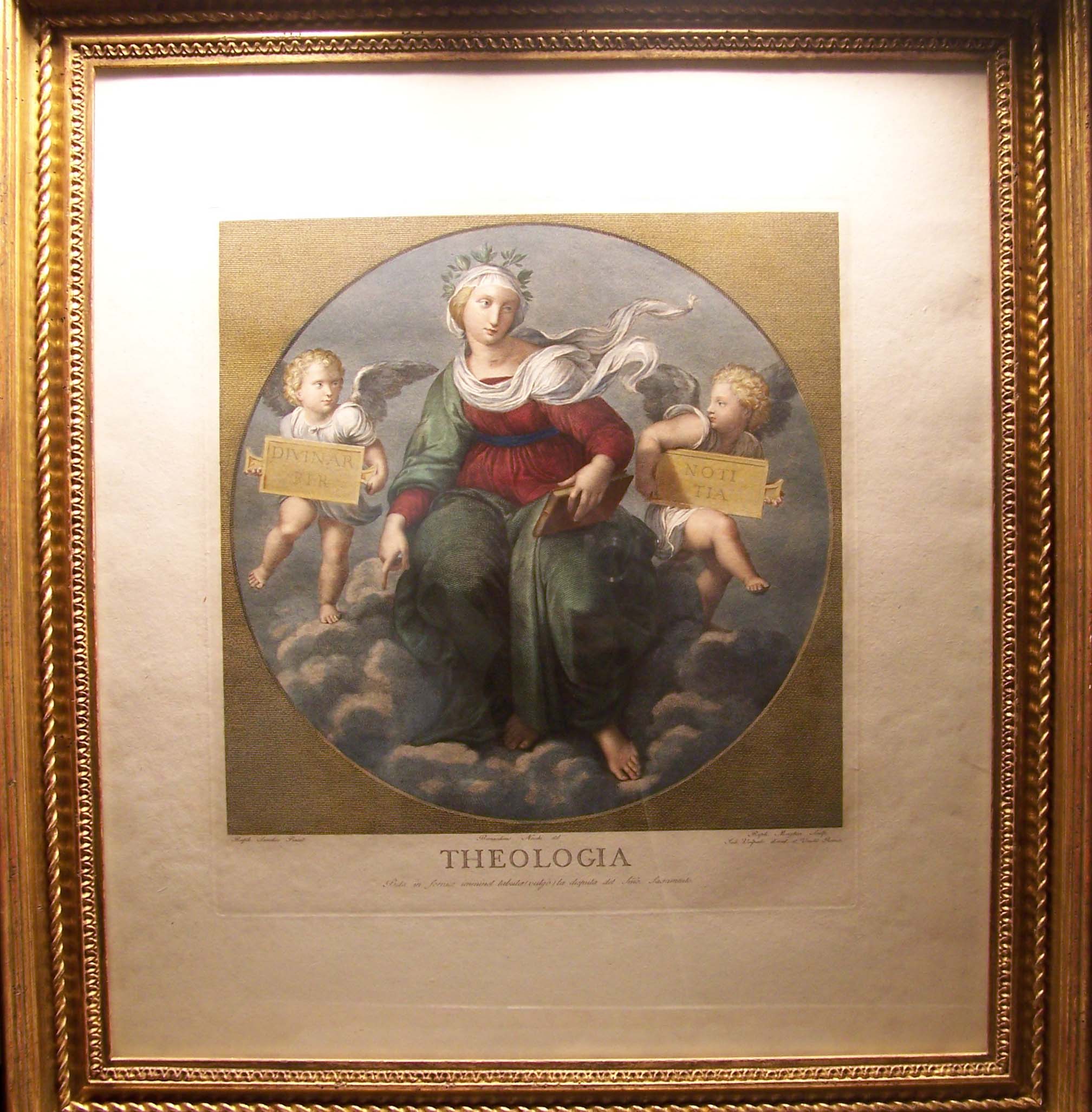 |
1790-1810 |
Raphael Morghen |
Rome, Italy |
Colored engraving on wove paper |
27-3/8 x 24-7/8 (frame), 23 x 20-1/2 (sight), 16-5/8 x 15-1/8 (plate) |
|
Purchase, 1977 |
Purchased from The Old Print Shop, New York, NY 1/19/77 |
0 |
Raphael Morghen's engraved works: being a descriptive catalogue of all the engravings of this master, New York and London, Putnam and Son, 1885 [Available on google books] http://books.google.com/books?id=iEMYAAAAYAAJ&printsec=frontcover&dq=Raphael+Morghen's+Engraved+Works;+Being+a+Descriptive+Catalogue+of+All+the+Engravings+of+This+Master,+the+Inscriptions+Given+at+Full+Length,+and+the+Variations+of+the+States+Precisely+Set+Forth&hl=en&sa=X&ei=DLMhT8SJOsHd0QHA2bWDCQ&ved=0CDoQ6AEwAA#v=onepage&q=Poesis&f=false |
|
Set of four engravings by Raphael Morghen (1758-1833) showing the allegorical frescoes painted by Raphael commissioned in 1509 and executed in the Vatican. "a": "THEOLOGIA / Picta in fornice imminet tabulae (vulgo) la disputa del Smo. Sacramento" [Painted in the vault above the picture commonly known as the Disputation over the Sacrament] A draped female figure, crowned with flowers, seated on clouds, holding a book on her knee with her left hand, points with the right downwards. On each side a cupid holds a tablet; on that on the left side is DIVINAR RER, on the right NOT ITIA. A circle in a shaded rectangle. "b": "POESIS / Picta in fornice imminet Parnasso" [Painted in the vault above Parnassus] "c": "PHILOSOPHIA / Picta in fornice imminet tabulae (vulgo) la Scuola d'Atene" [Painted in the vault above the picture commonly known as the School of Athens] "d": JUSTITIA / Picta in fornice imminet tabulae (vulgo) la Giuris prudenza" [Painted in the vault above the picture commonly known as the Jurisprudence] All are marked "Raph. Santius Pinxit" in lower left, "Bernardinus Nocchi del." in lower center, and "Raph. Morghen Sculp. / Joh Volpato direxit, et Vendit Romae" in lower right. |
|
Prints/Drawings |
0 |
| TRUE |
Garniture set |
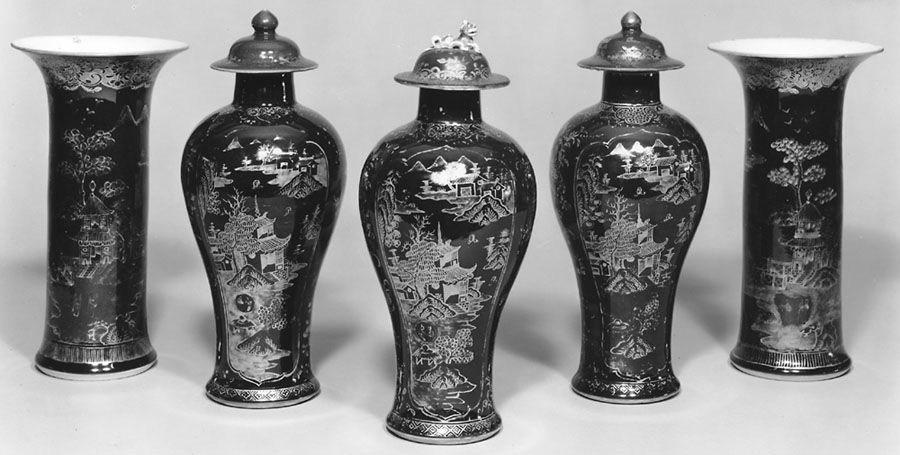 |
c. 1800 |
Unknown |
Chinese |
Porcelain |
Jars: Ht. 12", Vases: Ht. 10 1/4" |
|
Purchase, 2006 |
Gift(?) of E. V. Jones, 405 N. Monroe Street, Albany, GA 1/16/78. No evidence of gift in files. Purchased in 2006 from the late Edward Vasen Jones' daughter, Mrs. Jeanette Balling. |
0 |
|
|
Chinese export garniture: Three tall jars with covers and two vases in deep blue with gold oriental buildings and landscapes…"powder blue". |
In 2006, daughter of Edward Jones requested return of objects. No receipt of Boscobel ownership found in our files. Boscobel purchased objects in 2006. See paper file. |
Ceramics |
0 |
| TRUE |
Bottle and Basin |
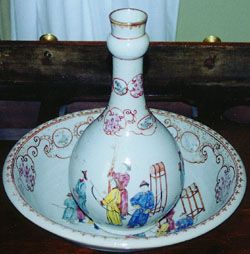 |
c. 1800 |
Unknown |
China for Export |
Porcelain |
Bowl: 11"Dia. Bottle: 10"H. |
|
Purchase, 1978 |
Purchase, Cora Ginsberg, Inc. Tarrytown, NY 1/26/78 |
0 |
|
|
Chinese export bottle and basin: with decoration in famille rose enamels, showing Mandarin archers. Gold darts around edge. |
|
Ceramics |
0 |
| TRUE |
Carpet |
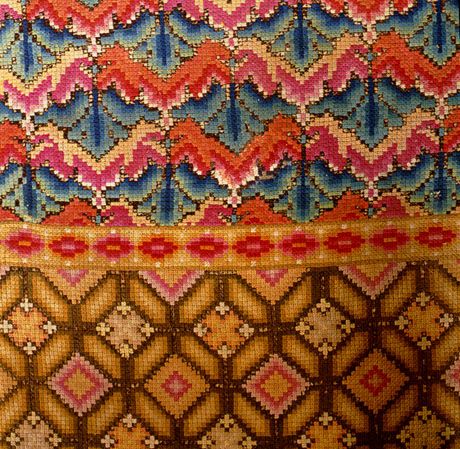 |
1810-30 or earlier |
Unknown |
English |
Wool |
14 x 11.6 feet |
|
Purchase, 1977 |
Attributed to Birkenhead workrooms, England Purchase, Dildarian, Inc. 595 Madison Ave., New York, NY 4/14/77 |
0 |
Ross, Rodris. Floor Coverings in 18th Century America. Smithsonian: 1967, p. 44-45. |
|
Needlepoint carpet: worked in rice or cross-corner stich in shades of blue, green, red and brown; lined in ecru linen. Superb preservation. |
|
Floor Coverings |
0 |
| TRUE |
Engraving |
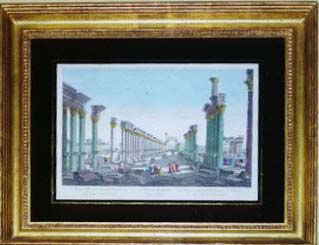 |
c. 1800 |
Unknown |
English |
Paper |
11 1/4 x 15 1/2" |
|
Purchase, 1977 |
Purchase, The Old Print Shop, Inc., 150 Lexington Ave., New York, NY 1/19/77 |
0 |
|
|
Les Ruines Du Gran Temple De Palmire Du Cote De L'Occcident: (vue d' optique). Paris, Ches D' Aument. Framed in black and gold. |
|
Prints/Drawings |
0 |
| TRUE |
Engraving |
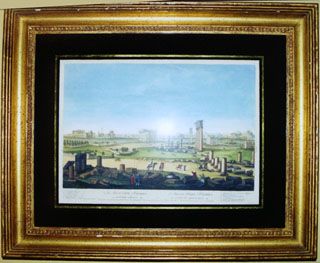 |
c. 1800 |
Unknown |
English |
Paper |
11 1/4 x 15 1/2" |
|
Purchase, 1977 |
Purchase, The Old Print Shop, Inc., 150 Lexington Ave.NYC 1/19/77 |
0 |
|
|
The Ancient City of Palmira as it now appears: Printed for Carrington Bowles, & co. In black and gold period frames. |
|
Prints/Drawings |
0 |
| TRUE |
Engraving |
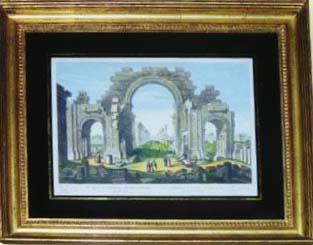 |
c. 1800 |
Unknown |
English |
Paper |
11 1/4 x 15 1/2" |
|
Purchase, 1977 |
Purchase, The Old Print Shop, 150 Lexington Ave., NYC 1/19/77 |
0 |
|
|
The Entrance Into The Temple Of The Sun In Palmira From The East: Printed for Robert Sayer & Co. In black and gold period frame. |
|
Prints/Drawings |
0 |
| TRUE |
Pair of engraved landscapes |
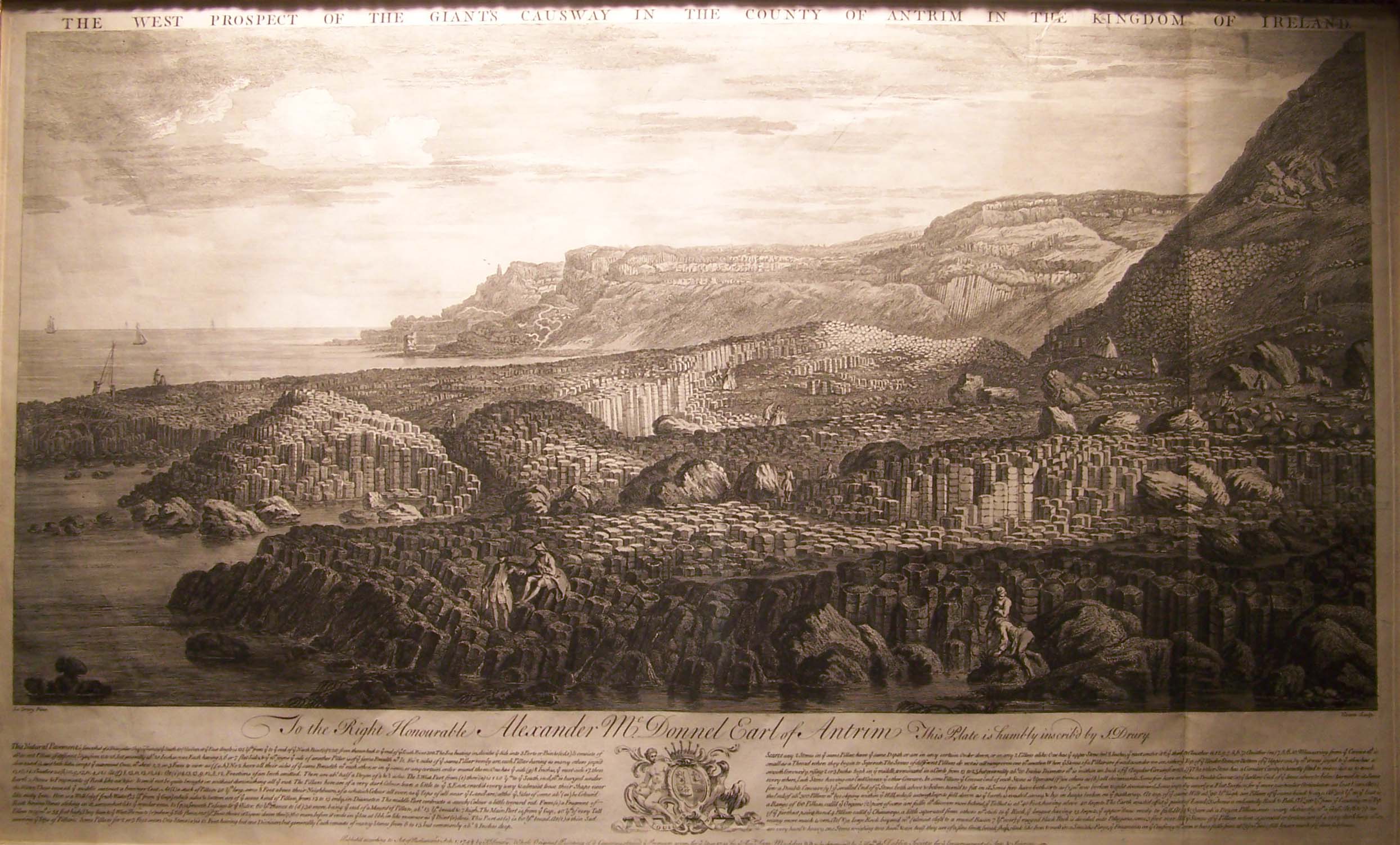 |
1734 |
after Susanna Drury |
England |
Engraving on paper |
|
|
Purchase, 1977 |
Purchase, The Old Print Shop, New York, NY 1/19/77 Frames from Julius Lowy, New York, NY 4/28/77 |
0 |
|
|
Pair of black and white engravings: framed, by Vivvaress after Drury. Published in 1743, London. [A] The West prospect of the Giant's Causeway in the County Antrim in the Kingdom of Ireland. [B] The prospect of the same. |
|
Prints/Drawings |
0 |
| TRUE |
Chamber Pot |
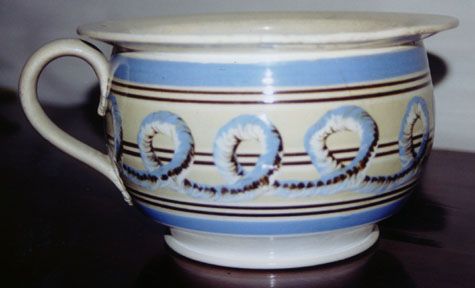 |
c. 1800 |
Unknown |
English |
Pottery |
9" diam. |
|
Purchase, 1970 |
Purchase, William C. Kennedy 5/25/70 |
0 |
See articles on banded ware in ceramics reprints file. |
|
Chamber pot or "bedside utility" : Mocha or banded ware, white with blue and brown striped and varigated wave and loop design, which is referred to as worm pattern. |
|
Ceramics |
0 |
| TRUE |
Stool |
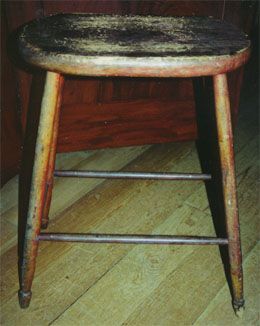 |
Early 19th century |
Unknown |
American |
Pine and maple |
24 1/2 x 21 1/4 x 12" |
|
Purchase, 1961 |
Purchase, Mary Allis 5/29/61 |
0 |
|
|
Pine and maple stool: oval seat on bamboo turned and stretchered legs, ending in blunt arrow feet. |
|
Furniture |
0 |
| TRUE |
Engraving |
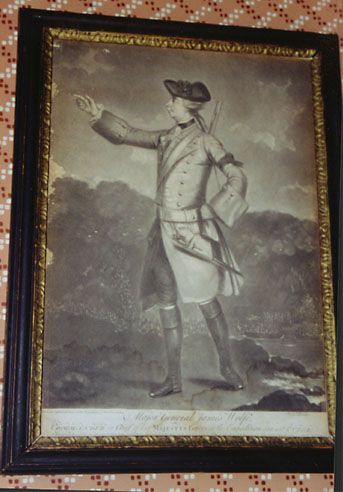 |
c. 1760 |
Richard Houston (1721-75) |
London, England |
Ink on paper |
14 x 10 |
"From an Original Picture in the Possession of Her'y Smith Esqr. / Rich'd Houston / Major General James Wolfe / COMMANDER in Chief of his MAJESTYS Forces on the Expedition against Quebec / Printed for J. Bowles & Son in Cornhill Eliz Bakewell Parker opposite Birshin Lane in Cornhill T. Bowles in St. Paul's Church Yard and Robert Sayer at the Golden Buck in Fleet Street. Prin'ed 2nd." |
Purchase,1961 |
Purchase, William C. Kennedy 6/10/61 |
0 |
|
|
Mezzotint engraving of Major General James Wolfe showing him standing with his right hand outstretched and facing to the viewer's left. |
Wolfe (1727-1759) died during the capture of Quebec from the French in 1759. He became an American hero. His death was also the subject of Benjamin Rush's famous history painting "The Death of Wolfe" of 1770. A sign made for the "General Wolfe" tavern in Brooklyn, Ct., c. 1768, copies this image. See "Early Connecticut Tavern Signs in the Connecticut Historical Society," Antiques Magazine (Dec 2000): 894. |
Prints/Drawings |
0 |
| TRUE |
Engraving, "Edward Boscawen" |
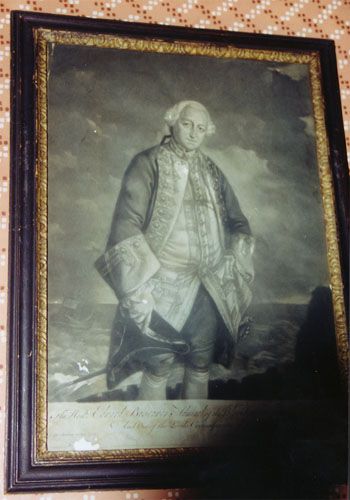 |
1758 |
James McArdell (1728-1765) |
London, England |
Ink on paper |
16-1/8 x 12-1/8 (frame) |
"The Honorable Edward Boscawen, Admiral of the Blue Squadron of His Majesty's Fleet / And One of the Lords Commissioners of the Admiralty / Five French Ships of the Line taken / Cape Breton taken 1758." / Sold by J.McArdell." |
Purchase, 1961 |
Purchased from William C. Kennedy 6/10/61 |
0 |
|
|
Mezzotint engraving of a three-quarter portrait after Sir Joshua Reynolds (1723-1792) of The Honorable Edward Boscawen (1711-1761) showing the admiral facing forward with a three-cornered hat in his right hand and a seascape in the background. |
|
Prints/Drawings |
0 |
| TRUE |
Vase |
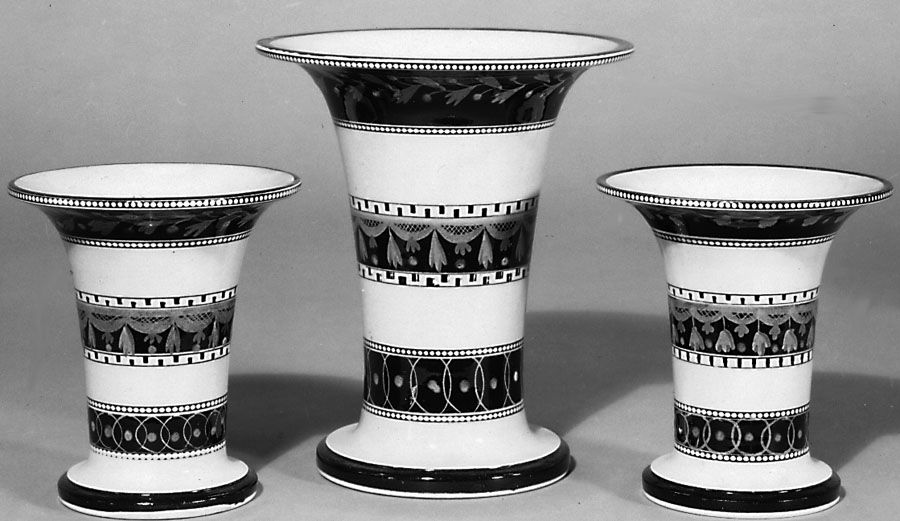 |
c. 1790 |
Unknown |
French |
Pottery |
a: 7" x 6", b: 5 x 5" , c: 5 x 5" |
|
Purchase, 1961 |
Purchase, William C. Kennnedy 1/15/61 |
0 |
Van Rensselaer, Susan. Banded Creamware. Refers to Creil. Can be found in the ceramics reprint folder. |
|
Garniture: Creil three piece spill vase garniture of flaring vased, painted with bands of tassels in blue and ochre. |
|
Ceramics |
0 |
| TRUE |
Engraving |
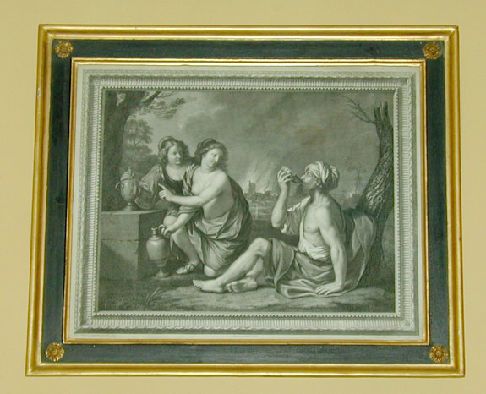 |
c. 1800 |
Unknown |
Italian |
Paper |
23 1/4 x 18" |
|
Purchase, 1976 |
Purchase, Sotheby Parke Bernet, New York, NY 11/3/76 |
0 |
|
|
Framed engraving: Morghen, Raphael, sculp Romae, Tofanelli, Stephanos, delin. Guercino pinx. In rectangular period frame, black with gilded rosettes at corners. Lot and His Daughters La Famiglia di Lot In the forground, on the right, Lot is seated on the ground, leaning his back against the trunk of a dead tree. He is half draped and wears a turban. He holds a cup in his right hand from which he drinks. In front of him, on the left of the picture, are the kneeling figures of his two daughter, one nearly nude, the other fully dressed. Both look towards Lot, their left hands resting on flagons. In the background the city of Sodum in flames, in front of which is the figure of Lot's wife, who was turned into salt. |
|
Prints/Drawings |
0 |
| TRUE |
Engraving |
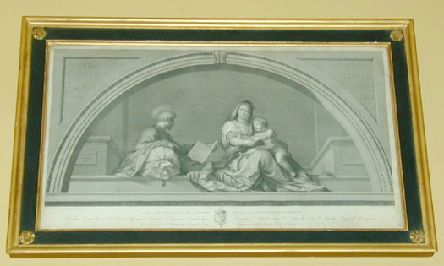 |
c. 1800 |
Rafaello Morghen (1758-1833) |
Italian |
Ink on paper |
17 x 29 1/2" |
.1 In the upper left corner:ANDREAS VANNUC CHIVS PINX In the upper right corner: IN CLAVSTRO SERVITA RVM FLOR .2 "RAPHAEL / SANTIVS / PINX" in upper left spandrel; "IN AEDIBVS / VATICA / NIS" in upper right spandrel; "PIO SEXTO PONT. MAX" across center bottom. "Steph. Tosanello deline" in bottom left; "Raph. Morghen Sculpit. / Johan. Volpato direxit, et vendit Romae / JOANNES VOLPATO D.D.D. / IX" in bottom right. |
Purchase, 1976 |
Purchase, Sotheby Parke Bernet, New York, NY 11/3/76 |
0 |
|
|
Framed engraving .1: A Sua Eccelenza Il Signor Generale Marchiese Manfredini. Morghen, Raphael, sculp, Flor. Matteini, Theodorus, Delin. Del Sarto, and Vulgo Dicto. Under the title the following is written: Cavalier Gran Croce di Santo Stephanoe Magnate d' Ungheria, Ciamberlano e Consigliere Attuale Intimo di State de Sua Maestra Imperiale Proprietario d'un Reggimento d' Infanteria Maggior Domo Maggoiore della corte di Toscana. .2: Engraved architectural design showing several classically dressed figures under an architectural arch. |
|
Prints/Drawings |
0 |
| TRUE |
Six side chairs |
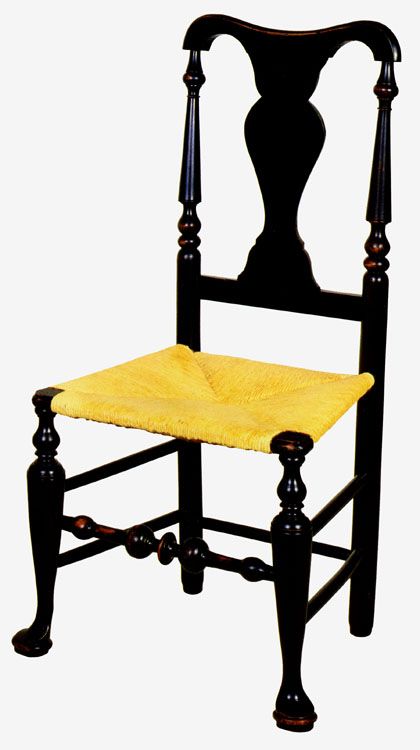 |
1780-1810 |
Unknown |
New York |
Maple, ash, rush |
40 x 21" |
|
Purchase, 1977 |
Purchased from Fred J. Johnston, Kingston, NY, through Thomas Kyle, Goshen, NY |
0 |
|
F 77.1 |
An assembled set of six yoke-back side chairs called "fiddle-backs" in their time. Each has a yoked crest rail above a solid vasiform splat set into a stay rail. The rear posts have columnar turnings with balls above and balusters below. The"trumpet"-turned front legs have baluster turnings at the tops of the legs. They terminate in offset turned pad feet. The ring-and-ball turned front stretcher has elongated balls at each end. Two side rungs and one rear rung brace the legs. Round tenons at the tops of the legs are doweled into flat blocks which form part of the seat frame. Rush seat. Painted black. Chair "A" has a broader splat that chairs "B" and "C", its nearest look-alikes. Chair "D" has seat corner blocks with rounded outside corners, whereas the blocks in all of the other chairs of this assembled set are pointed. The reel between the baluster turning and the top of the trumpet on the legs is deeper than the other chairs. Chair "E" is noticeably lighter than the others, both visually and physically. Chair "F" has seat corner blocks that are attached to the legs with wooden pins. These two chairs differ from F 77.1 most notably in construction of the seat frame. |
According to Berry Tracy, these chairs were the common chair of all households in the Hudson Valley for over a hundred years. This yoke back rush bottom chair with pad feet and a broad shapely back splat, usually painted black, was made popular for its economy, ruggedness and comfort. It is an early 18th century Dutch form which was made and advertised for sale in the Albany Gazette as late as 1810. Art & Antiques Magazine- Sept-Oct. 1981. "The Fiddleback Chair," Johnson. P.78-83. |
Furniture |
25 |
| TRUE |
Engraving |
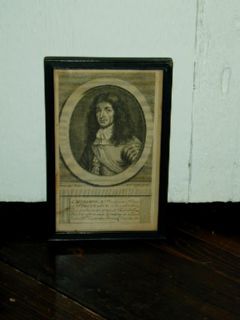 |
c. 1800 |
Unknown |
English |
Paper |
5 1/2 x 3 1/2" |
|
On Loan from Department of Parks, City of New York |
On loan from the Department of Parks, City of New York, since 1963 |
0 |
|
|
Engraving of Charles II in oval reserve: from an original painting by M.V. DiGuchi, Sculpt. Inscription below picture reads as follows: "Charles II Proclaimed King of G Britain & C at Worcester Aug 23, 1562 Made his escape in Boscobel Wood & afterward by hiding as a servant before Mrs. Lane thro several countries." Framed in later frame. |
Object is stored on top of bookshelf in curatorial office |
Prints/Drawings |
0 |
| TRUE |
Cornice |
 |
Early 19th century |
Unknown |
American |
Wood |
60 3/4" wide |
|
Purchase, 1977 |
Purchase, George Subkoff, New York, NY 2/23/77 |
0 |
|
|
Set of three carved, painted and parcel- gilded window cornices: slightly arched, painted ivory, with carved pendant acorn drops highlighted with gilding. |
|
Window Treatments |
0 |
| TRUE |
Engraving |
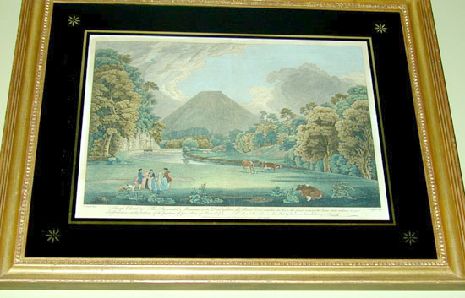 |
18th century |
Unknown |
English |
Paper |
14 3/8 x 21" |
|
Purchase, 1977 |
Purchase, The Old Print Shop, Inc. New York, NY 1/19/77 |
0 |
|
|
Framed engraving: Thorp cloud &c. This Prramydical Mountain is in Derbyshire… Mason Sculp. T. Smith Pinx. Publ. T.Smith, London 1751. In color with black glass mat, gold frame. |
|
Prints/Drawings |
0 |
| TRUE |
Engraving |
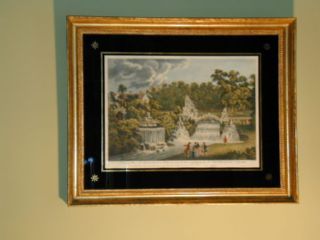 |
18th century |
Unknown |
English |
Paper |
14 3/8 x 21" |
|
Purchase, 1977 |
Purchase, The Old Print Shop, Inc. New York, NY 1/19/77 |
0 |
|
|
Framed engraving: A view of the new waterworks &c. At Belton in Lincolnshire…F. Vivares Scul. T. Smith Pin. 1749. In color, with black glass mat, gold frame. |
|
Prints/Drawings |
0 |
| TRUE |
Engraving |
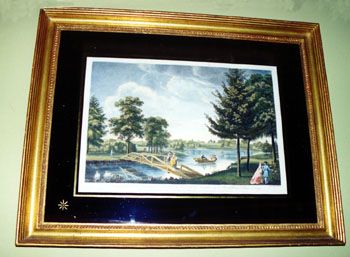 |
c. 1800 |
Unknown |
English |
Paper |
14 3/8 x 21" |
|
Purchase, 1977 |
Purchase, The Old Print Shop, Inc. New York, NY 1/19/77 |
0 |
|
|
Framed engraving: A view from the West side of the Island in the Garden of the Hon.ble Charles Hamilton Esq.r at Painshill near Cobham in Surry. Robert Sayer publ. Framed with black mat, gold frame. |
|
Prints/Drawings |
0 |
| TRUE |
Engraving |
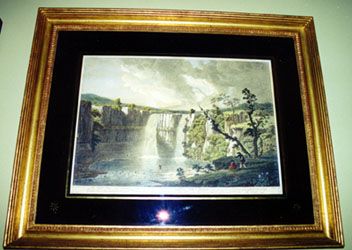 |
Late 18th century |
Unknown |
English |
Paper |
14 3/8 x 21" |
|
Purchase, 1977 |
Purchase, The Old Print Shop, Inc. New York, NY 1/19/77 |
0 |
|
|
Framed engraving: The High Force. This Cataract is on the River Teese, which divides the Counties of York and Durham…I. Mason sc. Thos. Smith Pinx. Publish'd Dec. 1751. Black glass mat, gold frame. |
|
Prints/Drawings |
0 |
| TRUE |
Engraving |
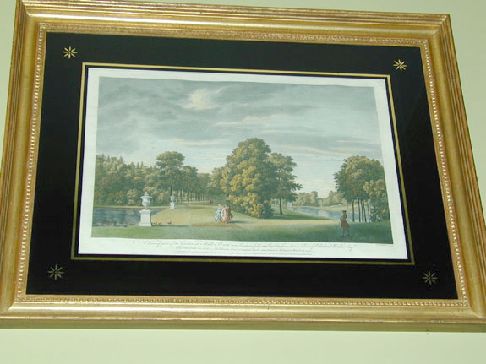 |
c. 1800 |
Unknown |
English |
Paper |
14 3/8 x 21" |
|
Purchase, 1977 |
Purchase, The Old Print Shop, Inc. New York, NY 1/19/77 |
0 |
|
|
Framed engraving: A view of part of the Garden at Hall-Barn near Beckonsfield in Buckinghamshire... W.Woollett del. Er sculp. Printed for Henry Parker & c. Black glass mat, gold frame, colored. |
|
Prints/Drawings |
0 |
| TRUE |
Engraving |
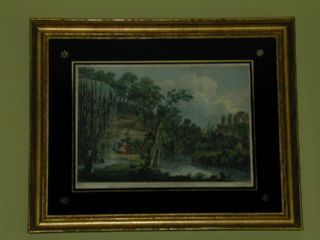 |
Late 18th century |
Unknown |
English |
Paper |
14 3/8 x 21" |
|
Purchase, 1977 |
Purchase, The Old Print Shop, Inc. New York, NY 1/19/77 |
0 |
|
|
Framed engraving: A view of the Petrifying Spring, commonly call'd the Dropping Well Vevares sculp. Theo. Smith Pin. 1746. In color, with black glass mat, in gold frame. |
|
Prints/Drawings |
0 |
| TRUE |
Cup and saucer |
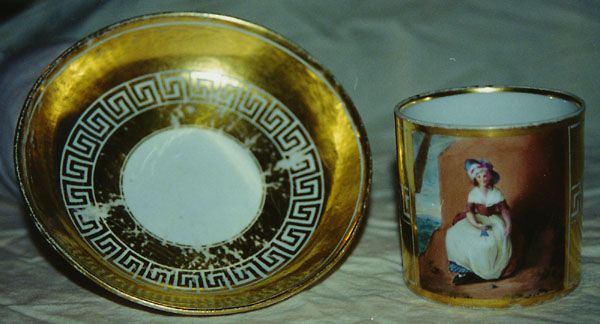 |
1801 |
Unknown |
Possibly Coalport, John Rose & Co |
porcelain, enamel, gilding |
Cup: 2 1/2 x 3 3/4" Saucer: 1 1/8 x 5 1/8" |
On bottom of cup, dated 1801 and initialed "TB" for Thomas Baxter, the decorator. |
Gift of Alberta Welch, 1966 |
By tradition, belonged to States M. Dyckman Alberta M. Welch left this piece and others to Boscobel in her will. |
0 |
Godden, Geoffrey, A. FRSA, An Illustrated Encyclopedia of British Pottery and Porcelain, 1966, pp.91-92 Godden, Geoffrey, A. Coalport & Coalbrookdale Porcelains, 1970 |
A tea service with similar decoration is in the Wells collection at the Los Angeles County Museum of Art. |
Chocolate cup and saucer, in rose and gold with Greek key design and a portrait medallion of a seated woman. Decorated by Thomas Baxter Jnr. (17 February 1782 – 18 April 1821) |
|
Ceramics |
0 |
| TRUE |
Tea Service |
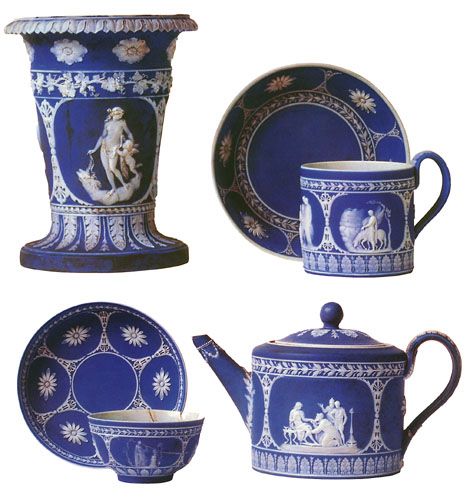 |
1803 |
Josiah Wedgwood |
English |
Porcelain |
See file |
|
On Loan from Department of Parks, City of New York |
|
0 |
|
|
Part of service of deep blue and white Jasper cameo: purchased from Josiah Wedgwood & Byerley. All relief molded with classical vignettes and leaf borders. |
|
Ceramics |
97 |
| TRUE |
Silhouette |
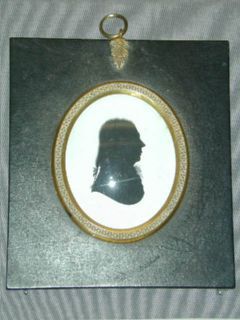 |
c. 1800 |
Unknown |
London, England |
Paint on plaster, glass, brass, paper- mache |
5 3/4 x 5 1/8; oval medallion 3 1/4 x 2 5/8 |
Partial paper attached to back of silhouette reads: Miers... Profile Painter... Opposite Exeter Chang... London Conti taken profile shadow peculiar to by the most anim size for N3M so that any number ding again flat of convex Borders to any dimensions |
On Loan from Department of Parks, City of New York |
Maker, Miers, London On Loan from Department of Parks, City of New York, 1961 |
0 |
|
|
The oval silhouette portrait of SMD shows him facing right against a white background. The plaster portrait is mounted under glass within a stamped brass frame attached to a rectangular, paper- mache, black-painted frame with a brass hanging ring at the center top. A printed label of the portraitist is attached to the back of the plaster and frame. |
Original card (pink) reads, "Gift of Dorothy Dean Boorman", no record of gift in files. |
Prints/Drawings |
0 |
| TRUE |
Painting, silhouette |
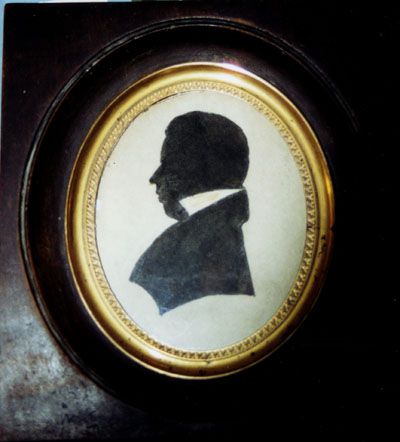 |
c. 1820 |
Unknown |
American |
Paper |
[2 3/4 x 2 1/8"] Framed size: 4 1/4" wide x 4 3/4" long |
|
On Loan from Department of Parks, City of New York, 1961 |
On Loan from The City of New York, Dept of Parks, 1961 |
0 |
|
|
Silhouette of Peter Corne Dyckman (1797-1824): Only son of States Morris Dyckman, artist unknown. Oval, painted on paper, in narrow gold frame, mounted on dark wood rectangular frame. |
|
Paintings |
0 |
| TRUE |
Decanter |
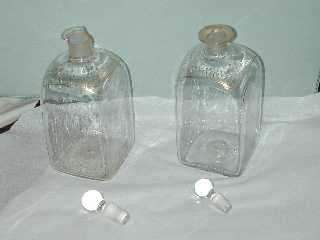 |
c. 1788 |
Unknown |
Northern Europe |
nonlead glass |
7 1/2 x 3 x 3" |
|
On Loan from Department of Parks, City of New York |
Possibly purchased from John Blades, London, in 1787 or 1788 by States Morris Dyckman. On Loan from The Department of Parks, City of New York, 1966 |
0 |
|
|
Pair of gold decorated square decanters with stoppers. |
|
Glass |
0 |
| TRUE |
Set of three cups |
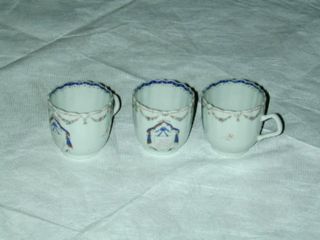 |
1800-1810 |
Unknown |
China, for export |
Porcelain with overglaze enamel decoration |
2 1/2 x 3 1/2 x 2 5/8 (dia) |
|
On Loan from Department of Parks, City of New York |
The Dyckman Family, early 19th century. On Loan from The City of New York, Dept. of Parks, 1966 |
0 |
|
|
The mold cups have faintly ribbed sides and a scalloped rim. A draped shield enclosing script initials "ER" is painted opposite the handle. Enameled polychrome swags run around the outside near the rim, and a blue band with stars occurs inside. |
Stored in F 76.27 |
Ceramics |
0 |
| TRUE |
Tray |
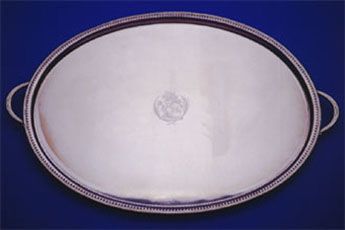 |
c. 1800 |
Unknown |
English |
Sheffield Plate |
29 3/8 x 19", 1 1/4"H. |
"SMD" cypher |
On Loan from Department of Parks, City of New York |
An original Dyckman Family Possession, c.1800 On loan, from The City of New York, Dept. of Parks, 1966 |
0 |
|
|
George III Sheffield Plate oval two handled tea tray: with "SMD" cypher and design of tree and branch. Wood base, faded baize cover. |
LOCATION UPDATE: OBJECT MOVED TO DINING ROOM AS OF MARCH 2007 |
Silver |
0 |
| TRUE |
Bill of Sale |
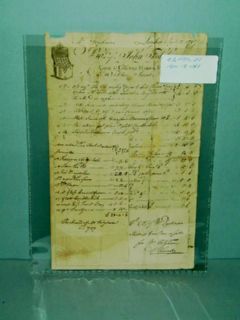 |
1787-1804 |
Unknown |
English |
Paper |
|
|
On Loan from Department of Parks, City of New York |
On Loan from Department of Parks, City of New York 1966 |
0 |
|
|
Seven Bills of Sale made out to States Morris Dyckman: [a] Sharpus & Co., London, September 24, 1803 [b] Sharpus & Co., London, September 24, 1803 [c] Josiah Wedgwood and Byerley, London August 19, 1803 [d] Walter Smith, London, April 16, 1804 [e] John Blades, London, October 1, 1803 [f] John Folgham, London, April 13, 1787 [g] Josiah Wedgwood, London, April 16, 1787 |
Many of the objects on display in the Museum are represented in these bills. 'A' & 'B' are identical as indicated in this record. 'E' is part of the Bill of Sale dated September 28, 1803. (7/31/2003) |
Prints/Drawings |
0 |
| TRUE |
Tray |
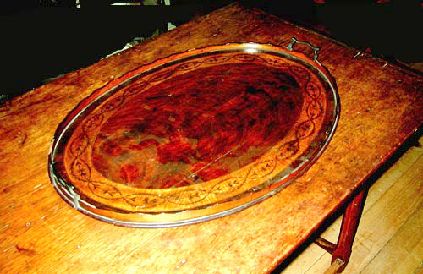 |
1787 |
Unknown |
English |
Mahogany,satinwood?, iron |
2 7/8 x 30 x 21 1/2" |
|
On Loan from Department of Parks, City of New York, dated received 1966 |
On Loan, from The City of New York, Dept. of Parks, 12/30/66 |
0 |
|
|
Oval George III mahogany tea tray: with serpentine gallery and wrought iron handles. Inlaid with a banding of leaf chains. |
Archived museum accession card reads, "included in shipment sent by Mr. Dyckman from London on the sailing vessel 'Miss Betsy' on Sept. 27, 1787." |
Household Items |
0 |
| TRUE |
Flute |
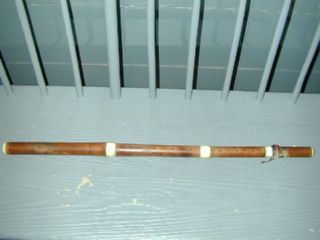 |
1789 or earlier |
Unknown |
English |
Boxwood, ivory, brass fittings |
27 3/8 x 1 1/4 (dia.) |
Impressed with "KUSDOR" in several places on the flute. |
On Loan from Department of Parks, City of New York |
Purchased by Mr. Dyckman from Michael Roberts, New York, August 7, 1789. On Loan, from The Department of Parks, City of New York, 1966 |
0 |
|
|
"KUSDER/LONDON" stamped into each of the four parts. One brass key in end section. Three finger holes in each of two middle sections. |
|
Musical Instruments |
0 |
| TRUE |
Flatware |
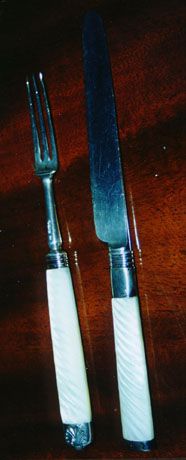 |
1802 and 1803 |
John Thompson |
English |
Silver |
wood case: H. 1 3/4 x 14 1/8 x 9 1/4" knives: L 8 1/4 x 5/8" forks: L. 7 1/8 x 1/2" |
London date letters H (1803) on all except knife 5 has G (1802) |
On Loan from Department of Parks, City of New York |
Made by John Thompson, London,1803 (knife 2/20 is dated 1802) [dates added JP] On Loan, from The City of New York, Dept. of Parks, 1966 |
0 |
|
|
Part of service of Regency dessert flatware: Mother of pearl spirally fluted handles, in original wood case. There are eleven forks and eight knives mounted with silver tines and blades. |
Description Cont.: 1. 2.knife 3.knife 4.fork [CHECK THIS DUPLICATE #?] 4.knife [CHECK THIS DUPLICATE #?] 5.knife 6. 7.knife 8.knife 9.knife 10.fork 11.fork 12.fork 13.fork 14.fork 15. 16. 17.fork 18.fork 19.fork 20. |
Silver |
0 |
| TRUE |
Hot-Water Dish |
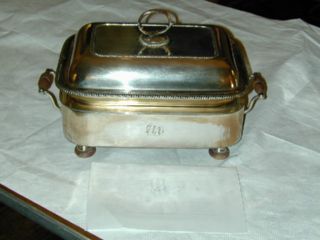 |
c. 1803 |
Unknown |
England, probably Sheffield |
Silver plate |
6 3/4 x 14 1/8 x 8" |
"ECD" |
Purchase, 1961 |
Purchased by States Morris Dyckman in England, in 1803. Purchased from John Conover, Ossining NY 1961 |
0 |
|
|
The silver-plate rectangular four-part hot-water dish stands on four button feet and has shaped fruitwood handles on each end. The hot-water warming dish is fitted with a conforming cover that supports a similarly shaped serving dish with a domed cover. The serving dish and cover have gadrooned borders; the cover has a loop handle. The base is monogrammed "ECD". |
Part of a set of four made for States Dyckman. See S 66.9, S 66.11, S 66.17. |
Silver |
0 |
| TRUE |
Engraving |
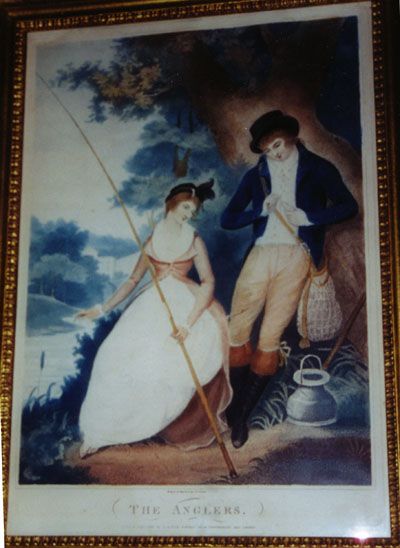 |
c. 1800 |
Unknown |
English |
Paper |
16 1/2 x 11" |
|
Purchase, 1977 |
Purchase, Old Print Shop, New York, NY 1/19/77 Framed by Julius Lowy, New York, NY 5/28/77 |
0 |
|
|
The Anglers: colored engraving in a gold frame. Designed and engraved by I. Peirson, London. Printed July 1, 1800 by J. Le Petit Latimer, House of Hammersmith, near London. |
|
Prints/Drawings |
0 |
| TRUE |
Engraving |
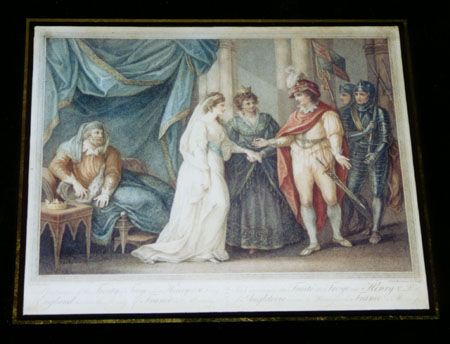 |
Late 18th century |
Unknown |
English |
Paper |
13 x 15 1/2" |
|
Purchase, 1977 |
Purchase, The Old Print Shop, New York, NY 1/19/77 Framed, Julius Lowy, New York, NY 4/28/77 |
0 |
|
|
The Conclusion of The Treaty of Troye: where Henry the V King of England receives the Princess of France in Marriage. Frans. Bartolozzi Sculp. After W. Hamilton. Published in London, Feb. 14, 1788 by Vivares, No. 13 Great Newnort Street. In black and gold frame. |
|
Prints/Drawings |
0 |
| TRUE |
Engraving |
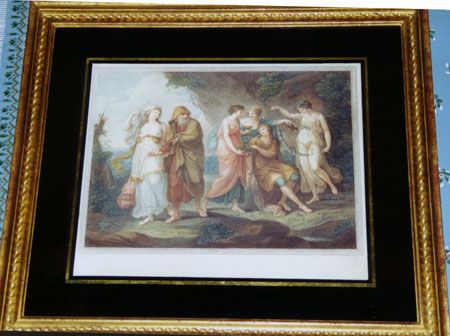 |
Late 18th century |
Unknown |
English |
Paper |
12 3/4 x 15 1/4" |
|
Purchase, 1977 |
Purchase, The Old Print Shop, New York, NY 1/19/77 Framed by Julius Lowy, New York, NY 4/28/77 |
0 |
|
|
Telemachus and Mentor: in the Island of Calypso, F. Bartolozzi Sculpt. After Angelica Kauffman. London, June 7, 1786. Published by Myrland 65 the corner of Berners Oxford Street. In black and gold period frame. |
|
Prints/Drawings |
0 |
| TRUE |
Engraving |
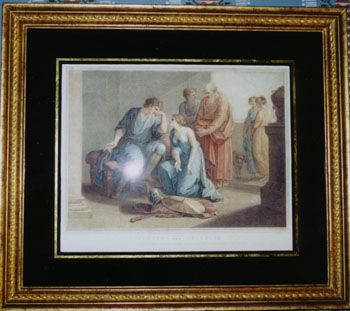 |
Late 18th century |
Unknown |
English |
Paper |
12 1/8 x 14 1/2" |
|
Purchase, 1977 |
Purchase, The Old Print Shop, New York, NY 1/19/77 Framing, by Julius Lowy, New York, NY 4/28/77 |
0 |
|
|
Cleopatra and Meleagar: Cleopatra persuading Meleagar to take his arms in defense of his country. After Angelica Kauffman. F. Bartolozzi sculp. Published as the act directs April 1, 1783 by A. Torre, no. 11 Market Lane, London. In Black and gold period frame. |
|
Prints/Drawings |
0 |
| TRUE |
Urn |
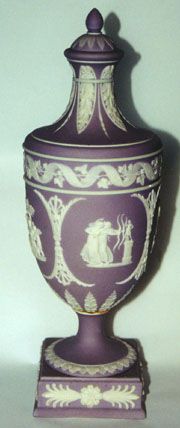 |
c. 1790 |
Josiah Wedgwood |
English |
Porcelain |
11 1/4" H |
|
Gift of Mrs. and General Frederick Osborn, 1962 |
Gift of General & Mrs. Frederick Osborn, Garrison, NY 1962 |
0 |
|
|
Jasperware Urn: Lilac colored urn, relief molded with facinated bandings, anthemia and figural vignettes; with cover. |
|
Ceramics |
0 |
| TRUE |
Bowl |
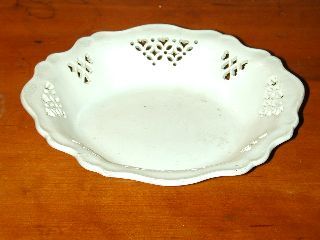 |
probably 1888-1916 |
Unknown |
Leeds, England |
creamware |
2 x 8-3/8 x 7-7/8 |
|
Purchase, 1970 |
Purchase, William C. Kennedy, 5/25/70 |
0 |
|
|
The oval reticulated shallow bowl has a scalloped rim and stands on a foot ring. The body is very thick. |
Maker attributed to Leeds. |
Ceramics |
0 |
| TRUE |
Pitcher and basin set |
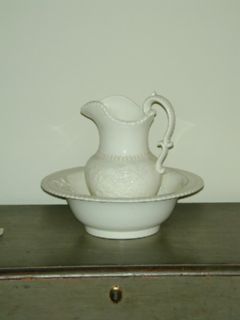 |
19th century |
Unknown |
England |
white earthenware |
Pitcher: 13 1/2" Ht. Bowl: 14" Dia. |
|
Purchase, 1970 |
Purchase, William C. Kennedy, 5/25/70 |
0 |
|
|
Wash basin and pitcher set: white molded creamware in raised design, baskets of flowers. |
LOCATION UPDATE: MOVED TO SILL'S ROOM AS OF MARCH 2007 |
Ceramics |
0 |
| TRUE |
Pair of candlesticks |
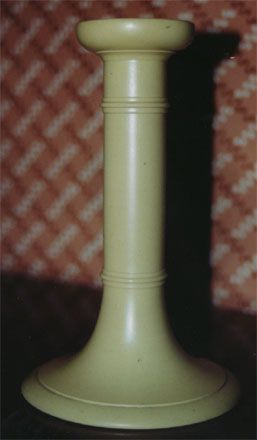 |
probably late 19th century |
Unknown |
England |
ceramic |
7" H |
|
Purchase, 1962 |
Purchase, William C. Kennedy 8/28/62 |
0 |
References: Godden, Geoffrey A. 1. British Pottery and Porcelain. Crown:1966 pp.325-27 2. British Porcelain. Barrie and Jenkins. London 1974 pp 85-86 3. Mason's Patent Ironstone China. Praeger 1971 pp. 96-97 |
|
The pair of candlesticks is buff-colored with plain cylindrical shaft, flaring base, and deeply cupped bobeche. Two collars on shaft. |
LOCATION UPDATE: MOVED TO SILL'S ROOM AS OF MARCH 2007 Attributed to Turner. The Complete Encyclopedia of Antiques edited by L.G.G. Ramsey and compiled by Connoisseur refers to Turner Pottery as follows: Turner, John (d. 1786) Potter of stoke and lane end (Staffordshire), made fine creamware and Wedgwood type stonewares. His sons continued until 1803. Marks; TURNER and TURNER & CO., impressed. |
Lighting |
0 |
| TRUE |
Statuette |
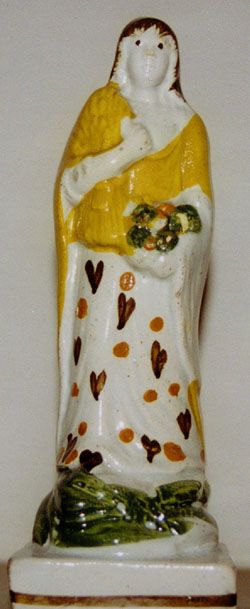 |
c. 1800 |
Unknown |
English |
Pottery |
6 1/2" H |
|
Purchase, 1962 |
Purchase, William C. Kennedy 6/20/62 |
0 |
Godden, G. Encyclopedia of British Porcelain Marks. P.688 |
|
Figurine: in yellow cloak with basket of fruit or flowers, hollow base. Represents summer. |
Attributed to Ralph Wood. |
Ceramics |
0 |
| TRUE |
Statuette |
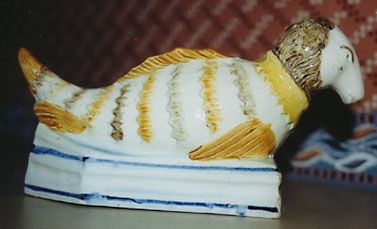 |
c. 1790 |
Unknown |
English |
Pottery |
3 1/2 x 7 1/4" |
|
Purchase, 1962 |
Purchase, William C. Kennedy 6/20/62 |
0 |
|
|
Animal figurine: Leeds pottery, fantasy animal with sheep's head and the body of a fish. |
|
Ceramics |
0 |
| TRUE |
Mug |
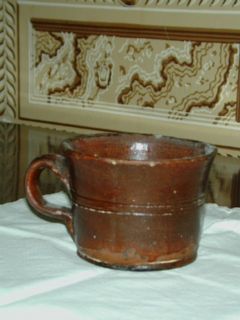 |
18th century |
Unknown |
American |
Pottery |
3 1/2 x 4 1/2" diam. |
|
Gift from Mr.and Mrs. Fred Thompson |
Gift of Mr. And Mrs. Fred Thompson, 1962 Purchased from John Conover, Ossining, NY Said to have belonged to States Morris Dyckman |
0 |
|
|
Shaving mug: Brown glazed pottery with handle on the side. |
|
Ceramics |
0 |
| TRUE |
Shelf |
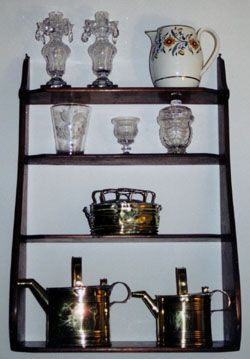 |
c. 1800 |
Unknown |
American |
Walnut |
34 1/2 x 24" |
|
Purchase, 1962 |
Purchase, William C. Kennedy 6/20/62 |
0 |
|
|
Walnut hanging shelf: with closed whale- shaped sides enclosing four graduated shelves. |
|
Furniture |
0 |
| TRUE |
Chair |
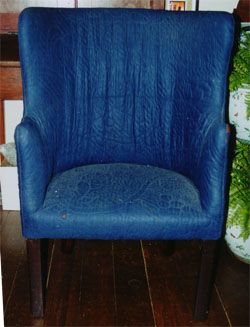 |
c. 1800 |
Unknown |
American |
Mahogany, secondary wood, upholstery repurposed c.1800 quilt |
41 x 26 1/2 x 19" |
|
Purchase, 1962 |
Purchase, William C. Kennedy 6/20/62 |
0 |
|
|
Barrel back chair: referred to as a "stuffed back" chair. Upholstered in dark blue quilted woolen (see card T 62.2). Mahogany legs, incurvate back and closed sides. The fabric is a dyed wool blanket, American, c.1800. |
|
Furniture |
0 |
| TRUE |
Towel Rack |
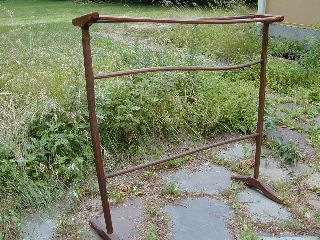 |
1800-1850 |
Unknown |
American |
Ash or chestnut |
34 x 33 3/4 x 13" |
|
Purchase, 1963 |
Purchase, William C. Kennedy 11/12/63 |
0 |
|
|
Towel rack made of two uprights chamfered to octagonal shapes, round- tenoned into shoe feet with chamfered tops, and surmounted by a horizontal bar. Two chamfered rods join the top bars, and two medial rods join the uprights. All round tenons are secured in their sockets by nails. |
|
Furniture |
0 |
| TRUE |
Towel Rack |
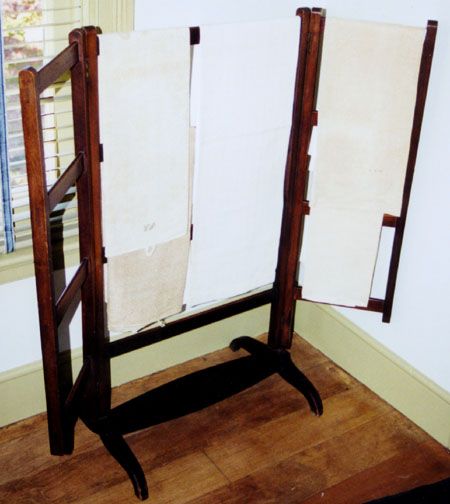 |
1800-1850 |
Unknown |
England |
Mahogany |
41 1/2" H |
|
Purchase, 1961 |
Purchase, William C. Kennedy 1/15/61 |
0 |
|
|
Mahogany towel rack: with trestle supports and a shaped trellis, has hinged wings. |
Towel rack was moved from Tub Room to Peter's Bedroom on 8/27/02. |
Furniture |
0 |
| TRUE |
Towel Rack |
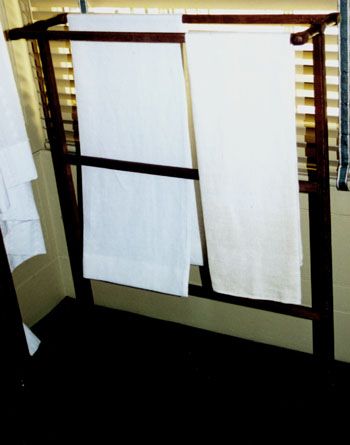 |
c. 1800 |
Unknown |
American |
Pine |
34" H |
|
|
Previously identified as purchased for $35.00 from W.C. Kennedy Associates on August 24, 1962, but invoice from that date does not support that source. |
0 |
|
|
Pine towel rack: on trestle feet, turned. |
|
Furniture |
0 |
| TRUE |
Candlestand |
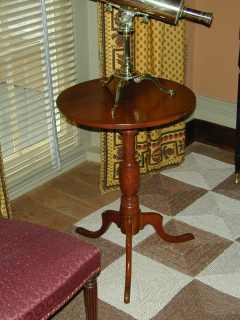 |
1790-1830 |
Unknown |
New England |
Cherry or birch |
26 1/2 H x 19 1/4"dia |
|
Purchase, 1963 |
Bill of sale from William C. Kennedy, dated February 14, 1963, identifies this stand ("Round top candle-stand, American, Cherry, 2nd floor chamber") as being among "Furniture from Henderson Sale." |
0 |
|
|
Candlestand has a circular top fixed onto a cleat that is attached with two large pins to the top of a turned pillar. The urn turned pillar has several paired score rings in the uppermost cylinder, the central cylinder, and the urn. Three ogee shaped feet are dovetailed into the bottom cylinder of the pillar. |
|
Furniture |
0 |
| TRUE |
Set of four engravings |
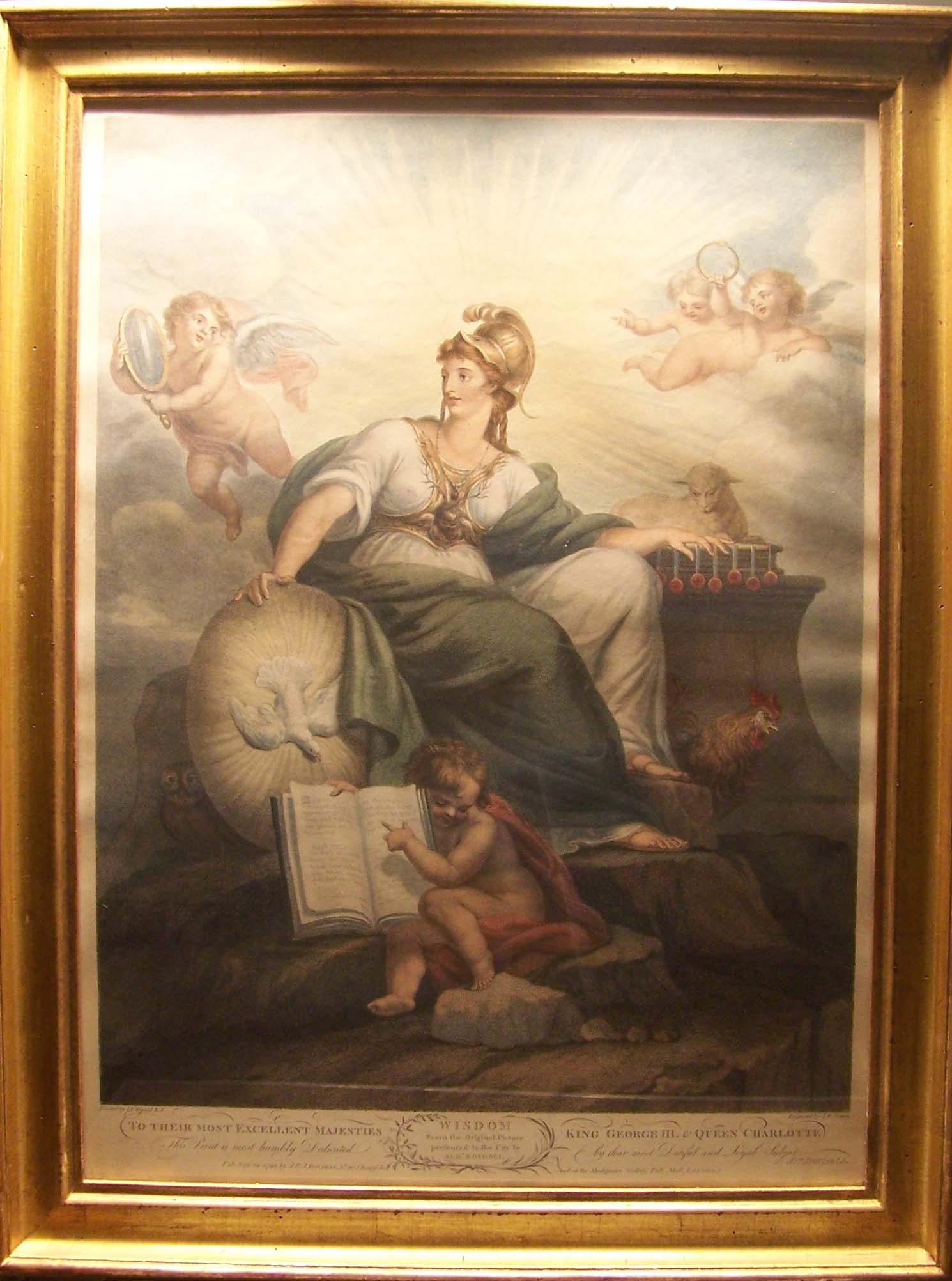 |
1799 |
John and Josiah Boydell after John Francis Rigaud |
London, England |
Colored stipple engraving on paper |
23 x 16-3/4 (sight), 26-3/4 x 20-1/2 (frame) |
see description. |
Purchase, 1977 |
Purchased from The Old Print Shop, New York, NY 1/19/77 |
0 |
|
|
Set of four colored stipple engravings of four virtues executed by different engravers from frescoes byJohn Francis Rigaud (1742-1810) made for the Common Council Chamber in the Guildhall in London. "a": "WISDOM. / From the Original Picture / Presented to the City by / ALD. BOYDELL." "Painted by I.F. Rigaud R.A." in lower left; "Engraved by I.P. Simon." in lower right. 'b": "PROVIDENCE. / From the Original Picture / Presented to the City by / ALD. BOYDELL." "Painted by I.F. Rigaud R.A." in lower left; "Engraved by Benj. Smith." in lower right. "c": "INNOCENCE. / From the Original Picture / Presented to the City by / ALD. BOYDELL." "Painted by I.F. Rigaud R.A." in lower left; "Engraved by I.P. Simon." in lower right. "d": "HAPPINESS. / From the Original Picture / Presented to the City by / ALD. BOYDELL." "Painted by I.F. Rigaud R.A." in lower left; "Engraved by Thos. Burke." in lower right. "To their most excellent Majesties King George, III, & Queen Charlotte. / This print is most humbly Dedicated by their most Dutiful and Loyal Subject Jno Boydell." and "Pub. Sept 29, 1799 by J& J Boydell No 90 Cheapside and at the Shakespear Gallery Pell Mell London." along bottom margin. Each engraving is framed in a gilded molded frame. |
Frame from Julius Lowy, New York, NY 5/17/77 |
Prints/Drawings |
0 |
| TRUE |
Set of four wall brackets or sconces |
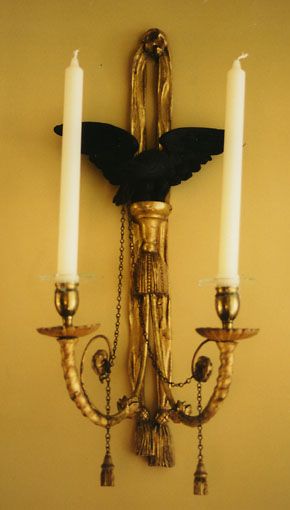 |
1805-1820 |
Unknown |
Probably England |
Wood, gold leaf, gesso, brass |
25" H |
|
Purchase, 1977 |
The grandchildren of Mrs. Ranson Spaford Hooker gave these wall brackets to The Met in 1972. Boscobel purchased the set from The Metropolitan Museum of Art, April 17, 1981. |
0 |
|
Leigh Keno (NY) owned a similar pair of eagle wall brackets, December 1998 (see photo in file). |
Wall brackets are gessoed and gilded wood with carved black eagle on top in the classic style, each having a bracket in the form of tassels supporting an ebonized eagle with spread wings, continuing in two spirally fluted candle arms ending in urn form sockets and hung with chains from the eagle's beak. Repainted and regilded. |
These sconces are reported to be a rare set from a Charleston, South Carolina home. These sconces were originally on loan to Boscobel from The Metropolitan Museum of Art, accession # 1972.97.1-4 |
Lighting |
0 |
| TRUE |
Engraving |
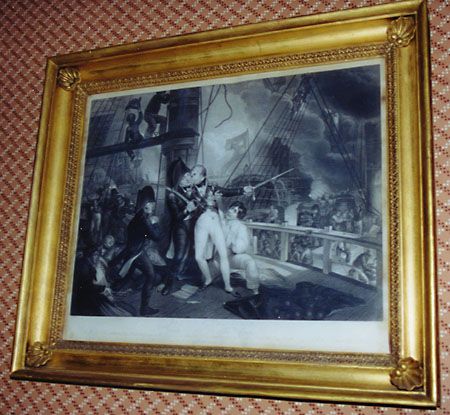 |
c. 1805 |
Unknown |
England |
Paper |
|
"To the memory of the Countrymen who so nobly fought and conquered the combined fleets of France & Spain at the battle of Trafalgar on the 21st of October 1805 This engraving is inscribed by Edward Orme." |
Purchase, 1976 |
Purchased at Sotheby Parke Bernet, 11/3/76, through William C. Kennedy |
0 |
|
|
Engraving of the Battle of Trafalgar and Death of Lord Viscount Nelson. Robert Cooper, sculpt., W. M. Craig pinct. In a gilded frame with carved shells at the corners. |
|
Prints/Drawings |
0 |
| TRUE |
Engraving |
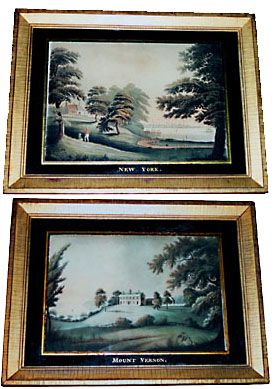 |
c. 1800 |
Unknown |
English and American |
Paper, glass mat |
12 1/2 x 17 7/8" |
|
Purchase, 1976 |
Purchase, James R. Bakker, Littleton, MA, 9/23/76 |
0 |
Advertised by James R. Bakker in Antiques, March 1976 Helen Comstock, ed., The Concise Encyclopedia of American Antiques, Hawthorne, NY, 1966. The chapter on engraving by Elizabeth Roth refers to the title of our print of New York as "New York from Hobuck Ferry" on page 540, in reference to Frances Jukes, the engraver. On page 541, Alexander Robertson is referred to as the Scottish artist whose watercolor views were engraved by Frances Jukes. |
|
Two colored mezzotints of New York and Mount Vernon , in their original black glass mats and lemon-gilt frames Original watercolor by Alexander Robertson (1772-1841) engraved by Francis Jukes (1747-1812). |
In Antiques Magazine, February 1977, page 330, the view of Mount Vernon is shown without its frame, and the complete title of the picture (now covered by the frame) is shown. It reads: "Mount Vernon in Virginia/The seat of the late Lieut. General George Washington." The dimensions are given as 14 1/2 by 18 9/16 inches. They state that although the print was issued in London on March 31, 1800, it was not offered for sale in New York until July 25, when Archibald and Alexander Robertson advertised in the Commercial Advertiser that they "have received by the factor, from London, two very highly finished prints of Mount Vernon and New York . . .in aquatinta. . .and colored in accurate imitation of a drawing. These views. . . .are expressly adapted for furniture prints. . . " This print served as a design for many silk embroideries and watercolors. Archibald Robertson is known to have been an associate of Mr. Dyckman, as well as a distinguished artist. (How do we know this?) |
Prints/Drawings |
0 |
| TRUE |
Urns |
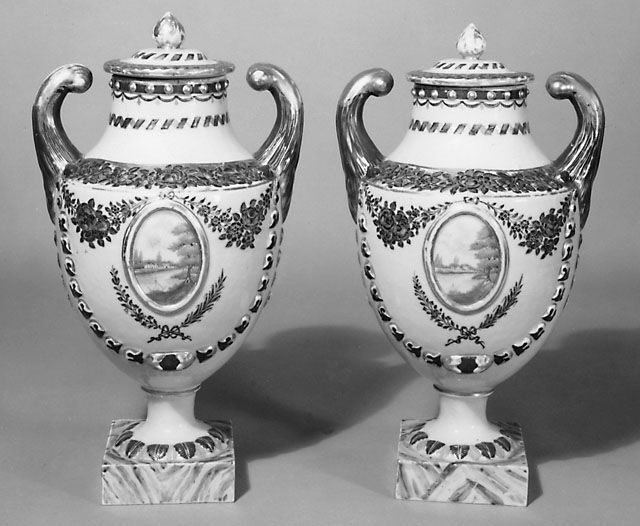 |
Late 18th century |
Unknown |
Chinese |
Porcelain |
14 7/8" H |
|
Purchase, 1976 |
Purchase, Benjamin Ginsburg, 815 Madison Ave., New York, NY 11/30/76 |
0 |
Exhibition: The International C.I.N.O.A Exhibition at The Metropolitan Museum of Art, New York, October 19, 1974 thru January 5, 1975. Illustrated in the catalogue on p. 83, no. 77. |
|
Pair of Chinese export covered urns: with pistol handles and molded festoons of husks in blue enamel and gilding, the oval medallions with river views in gouge de fer, on square bases, marbelized lime, green and blue. After a Marieberg faience original, the bodies molded with festoons of bellflowers heightened in blue enamel and gilding and enclosing oval medallions ( one surrounded with chip) painted with river views in iron red camaieu beneath floral swags and bands, ribbons and beadwork borders in blue and gold. The covers are molded with scale work, and the square bases (one with a shallow chip) are marblized in lime green and blue. |
A pair of urns of this form are in the Helena Woolworth McCann Collection of the Metropolitan Museum of Art, illustrated by Phillips, p.163, p1XVI, no.56 and another example made for the Mayor of New York, illustrated by Mudge p.189, fig. 127. This shape was inspired originally by a Scandinavian silver model and was exported successfully to Portugal from 1775 onwards, and later to the United States. This pair of urns was almost certainly made for the American market. |
Ceramics |
0 |
| TRUE |
Clarinet |
 |
Late 18th century |
Unknown |
American |
Ivory and brass |
|
Marked Prentiss, Court St. Boston. |
Purchase, 1963 |
Purchase, William C. Kennedy 2/14/63 |
0 |
|
|
Ivory and brass mounted clarinet: in fitted wooden case. |
|
Musical Instruments |
0 |
| TRUE |
Pair of candlesticks |
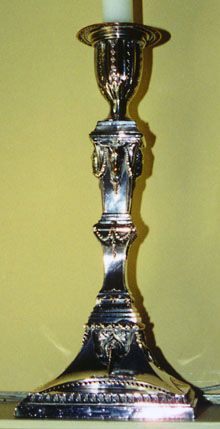 |
1770-1790 |
Unknown |
English |
Silver plate on copper |
11 1/2" H |
|
Purchase, 1961 |
Purchase, John Conover, Ossining, NY 5/19/61 [INVOICE CITED IS THE SAME AS IL 61.8] |
0 |
Wenham, Edward. Old Sheffield plate. Bell and Sons 1955, explains the process of making Sheffield plate and contains drawings of similar candlesticks on page 27. Rowe, Robert. Adam Silver. Taplinger, '65, similar candlesticks illustrated on pages 58 and 59. |
|
Candlesticks: one pair Sheffield plate Adam style with ram's heads and swags. |
LOCATION UPDATE: OBJECTS MOVED TO REAR DRAWING ROOM AS OF MARCH 2007 |
Lighting |
0 |
| TRUE |
Pair of Argand lamps |
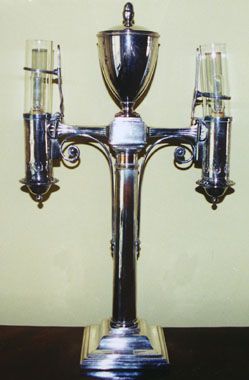 |
1785-1800 |
Probably Matthew Boulton, Soho Factory |
England, probably Birmingham |
Silver plate on copper, glass |
22" H |
|
Purchase, 1972 |
Purchase, Shepard Hyde 1/26/72 |
0 |
Thwing, Leroy. Flickering Flames. Charles E. Tuttle '67, chapter on Argand Lamps pp.71-74. Darbee, Herbert C. Glossery of Old Lamps. Old Sturbridge Village: Technical Leaflet # 30. Wolfe, John J. Brandy, Balloons & Lamps; Ami Argand, 1750-1803. |
|
Pair of fused silver Argand type lamps with square stepped base, plain column supporting branched lights, with an urn fluid reservoir above. A scrolled wire runs along the underside of each arm. Burners are columnar with cylindrical colorless glass chimmneys. Now electrified. |
Argand, a Swiss chemist, inventor of first lamp based on scientific principles, and of the lamp chimney. Employed tubular wick, double current of air, inside and outside the wick, resulting in improved combustion of fuel, unprecedented brilliance. Made first model in France, 1782. English patent 1784. From Glossary of Old Lamps, by Herbert C. Darbee, Curator of Mechanical Arts, Old Sturbridge Village. Technical Leaflet # 30. |
Lighting |
0 |
| TRUE |
Secretary bookcase |
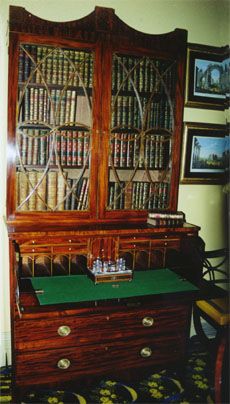 |
1800-1815 |
unknown |
New York City |
Mahogany, light and dark wood stringing; tulip poplar, white pine, maple, red gum[?] |
92 x 46 x 21 6/7" |
"H.J" stamped into back of brass bails. |
Exchange, 1981 |
Acquired by exchange in August 1981 with The Kaufman Americana Foundation, One Bank St., Norfolk, VA. |
0 |
|
|
The secretary bookcase is made in three sections. A lift-off cornice rests atop a bookcase section that sits on a lower case with secretary or writing drawer. The cornice has a central panel with inlaid arch, flanked by downward-curved veneered panels that join corner plinths. The bookcase section has glazed doors with oval mullions decorated with stringing and rosettes inlaid in the center. The three shelves inside are adjustable. The lower section has three long drawers below a secretary drawer with hinged front that opens to a writing surface, covered in green baize, in front of a fitted desk interior having 4 arched pigeon holes below two tiers of shallow drawers flanking a central prospect door. The case drawer fronts are veneered with string inlay borders and inset quarter-round corners. The case piece stands on French feet joined by a serpentine skirt with a central hollow set off by cusps at each side. The stamped oval brasses are decorated with flowers and have bails stamped with "HJ". |
PZ note 10/2/2007 "Allison was a prolific maker who worked in many different styles and tastes. The Allison associations with this kind of furniture are broad-based but not (in my opinion) supported by any solid research or evidence." Although there is no paperwork on the transaction, other records indicate that this secretary bookcase was exchanged with the Kaufman Americana Foundation for a Philadelphia desk and bookcase (accession # G 59), originally in the Boscobel collection and illustrated as no. 88 in J. Michael Flanigan, American Furniture from the Kaufman Collection (Washington, D.C.: National Gallery of Art, 1986).. Appraisals of the pieces are in the Kaufman Americana vendor file and in the curatorial file. |
Furniture |
0 |
| TRUE |
Wall Bracket |
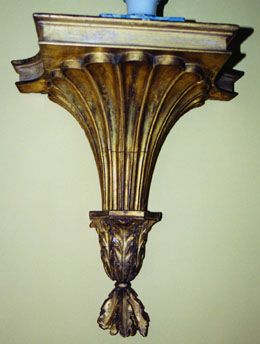 |
c. 1800 |
Unknown |
English |
Gilded wood |
16 x 11 1/2" |
|
Purchase, 1960 |
Purchase, William C. Kennedy 8/20/60 |
0 |
|
|
Pair of carved and gilded wood wall brackets: with shaped top above petal molded pendant acanthus leafage. |
Original catalogue card states "Original maker's name on back". |
Household Items |
0 |
| TRUE |
Andirons |
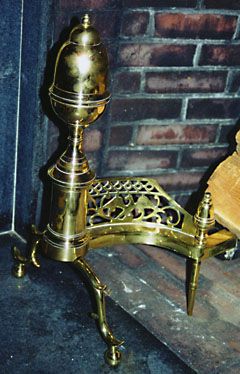 |
c. 1800 |
John Bailey (Fishkill and New York, NY) |
American |
Brass |
22 x 13 1/2" |
The name Bailey is branded in the back of each cylindrical column. |
Purchase, 1976 |
Purchase, F. Bealy, Essex, CT 10/2/76 |
0 |
|
|
Pair of brass acorn-top andirons: each having a short cylindrical pedestal, crested with a large acorn finial on spurred arched supports, the incurvate return having a pierced gallery with American eagle motifs and a smaller acorn finial at the rear. |
John Bailey of Fishkill and New York City was a silversmith as well as a brazier. He produced and signed the sword carried by George Washington during the Revolution. John Bailey is listed in N.Y.C. directories as Cutler and Brass founder from 1789 to 1806 on Maiden Lane. In the Boscobel files are two photostats pertaining to John Bailey, as well as a letter from a descendant, giving Bailey's genealogy. The first is a certificate of indenture dated Feb. 22, 1748, in which he is indentured for 8 years and 7 months with a fortnight's time off each year to go to school. This certificate was made under the Reign of George II in the county of York. The second is a photpstat of John Bailey's sign when he was working as a cutler in New York, dated 1790. Also, in the Boscobel files is a letter written to Mrs. Charlotte Berch, a Boscobel hostess, from Adams Bailey, giving the genealogy of the Bailey family to the present time. There is a bill to Mr. Dyckman from " Bob of John Bailey" dated Oct. 5, 1789 for a pair of andirons and a shovel and tongs. |
Household Items |
0 |
| TRUE |
Jamb Hook |
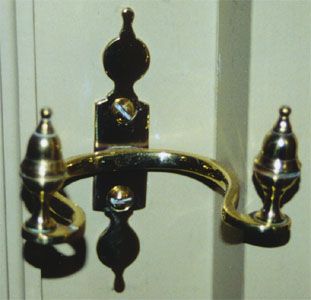 |
c. 1800 |
Unknown |
American |
Brass |
|
|
Purchase, 1976 |
Purchase, F. Bealy, Essex, CT 10/7/76 |
0 |
|
|
Pair of brass jamb hooks: each having an acorn finial at the left and right ends of a semi-circular brass ring affixed to a scrolled brass mounting plate. |
|
Household Items |
0 |
| TRUE |
Lamp |
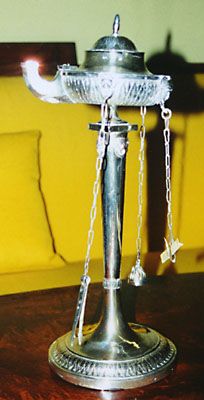 |
1815-1870 |
Unknown |
Italy |
Silver |
14 1/2" H |
Indistinct marks on top of reservoir and on lid. Marked with what appears to be a pair of scissors above a shield. UPDATE:SEE NOTES SECTION |
Purchase, 1961 |
Purchase, William C. Kennedy 6/6/61 [NOT LISTED ON INVOICE] |
0 |
|
|
Silver Roman lamp: "Lucerna" tapering standard with lion mask mock ring handles and crested with a foliated 'Roman' lamp with dependant chains and accoutrements. Previously identified as English silver, but hallmarks are incorrect. |
Hallmarks on the reservoir and lid were previously identified as English. Recent study suggests this lucerna was made in Italy. The hallmark is identified as an Italian Papal State hallmark - a shield with a mitre and a pair of crossed keys. This hallmark was in use in Italy from 1815 to 1870. |
Lighting |
0 |
| TRUE |
Inkwell |
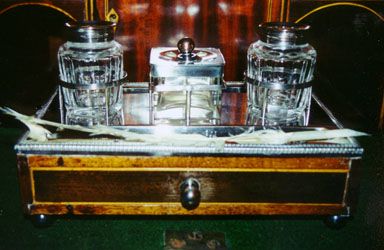 |
c. 1800 |
Unknown |
English |
Mahogany and sheffield plate and glass |
6 1/2 x 9 1/4 x 6 1/8" |
|
Purchase, 1961 |
Purchase, David Stockwell, Inc. Wilmington, DE. No date documented |
0 |
|
|
Sheffield plate and inlaid mahogany ink stand: oblong, with drawer for sealing wax and fitted with glass ink pot, quill pen holder and pounce pot on ball feet. |
|
Household Items |
0 |
| TRUE |
Spoon |
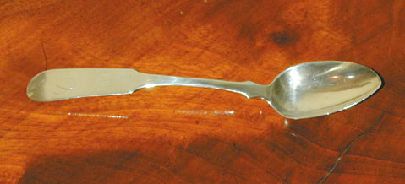 |
c. 1800 |
Unknown |
Boston, Mass. |
Silver |
|
Cypher, illegible |
Gift of Mr.and Mrs. Fred D. Thompson, 1962 |
Gift of Mr. and Mrs. Fred D.Thompson, 1962 |
0 |
|
|
Two fiddleback silver teaspoons: light gauge with engraved cypher (illegible) |
|
Silver |
0 |
| TRUE |
Curtain Tiebacks |
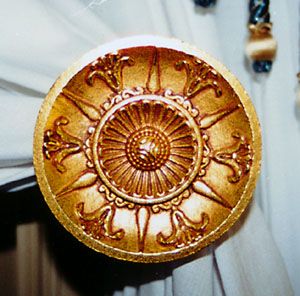 |
c. 1996 |
Unknown |
French |
Brass |
4" Dia. |
|
Purchase, 1996 |
Purchase, Marmelstein, Philadelphia, PA 1996 |
0 |
|
|
Curtain Tiebacks: brass reproductions. Made to emulate c. 1820 originals. |
These tiebacks were used in the front and rear drawing rooms from 1996 to 1999. |
Window Treatments |
0 |
| TRUE |
Tea Measure or standing salt |
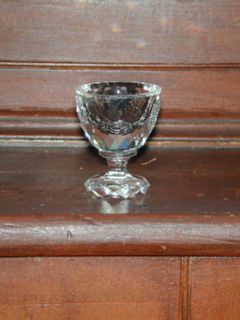 |
1800-1825 |
Unknown |
Northern Europe |
Nonlead glass |
2 3/8" H |
|
Gift of Mr. and Mrs. Fred D. Thompson |
Purchased from the Dyckman heirs. Gift of Mr. And Mrs. Fred D. Thompson 1961 |
0 |
|
|
Oval, facet-cut body above a facet-cut stem and facet-cut round foot. NOTE: This may be better described as an egg cup. |
|
Glass |
0 |
| TRUE |
Bookplate |
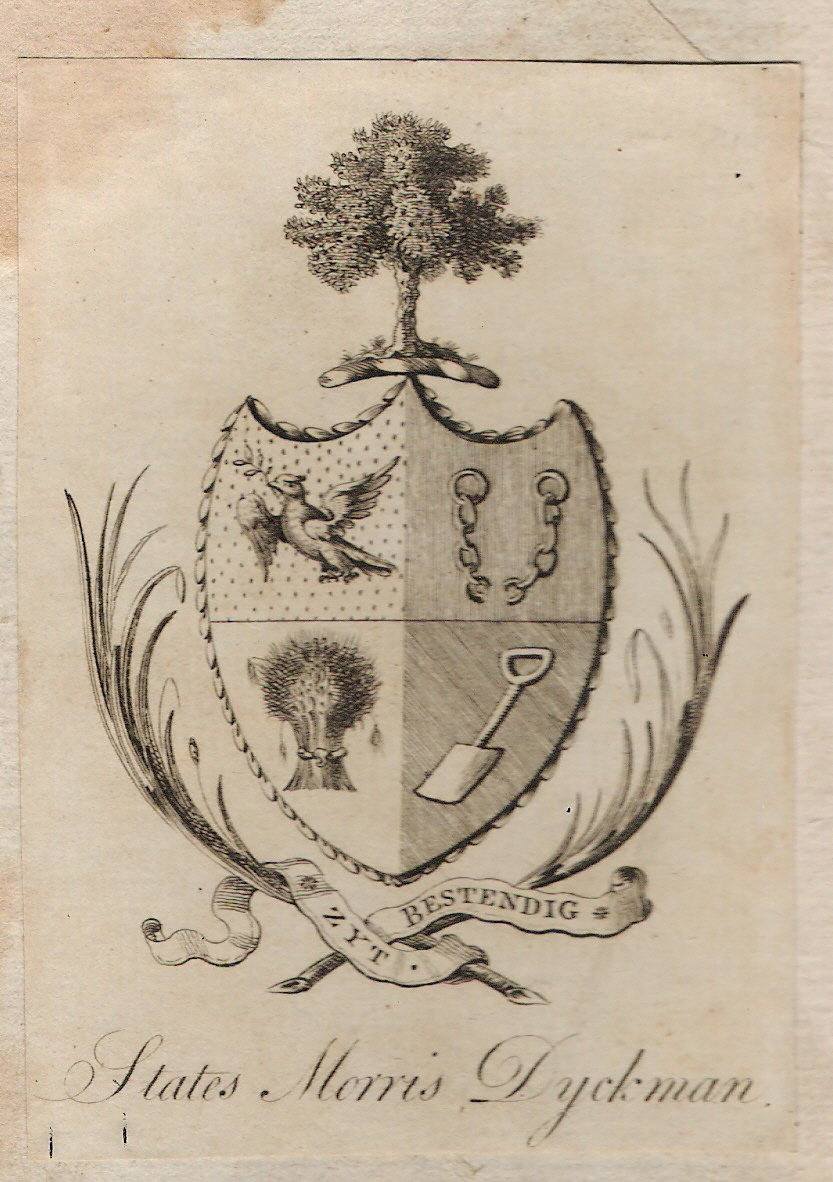 |
c. 1800 |
Unknown |
United States |
Ink on paper |
3 5/8 x 2 5/8 |
|
Gift of Mrs. Richard Dyckman, 1961 |
Gift of Mrs. Richard Dyckman, 1961 |
0 |
|
|
Bookplate of Dyckman coat of arms: framed in wooden frame, gold leaf. This bookplate is similar to the one found in Mr. Dyckman's books. Engraved, chain-laid paper. "States Morris Dyckman" across bottom. |
|
Prints/Drawings |
0 |
| TRUE |
Curtain Tiebacks |
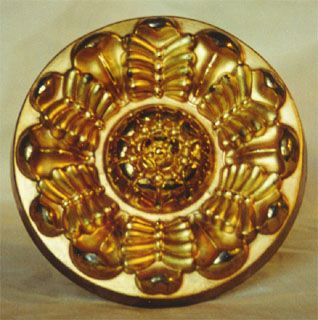 |
Early 19th century |
Unknown |
Probably English |
Gilt Brass, Iron |
4 7/8" diam., 7" total length |
|
Gift of Frederick W. Stanyer, 1999 |
|
0 |
|
|
Set of ten gilt brass curtain tiebacks, circular form with stamped rosette pattern, in matte and shiny finish. |
Four of these tiebacks are in the Front Drawing Room, two in the Rear Drawing Room, four in the Dining Room. |
Window Treatments |
0 |
| TRUE |
Hall lamp |
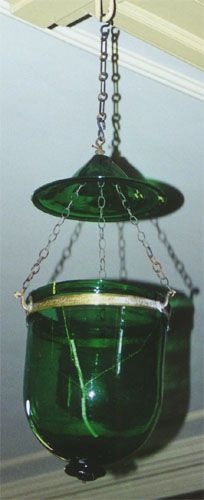 |
1800-1825 |
Unknown |
England |
Glass, brass |
21 1/2 x 10 1/2" |
|
Purchase, 1977 |
Purchase, Marvin Alexander New York, NY 5/13/77 |
0 |
|
|
Hall lamp with smoke glass, green. |
|
Lighting |
0 |
| TRUE |
Candlestick or chamberstick |
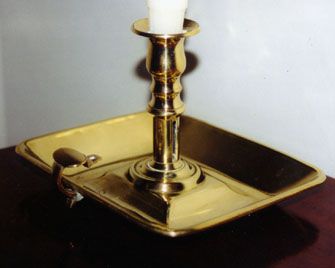 |
1810-1835 or possibly later |
Unknown |
England |
Brass |
7" |
|
Purchase, 1961 |
Purchase, William C. Kennedy 1/15/61 |
0 |
|
|
The chamberstick or candlestick has a cylindrical shaft that encloses an ejector (now missing) below a double-reel element that supports a candle socket and flared bobeche. The shaft is threaded into an iron washer on the underside of a rectangular drip pan with canted sides and a handle/thumbpiece on one long side. |
|
Lighting |
0 |
| TRUE |
Set of four candlesticks |
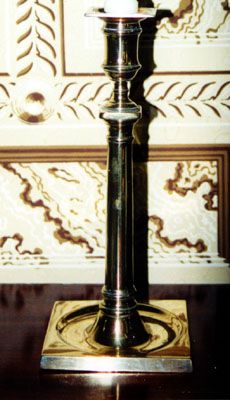 |
1755-1780 |
Unknown |
England |
Brass |
11" H |
|
Purchase, 1965 |
Purchase, William C. Kennedy 5/10/65 |
0 |
|
|
Candlesticks have long, slender columnar shafts and stand within a circular recess in square base. The column ends at the top in a square platform that supports a narrow turned element and a cylindrical candle socket and flared bobeche. Are these bell metal??? |
|
Lighting |
0 |
| TRUE |
Box |
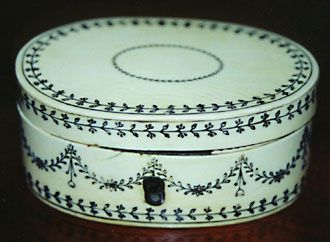 |
c. 1800 |
Unknown |
England |
Ivory and wood |
3 7/8 x 2 7/8" |
|
Purchase, 1962 |
Purchase, William C. Kennedy 1962 |
0 |
|
|
Oval ivory box: lined with pear wood, hinged cove, engraved with borders and swags. |
|
Decorative Objects |
0 |
| TRUE |
Box |
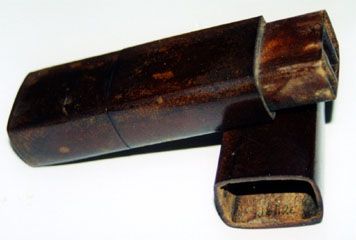 |
18th century |
Unknown |
English |
Wood |
6 1/8 x 1 1/2" |
|
Gift of Mr. and Mrs. Fred D Thompson, 1961 |
Gift of Mr. and Mrs. Fred D. Thompson 5/13/61 Purchased from Dyckman heirs by John Conover, Ossining, NY 1961 |
0 |
|
|
Three piece wooden case for quill pen and ink: used for traveling. |
|
Household Items |
0 |
| TRUE |
Dinner Service |
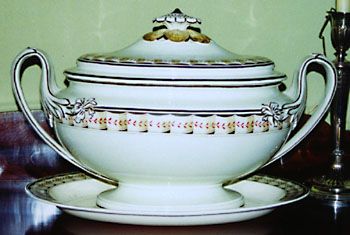 |
c. 1790 |
Josiah Wedgwood |
English |
Porcelain |
11 1/2 x 18 1/2 x 12" |
Incised: WEDGWOOD |
Purchase, 1993 |
Purchase, L. Doyle Ross, Glenham, NY 12/93 |
0 |
|
|
Soup Tureen: Wedgwood's Queensware in lag and feather pattern decorated in sepia and red. Cover has an artichoke finial. |
This tureen matches pieces of Queensware on loan from the Department of Parks, City of New York's Dyckman collection ( C 66.6 ) The only difference being the color of the feather design; the feather on the original Dyckman pieces is gold, instead of red as on the tureen. |
Ceramics |
0 |
| TRUE |
Serving Dish |
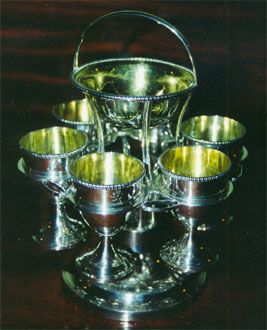 |
c. 1800 |
Unknown |
English |
Silver |
8 1/2" H |
Maker's mark: I.L Lion facing left-King facing right. |
Gift of Mrs. Lila Acheson Wallace, 1962 |
Gift of Mrs. Lila Acheson Wallace, 1962 |
0 |
|
|
George III silver egg cruet: the stand with a skeletal framework crested with a small gadrooned bowl, the framework containing six matching egg cups, each engraved on the side with a lion rampant, lined with gold wash. |
|
Silver |
0 |
| TRUE |
Flatware |
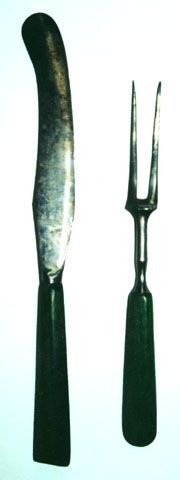 |
1840-1900 |
Unknown |
England |
Steel, bone |
|
Marked "V [crown] R / SHEARSTEEL" on blade of 8 knives |
Purchase, 1977 |
Purchase, Israel Sack, Inc. New York, NY 7/7/77 with knife boxes. |
0 |
|
|
Green handled knives and forks: in knifeboxes, consisting of 24 knives and 22 forks with green dyed bone handles. |
|
Silver |
0 |
| TRUE |
Wine Coaster |
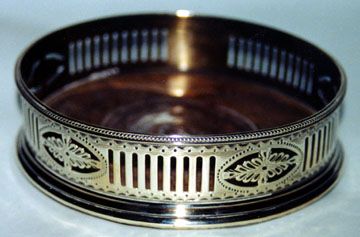 |
Late 18th century |
Robert Hennell, London |
London |
Silver, wood |
1 1/4 x 4 3/4" D. |
|
Gift of Mrs. Lila Acheson Wallace, 1962 |
Maker, Robert Hennell, London Gift of Mrs. Lila Acheson Wallace, 1962 |
0 |
Wenham, Edward. Old Sheffield Plate, G. Bell and Son's Ltd. 1955, describes origin of wine coasters. |
|
Pair of George III silver wine coasters or "slides": with pierced gallery, wooden base. Design includes cypher JMH, rosettes and beading. There are remnants of old tan baize on the bottom. |
2/26/2003 One of the pair is on view in Mrs. Dyckman's Room. |
Silver |
0 |
| TRUE |
Flatware, set of four forks |
 |
1802-1804 |
Unknown |
London, England |
Silver |
8" L |
Four London hallmarks on underside of handle. "G" and "H" date letters for 1802/3 and 1803/4. Three of the forks are marked RC, previously identified as Richard Cooke. One is marked "WE/WF" in a square for William Eley & William Fearn. |
Gift of Mr. and Mrs. Fred D. Thompson, 1961 |
Purchased, from Dyckman heirs by John Connover of Ossining, NY 1961 Gift of Mr.and Mrs. Fred D. Thompson 1961 |
0 |
|
|
Four silver forks with four tines and fiddle-shaped handles and notched shoulders at the base of the handle. "ECD" cypher engraved on the underside of the top of the handle. |
|
Silver |
0 |
| TRUE |
Wine Taster |
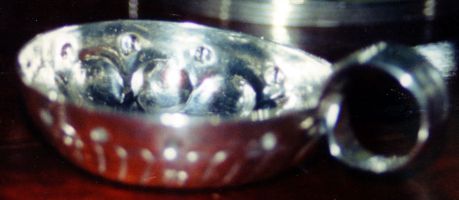 |
Early 19th century |
Unknown |
French |
Silver |
3 3/4 x 3/4" |
Engraved on side "J.B. Lemoine" |
Purchase, 1961 |
Purchase, John Conover, Ossining, NY 1/15/61 |
0 |
|
|
French repousse silver wine taster: with loop handle and repousse circular bosses and gadroons. |
|
Silver |
0 |
| TRUE |
Flatware |
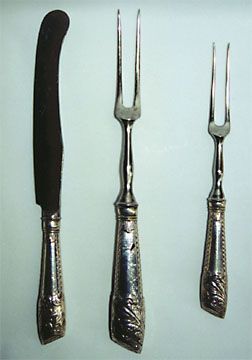 |
18th century |
Unknown |
England or Holland |
Silver, steel |
See description |
|
Gift of Mr. and Mrs. Fred D. Thompson, 1961 |
Purchased, by John Conover of Ossining, NY from Dyckman descendents Gift of Mr. and Mrs. Fred D. Thompson, 1961 |
0 |
|
In the Victoria and Albert Museum there are knives and forks like these bearing the hall mark Sheffield, 1779-80. A copy of a photograph of these is in our files. |
Set of silver knives and forks: with handles of thinly stamped silver filled with a resinous substance in a feather design, consisting of: 12 large 2 tined forks, L. 8". 10 small forks, 2 tined L. 6 1/2" 12 large knives, L. 10 3/4" 11 small knives, l.8 1/4" ( one has a damaged handle) |
Location update: There are 6 knives and 6 forks displayed on a tray in the Butler's Pantry as of March 2007 As of 2006, all pieces located in top drawer of sideboard (F 70.1) in dining room. |
Silver |
0 |
| TRUE |
Pair of sauce boats |
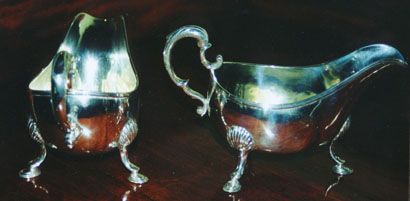 |
1784 |
Possibly Will Beates or Will Bond |
Irish |
Silver |
4 1/4 x 7 3/4" |
Makers mark: " W B " in script. |
Purchase, 1961 |
Purchase, William C. Kennedy 1/15/61 |
0 |
|
|
Pair of George III Irish silver sauce boats: each with reverse scroll handles and having three shell and hoof feet. |
Maker Will Beates, Dublin, or possibly Will Bond, Dublin. Needs further research. |
Silver |
0 |
| TRUE |
Sugar Bowl |
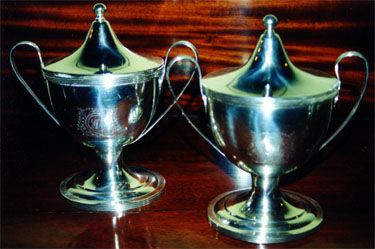 |
1814 |
Unknown |
English |
Silver |
7 3/4 x 7 7/8" |
Hall marks consist of a lion facing left, a crowned head, and crowned head or armored head facing right. Marks are laquered? There are no makers marks. |
Purchase, 1961 |
Purchase, William C. Kennedy 1/15/61 |
0 |
|
|
Pair of George III silver covered two- handled sugar urns: each having reeded rims and upright loop handles, the domed cover with a ball finial, engraved and monogrammed escutcheons and scrolled swags. |
|
Silver |
0 |
| TRUE |
Pair of knife boxes |
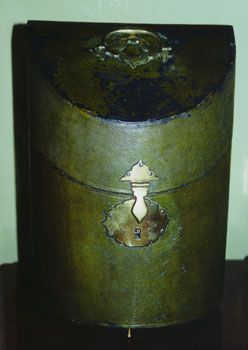 |
c. 1800 |
Unknown |
English |
shagreen, wood |
10 7/8 x 8 3/4" |
|
Purchase, 1977 |
Purchase, Israel Sack, Inc. New York, NY 7/7/77 |
0 |
|
|
Pair of George III shagreen knife boxes: demi-lune design with brass handles and escutcheons. Contain 48 green tinted bone handled fruit knives and forks. |
|
Household Items |
0 |
| TRUE |
Pair of standing salts |
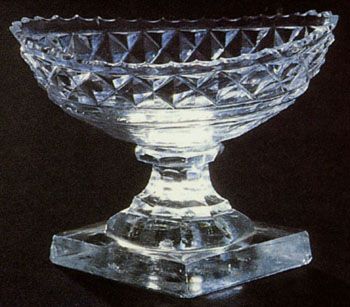 |
1790-1810 |
Unknown |
England or Ireland |
glass |
3 x 2" D. |
|
Gift of Mr. and Mrs. Fred D. Thompson, 1961 |
Purchased, from John Conover, Ossining, NY 1961 Gift of Mr. and Mrs. Fred D. Thompson 5/13/61 |
0 |
|
|
Pair of standing salts with scalloped rim above a cut diamond band, facet-cut stem above a diamond or lozenge shaped foot. NEED TO CONFIRM ACCESSION NUMBER |
Believed to be of Boscobel origin, possibly from John Blades, London. |
Glass |
100 |
| TRUE |
Snuffer |
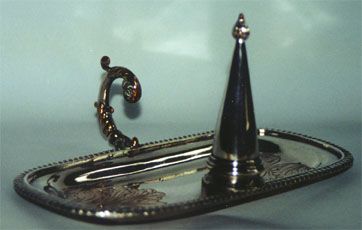 |
Early 19th century |
Unknown |
English |
Silver and steel |
|
|
Gift of Mrs. Kitchell Borman, 1962 |
Gift of Mrs. Kitchell Borman in memory of Alice Dyckman, 1962 |
0 |
|
|
Sheffield plate chased snuffer tray and doubter (original doubter gone). |
|
Silver |
0 |
| TRUE |
Pair of candlesticks |
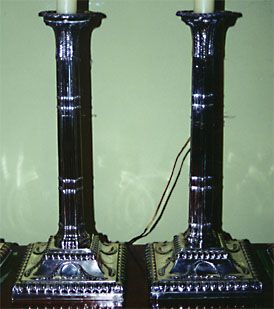 |
1790-1800 |
Unknown |
England |
Silver |
12 1/2" H |
"Rob / erts", "&", "Sla / ter", and "MP" pseudo-hallmarks stamped along base. |
Purchase, 1961 |
Purchase, William C. Kennedy 1/15/61 |
0 |
|
|
Silver candlesticks: One pair in the Adam style, with reeded columnar standard and square base. |
Old catalogue records identify the maker as Michael Plummer of London and the date as 1794/5. This information is unconfirmed. |
Lighting |
0 |
| TRUE |
Pair of candlesticks |
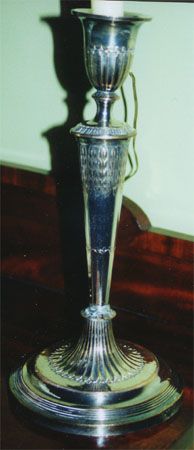 |
1790-1800 |
Unknown |
England |
Silver plate on copper |
12" H |
|
Purchase, 1961 |
Purchase, William C. Kennedy 1/15/61 |
0 |
|
|
Sheffield plate candlesticks: one pair with foliated tapering standard and fluted circular base. Appears to be based on French neoclassical designs |
|
Lighting |
0 |
| TRUE |
Pair of candlesticks |
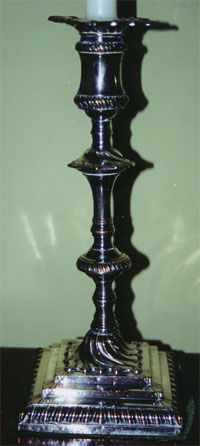 |
1770-1790 |
Unknown |
England |
Silver plate on copper |
11" H |
|
Purchase, 1961 |
Purchase, John Conover, Ossining, NY 5/19/61 [INVOICE CITED IS THE SAME AS IL 61.5] |
0 |
Wenham, Edward. Old Sheffield Plate G. Bell and Sons, Ltd 1955 pp. 11-22, shows drawings of similar candlesticks. Wills, Geoffrey. Candlesticks. Clarkson N. Potter Inc, N.Y 1974 Ill. P.70. |
|
Sheffield plate candlesticks: one pair, gadrooned and knopped standard, square base. Removable bobeches. |
|
Lighting |
0 |
| TRUE |
Pair of Argand lamps |
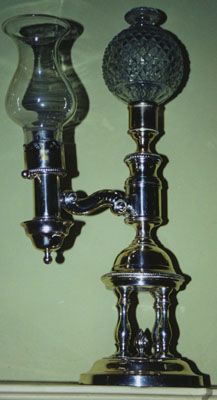 |
1800-1830 |
Unknown |
England |
Silver plate on white metal, glass |
18" H |
|
Purchase, 1960 |
Original possession of the Newbold Post family, N.Y Purchase, Ginsberg & Levy, New York, NY 12/20/60 [SAME INVOICE CITED FOR IL 61.6] |
0 |
Thwing, Leroy. Flickering Flames: Tuttle '67. chapter on Argand lamps-p.71-74 ill. Barbara Bielenberg, "Neo-Classical Lighting Devices at Boscobel," Rushlight 49, no. 4 (December 1983) |
|
Argand type lamps: one pair Sheffield plate and cut glass with diamond cut spherical font above a lamp arm and temple form base with urn shaped chimney. Very similar to IL 61.6 a,b |
|
Lighting |
0 |
| TRUE |
Pair of Argand lamps |
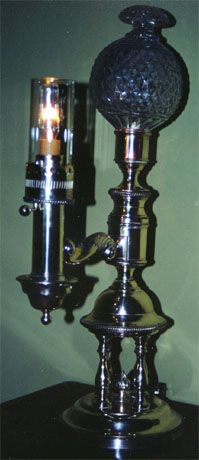 |
1800-1830 |
Unknown |
England |
Silver plate on white metal, glass |
18" H |
|
Purchase, 1961 |
Made for the Newbold Post family, of NY Purchase, Ginsberg & Levy, New York, NY 12/20/60 [SAME INVOICE CITED FOR IL 61.7] |
0 |
Thwing, Leroy. Flickering Flames: Tuttle '67. chapter on argand lamps, ill. P.71-74. |
|
Argand type lamps: one pair, sheffield plate and cut glass with diamond cut, spherical font above a lamp arm and temple form base with straight sided chimney. Glass fonts are original. Located on sideboard (F 76.14). Electrified Very similar to IL 61.7 |
|
Lighting |
0 |
| TRUE |
Pair of compotes |
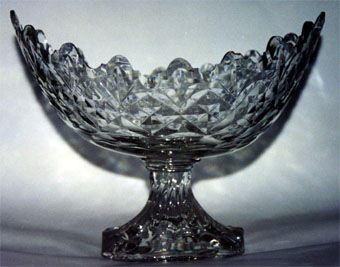 |
1790-1810 |
Unknown |
England or Ireland |
Glass |
7 1/2" H |
|
Purchase, 1960 |
Purchase, from the estate of Mrs. Edward H. Heller, Atherton, CA 2/27/60, through Parke-Bernet |
0 |
Complete Encyclopedia of Antiques, By Connoisseur, Hawthorn, 1962, Plate 175, p.495. |
|
Pair of George III Irish cut glass fruit compotes: shuttle shaped, with valanced rim and diamente- cut border on oval fluted base. Trefoil edge or "Van Dyke" cut rim. Base is pressed into a full size mold imparting the oval shape with reeded top. Bowl of compote is blown and cut. |
|
Glass |
0 |
| TRUE |
Andirons |
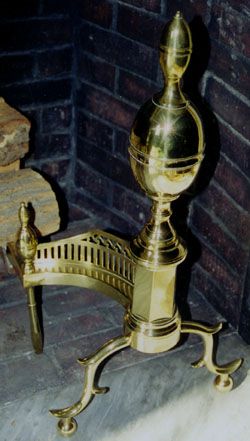 |
c. 1800 |
Richard Whittingham |
American |
Brass |
25 1/2" H |
|
Purchase, 1976 |
Maker, Richard Wittingham, New York, NY c. 1800 Purchase, F. Bealy, Essex, CT 9/28/76 |
0 |
|
Berry Tracy Collection, Sold Feb. 1, 1985 for $2,860 Sotheby's Auction |
Pair of brass double lemon-top andirons: each with hexagonal standard and large lemon finial with beaded median banding and small secondary finials, the mock fluted returns also with small lemon finials; on spurred arch supports, and ball feet. |
|
Household Items |
0 |
| TRUE |
Fender |
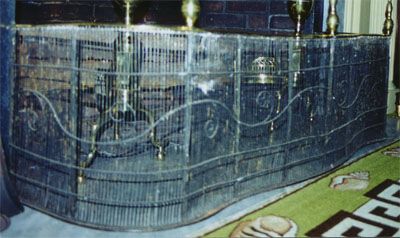 |
1800-10 |
Unknown |
New York |
Brass and wire |
19 1/4 x 50" |
|
Purchase, 1976 |
Purchase, Israel Sack, New York, NY 11/29/76 |
0 |
|
|
Brass and wirework serpentine fender: serpentine wire body with scrolled decoration; conforming shaped brass upper trim containing three double lemon top finials. |
|
Household Items |
0 |
| TRUE |
Pair of decanters |
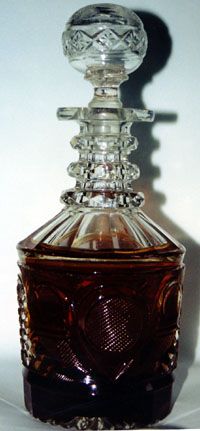 |
1820-1840 |
Unknown |
probably England |
lead glass |
10 3/4 x 3 1/2" |
|
Purchase, 1961 |
Purchase, 1961 |
0 |
|
|
Pair of blown, mallet-shaped decanters with stoppers. The necks have three rings. Decanters are cut with waffle panels and peacock eye devices. The hollow bulbous and cut stoppers do not appear to be correct for these decanters. "a" is in the Butler's Pantry "b" is in the Rear Drawing Room |
Stoppers are replacements and are not original to the decanters. |
Glass |
0 |
| TRUE |
Screen |
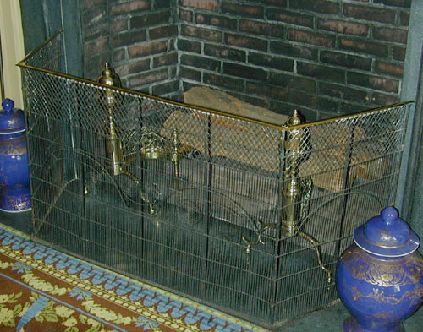 |
c. 1800 |
Unknown |
American |
Wire and brass |
24" H |
|
Purchase, 1961 |
Purchase, William C. Kennedy 6/10/61 |
0 |
|
|
Brass and wirework folding spark screen: with wirework trellis sides and brass rail. |
|
Household Items |
0 |
| TRUE |
Shovel and tong |
 |
c. 1800 |
Richard Whittingham |
American |
Brass and steel |
Tongs: L. 36", Shovel: L. 36 1/2" |
"R. WHITTINGHAM" branded on the side of one of the steel tabs of the tongs. |
|
|
0 |
|
|
Brass and steel acorn top shovel and tong. |
See Record ID 578- same item with same accession number has two records in the system as of 2/16/2018 [kc] |
Household Items |
0 |
| TRUE |
Pair of candlesticks |
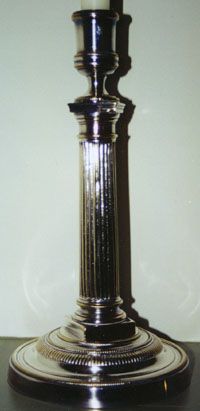 |
c. 1800 |
Unknown |
England or possibly Northern Europe |
Silver plate on brass |
11" H |
|
Purchase, 1961 |
Purchase, William C. Kennedy 6/5/61 |
0 |
|
|
The candlesticks have fluted columnar shafts with a candle socket above a reel on top. The shaft ends in a square plinth that screws into a circular stepped base outlined in gadrooning. |
|
Lighting |
0 |
| TRUE |
Bottle |
 |
1750-1800 |
Unknown |
Probably Northern Europe |
Glass |
12" |
|
Purchase, 1961 |
Purchase, William C. Kennedy 6/5/61 |
0 |
|
|
Six enameled olive-green "common glass" bottles, each spherical with long necks and applied lips and painted with bow-knotted labels as follows; Gember, Anisette, Jamaica, Cardimon, Genever and Chocolade. |
|
Glass |
0 |
| TRUE |
Syllabub |
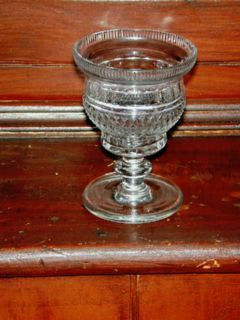 |
1825-1850 |
Unknown |
England or Ireland |
lead glass |
4 5/8 x 3 1/4" |
|
Purchase, 1960 |
Purchase, Parke Bernet Galleries, from the estate of Mrs. Edward H. Heller, Atherton, CA 5/27/60 |
0 |
|
|
Tulip-shaped bowl with decoratively cut rim and facet-cut body on stem with disk in the center on a round foot with polished pontil. |
|
Glass |
0 |
| TRUE |
Salver |
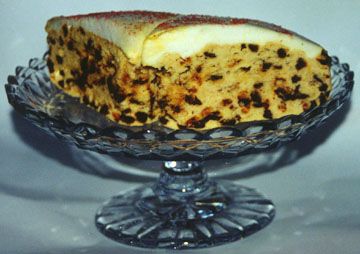 |
1785-1810 |
Unknown |
England or Ireland |
lead glass |
4 x 8 3/4" |
|
Gift of Mr. and Mrs. Fred D. Thompson, 1961 |
Possibly Boscobel origin Purchased from John Conover, Ossining, NY Gift of Mr. and Mrs. Fred D. Thompson 5/13/61 |
0 |
|
|
The cut glass salver (called a cake stand in earlier Boscobel records) is a plain disk with a raised scalloped edge above a diamond-cut band, set on a plain tapered stem above an oval, star-cut foot. |
LOCATION UPDATE: MOVED TO DINING ROOM AS OF MARCH 2007 |
Glass |
0 |
| TRUE |
Set of Five Syllabubs |
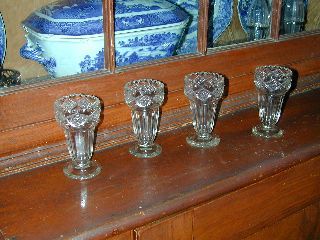 |
c. 1800 |
Unknown |
English or Irish |
Glass |
4 1/2 x 2 5/8" |
|
Gift of Mr. and Mrs. Fred D. Thompson, 1961 |
Boscobel Origin Purchased from John Conover, Ossining, NY Gift of Mr. and Mrs. Fred D. Thompson 5/13/61 |
0 |
Hughs, G. Bernard. English, Scottish and Irish Table Glass: Balding and Mansell Ltd. Pp.295-96. |
|
George III cut glass syllabubs: panel cut with waffle cut diamonds in borders. |
|
Glass |
0 |
| TRUE |
Set of six tumblers |
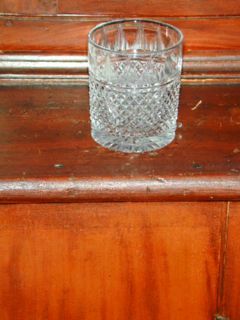 |
1800-1825 |
Unknown |
England |
lead glass |
3 3/8 x 3" |
|
Gift from Mr. and Mrs. Fred D. Thompson, 1961 |
Purchased from Dyckman heirs by John Conover, Ossining, NY Gift of Mr. and Mrs. Fred D. Thompson 5/13/61 |
0 |
|
|
Set of six cut glass tumblers. Diamond-cut body Star or ray cut bottom [CHECK] |
|
Glass |
0 |
| TRUE |
Bottle |
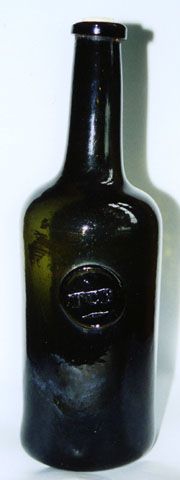 |
c. 1800 |
Unknown |
American |
Glass |
See description |
|
Purchase, 1961 |
Purchase, William C. Kennedy 6/5/61 |
0 |
|
|
Three green spirit bottles: with applied monogrammed seal. A: Ht. 10 1/2" x D. 5" B: Ht. 11" x D. 3 1/2" C: Ht. 11 3/4" x D. 3 3/4" |
Glass bottle "B" is on display on the sideboard. |
Glass |
0 |
| TRUE |
Pair of standing salts |
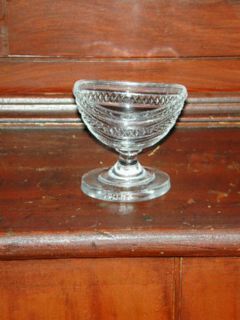 |
1790-1820 |
Unknown |
England or Ireland |
lead glass |
3 1/4 x 3 1/4" |
|
Gift of Mrs. Lila Acheson Wallace, 1961 |
Gift of Mrs. Lila Acheson Wallace, 1961 |
0 |
|
|
Pair of cut- glass footed crescent salts with diamond cut band, plain edge and oval base or foot. Pair of standing salts with oval foot having a polished pontil. The crescent-shaped, oval bowl has a band of cut diamonds near the top and stepped cutting on the underside of the body. |
|
Glass |
0 |
| TRUE |
Tumbler |
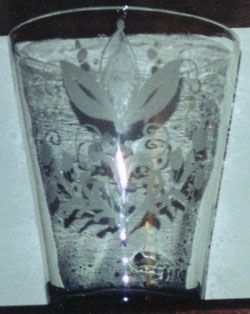 |
1780-1820 |
Unknown |
Northern Europe, probably Bohemia |
nonlead glass |
6 x 4 3/4" (dia) |
|
Purchase, 1966 |
Purchase, 1966 ? |
0 |
|
|
Large, tapered tumbler (popularly called a flip glass) with engraved stylized tulip and leaf sprays. The pontil mark on the underside is partially ground off. |
There is no further information on when and where this item was originally brought into the collection. 7/99 |
Glass |
0 |
| TRUE |
Set of Six Syllabubs |
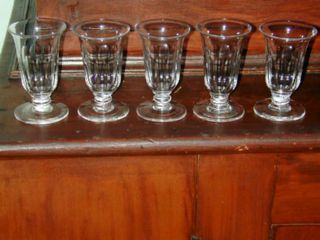 |
c. 1850 |
Unknown |
England |
Glass |
4 1/8 x 2 3/8" |
|
Gift of Mr. John Kernan, 1963 |
Gift of Mr. John Kernan, Handen, CT 5/13/63 |
0 |
|
|
Six cut- glass syllabubs: each bell-shaped and panel cut with knopped stem. |
.3 is broken, irrepairably, stored in curatorial office in box since 1986.. This set for possible deaccession. |
Glass |
0 |
| TRUE |
Ewer |
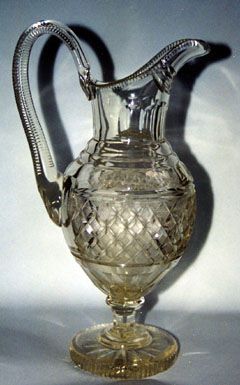 |
1800-1825 |
Unknown |
Northern Europe |
nonlead glass |
10 1/2 x 3 1/2" |
|
Gift of Mr. and Mrs. Fred D. Thompson, 1961 |
Gift of Mr. and Mrs. Fred D. Thompson, 1961 Purchased, from Dyckman and or Cruger heirs by John Conover, Ossining, NY 1961 |
0 |
|
|
Cut glass ewer: urn form with waffle- cut central banding and loop handle. |
|
Glass |
0 |
| TRUE |
Pair of candelabras |
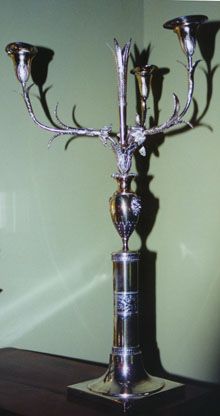 |
1790-1810 |
Unknown |
France |
Silver and some silver plate |
23 1/2" H |
Marks are indistinct. |
Purchase, 1960 |
Purchase, William C. Kennedy 8/20/60 |
0 |
|
|
Silver candelabra: directoire three light cylindrical standard crested with urn supporting a central leaf member and three candle arms, one pair. |
|
Lighting |
0 |
| TRUE |
Linen Press |
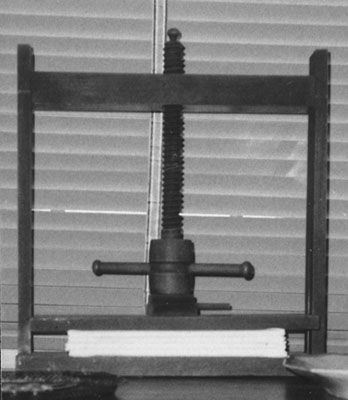 |
Late 18th century |
Unknown |
American? |
Mahogany |
19 x 18 x 8" |
|
Purchase, 1961 |
Purchase, William C. Kennedy 6/10/61 |
0 |
|
|
George III mahogany linen press: with plain frame and turn screw. |
|
Household Items |
0 |
| TRUE |
Glassware |
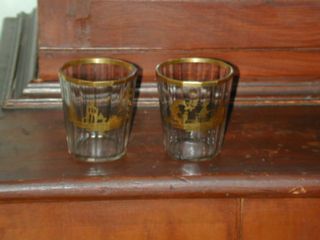 |
1790-1820 |
Unknown |
Northern Europe |
Nonlead glass, gilt decoration |
3 3/16 x 2 3/4" (dia) |
|
Purchase, 1961 |
Purchase, 1961 Files contain no information concerning from whom this piece was purchased. |
0 |
|
|
The pair of gilt-decorated 15-sided cylindrical tumblers has a slight taper toward the bottom. "A" has a gilt rim and a building flanked by trees on the side; "B" has a gilt rim and a figure with buildings on the side. Bottoms are polished. |
|
Glass |
0 |
| TRUE |
Andirons |
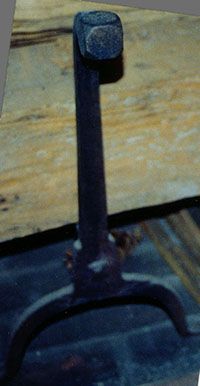 |
18th century |
Unknown |
American |
Iron |
16" H |
|
Purchase, 1961 |
Purchase, Mary Allis 5/29/61 |
0 |
|
|
Pair of iron goose-neck andirons. |
|
Household Items |
0 |
| TRUE |
Kettle |
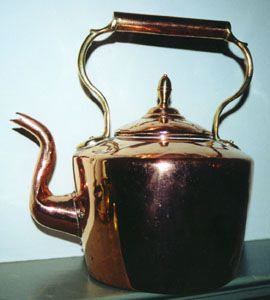 |
Early 19th century |
Unknown |
American |
Copper and brass |
12 1/4" H |
|
Purchase, 1961 |
Purchase, William C. Kennedy 1961 |
0 |
|
|
Copper and brass tea kettle: with brass bail handle, gooseneck spout, top has an acorn finial. |
|
Household Items |
0 |
| TRUE |
Kettle |
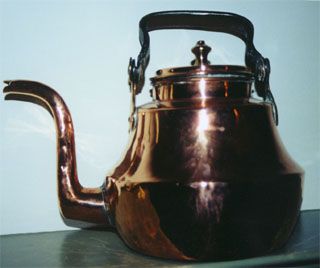 |
Late 18th century |
Unknown |
English |
Copper and wrought iron |
11" H |
|
Purchase, 1961 |
Purchase, 1961 |
0 |
|
|
Copper and wrought-iron tea kettle: urn form with a wrought iron bail handle, the cover with knop finial, the body with a goose- neck spout. |
|
Household Items |
0 |
| TRUE |
Pair of Argand lamps |
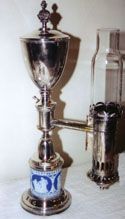 |
1790-1820 |
Matthew Boulton |
England |
Plated silver on copper, jasperware (stoneware), glass |
16" H |
|
Purchase, 1969 |
Purchase, William C. Kennedy 10/15/69 |
0 |
John J. Wolfe, Brandy, Balloons, & Lamps: Ami Argand, 1750-1803, p. 29, fig. 2.6 |
|
Argand type single burner lamp with an urn-shaped oil reservoir surmounted by an acorn finial and having a drum base in blue and white jasperware. The cylindrical burner extends from the body on a cylindrical arm. The lamps appear to be unmarked. The glass globes are replacements. |
|
Lighting |
0 |
| TRUE |
Argand Lamps |
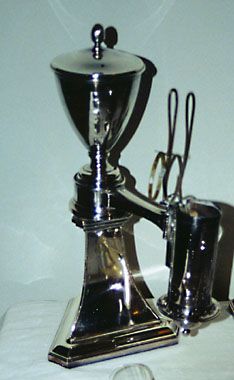 |
1785-1790 |
Probably Matthew Boulton, Soho Factory |
England, probably Birmingham |
Silver plate on copper, glass |
13" H |
|
Purchase, 1972 |
Purchase, Hyde and Shepard, New York, NY 1/26/72 |
0 |
|
|
George III Sheffield plate Argand lamps: one pair, with flaring standard of triangular section, crested with an urn form font, the lateral arm with a cylindrical burner and a glass chimney. |
|
Lighting |
0 |
| TRUE |
Candle box |
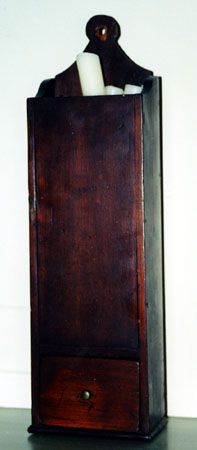 |
1820-50 |
Unknown |
Mid-Atlantic region, probably Pennsylvania |
Tulip poplar, oak |
8 1/2 x 16 x 6" |
|
Purchase, 1961 |
Purchase, William C. Kennedy 3/21/61 |
0 |
|
|
Painted and grained tulip poplar and oak candle box with a drawer in the bottom. The rectangular box has dovetailed sides with miters at the tops. The bottom board is nailed in place. The lid is chamfered on the long sides and one end. Two finger holes are gouged into the opposite end. The lid slides in a channel cut into the box sides and end. Inside, the box is divided into three equal compartments by two thin oak boards slotted into the sides. The box exterior appears to have a salmon-colored ground over which is painted a darker brown in a mahogany grain pattern. |
Revised record on November 28, 2001. |
Household Items |
0 |
| TRUE |
Tray |
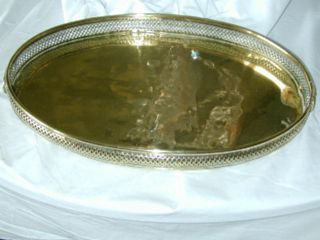 |
c. 1800 |
Unknown |
English |
Brass |
16 1/4" L |
|
Purchase, 1961 |
Purchase, William C. Kennedy 6/5/61 |
0 |
|
|
Regency pierced oval brass tray: with bail handles, pierced gallery and bun feet. |
LOCATION UPDATE; OBJECT MOVED TO FRONT DRAWING ROOM AS OF MARCH 2007 |
Household Items |
0 |
| TRUE |
Sugar Cutter |
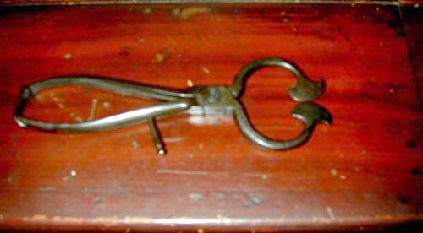 |
Early 19th century |
Unknown |
American |
Steel |
8 1/2" L |
|
Purchase, 1970 |
Purchase, Frederick W. Stanyer 8/26/70 |
0 |
|
|
Steel sugar cutters. |
|
Household Items |
0 |
| TRUE |
Pitcher |
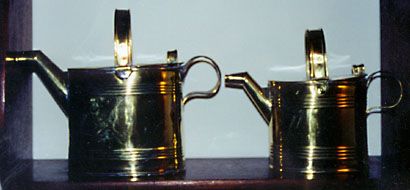 |
Early 19th century |
Unknown |
American |
Brass |
9 x 12" D |
|
Purchase, 1962 |
Purchase, William C. Kennedy 1962 |
0 |
|
|
Brass hot- water can or tankard: a pair, oval shape with loop handle and ribbed sides. |
Two other water cans are dispersed throughout house. |
Household Items |
0 |
| TRUE |
Set of six plates |
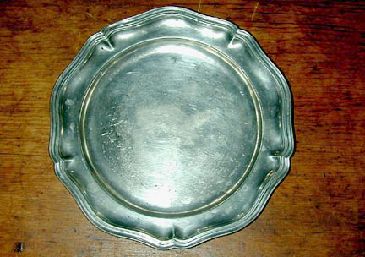 |
1800-1900 |
Unknown |
Europe |
Pewter |
8 3/4" Dia. |
|
Purchase, 1961 |
Purchase, William C. Kennedy 6/10/61 |
0 |
|
|
Set of six baroque scallop-rim plates. |
|
Silver |
0 |
| TRUE |
Plate |
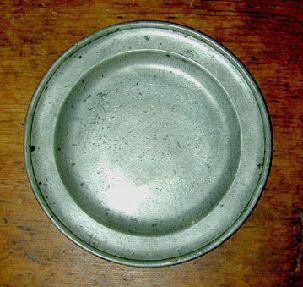 |
c.1780 |
Unknown |
English |
Pewter |
Dia. 9" |
|
Purchase, 1961 |
Purchase, Mary Allis 1961 |
0 |
|
|
Pewter plate: plain reeded edge. Is being used under the sugar cone. |
|
Household Items |
0 |
| TRUE |
Box |
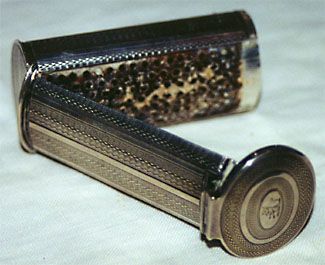 |
1847-48 |
Taylor and Perry, Birmingham |
|
Silver |
2 1/4" H |
Engraved with a boer's head on top. |
Gift of Mr. and Mrs. Fred D. Thompson, 1961 |
Purchased from Dyckman heirs by John Conover, Ossining, NY 1961 Gift of Mr. and Mrs. Fred D. Thompson, |
0 |
|
|
Silver nutmeg box: cylindrical, opens to a steel grater on one side, engraved with boer's head on top. |
|
Silver |
0 |
| TRUE |
Covered jar |
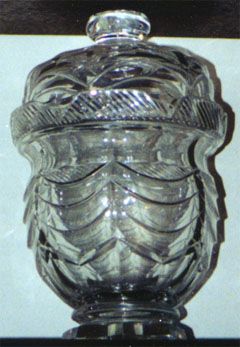 |
1820-1840 |
Unknown |
England or Ireland |
Glass |
7 x 4 1/2" dia. |
|
Gift of Mr. and Mrs. Fred D. Thompson, 1961 |
Purchased from the Dyckman heirs by John Conover, Ossining, NY 1961 Gift of Mr. and Mrs. Fred D. Thompson 5/13/61 |
0 |
|
|
The bulbous-shaped blown jar has six panels of cut swags encircling the body sides and into the domed cover. Twelve flutes are cut into the body above the swags and into the cover. The cover has a large disk finial. The cover resets inside the galleried rim of the jar. The octagonal foot is polished on the underside |
|
Glass |
0 |
| TRUE |
Cruet Stand |
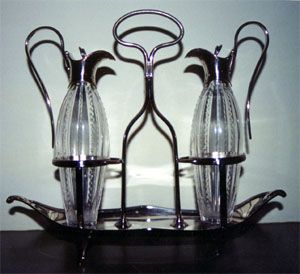 |
Late 18th century |
Unknown |
English |
Silver plate on copper |
8 1/2" H |
|
Gift of Mrs. Lila Acheson Wallace, 1962 |
Gift of Mrs. Lila Acheson Wallace 1962 |
0 |
|
|
Sheffield plate cruet stand with two silver and glass bottles: cruets are elongated tear- drop shaped, with Sheffield plate covered spouts and handles. |
|
Silver |
0 |
| TRUE |
Epergne |
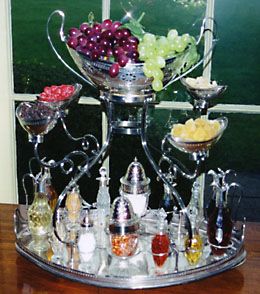 |
1785 |
Christopher Haines, Dublin |
Irish |
Silver and cut glass |
22 1/2" H |
Crowned Harp CH Hybernia, coat of arms of the Anglo-Irish family Aylmer with mottos "Steady" and "Hallelujah". Make-do cruet bottle has a silver spout and mustard spoon with 2 different (London, later) hallmarks. |
Purchase, 1962 |
Purchase, William C. Kennedy 1962 |
0 |
Wyler, Seymour. Old Silver. Crown: 1937, p. 234. |
|
George III Irish silver and cut- glass epergne: in the form of an oval plateau with pierced gallery and a spherical scrolled frame-work, crested with a shuttle- shaped bowl with loop handles, enclosed by four small sweetmeat baskets of similar design, the lower part of the frame-work containing fourteen cut- glass cruets, some silver topped, all below the four boat shaped sweet meats and one boat shaped bowl, all cut- glass lined. In the center of the plateau, is a design of a crest, topped with a ribbon banner containing the word HALLELUJAH above a dove on a crown topping a shield. Below the sheild is the word STEADY in a ribbon bow. |
|
Silver |
0 |
| TRUE |
Pair of knife boxes |
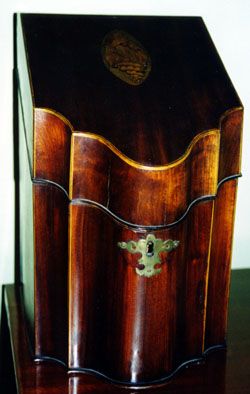 |
1790-1810 |
Unknown |
American or English |
Mahogany |
14 1/2" x 8 3/4" x 11 1/4" |
|
Purchase, 1981 |
Originally a gift to The Metropolitan Museum of Art from Mr. and Mrs. William A. Moore, 1923 (23.80.2,3). A family record in the files of the Metropolitan Musem of Art indicates the the knife boxes were owned by Thomas Streatfeild [sic] Clarkson who married Elizabeth Van Horne in 1790 (per latter to Philip Zimmerman dated 11/8/01). Purchased from the Metropolitan Museum of Art, 1/30/81, after being on loan to Boscobel since 1977. |
0 |
|
|
Pair of Mahogany knife boxes: curly mahogany, edged with inlay, brass and moulded lock, escutcheon and key, hinged lid decorated with shell medallion inlay, inside lid star inlay; interior box fitted with inlayed framework grooved for silver. |
|
Household Items |
0 |
| TRUE |
Pitcher |
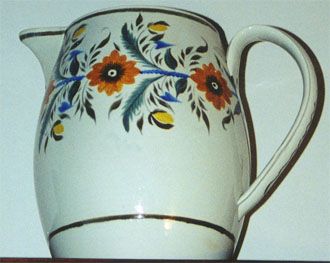 |
c. 1800 |
Unknown |
English |
Pottery |
9" H |
|
Purchase, 1962 |
Purchase, William C. Kennedy 8/28/62 |
0 |
|
|
Staffordshire milk pitcher: painted with a wreath of stylized blossoms, bulbous body, white with yellow and orange flowers. |
Attributed to Pratt Pottery |
Ceramics |
0 |
| TRUE |
Trivet |
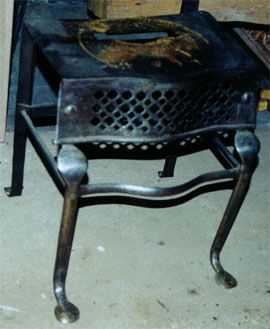 |
18th century |
Unknown |
English |
Steel and wrought iron |
11 x 10 x 10" |
|
Purchase, 1961 |
Purchase, Ginsberg & Levy, New York, NY 5/29/61 |
0 |
|
|
Steel and wrought iron trivet, or footman: on four cabriole legs with pierced top. |
The Complete Encyclopedia of Antiques, by Connoisseur, refers to this article as a "footman" and states as follows: "The name given to a four legged trivet made to stand in front of a fire in the sitting room or parlour. They were made of wrought iron or brass, or partly of each, and comonly had four legs of cabriole design. The top was often pierced with a central hole so that it could be carried. The footman dates from the second half of the 18th century." |
Household Items |
0 |
| TRUE |
Plate Warmer |
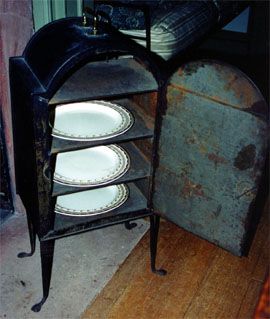 |
c. 1810 |
Unknown |
American |
Tole and brass |
30 1/2 x 13 3/4 x 9 1/2" |
|
Purchase, 1961 |
Purchase, Israel Sack, Inc., New York, NY 5/1/61 |
0 |
|
|
Tole plate warmer: arched, with hinged door opening to four shelves, brass bail handle on four splayed legs ending in pad feet. |
|
Household Items |
0 |
| TRUE |
Tray |
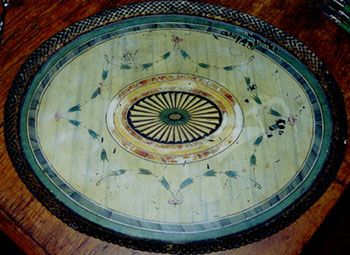 |
c. 1800 |
Unknown |
English |
Painted tin |
16 x 13" |
|
Purchase, 1965 |
Purchase, William C. Kennedy 1965 |
0 |
|
|
Oval tole tray: with open fretted border and painted with a fan lunette, eclosed by bellflower swags. |
|
Household Items |
0 |
| TRUE |
Foot Warmer |
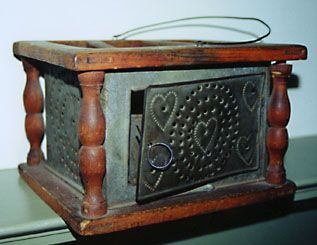 |
Late 18th century |
Unknown |
American |
Tin and pine |
5 3/4 x 9 x 8" |
|
8/5/99 |
Purchase, Mary Allis 3/21/61 |
0 |
|
|
Pine and tin foot warmer: with pierced tin sides and door opening to c compartment holding tray for hot coals. |
|
Household Items |
0 |
| TRUE |
Flute |
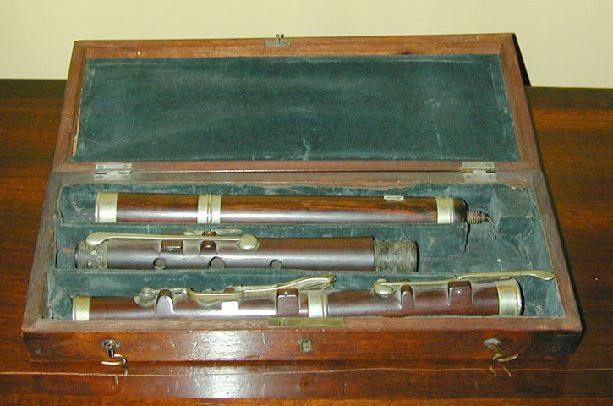 |
c. 1800 |
Unknown |
English |
Wood |
2 1/4 x 12 3/4" |
|
Purchase, 1962 |
Purchase, William C. Kennedy 4/9/62 |
0 |
|
|
Rosewood flute: with silver mounts in a mahogany veneer case. |
|
Musical Instruments |
0 |
| TRUE |
Pipe box |
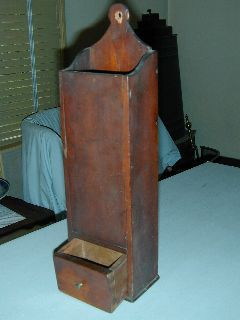 |
18th century |
Unknown |
American |
Cherrywood |
15 1/2 x 4 1/2 x 3" |
|
Purchase, 1962 |
Purchase, William C. Kennedy 1962 |
0 |
|
|
Cherrywood pipe box: plain with single lower drawer and shaped top. |
|
Household Items |
0 |
| TRUE |
Lantern |
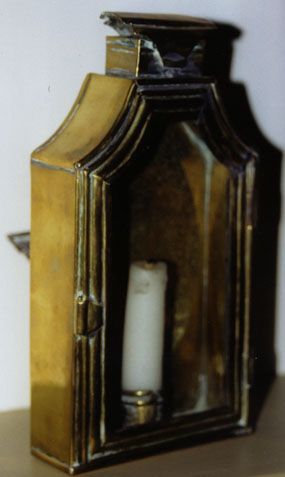 |
1760-1800 |
Unknown |
Probably Holland, Belgium, or Northern Europe |
Brass, glass |
7 1/2" H |
|
Purchase, 1974 |
Purchase, William C. Kennedy 8/24/74 |
0 |
|
|
Brass folding lantern: upright, glazed door, collapsible carrying handle attached to back. The back bears rococo engraving. See Caspall, nos. 511-514 |
Lantern has been soldered closed with a candle in it. |
Lighting |
0 |
| TRUE |
Piano or music stool |
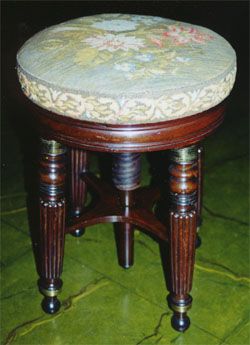 |
1815-25 |
Unknown |
New York City |
Mahogany, ash, brass; wool on canvas, horsehair upholstery covers |
|
|
Gift of Richard and Beverly Kelly, 1998 |
Gift of Richard and Beverly Kelly, Garrison, NY 10/98 |
0 |
|
|
The four-legged piano or music stool has an adjustable seat on a threaded shaft that screws in and out of the stool frame. The stool frame is supported on four turned legs. The legs have reeded shafts with ebonized rings and baluster above, and rings and ebonized ball feet below. Sheet brass collars with incised rings are tacked onto the tops of each leg. The round seat is made of four pieces of ash joined in an open square and upholstered. A medial cross piece attaches to the mahogany, threaded shaft. The needlework seat covers black horsehair upholstery that appears to be original. The needlework appears old enough to have been applied immediately or shortly after manufacture of the stool. |
|
Furniture |
0 |
| TRUE |
Seal |
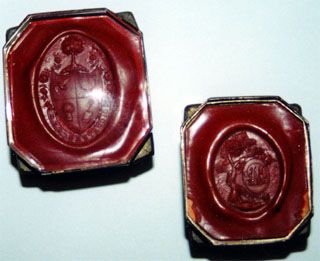 |
Reproductions |
Unknown |
American |
Silver and carnelian |
1 3/4 x 1 7/16" |
|
Purchase, 1963 |
On loan from Stuart Dyckman 6/5/61 Reproductions purchased in 1963 |
0 |
|
|
Pair of carnelian seals: in silver cases, one bears the Dyckman intaglio cypher and the other, the Boscobel oak and SMD. |
These are the replacements of the original seals which were lost while on loan. According to files the originals are supposed to be in office safe. As of April 9, 2002, the original seals were located in the Administration office safe. Their accession numbers are as follows; A 61.42 Carnelian Seal and A 61.43 White Seal. Please refer to the individual records for complete descriptions. |
Household Items |
0 |
| TRUE |
Pair of candlesticks or chambersticks |
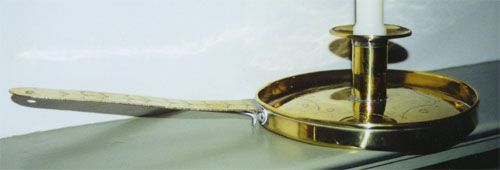 |
1800-1830 |
Unknown |
Holland or Northern Europe |
Brass, iron |
7" across base |
|
Purchase, 1961 |
Purchase, Churchill J. Brazelton 3/30/61 |
0 |
|
|
The pair of brass chambersticks is made of sheet brass. Each stick has a domed circular base with seamed sides and a rim folded around an iron wire. The inside of the bottom is engraved in a motif with six concave sides. The strap handles are engraved along the top with a stylized grape vine and are attached to the body with two rivets. The handles are reinforced from the underside with a brass wire. The sheet metal candle socket is seamed at the handle side. A sheet metal bobeche is attached at the top. |
LOCATION UPDATE: ONE CANDLESTICK MOVED TO GUEST BEDROOM AS OF MARCH 2007 |
Lighting |
0 |
| TRUE |
Pair of Argand lamps |
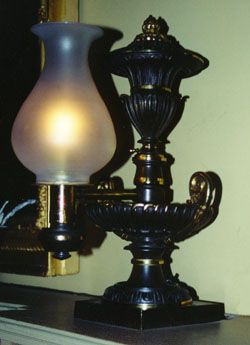 |
c. 1829-1837 |
Lewis Veron & Co. (retailer) |
England |
Brass and bronze with glass |
16 1/2" H |
Marked "LEWIS VERON / & CO. / PHILADELPHIA" on each extending arm |
Purchase, 1972 |
Purchase, Marvin Alexander 4/23/72 |
0 |
|
|
Mantle lamp: bronze and brass Argand type, one pair with fluted urn shaped resevoir, square base, single burner arm and original vase shaped frosted glass chimney. Wired for electricity. Lewis Veron lived from 1793 to 1853. |
Lewis Veron is listed as "Lewis Veron & Co." in Philadelphia directories from 1829 through 1837. Directories for 1826, 1827, 1838, and 1839 were not checked, but Veron & Co. is not listed in 1825 and before, or1840 and after. |
Lighting |
0 |
| TRUE |
Andirons |
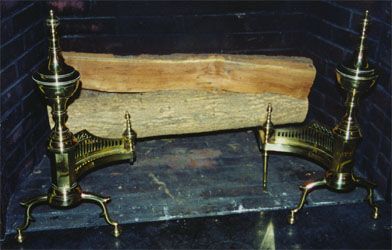 |
c. 1800 |
Richard Whittingham |
New York |
Brass and iron |
23 1/2 x 10 1/2" |
|
Purchase, 1976 |
Attributed to Richard Whittingham, New York Purchase, F. Bealey, Essex, CT 9/12/76 |
0 |
|
|
Pair of brass andirons: with urn finials on hexagonal columns, left and right, having pierced gallery fenders with small urn log stops, on spurred arch supports ending in ball feet. |
|
Household Items |
0 |
| TRUE |
Shovel and tong |
 |
c. 1800 |
Richard Whittingham |
New York |
Brass and steel |
Tongs: 36" Shovel: 36 1/2" |
"R. Whittingham" branded on the side of one of the steel tabs of the tongs. |
Purchase, 1976 |
Purchase, F. Bealey, Essex, CT 10/7/76 |
0 |
|
|
Brass and steel acorn top shovel and tongs. |
See Record ID 528- same item with same accession number has two records in the system as of 2/16/2018 [kc] |
Household Items |
0 |
| TRUE |
Shovel and tong |
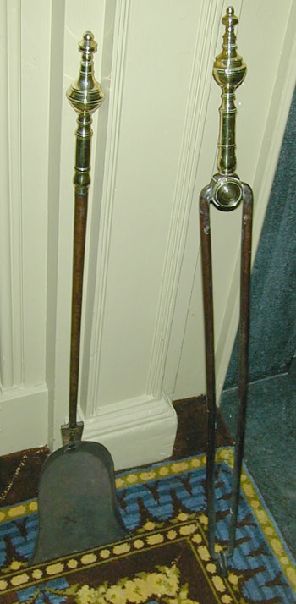 |
c. 1800 |
Richard Whittingham |
New York |
Brass and iron |
Shovel: 30 5/16" Tongs: 30 11/16" |
|
Purchase, 1977 |
Purchase, Israel Sack, New York, NY 7/7/77 |
0 |
|
|
Brass and iron shovel and tongs with urn finial. |
|
Household Items |
0 |
| TRUE |
Shovel and tong |
 |
|
Unknown |
|
Brass and iron |
Shovel: 27 3/4" Tongs: 30 1/2" Hook: 4 x 3 1/2" |
|
Gift of Bruce Esselborn, 1983 |
Gift of Bruce Esselborn, 17 Hilltop Rd., Monroe, NY 2/8/83 |
0 |
|
|
Double lemon top tools: shovel, tongs and jamb hook. |
This set was given Boscobel with the stipulation that it be used in the Dining Room with the double lemon top andirons already there. |
Household Items |
0 |
| TRUE |
Compote |
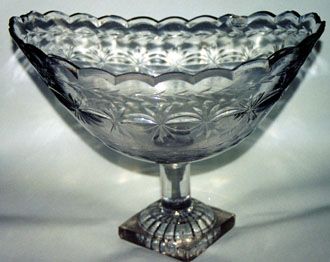 |
1790-1815 |
Unknown |
England or Ireland |
Glass |
9 1/2 x 11 3/4" |
|
Purchase, 1961 |
Purchase, William C. Kennedy 1961 |
0 |
|
|
Cut glass footed fruit bowl: scalloped shuttle-shaped bowl with leaf-cut border, on a short plain pedestal with square base. The base is pressed into a full size mold to impart diamond shape ribbed underside. Cylindrical stem joined to blown and cut bowl with scalloped rim. |
|
Glass |
0 |
| TRUE |
Pair of decanters |
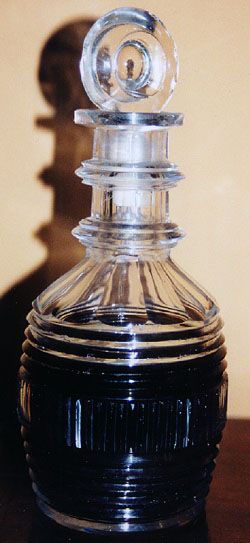 |
c. 1800 |
Unknown |
England or Ireland |
lead glass |
9" H |
|
Purchase, 1961 |
Purchase, William C. Kennedy 5/13/61 |
0 |
|
|
Pair of George III Bristol cut glass decanters: with ring neck, horizontal reeds and mock flute bandings. Vertical disc-shaped stoppers. The blown, bulbous decanters have V-profile rings cut into the body at the shoulder. The shoulders are fluted. The neck has two rings. A band of vertical ribs encircles the widest diameter of the body. The pontil mark is polished off. |
Decanters were moved to the sideboard in the Dining Room on 8/22/02. Decanters were moved to the hanging shelf in the Pantry 10/02. |
Glass |
0 |
| TRUE |
Warmer |
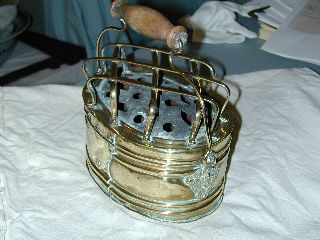 |
18th century |
Unknown |
American |
Brass, tin and wood |
5 x 7 1/2 x 5 1/4" |
|
Purchase, 1963 |
Purchase, William C. Kennedy 2/14/63 |
0 |
|
|
Brass warmer with tin and wooden handle: brazier, oval shaped with cage top. Has inside liner for coals. |
LOCATION UPDATE: OBJECT MOVED TO GUEST ROOM AS OF MARCH 2007 |
Household Items |
0 |
| TRUE |
Trunk |
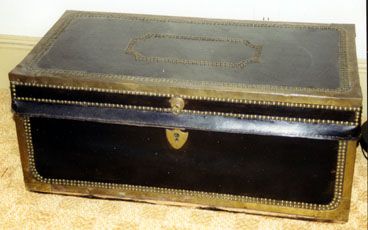 |
1800-1825 |
Unknown |
China for the Western market |
camphorwood, leather, brass |
12 1/2 x 29 x 15 3/4 |
|
Purchase, 1962 |
Purchase, William C. Kennedy 1962 |
0 |
|
|
Black leather covered rectangular trunk with strap-brass edging and decorative brass tacks. The leatheron the lid overhangs the edge to create a dust cover for the seal with the trunk. The lid has a decorative brass-tack rectangle with quarter-round inset corners. The front has a shield-shaped brass escutcheon. Brass bail handles are on each narrow side. |
For discussion, see Carl L. Crossman, "The China Trade" (1972), pp. 147-149. |
Household Items |
0 |
| TRUE |
Barometer |
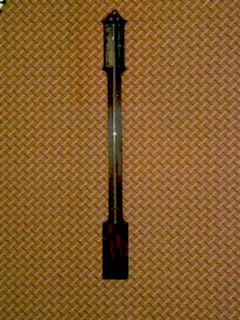 |
c. 1810 |
Unknown |
England or Connecticut |
Mahogany, mahogany veneer, unidentified softwood, silver and glass |
38" L |
Marked "J. M. Peddinghaus" and "Colchester, Ct." |
Purchase, 1962 |
Purchase, 1962 |
0 |
|
|
Cherrywood stick barometer: with shaped case and swan's neck crest. |
JM PEDDINGHAUS COLCHESTER,CT jeweler, silversmith Working Colchester, CT c. 1815 |
Household Items |
0 |
| TRUE |
Hot Water Urn |
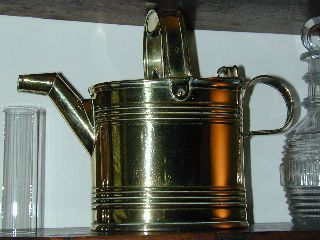 |
Early 19th century |
Unknown |
American |
Brass |
5 1/2" H |
|
Purchase, 1962 |
Purchase, William C. Kennedy 1962 |
0 |
|
|
Brass hot water can: oval, with loop handle and ribbed sides. |
There are two other cans similar to this one in the Tub Room, different sizes. |
Household Items |
0 |
| TRUE |
Andirons |
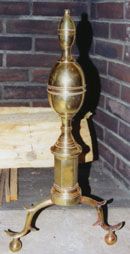 |
c. 1800 |
Attributed to Richard Whittingham |
American |
Brass |
21 1/2" H |
|
Purchase, 1976 |
Purchase, Mrs. William Pearse, Wappingers Falls, NY 10/9/76 |
0 |
|
Berry Tracy Collection, Sold Feb. 1, 1985 for $2,860 Sotheby's Auction |
Pair of Federal brass lemon-top andirons: with hexagonal standards and spurred arch supports, having a large lemon finial and crested with smaller finials. |
|
Household Items |
0 |
| TRUE |
Shovel and tong |
 |
c. 1800 |
Unknown |
American |
Brass |
|
|
Purchase, 1976 |
Purchase, Moira Wallace, Woodbury, CT 12/29/ |
0 |
|
|
Shovel and tongs: to match double lemon-top andirons. |
|
Household Items |
0 |
| TRUE |
Candlestick |
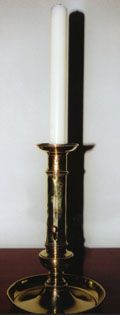 |
1835-1865 |
Unknown |
Probably England |
Brass |
9" H |
|
Purchase, 1961 |
Purchase, William C. Kennedy 6/10/61 [SAME INVOICE CITED AS IL 61.25, WHICH IS PROBABLY CORRECT, LEAVING NO INVOICE FOR IL 61.15] |
0 |
|
|
The candlestick has a columnar shaft above an urn. The flaring base is cupped upward on the sides. An ejector is missing from the shaft. |
LCOATION UPDATE: MOVED TO SILL'S ROOM AS OF MARCH 2007 |
Lighting |
0 |
| TRUE |
Pair of candlesticks |
 |
1780-1800 |
Unknown |
England |
Brass |
10 3/4" H |
|
Purchase, 1961 |
Purchase, William C. Kennedy 5/29/61 [CANNOT LOCATE INVOICE AS OF 11/18/03] |
0 |
|
|
The candlestick shaft is cast in halves and decorated with stop-fluting. It ends in a flaring square base with three rows of beading. |
|
Lighting |
0 |
| TRUE |
Candelabra |
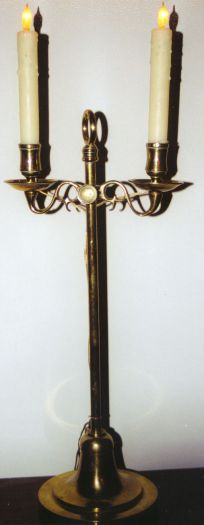 |
1870-1900 |
Unknown |
United States or Europe |
Brass |
20" H |
|
Purchase, 1963 |
Purchase, William C. Kennedy 11/12/63 |
0 |
|
|
Brass candelabrum: double light, wired with real candles and transformer. Adjustable arm. Electrified |
|
Lighting |
0 |
| TRUE |
Box |
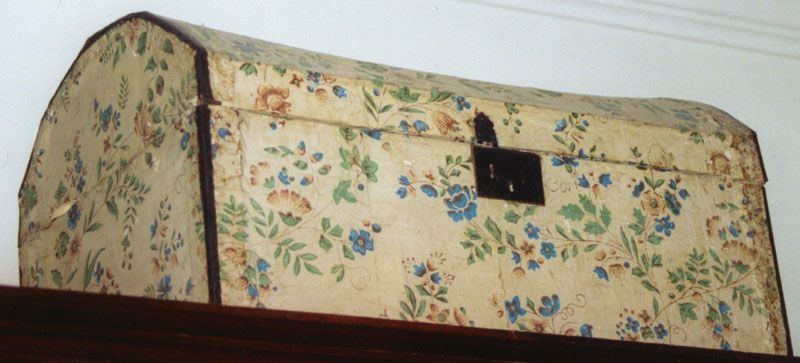 |
c. 1800 |
Unknown |
French |
Wallpaper covered wood, tin |
23 1/2 x 13 1/2" |
Inside cover is a label which reads: Papeterie Cartonnage Reloire in tous go?es Paloc 25 Allees do Tourny Bordeaux Fait La Papeterie Le Cartonnace finet commun tout ce concerne M.M Les Parfum a L'expedition Des Prunes I1 Tient aussi un grand assortment du papies Fantaisie et Bordures de touts dimensions.1757 |
Purchase, 1961 |
Purchase, William C. Kennedy 5/29/61 |
0 |
|
|
Wallpaper covered dome-top trunk: blue and pink painted sprays, tin strips. |
|
Household Items |
0 |
| TRUE |
Tray |
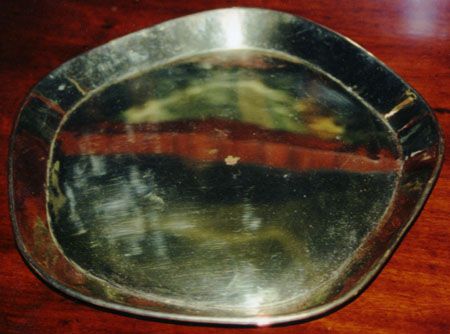 |
c. 1800 |
Unknown |
American |
Brass |
9" Dia. |
|
Purchase, 1962 |
Purchase, William C. Kennedy 6/20/62 |
0 |
|
|
Pentagonal brass tray. |
As of 2/1/2018 the object is physically labeled with accession number J 63.20 [kc] |
Household Items |
0 |
| TRUE |
Box |
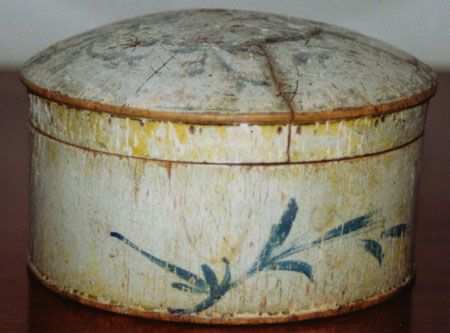 |
19th century |
Unknown |
Europe |
Painted wood, possibly boxwood |
2 3/4 x 5 1/2" |
|
Purchase, 1966 |
Purchase, William C. Kennedy 1966 |
0 |
|
|
Round cylindrical wooden box with slightly domed cover. The box is painted white with blue floral decoration. |
|
Household Items |
0 |
| TRUE |
Soap box |
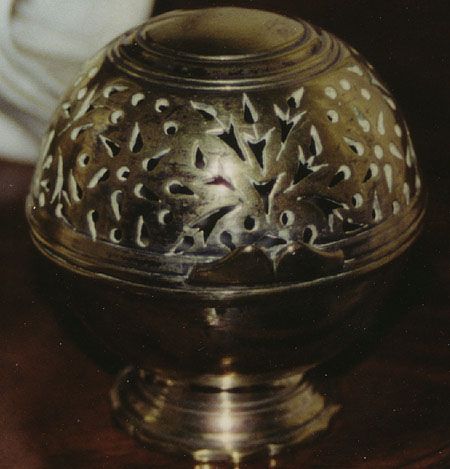 |
1730-60 |
Unknown |
France or possibly England |
Silvered brass |
|
|
Purchase, 1961 |
Purchase, William C. Kennedy 1961 |
0 |
|
|
Silvered spherical soap dish with pierced cover, hinged to open in equal halves. The solid bottom half stands on a reel above a domed foot. See S 61.13 |
|
Silver |
0 |
| TRUE |
Bedding |
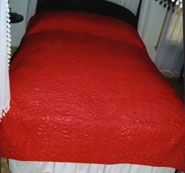 |
Late 18th century |
Unknown |
American |
Wool |
7 x 7 ' |
The letters R A and 1817 are quilted into the design over the pillow. |
Purchase, 1977 |
Purchase, Mary Allis, through Margaret A. Gregory, from both she and her husband, Stewart E. Gergory, 87 Beldon Hill, Wilton, CT 06987 11/15/77 |
0 |
Adrosko, Rita. Natural Dyes and Home Dyeing. P.30, refers to scarlet dyes. |
|
Coverlet: lacquer red wool, hand woven, glazed and quilted. Filled with wool fleece, lined with white hand woven wool. Quilting done with dark red thread. Design motif is foliate border with vertical flower spray springing from a squat container. Bottom corners of coverlet are cut out to accommodate the bedposts. |
The brilliant color of this bedspread could have come from the use of madder, from the roots of the madder plant. Cochineal, a substance from the dried bodies of the Cochineal bug was also used to produce crimson, pink and scarlet at this time. The addition of Quercitron( from the bark of the black oak) could have produced a strong yellow to combine with the red for producing the bright scarlet found in this coverlet. |
Textiles |
0 |
| TRUE |
Warmer |
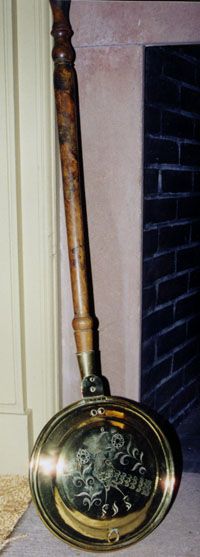 |
c. 1810 |
Unknown |
American |
Brass and fruitwood |
42 1/2" L |
|
Purchase, 1961 |
Purchase, William C. Kennedy 6/8/61 |
0 |
|
|
Warming pan: brass with fruitwood handle, hinged cover engraved with peacock and foliage. |
|
Household Items |
0 |
| TRUE |
Commode |
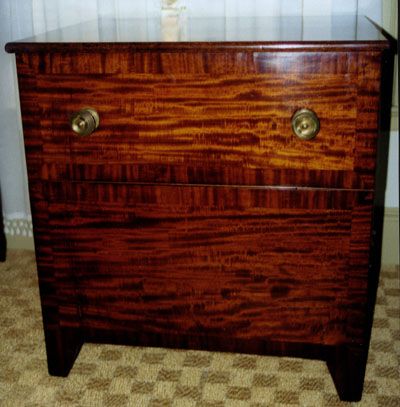 |
1805-10 |
Unknown |
Probably New York |
Mahogany, Mahogany veneers, tulip poplar and pine |
28 1/2 x 26 3/4" |
|
Purchase, 1981 |
Purchase, Berry Tracy, Goshen NY 9/81 |
0 |
|
|
Mahogany commode or "night chair": with original brasses and ceramic chamber pot in helmut shape. |
The inventory of States Morris Dyckman 1806 lists a mahogany night chair valued at $4 |
Furniture |
0 |
| TRUE |
Costume |
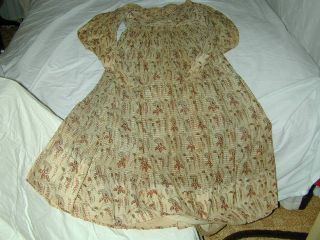 |
c. 1840 |
Unknown |
American |
Cotton |
|
|
Purchase, 1962 |
Purchase, William C. Kennedy 1962 |
0 |
|
|
Dress: sheer cotton woven in horizontal striped and printed in brown and orange paisley pattern, on ecru ground. Print on original card is referred to as "Persian almond design", round neck, back opening, surplice front, Empire waist with set in band. Back closing with hook and metal eye, skirt gathered with wide lined hem, one inch tuck at top of hem. Leg-o-mutton sleeves gathered with two rows of overhand stitch, waistline twenty-two inches. |
|
Costume |
0 |
| TRUE |
Costume |
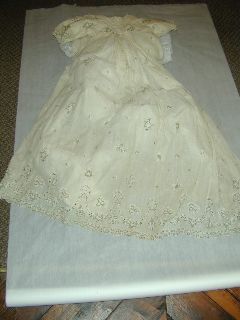 |
c. 1805 |
Unknown |
American |
Cotton |
front length 48 3/4"; back length 42;Shoulder to hem 50"; bust |
|
Purchase, 1971 |
Purchase, Cora Ginsberg, Inc, New York, NY 3/29/71 |
0 |
|
|
Overdress: white muslin embroidered in chainstich with silver threads and sequins. Drawstring neckline, short sleeves, bodice lined with the homespun linen. Skirt gathered in back at empire waist with train effect at hem. Front, very simple drawstring closure with no detail, unfitted. Dress stitched together by hand with silk and cotton threads. |
Exhibited December 1993: A Winter Tea-An exhibition of Historic Clothing at Boscobel 1806 to 1830, by Anne Rhea Adams, guest costume curator. "A c. 1806 tunic dress of off-white muslin embroidered in white cotton, decorated with silver thread and tiny gold sequins worked in satin and chain stitches. Except for a three sectioned bodice back, this dress is cut with only one seam. This back seam is hidden in a magnificent burst of cartridge pleats which fall into a short train. ..Because the front of this dress falls free from the shoulders to the hem, it may have been worn as a maternity dress. Although most women of this period remained cloistered in their rooms during pregnancies, it is possible that this dress served as a formal maternity gown." |
Costume |
0 |
| TRUE |
Costume |
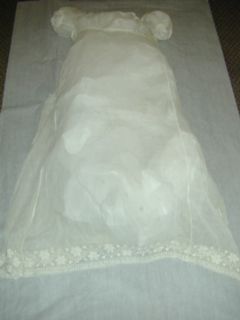 |
c. 1800 |
Unknown |
American |
Cotton |
53 1/4" L back, 49 3/4" L. front; Bust 29" |
|
Purchase, 1971 |
Purchase, Cora Ginsberg, Inc., New York, NY 3/29/71 |
0 |
|
|
Dress: white muslin, embroidered at hem and neckline, squared low neck and short sleeves. Drawstring closure at neck, set in waistband with gathers at back and button closure. |
Exhibited December 1993: A Winter Tea-An Exhibition of Historic Clothing At Boscobel 1806 to 1830 by Anne Rhea Adams, guest costume curator. "A sheer white muslin frock, embroidered heavily in white cotton satin stitch at the hem and at the low, wide square neckline. The bodice is exceedingly high-waisted, and closed with drawstrings. The skirt is tubular, quite straight in front and falls with a generous fullness into a slight train in the back. The early 19th century fashion for transparent overdresses is evident here. This period gown is exhibited over a reproduction acqua cotton undergown, copied from a Costume Parisien print, c. 1824." |
Costume |
0 |
| TRUE |
Costume |
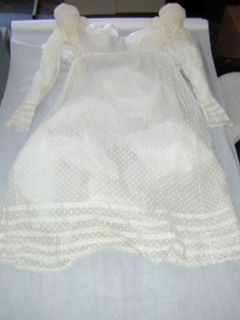 |
c. 1815 |
Unknown |
French |
Cotton |
46" L from shoulder, bust 30", sleeve 20" |
|
Purchase, 1971 |
Purchase, Cora Ginsberg, Inc. New York, NY 7/16/71 |
0 |
|
|
Dress: white sheer muslin embroidered with small sprigs, tucked at hem, empire waist, drawstring closure at neck and waist with ties at back, sleeves puffed at shoulders and straight to wrist. Squared neck and gathers at back of waist. Original card refers to it as sprigged white muslin. |
Exhibited at Boscobel December 1993- A Winter Tea; 1806 to 1830; curated by guest costume curator Anne Rhea Adams, who writes "a circa 1815 sheer white muslin frock embroidered in white cotton in all over floral design. It is high-waisted and fastens with tapes at the back en coulisse. The sleeves are long with five inset mull puffs in each of the short oversleeves. Four tucks and a lace ruffle decorate the knuckle length sleeves, which fall mid-way over the hands. The skirt flares at the sides, standing away at the hem, and terminating above the ankle. The dress has five decorative tucks at the hem." |
Costume |
0 |
| TRUE |
Costume |
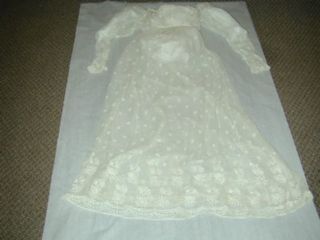 |
c. 1800 |
Unknown |
American |
Cotton |
Bust 24", Length |
Exhibited December 1993 at Boscobel: A Winter Tea 1806 to 1830 by guest costume curator Anne Rhea Adams who writes, "a sheer high-waisted sprigged cotton mull frock with a low round neckline, c. 1820. The dress fastens in the back with tapes. The wide back panel is shirred tightly at the waist. A seven inch opening in the back panel seam indicates a hanging pocket would have been worn underneath. The crinkling effect or plisse effect of the mull suggest that a caustic soda solution was probably used in finishing the fabric. The long sleeves display excessive gathering at the shoulders, and end in the popular knuckle sleeves." |
Purchase, 1971 |
Purchase, Cora Ginsberg, Inc., New York, NY 3/29/71 |
0 |
|
|
Dress: embroidered sheer cotton dress, round neck with lace ruffle edging, sleeves long with lace edging. Empire waist with set in waistband and hook and eye closing at rear, embroidered border at hem and bands of embroidery and lace on sleeves. |
LOCATION UPDATE: MOVED TO GUEST ROOM AS OF MARCH 2007 Exhibited December 1993 at Boscobel: A Winter Tea 1806 to 1830 by guest costume curator Anne Rhea Adams who writes, "a sheer high-waisted sprigged cotton mull frock with a low round neckline, c. 1820. The dress fastens in the back with tapes. The wide back panel is shirred tightly at the waist. A seven inch opening in the back panel seam indicates a hanging pocket would have been worn underneath. The crinkling effect or plisse effect of the mull suggest that a caustic soda solution was probably used in finishing the fabric. The long sleeves display excessive gathering at the shoulders, and end in the popular knuckle sleeves." |
Costume |
0 |
| TRUE |
Costume |
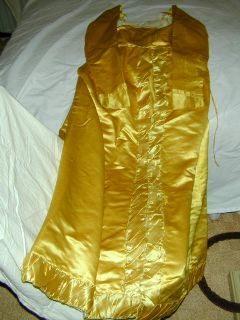 |
c. 1810-15 |
Unknown |
English |
Silk |
|
|
Purchase, 1971 |
Purchase, Cora Ginsberg, Inc. New York, NY 7/16/71 |
0 |
|
|
Gown: yellow satin, Empire waist, long sleeves, low squared neckline, skirt front slit from hem to waist with borders of puffing. |
A similar gown is illustrated in Dresses of The First Ladies of The White House, by Margaret W. Brown. On p. 17, it is referred to as a "sacque dress" because of the opening down the front and was designed to be worn with a petticoat or underdress of a different material and color. |
Costume |
0 |
| TRUE |
Costume |
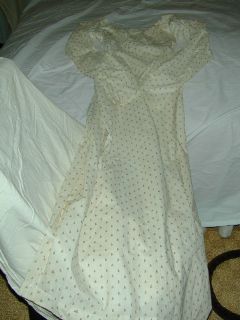 |
c. 1805 |
Unknown |
English |
Cotton |
47" shoulder to hem. |
|
Purchase, 1971 |
Purchase, Cora Ginsberg, Inc., New York, NY 7/16/71 |
0 |
|
|
Dress: printed cotton, white ground with small red and black figures, empire waist, long leg-o-mutton sleeves, dress gathered at back of waist with bib type front with draw string, fitted back. |
|
Costume |
0 |
| TRUE |
Costume |
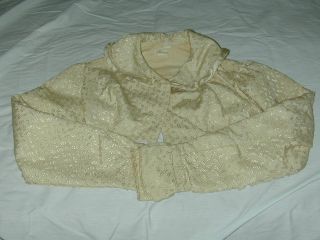 |
Early 19th century |
Unknown |
American |
Silk and cotton |
|
|
Purchase, 1961 |
Purchase, 1961(?) |
0 |
|
|
Jacket: ecru silk spencer type jacket with satin trim, wired at neckline, cotton lined. |
There is no information pertaining to the provenance of this object in file. |
Costume |
0 |
| TRUE |
Costume |
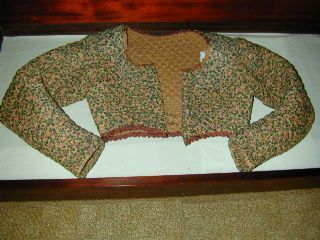 |
c. 1800 |
Unknown |
American |
Cotton and silk braid |
|
|
Purchase, 1971 |
Purchase, Nadine Von Doemming, 8/18/71 |
0 |
|
|
Spencer jacket: printed cotton, quilted by hand, lined, edged with bronze silk braid, three button closing. |
|
Costume |
0 |
| TRUE |
Costume |
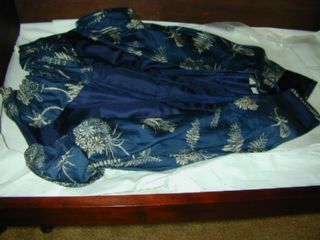 |
19th century |
Unknown |
American |
Cotton |
|
|
Purchase, 1971 |
Purchase, 1971 |
0 |
|
|
Blue fitted jacket: printed cotton, eyelet closing, boned, main body in plain fabric, made like a jumper, sleeves and neck printed in white daisies, ferns and flowers on a blue ground. Neckline gathered with a ribbon in a casing. Plain bands at cuffs, back goes to a point at the waist. Some machine stitching. |
No information in file on where and when this object was purchased. |
Costume |
0 |
| TRUE |
Candlestick |
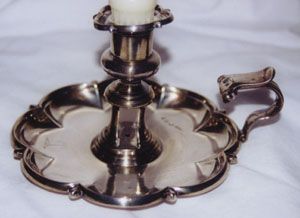 |
1837/1838 [NEED TO CONFIRM] |
T. J. and N. CreswicK |
English |
Silver |
4 1/2" H |
"TJ&NC" in rectangle with 3 hallmarks on top of base, including faint date letter |
Gift of Gladys Vorhees Clark, 1962 |
Gift of Gladys Vorhees Clark, 1962 |
0 |
|
|
Silver chamberstick and extinguisher: scalloped circular base, conical extinguisher attached to round handle, opening in stem for snuffer (missing). |
LOCATION UPDATE: MOVED TO MRS. DYCKMAN'S ROOM Extinguisher dated 1838. |
Lighting |
0 |
| TRUE |
Box |
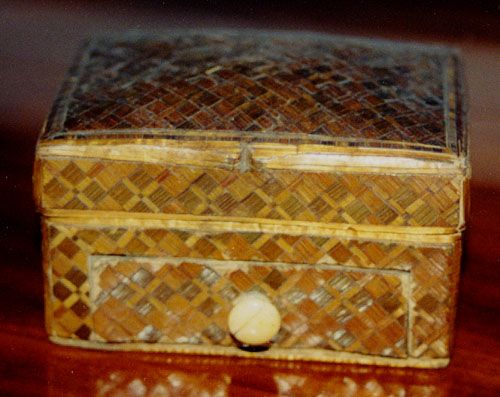 |
Early 19th century |
Unknown |
American |
Straw |
1 3/4 x 3 1/4 x 2 1/2" |
|
Purchase, 1961 |
Purchase, William C. Kennedy 1961 |
0 |
|
|
Small straw work box: for sewing implements with drawer and hinged cover. Mirror inside top compartments for sewing with pull out drawer with an ivory knob. |
|
Household Items |
0 |
| TRUE |
Box |
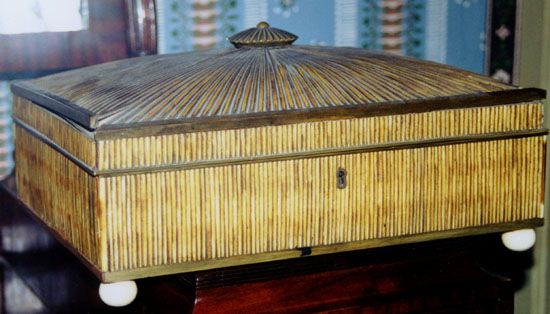 |
c. 1810 |
Unknown |
English |
Wood |
6 1/4 x 13 x 10" |
|
Purchase, 1961 |
Purchase, William C. Kennedy 1/15/61 |
0 |
|
|
Quillwork box: oblong with mushroom shaped finial and ivory bun feet. Domed hinged cover. Has a rectangular compartment in the top held closed by a trap door hooked up into the top. |
As of 2/1/2018 one of the rear feet is detached [kc] |
Household Items |
0 |
| TRUE |
Decanter |
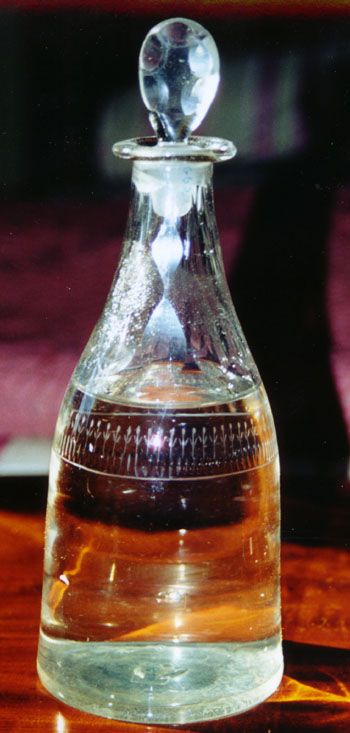 |
1780-1800 |
Unknown |
Northern Europe, probably Bohemia |
nonlead glass |
10" H |
|
Purchase, 1962 |
Purchase, William C. Kennedy 6/20/62 |
0 |
|
|
The blown decanter has "tulip" cut decoration encircling the tapered body and has a facet-cut neck. The flat, pear-shaped stopper is facet-cut. The pontil mark on the bottom has been polished off. |
LOCATION UPDATE: MOVED TO LIBRARY AS OF MARCH 2007 |
Glass |
0 |
| TRUE |
Fender |
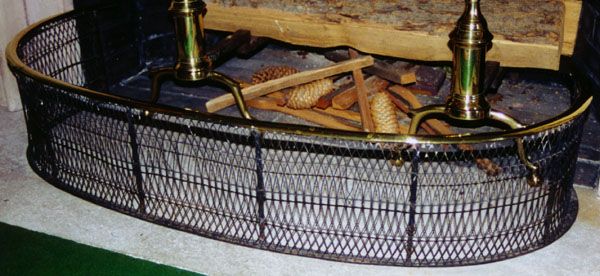 |
c. 1800 |
Unknown |
American |
Iron and brass |
8 x 39 1/2" |
|
Purchase, 1961 |
Purchase, William C. Kennedy 6/10/61 |
0 |
|
|
Brass and wirework fender: C shaped with wirework sides and brass top rail. |
|
Household Items |
0 |
| TRUE |
Andirons |
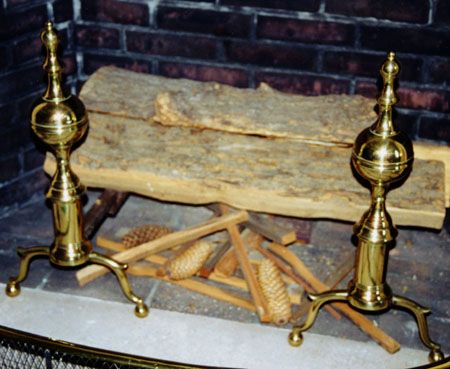 |
1795-1820 |
Richard Whittingham |
American |
Brass and iron |
Andirons: 21 5/8" H Shovel: 31 1/2" L Tongs: 31" L |
Signed: "R. Wittingham" |
Purchase, 1976 |
|
0 |
|
|
Pair of brass ball top andirons: with matching tongs and shovel. Each has cylindrical standard and a large ball finial the auxilliary finials on spurred arch supports ending in ball feet. Together with two matching fire tools comprising a shovel and tongs. |
As of 2/1/2018 the shovel and tongs are located in the Guest Room [kc] |
Household Items |
0 |
| TRUE |
Pair of candlesticks |
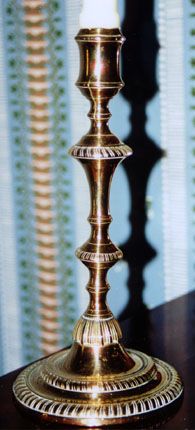 |
1755-1780 |
Unknown |
England |
Brass (bell metal) |
10" H |
|
Purchase, 1961 |
Purchase, Ginsberg & Levy, New York, NY 5/29/61 |
0 |
|
|
The bell metal candlesticks have two prominent baluster turnings with gadrooned bands in the shaft, which is cast in halves. The shaft supports a candle socket and stands on a double domed circular base. A band of deep gadrooning circles the base of the shaft. Two bands of gadrooning encircle the base. |
See Gentle, no. 38. |
Lighting |
0 |
| TRUE |
Pair of candlesticks |
 |
1795-1810 |
Unknown |
France |
Ormolu (gilt brass), bronze, and marble |
9 1/2" H |
|
Purchase, 1961 |
Purchase, William C. Kennedy 1/15/61 |
0 |
Connoisseur, The Complete Encyclopedia of Antiques, refers to gilded bronze or bronze dore as ORMOLU. A definition and description of the process are found on pages 362, 542-3 and illustrations on page 548. |
|
Ormolu and marble candlesticks: classical figures in bronze dore standing on marble base. Classical figure holding a wreath in left hand (wreath is missing on candlestick "a"); right hand holds branch or frond which supports candle socket. |
|
Lighting |
0 |
| TRUE |
Box |
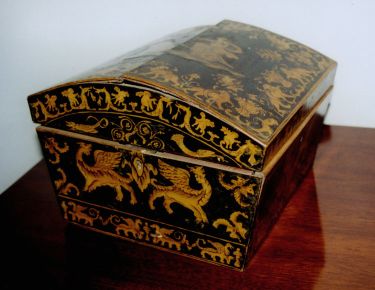 |
c. 1810 |
Unknown |
English |
Wood |
6 1/2 x 9 1/4 x 8 1/4" |
|
Purchase, 1961 |
Purchase, William C. Kennedy 6/8/61 |
0 |
|
|
Penwork sewing box: with truncated top, rectangular, with reserve decorations of griffins, animals and allegorical figures. Lined with pink paper. |
|
Household Items |
0 |
| TRUE |
Household linen |
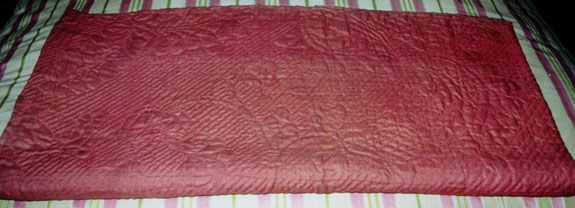 |
c. 1800 |
Unknown |
American |
Wool |
82 x 72" |
|
Purchase, 1962 |
Purchase, William C. Kennedy 1962 |
0 |
|
|
Coverlet: rose red quilt, cochineal dyed, hand woven, quilted in pineapple and flowers pattern, glazed. Quilt was made from two widths and two pieces on each side, one 18 inches and fone 6 inches. The overall dimensions are 82 by 72 inches. The backing is hand woven linen in gold color, and the filling is wool batting. The quilting is done with rather coarse gold color linen thread. |
|
Textiles |
0 |
| TRUE |
Telescope |
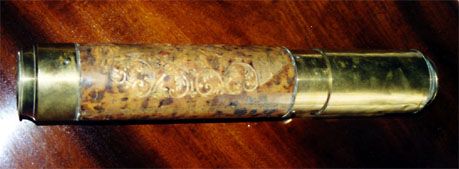 |
Early 19th century |
Unknown |
English |
Brass and leather |
15" L |
Marked: DOLAND, LONDON |
Purchase, 1961 |
Purchase, William C. Kennedy 6/5/61 |
0 |
|
|
Cylindrical brass and tooled leather telescope: brown leather, with gold decoration. |
|
Household Items |
0 |
| TRUE |
Box |
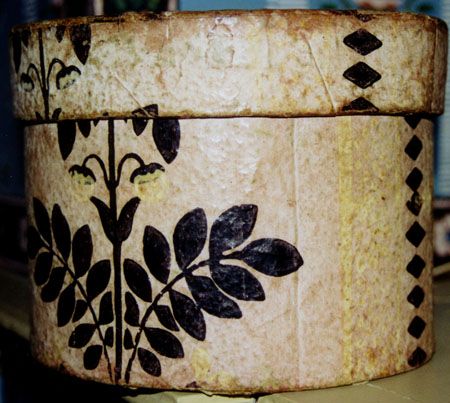 |
c. 1825 |
Unknown |
American and French |
Paper |
See description |
|
Purchase, 1962 |
Purchase, William C. Kennedy 6/5/61 |
0 |
|
|
Nine wallpaper covered boxes: Blue and orange oval: 2 1/2 x 6 x 3 3/4" Blue and tan oval: 6 1/4 x 11 1/8 x 8 3/4" Blue and grey oval: 2 1/2 x 3 1/2 x 2 1/2" Pink round: 5 x 6 1/4" Lavender round: 3 1/2 x 4 3/4" Blue round: 5 x 6 1/4" Blue round: 5 1/2 x 7" Tan and brown: 5 1/2 x 7 1/4" Blue and tan: 3 5/8 x 6" |
|
Household Items |
0 |
| TRUE |
Pair of decanters |
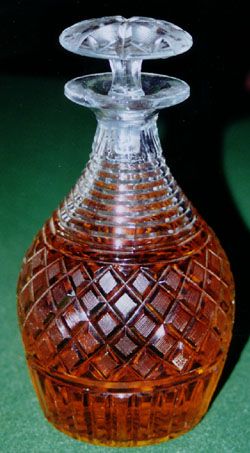 |
1820-1840 |
Unknown |
England or Ireland or possibly United States |
lead glass |
9 1/2" H |
|
Gift of Mrs. Fred D. Thompson, 1961 |
Gift of Mrs. Fred D. Thompson, 1961 Boscobel origin, purchased from Dyckman heirs by John Conover, Ossining, NY 1961. |
0 |
|
See Palmer, Glass in Early America, no. 92. Warren, Irish Glass, nos. 123, 130 |
Pair of globular or pear-shaped cut-glass decanters with strawberry cut diamond design and mushroom stopper. Star- or ray-cut bottom. |
The other decanter is stored in the cabinet (F 61.13) in the Pantry. |
Glass |
0 |
| TRUE |
Decanter |
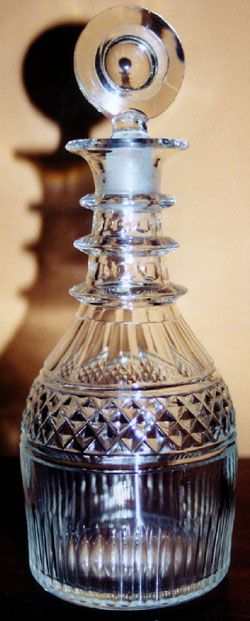 |
1800-1820 |
Unknown |
England or Ireland |
lead glass |
9 1/4" H |
|
Purchase, 1961 |
Said to be of Boscobel origin, but there is no invoice to back this. |
0 |
|
|
The blown, pint-size decanter has a band of flutes around the base and a diamond-cut band at the base of the fluted shoulders. The neck has three rings. The upright stopper is circular with a depression in the center. |
Decanter is stored in cabinet (F 61.13). |
Glass |
0 |
| TRUE |
Set of four wine glasses |
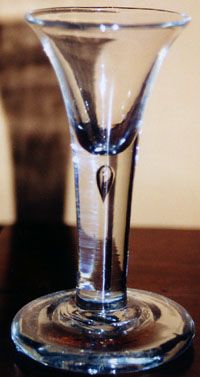 |
1740-1775 |
Unknown |
England |
lead glass |
5 7/8" H |
|
Purchase, 1961 |
Purchase, William C. Kennedy 1/15/61 |
0 |
Hughes, G. Bernars, English, Scottish and Irish Table Glass: Balding and Mansell, Ltd.London, 1956. Pp. 169,228, and ill. #127, 187. |
|
The four blown glasses have flared bowls, cylindrical stems with a tear-shaped bubble inside, and a heavy, round foot with a pontil mark on the underside. Known as "firing" or "hammering" glasses, the heavy foot was used for thumping the table as a form of acclamation when giving toasts. |
|
Glass |
0 |
| TRUE |
Candlestick |
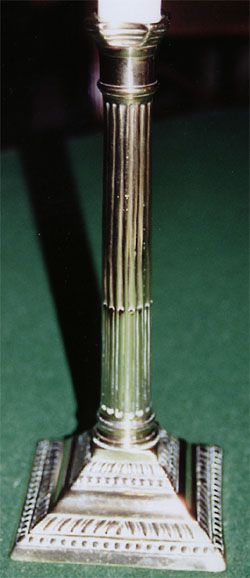 |
1780-1800 |
Unknown |
England |
Brass (bell metal) |
10" H |
|
Purchase, 1961 |
Purchase, William C. Kennedy 6/10/61 [SAME INVOICE CITED FOR IL 61.15, WHICH IS PROBABLY NOT CORRECT FOR THAT CANDLESTICK. ITEM IS DESCRIBED AS "CLASSIC FORM" WHICH SEEMS TO BE THIS CANDLESTICK] |
0 |
|
|
The bell metal candlestick has a stop fluted columnar shaft cast in halves, ending in square pyramidal base having two bands of gadrooning paired with beading. The candlestick is joined to the base with a tubular rivet and appears to be missing a push-up mechanism inside. |
|
Lighting |
0 |
| TRUE |
Candlestick |
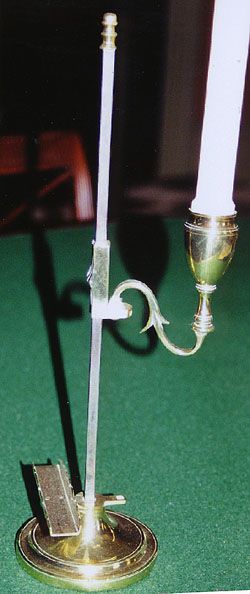 |
1810-1840 |
Unknown |
Probably England |
Brass, iron |
15" H |
|
Purchase, 1962 |
Purchase, William C. Kennedy 6/20/62 [SAME INVOICE CITED FOR IL 62.7] |
0 |
|
|
Brass candlesticks: with steel rod standard, adjustable scrolling candle arm, extinguisher, and taper holder. Extinguisher is not with object and is unlocated as of 10/8/03 |
|
Lighting |
0 |
| TRUE |
Set of four candlesticks |
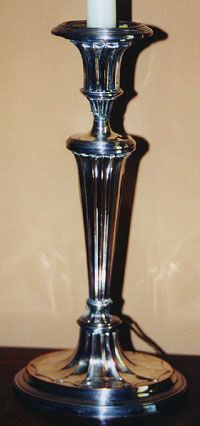 |
1780-1800 |
Unknown |
England |
Silver plate on copper |
12 1/2 " H |
|
Purchase, 1966 |
Purchase, William C. Kennedy 2/8/66 |
0 |
|
|
The candlestick has an oval, fluted base that flares upward into a narrow urn-shaped shaft, also fluted and oval in cross-section. The candle socket is fluted and oval in cross-section. A removable oval bobeche fits into the top. |
|
Lighting |
0 |
| TRUE |
Wine Coaster |
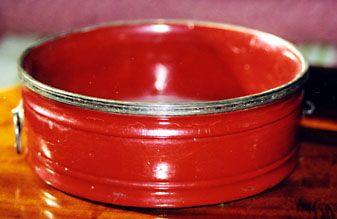 |
Late 18th century |
Unknown |
English |
Papier mache, brass |
2 x 5 1/2" |
|
Gift of Mr. and Mrs. Fred D. Thompson, 1961 |
Gift of Mr. and Mrs. Fred D. Thompson, 5/15/61 Purchased from Dyckman heirs by John Conover, Ossining, NY 1961 |
0 |
|
|
Set of four Regency painted papier mache bottle coasters or slides: with brass ring handles, painted red. |
|
Household Items |
0 |
| TRUE |
Theodolite (surveying instrument) |
 |
c. 1800 |
Jesse Ramdsen, London |
English |
Brass and mahogany |
68" H |
"Ramsden London" |
Purchase, 1961 |
Purchase, William C. Kennedy 1/5/61 |
0 |
Stanto, Lucia C., The Magazine Antiques, July 1993 p. 92-99 Jefferson and the amusements of Science |
Monticello has a theodolite that looks similar to this [See file] Theodolite with tripod and case made by Jesse Ramsden (1735-1800), London, 1770-1780. Brass, copper, glass and mahogany; height 59 1/2 inches (including tripod) |
Brass surveying instrument on wooden tripod stand. |
|
Household Items |
0 |
| TRUE |
Tray |
 |
c. 1800 |
Unknown |
English |
Brass |
2 1/4 x 15/ 1/4 x 9 1/4" |
|
Purchase, 1961 |
Purchase, William C. Kennedy 1/15/61 |
0 |
|
|
Brass tray: oval, with open key-fret gallery, on winged paw feet. Has scallop shell handles. |
LOCATION UPDATE: MOVED TO FRONT DRAWING ROOM AS OF MARCH 2007 Tray was moved to the sideboard in the Dining Room on 8/22/02. As of 8/2005, object is located in rear drawing room. |
Household Items |
0 |
| TRUE |
Telescope |
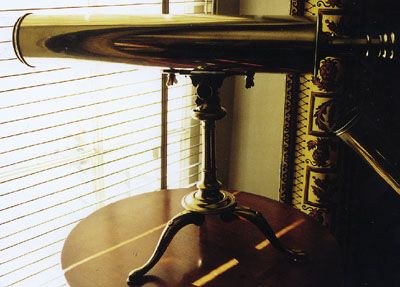 |
c. 1800 |
Unknown |
English |
Brass |
16 x 23" |
|
Purchase, 1961 |
Purchase, William C. Kennedy 1/15/61 |
0 |
|
|
Brass telescope on tripod stand: with plain cylindrical case. Made by B. Martin, Fleet Street, London. |
|
Household Items |
0 |
| TRUE |
Candle Snuffer |
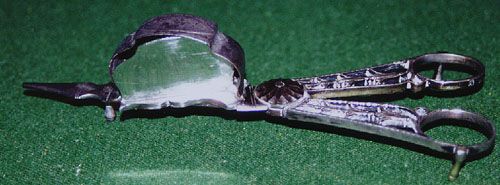 |
Late 18th century |
Unknown |
English |
Steel and silver plate |
6 3/4" L |
|
Purchase, 1961 |
Purchase, William C. Kennedy 3/21/61 |
0 |
|
|
Pierced and engraved wick trimmer: handle is silver plated. Referred to as a candle snuffer. |
|
Household Items |
0 |
| TRUE |
Telescope |
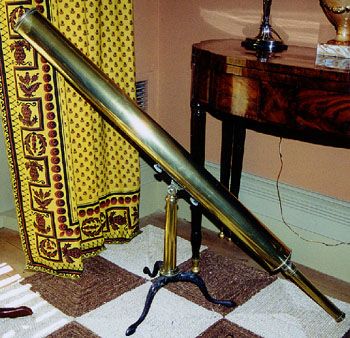 |
c. 1800 |
B. Martin, London |
English |
Brass and wrought iron |
19 x 47 1/2" |
|
Purchase, 1961 |
Purchase, William C. Kennedy 1961 |
0 |
|
|
Brass telescope on stand: wrought iron tripod stand. |
|
Household Items |
0 |
| TRUE |
Taper jack |
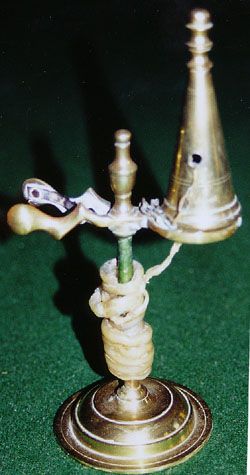 |
1775-1800 |
Unknown |
England |
Brass |
5 1/4 x 2 1/2" |
|
Purchase, 1972 |
Purchase, Black Lamb 7/18/72 |
0 |
|
Similar taper jacks are illustrated in English Domestic Brass. Gentle, Rupert and Field, Rachael, E.P. Dutton. p.130, reprints in office file. |
Brass taper or wax jack: with domed foot. Conical snuffer. No skimming marks on underside of base. Stem screws into base. |
|
Lighting |
0 |
| TRUE |
Penknife |
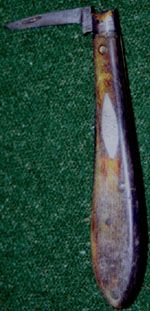 |
1804 |
Unknown |
English |
Steel and wood |
4 3/4" opened |
Silver inlaid plate is inscribed: J.L.P. 1804 Opened blade in incised: R* W at base. |
Gift of Barbara Renovitch, 1993 |
Gift of Barbara Renovitch, Glenham, NY , 198? |
0 |
|
|
Penknife: folding penknife with fruitwood handle and steel blade. |
|
Household Items |
0 |
| TRUE |
Candlestick |
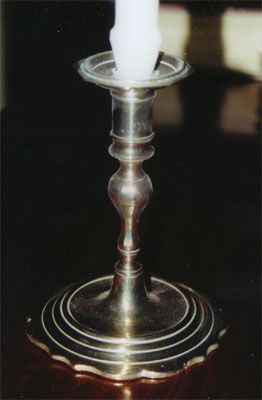 |
undetermined |
Unknown |
undetermined |
Brass |
7 1/2" H |
|
Purchase, 1962 |
Purchase, William C. Kennedy 8/28/62 |
0 |
|
|
The candlestick has an octagonal bobeche, cylindrical candle socket, and eight facets on the inverted baluster shaft. Base is scalloped with stepped rings. The underside of the base has deep and course skimming marks, unlike what is usually encountered in English work. Object examined is number IL 62.8 Only one of the pair is currently on view as of 10/8/2003. Condition record states that one of the pair was broken and is stored in the Fabric Room. |
|
Lighting |
0 |
| TRUE |
Cheval glass or dressing glass |
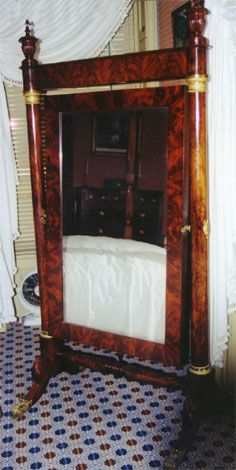 |
1820-30 |
Probably Duncan Phyfe |
New York City |
Mahogany, mahogany veneer, white pine, brass and glass |
76 ¾ x 39 ½ x 26 ¼ |
|
Gift of Fenton L.B. Brown, 1991 |
Gift of Fenton L.B. Brown, Essex, CT 1991 Boscobel exhibition June 17- September 10, 2012 Through the Cheval Glass: A Study of Form and Attribution |
0 |
Exhibition catalogue June 17- September 10, 2012 Through the Cheval Glass: A Study of Form and Attribution |
|
The cheval glass has a rectangular sheet of mirrored glass set within a wood frame covered with mahogany veneers. The glass pivots between two mahogany columnar posts having stamped ormolu capitals and bases and turned urn finials. The uprights are mounted into a "horse" base joined by a turned stretcher. The urn finials, made of wood, are replacements. Sockets with ormolu plates on the outer sides of the posts are for candle arms, now missing. The uprights are mounted to a "horse" base comprised of shaped feet with water leaf carving on the tops and cast brass capped feet and casters. |
Formerly attributed to Charles Honore Lannuier, 1803-1819. Similar examples are in the Maryland Historical Society, is no. 108 in "Furniture in Maryland, 1740-1940," cat. no. 108; and at the House of History in Kinderhook, NY. This piece is not included in Peter Kenney's study on Lannuier, MMA, 1998. |
Furniture |
0 |
| TRUE |
Andirons |
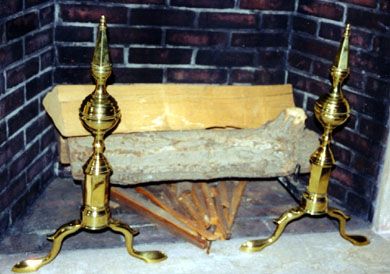 |
c. 1800 |
Unknown |
American |
Brass |
25 " H |
|
Purchase, 1962 |
Purchase, William C. Kennedy 4/9/62 |
0 |
|
|
Pair of brass steeple-top andirons: with hexagonal standard, ball and staple finial, on spurred arched supports ending in snake feet. |
Maker: Davis, who worked in both Boston and New York, c. 1800. |
Household Items |
0 |
| TRUE |
Shovel and tong |
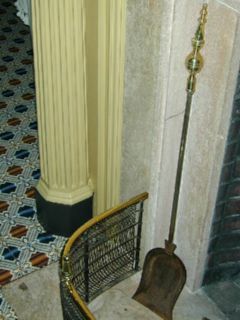 |
c. 1800 |
Unknown |
American |
Steel, brass and iron |
Shovel: 32 1/4" L Tongs: 31" L |
|
Purchase, 1962 |
Purchase, William C. Kennedy 4/9/62 |
0 |
|
|
Shovel and tongs: to match brass steeple top andirons, finials are brass and the handle is made of steel with iron ends. |
|
Household Items |
0 |
| TRUE |
Fender |
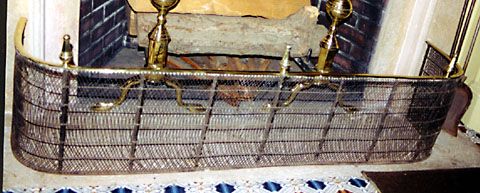 |
Early 19th century |
Unknown |
American |
Brass and wire |
|
|
Purchase, 1962 and 1978 |
Original purchase, William C. Kennedy 6/12/61 Sold to Sotheby Parke- Bernet, and later repurchased, 2/4/78 |
0 |
|
|
Brass and wirework D-shaped fender: with three tapering hexagonal finials. |
|
Household Items |
0 |
| TRUE |
Candlestick |
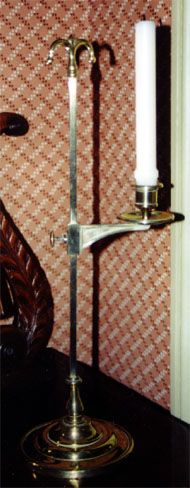 |
1820-1850 |
Unknown |
Probably England |
Brass, iron |
19 1/2" H |
|
Purchase, 1961 |
Purchase, William C. Kennedy 4/62 [NOT LISTED ON INVOICE OF THAT DATE] |
0 |
|
|
Adjustable brass candlestick: with rod standard and adjustable candle arm. |
|
Lighting |
0 |
| TRUE |
Two lamps |
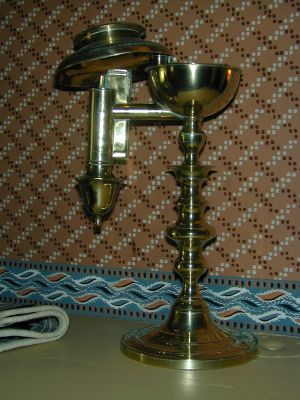 |
1820-1850 |
Unknown |
England |
Brass |
12" H |
|
Purchase, 1961 |
|
0 |
|
|
Brass Rumford table lamps: one pair whale oil burning lamps with knopped standard, urn shaped font, and hinged domical shade. Two lamps are similar but are not a pair. A is located on right side of mantel and b is located on left. |
See Thwing, Flickering Flames pp. 68-70; Wolfe, Brandy, Balloons and Lamps, index. The following needs to be re-written. Although treated as a pair in the collection, these are not really a true pair. Winchester, Alice. Collectors and Collections: Straight, 1961. P47. She states as follows: The inventor of the Rumford lamps was born Benjamin Thompson at Woodburn, MA in 1753, became a tory expatriate during the Revolution and entered the service of the elector of Batavia. He was made Count Rumford in reward for his extraordinary civil and scientific achievements, including the invention of various lighting devices, of which only this type is associated with his name. The flat ribbon wicks used in these lamps are a simplification of the semi-tubular shape he recommended, and the glass chimneys they require owe a debt to Argand. Efforts to overcome the problem of feeding viscous whale oil or vegetable oils to the wick are evident in the high placed resevoir, for gravity flow was more dependabe than capillary attraction. These lamps, of foreign origin, were limited in use in America after 1800. |
Lighting |
0 |
| TRUE |
Pair of beakers |
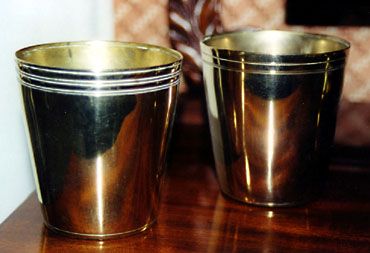 |
c. 1800 |
Unknown |
American |
Brass |
4 x 3 3/4" (dia) |
|
Purchase, 1961 |
Purchase, William C. Kennedy 6/10/61 |
0 |
|
|
Pair of brass beakers: for washstand, plain with rings at rim. |
LOCATION UPDATE: ONE BEAKER MOVED TO GUEST ROOM AS OF MARCH 2007 As of 2/1/2018 one beaker is still in Guest Room [kc] |
Household Items |
0 |
| TRUE |
Box |
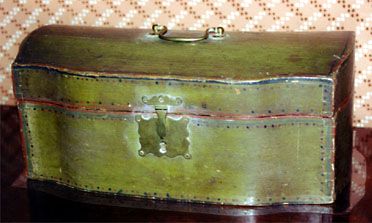 |
1825-50 |
Unknown |
Mid-Atlantic region |
Painted yellow pine, brass |
5 3/4 x 13 5/8 x 8 1/4" |
|
Purchase, 1961 |
Purchase, William C. Kennedy 6/10/61 |
0 |
|
|
Rectangular dovetailed box with a swelled front and sides and a domed lid. The exterior is painted green with red and blue banded borders having red and black alternating dots. A bail handle is attached to the center of the top. A shaped brass lock and lockplate are mounted in the center of the front; the lid locks by a hinged tab. The inside is unpainted. |
|
Household Items |
0 |
| TRUE |
Bowl |
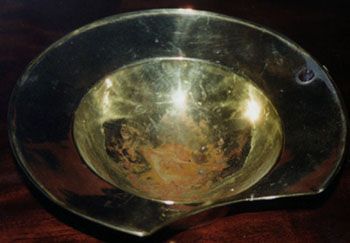 |
c. 1800 |
Unknown |
English |
Brass |
8" Dia. |
|
Gift of The Reader's Digest,1963 |
Gift of The Reader's Digest, 1963 |
0 |
Gentle, Rupert and Field, Rachael. English Domestic Brass 1680-1810: E. P. Dutton. P. 254, ill. Explains uses and origins of barber's bowl with two illustrations of similar bowls dated 1750-70. Antiques Magazine, June 1972, pp. 1019-1022. By Joan Severa. This interesting article on ceramic barber's bowls reminds us that Don Quixote mistook a barber's basin for a legendary gold helmet. He spied it on the head of a barber(who was wearing it to keep his new hat dry) "and being new-scowered it glittered half a league off". Quixote attacked the poor barber, frightened him away from his bowl, and for some time wore it himself as a helmet. |
|
Brass shaving bowl: referred to as a shaving collar or barber's bowl. Has flaring edge with semi-circular piece cut out and cuff foot. |
Although these bowls were referred to as "shaving basons" in the early 19th century in this country, they were also used by Doctors as bleeding bowls. Mrs. Dyckman, in one of her letters to Mr. Dyckman, while in England, mentioned having the inside of her cheek scarified in order to lessen the pain of a headache. |
Household Items |
0 |
| TRUE |
Soap box |
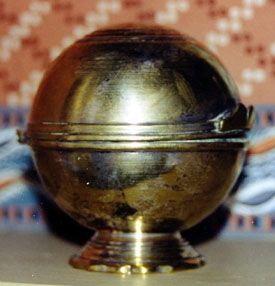 |
1730-1760 |
Unknown |
France or possibly England |
Silvered brass |
3 1/2 x 4" |
|
Purchase, 1961 |
Purchase, William C. Kennedy 6/5/61 |
0 |
Gentle, Rupert, Field, and Rachael. English Domestic Brass 1680-1810: E. P. Dutton. pp. 264, ill. In Boscobel files. |
|
Silvered spherical soap dish with solid cover, hinged to open in equal halves. The solid bottom half stands on a reel above a domed foot. Traces of silver remain. See S61.12 |
|
Household Items |
0 |
| TRUE |
Chamber Pot |
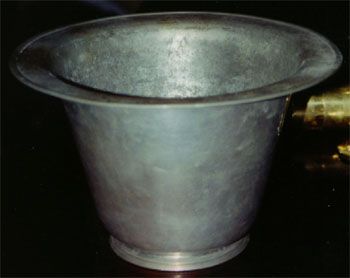 |
1800-1850 |
Unknown |
Europe |
Pewter |
7 1/2 x 11" |
Four indistinct hallmarks or pseudo hallmarks are stamped into the brim. |
Purchase, 1961 |
Purchase, William C. Kennedy 6/12/61 |
0 |
|
|
The chamber pot has a flared cylindrical body standing on a molded foot and terminating at the top in a brim with molded edge. The body has three bands of three incised rings. |
|
Household Items |
0 |
| TRUE |
Counterpane |
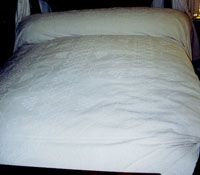 |
1806 |
Unknown |
American |
Cotton |
108 x 96" |
Initials G N and 1806 are worked into design in the pillow area. |
Purchase, 1961 |
Purchase, 1961 |
0 |
Cooper, Grace Rogers. The Copp Family Textiles: Smithsonian, 1971. Pp. 10-14 refers to a very similar counterpane. |
|
Counterpane: embroidered white cotton, ground fabric is white corded cotton, embroidered in candlewicking with heavy, soft twist cotton yarn in a pattern of grapes and leaves growing vertically between arbours. The ground fabric is corded cotton with a weft of six fine yarns and one double ply heavy cotton yarn in the seventh pick. |
|
Textiles |
0 |
| TRUE |
Pair of candlesticks |
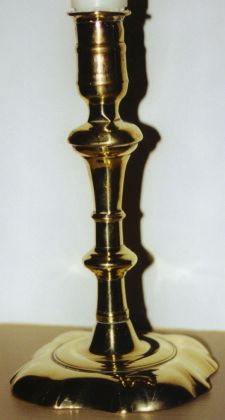 |
1740-1775 |
Unknown |
England |
Brass |
6 1/2" H |
|
Purchase, 1962 |
Purchase, William C. Kennedy 6/10/62 [INVOICE NOT LOCATED AS OF 11/18/03] |
0 |
|
|
The pair of brass candlesticks has an eight sided socket flange, knopped shaft, and scalloped base. The shaft is cast in halves. |
LOCATION UPDATE: MOVED TO PETER'S BEDROOM AS OF MARCH 2007 |
Lighting |
0 |
| TRUE |
Hot Water Urn |
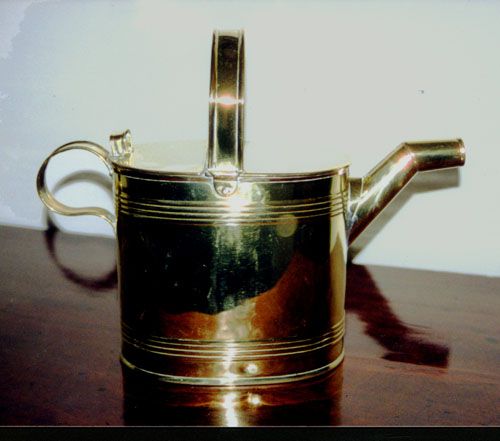 |
Early 19th century |
Unknown |
American |
Brass |
(c) 12 1/2" H (d) 17" H |
|
Purchase, 1962 |
Purchase, William C. Kennedy 1962 |
0 |
|
|
Two brass hot -water cans: oval shape, with loop handles and ribbed bands at top and bottom. |
There are two more like these in the pantry. |
Household Items |
0 |
| TRUE |
Tub |
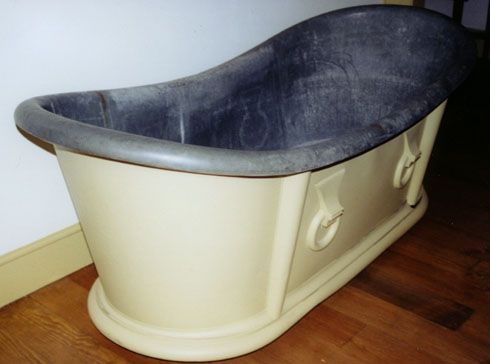 |
c. 1815 |
Unknown |
English |
Painted zinc |
62 1/2 x 26" |
|
Purchase, 1962 |
Purchase, 1962 (invoice is missing) |
0 |
|
|
Painted zinc bathtub: oval with faux ring handles on sides, molded base. |
|
Household Items |
0 |
| TRUE |
Doll |
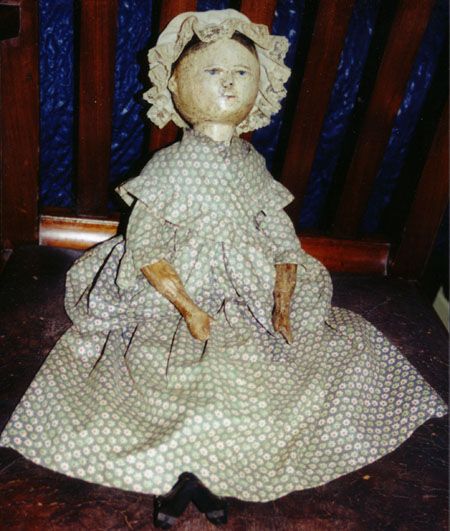 |
c. 1800 |
Unknown |
American |
Wood, cotton and wool clothing |
22" H |
|
Gift of Elenor Lake, 1961 |
Gift of Elenor Lake, 1961 |
0 |
|
|
Wooden doll: carved and painted, dressed in cotton print dress, grey background with small white, green and red flowers. Dress has panniers, ruffled sleeves and triangular ruffled fichu collar. Petticoat is tucked sheer cotton, lace trimmed, with matching pantaloons, both tied at the waist in back. Separate white wool petticoat with scalloped edging fastened at the rear with a button closing. Doll wearing sheer white cotton mop trimmed with lace ruffles. |
|
Toys and Dolls |
0 |
| TRUE |
Doll |
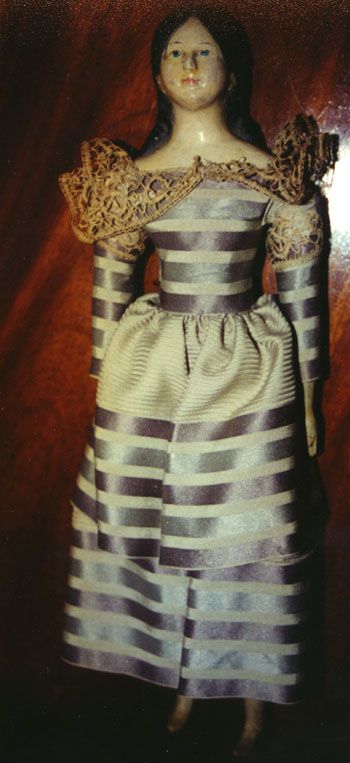 |
Early 19th century |
Unknown |
American |
Leather, composition and silk |
11" H |
|
Purchase, 1961 |
Purchase, William C. Kennedy 1961 |
0 |
|
|
Doll: kid body, composition head and wooden hands and feet, painted hair and face. Dressed in grey striped silk with lace collar and sleeve trim and cotton underslip. |
|
Toys and Dolls |
0 |
| TRUE |
Doll |
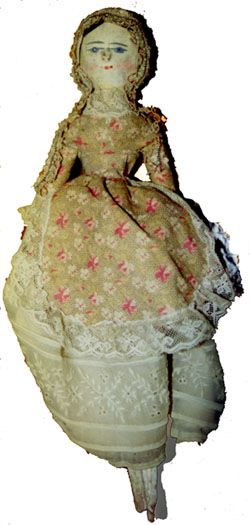 |
c. 1800 |
Unknown |
American |
Wood and cloth |
9" H |
|
Purchase, 1961 |
Purchase, William C. Kennedy 1961 |
0 |
|
|
Doll: wood body, dressed in sheer, lined embroidered cotton skirt, heavily starched, top of dress and apron are made of fine cotton print with a dotted tan ground and small, pink, yellow and white flowers with lace edging. Blue straw bonnet trimmed with braid. Face and hair painted on. |
LOCATION UPDATE: MOVED TO PETER'S BEDROOM AS OF MARCH 2007 |
Toys and Dolls |
0 |
| TRUE |
Doll |
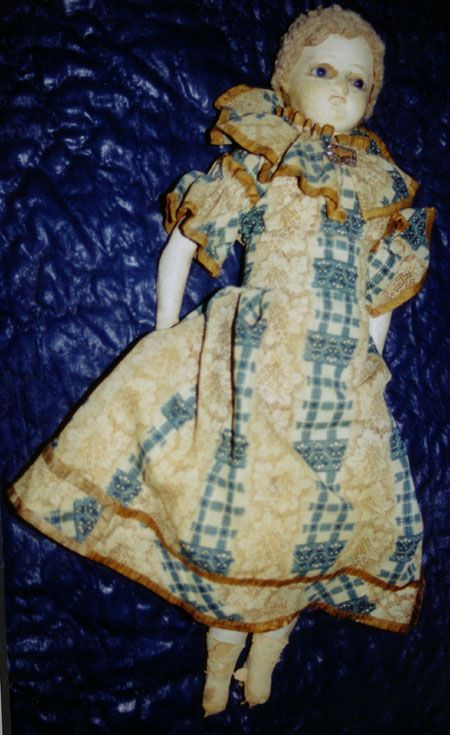 |
c. 1830 |
Unknown |
American |
Cotton, silk, bisque and leather |
17" H |
|
Purchase, 1961 |
Purchase, William C. Kennedy 1961 |
0 |
|
|
Doll: china or bisque head, feet and forearms and cloth body, glass eyes and lambs wool hair. Dress is cotton print in brown, tan and blue on ecru ground, trimmed with brown silk ribbon, ruffled bertha collar and cut steel buttons at neck closing and waist, leather shoes trimmed with round glass buttons, white cotton slip sewn to dress cotton panties and camisole. |
|
Toys and Dolls |
0 |
| TRUE |
Goffering iron |
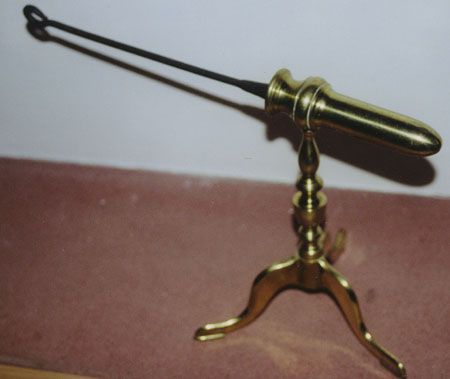 |
1760-1820 |
Unknown |
Probably England |
Brass and wrought iron |
10 x 14 1/2" |
|
Purchase, 1961 |
Purchase, William C. Kennedy 1961 |
0 |
|
|
The brass and wrought iron goffering iron stands on a tripod base of cabriole legs ending in plain feet. The turned shaft supports a brass tube that in turn holds an iron heater with a looped terminus. |
Called a goffering iron or Italian iron, it was used to iron ruffles. For related object, see Fennimore, "Metalwork in Early America," no. 257. |
Household Items |
0 |
| TRUE |
Two candlesticks |
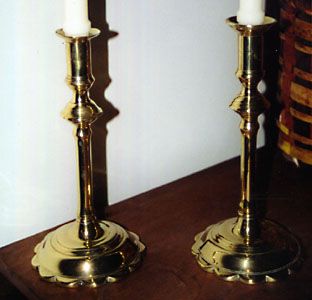 |
1755-1780 and later |
Unknown |
England |
Brass |
10 1/2" H |
|
Purchase, 1961 |
Purchase, William C. Kennedy 6/11/61 |
0 |
|
|
The candlestick has a slender, core-cast shaft ending at a small knop with a larger knop above. The cylindrical candle socket ends in a flared circular bobeche. The domed base is scalloped. "a" is heavier and less well-defined that "b". The bobeche on "a" is noticeably thicker, and the broad knop lacks the 12 defining edge cuts visible in "b". The undersides of the candlestick bases differ. "a" appears to have been cast at a different time from "b". |
|
Lighting |
0 |
| TRUE |
Candlestick |
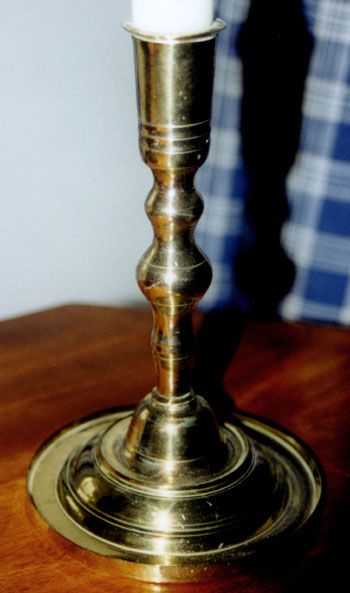 |
undetermined |
Unknown |
Probably Europe |
Brass |
8" H |
|
Purchase, 1962 |
Purchase, William C. Kennedy 6/20/62 [SAME INVOICE CITED FOR IL 62.13] |
0 |
|
|
The candlestick has a slightly tapered candle socket above the core-cast shaft (not cast in halves) with two knops, which screws into the domed base. The underside of the base is a flat ring with no skimming marks. |
|
Lighting |
0 |
| TRUE |
Cart |
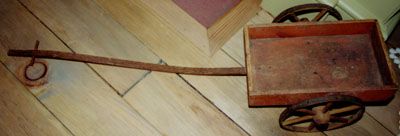 |
c. 1800 |
Unknown |
American |
Painted pine |
33 x 11 1/2" |
|
Purchase, 1962 |
Purchase, 1962 |
0 |
|
|
Painted pine doll's cart: plain, with large wheels and a rectangular body, painted red. |
Invoice missing |
Toys and Dolls |
0 |
| TRUE |
Hand mirror or looking glass |
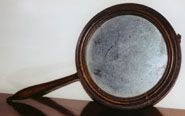 |
1800-1825 |
Unknown |
England |
Mahogany and glass |
14 1/2 x 7 3/4 x 1 1/2 |
|
Purchase, 1962 |
Purchase, William C. Kennedy 1962 Boscobel exhibition June 17- September 10, 2012 Through the Cheval Glass: A Study of Form and Attribution |
0 |
Charles F. Montgomery, "American Furniture, Federal Period," no. 258, shows a similar mirror. Exhibition catalogue June 17- September 10, 2012 Through the Cheval Glass: A Study of Form and Attribution |
|
Turned mahogany hand mirror: circular, with reeded frame and swelling lateral handle. |
Invoice missing. |
Household Items |
0 |
| TRUE |
Coverlet |
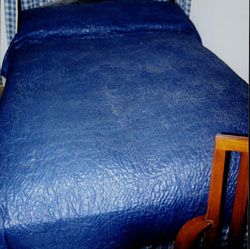 |
c. 1800 |
Unknown |
American |
Wool |
96 x 84" |
Lining embroidered in white wool cross-stitch F S in mirror conformation. |
Purchase, 1969 |
Purchase, Mary Allis 5/24/69 |
0 |
|
|
Coverlet: deep blue hand woven quilted coverlet, highly glazed, lined with golden hand woven wool corners slit 18 inches diagonally at bottom of quilt to accommodate bedposts. Woven width of top fabric 24 inches, woven width of backing 33 inches. Stuffing is wool, quilting pattern done in brown thread, pattern is serpantine curlicues at borders and complicated design including fan shaped petalled flowers on body of quilt. |
|
Textiles |
0 |
| TRUE |
Mattress |
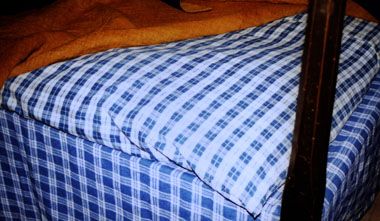 |
c. 1800 |
Unknown |
American |
Linen |
64 x 59" |
|
Purchase, 1971 |
Purchase, Fletcher, Olde Stone House Antiques, Newburgh, NY 6/19/71 |
0 |
|
|
Mattress: blue and white window pane check bed tick, 7/8 inch plaid, filled with straw. |
|
Textiles |
0 |
| TRUE |
Bedding |
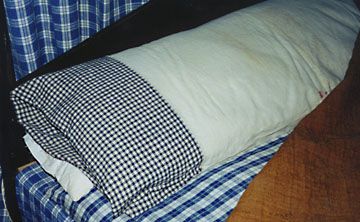 |
c. 1800 |
Unknown |
American |
Linen |
66 1/2 x 57" |
Embroidered initials on lower edge: E L in red cotton thread. |
Purchase, 1971 |
|
0 |
|
|
Bolster cover: navy and white hand woven bed tick, 1/8 inch check, lined with hand woven white linen. |
|
Textiles |
0 |
| TRUE |
Bed Smoother |
 |
c. 1800 |
Unknown |
American |
Wood |
20" L |
|
Purchase, 1961 |
Purchase, William C. Kennedy 6/5/61 |
0 |
|
|
Wooden bed smoother: unfinished wood, spade shaped, for smoothing feather beds. |
|
Household Items |
0 |
| TRUE |
Tea Caddy |
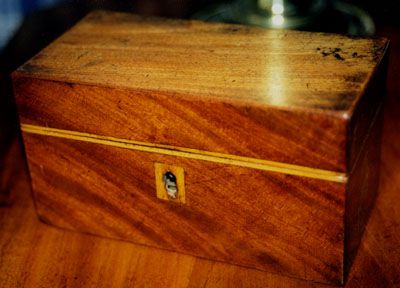 |
Late 18th century |
Unknown |
English |
Mahogany |
2 3/4 x 4 7/8 x 2 1/2" |
|
Purchase, 1962 |
Purchase, William C. Kennedy 1962 |
0 |
|
|
Inlaid miniature mahogany tea caddy: with hinged cover opening to two wells, one with cover. Band of satinwood inlay and keyhole. |
|
Household Items |
0 |
| TRUE |
Silhouette |
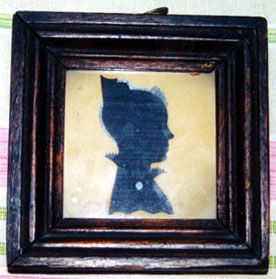 |
Early 19th century |
Unknown |
American |
Paper |
2 1/4 x 2/ 1/4" |
|
Purchase, 1961 |
Purchase, William C. Kennedy 6/5/61 |
0 |
|
|
Silhouette of woman: facing the viewer's right, in square wood frame; molded frame. |
During inventory, the object was not located (YB). Object located in Mrs. Dyckman's Room as of 2/1/2018 |
Prints/Drawings |
0 |
| TRUE |
Silhouette |
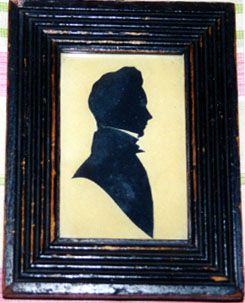 |
Early 19th century |
Unknown |
American |
Paper |
|
|
Purchase, 1962 |
Purchase, William C. Kennedy 8/28/62 |
0 |
|
|
Silhouette of man: facing right, in wood frame. |
During inventory, the object was not located (YB). As of 2/1/2018 the object is located in Mrs. Dyckman's Room [kc] |
Prints/Drawings |
0 |
| TRUE |
Toy Horse |
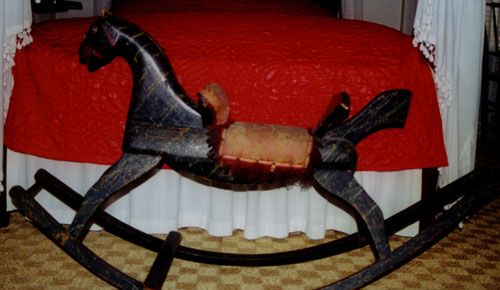 |
c. 1800 |
Unknown |
American |
Painted wood, leather |
|
|
Purchase, 1961 |
Purchase, William C. Kennedy 1961 |
0 |
|
|
Painted wood hobby horse: with upholstered saddle and painted to simulate a dapple grey horse. Trimmed with red. |
LOCATION UPDATE: MOVED TO LIBRARY AS OF MARCH 2007 |
Toys and Dolls |
0 |
| TRUE |
Pair of wine coolers |
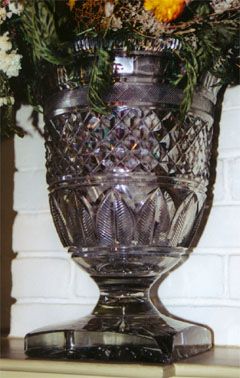 |
1800-1825 |
Unknown |
England or Ireland |
lead glass |
12 1/2" high |
|
Purchase, 1961 |
Purchase, 1961. William C. Kennedy invoice dated January 15, 1961. Identified as "Pair very fine Irish Waterford cut glass large urn shaped vases on heavy square base. In perfect condition. For mantle, Dining Room, circa 1780." |
0 |
|
|
Pair of cut-glass wine coolers each having a deep bowl decorated with a diamond-cut band above stylized leaves, flaring fluted rim, and square base below a narrow stem. |
[NEED INSPECTION TO DETERMINE IF THESE HAD COVERS] |
Glass |
0 |
| TRUE |
Pair of lusters or candlesticks |
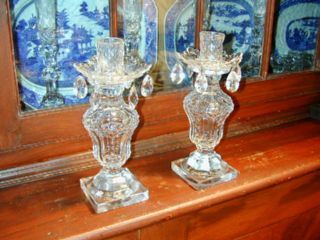 |
1790-1815 |
Unknown |
England or Ireland |
glass |
11" H |
|
Gift of Mrs. Lila Acheson Wallace, 1962 |
Gift of Mrs. Lila Acheson Wallace, 1962 |
0 |
Hughs, Bernard G: English, Scottish and Irish table glass. Bramhall house :1956. Pp 361-370, ill. 1288. |
One pair sold in the Henderson house sale-Robinson-# 79, 10/5/62 |
Cut glass lusters (or lustres), or candlesticks: one pair of cut-glass vase candlesticks with square foot supporting solid vase shaped body, with faceted lustres and circular flange below cylindrical bobeche edged socket. Removable cut-glass bobeches See Palmer, p. 304 |
|
Lighting |
0 |
| TRUE |
Set of four candlesticks |
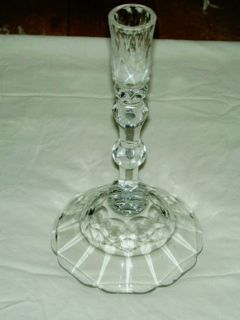 |
1760-1780 |
Unknown |
Northern Europe |
nonlead glass |
11" H |
|
Purchase, 1960 |
Purchase, William C. Kennedy, 6/28/60 |
0 |
|
Similar candlestick illustrated as plate 264 in Hughs, Bernard G. English, Scottish and Irish Table Glass. Bramhall house: 1956. |
The candlesticks are facet-cut all over and have a knopped shaft below a cylindrical candle socket and stand on a faceted dome foot. |
LOCATION UPDATE: MOVED TO DINING ROOM AS OF MARCH 2007 An interesting sidelight on these glass candlesticks and other glass articles in the mansion from Candlesticks, by Geoffrey Wills: Crown, 1974: "These 18th century glass candlesticks have domed glass bases, as do all standing articles from wine glasses onwards until 1800. The purpose was to lift clear of the surface the 'pontil mark', the rough scar produced during manufacture. After 1800 it was ground flat. |
Lighting |
0 |
| TRUE |
Set of three wine glasses |
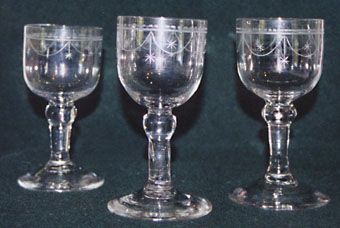 |
1770-1790 |
Unknown |
England or Ireland |
lead glass |
4 3/8" H |
|
Gift of Mr. Richard Kelly, 1999 |
Gift of Mr. Richard Kelly, Garrison, NY 12/99 |
0 |
|
|
Set of three blown, colorless wineglasses; hemispherical bowls on thick cylindrical stems with ball knop below bowl; conical feet. Bowls engraved with dotted border, swags, and suspended stars. The three wine glasses vary from one another in shape and size. |
|
Glass |
0 |
| TRUE |
Pair of decanters |
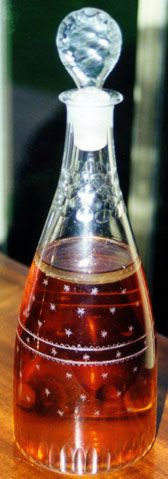 |
c. 1790 |
Unknown |
Ireland or England |
lead glass |
11 3/4" H |
|
Gift of Mr. Richard Kelly, 1999 |
Gift of Mr. Richard Kelly, Garrison, NY 12/99 |
0 |
|
|
Pair of blown, colorless lead glass decanters of tapered form with facet-cut necks and cut flutes around the bases; engraved stars on the body above and below a central band containing stars. Stoppers with each decanter are flat, tear-shaped, and facet-cut. |
|
Glass |
0 |
| TRUE |
Hanging cupboard |
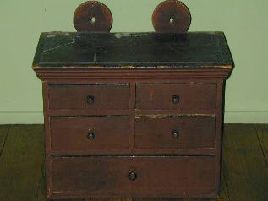 |
1775-1825 |
Unknown |
Northeastern United States |
Pine |
21 1/2 x 11 5/8" |
|
Purchase, 1962 |
Purchase, William C. Kennedy 4/24/62 |
0 |
|
|
Hanging wall cupboard with two tiers of two side-by-side drawers above one long drawer, each with a single wooden knob in the center. A cornice molding encircles the top. The cupboard is suspended from the wall by two large rounded tabs that are continuations of the vertical backboards. The case and drawers are dovetailed. All exterior surfaces of the front and sides are painted red. |
|
Furniture |
0 |
| TRUE |
Lidded Jar |
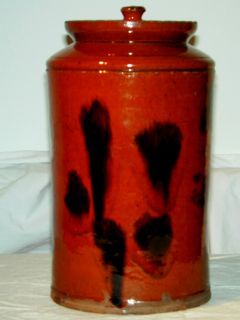 |
c. 1800 |
Unknown |
American |
Pottery |
11" H |
None |
Purchase, 1961 |
Purchase, Mary Allis, Fairfield, CT 6/5/61 |
0 |
|
|
Redware jar with cover: tall, cylindrical glazed jar, brown with manganese splash decoration. |
|
Ceramics |
0 |
| TRUE |
Jug |
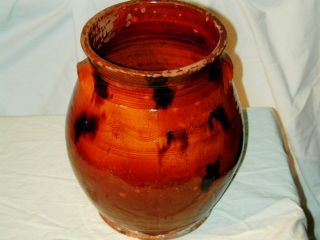 |
c. 1800 |
Unknown |
American |
Pottery |
12" H |
None |
Purchase, 1961 |
Purchase, Mary Allis, Fairfield, CT 1961 |
0 |
|
|
Redware jar: beanpot shaped, glazed with splash decorations and dog-ear handles. Glaze reaches to one inch from the bottom. Manganese glazed. |
|
Ceramics |
0 |
| TRUE |
Beanpot |
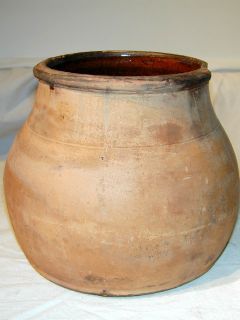 |
c. 1800 |
Unknown |
American |
Pottery |
8" H |
|
Purchase, 1961 |
Purchase, Mary Allis, Fairfield, CT 6/5/61 |
0 |
|
|
Unglazed beanpot: redware, inside is glazed brown. |
|
Ceramics |
0 |
| TRUE |
Jug |
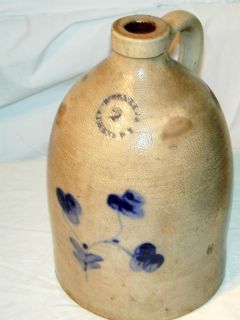 |
1860-1870 |
Nathan Clark, Jr. |
Athens, New York |
Pottery |
13 1/2" H |
A circle incised near neck marked: N. CLARK JR. ATHENS NY 2. |
Purchase, 1961 |
Purchase, Mary Allis, Fairfield, CT 3/21/61 |
0 |
Franco, Barbara. Stoneware made by the White family in Utica New York. Reprinted from Antiques, June: 1971 in Boscobel files. Potters and Potteries of New York State, 1650-1900 by William C. Ketchum, Jr. Page 134 |
|
Stoneware jug: grey stoneware with blue flowers. |
In 1843 the Clark pottery passed to Nathan Clark's son, also Nathan (1819 1891), who had been extensively trained under his father tutelage. He ran the business effectively for nearly fifty years, gradually expanding until it was one of the largest operations in the United States. Throughout this period many skilled potters who were trained at the Clark pottery went on to successful careers in other parts of the state.(15) |
Ceramics |
0 |
| TRUE |
Beanpot |
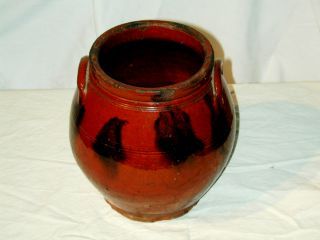 |
c. 1800 |
Unknown |
American |
Pottery |
8 1/2" H |
|
Purchase, 1961 |
Purchase, Mary Allis, Fairfield, CT 6/5/61 |
0 |
|
|
Redware beanpot: glazed, with splash decoration and incised lines around body. Dog-ear handles, glazed to one inch from bottom. |
|
Ceramics |
0 |
| TRUE |
Crock |
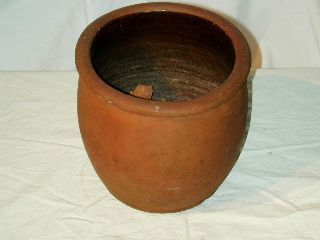 |
Early 19th century; 1820-40 |
Unknown |
American |
Pottery |
7" H |
|
Purchase, 1961 |
Purchase, 1961 |
0 |
|
|
Crock: unglazed redware. |
|
Ceramics |
0 |
| TRUE |
Milk Pan |
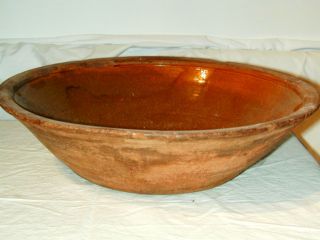 |
c. 1800 |
Unknown |
American |
glazed redware |
4" H |
|
Purchase, 1961 |
Purchase, Mary Allis, Fairfield CT 1961 |
0 |
|
|
Redware basin: or milk pan, glazed on the inside. |
|
Ceramics |
0 |
| TRUE |
Colander |
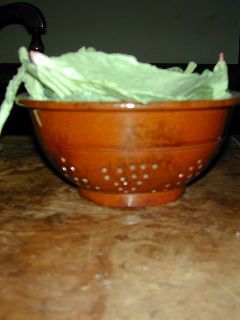 |
c. 1800 |
Unknown |
American |
Glazed redware |
10" Dia. |
|
Purchase,1961 |
Purchase, William C. Kennedy 6/5/61 |
0 |
|
|
Colander: glazed redware, very rare. |
Appraised as Bennington, Sothebys, Parke Bernet 6/28/74 |
Ceramics |
0 |
| TRUE |
Crock |
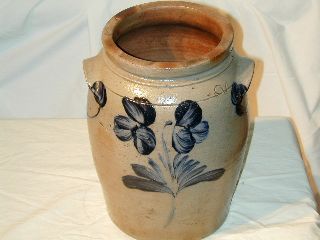 |
c. 1800 |
Unknown |
American |
salt-glazed stoneware |
13 1/2" H |
# 2 incised in band around neck. |
Purchase, 1961 |
Purchase, Mary Allis, Bronson Road, Greenfield Hills, CT 3/21/61 |
0 |
|
|
Grey stoneware crock: dog ear handles, blue flowers. |
|
Ceramics |
0 |
| TRUE |
Mug |
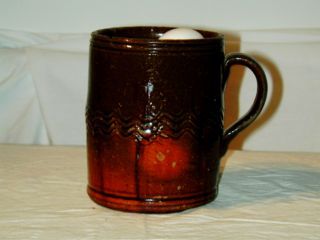 |
c. 1800 |
Unknown |
American |
Pottery |
9 1/2" H, 4 1/2" Dia. |
|
Purchase, 1961 |
Purchase, Mary Allis, Bronson Road, Fairfield Hills, CT 6/5/61 |
0 |
|
|
Glazed redware pottery mug: scratched bands around body and rim. |
|
Ceramics |
0 |
| TRUE |
Jug |
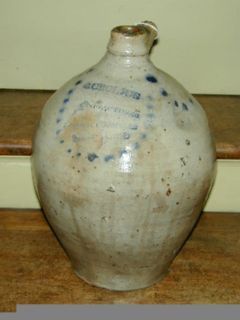 |
1810-30 |
C. Crolius |
New York City |
salt-glazed stoneware |
14" H |
C. CROLIUS / MANUFACTURER / MANHATTAN-WELLS / NEW- YORK |
Purchase, 1961 |
Purchase, Paul Weld 3/21/61 |
0 |
Kethcum, William C. Jr. Early Potters and Potteries of New York State: Funk and Wagnalls, 1970, pp. 29-30. See also reprints about New York State Potters in the Boscobel reprints folder. |
|
Stoneware jug: grey with cobalt-blue spotted decorations, small base, one handle. |
|
Ceramics |
0 |
| TRUE |
Pitcher |
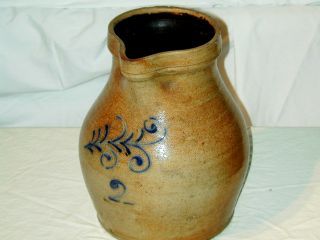 |
c. 1800 |
Unknown |
American; possibly Hudson Valley or Athens, NY |
Pottery |
12" H |
Marked on bottom: 2 |
Purchase, 1961 |
Purchase, William C. Kennedy 3/21/61 |
0 |
|
|
Stoneware pitcher: blue leaf scroll trim, brown glazed inside. |
Scarce decorated pitcher, according to George H. Lukacs author of Poughkeepsie Potters, who inspected the piece on 12/21/2006 |
Ceramics |
0 |
| TRUE |
Serving utensils |
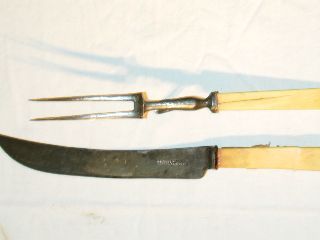 |
Early 19th century |
Unknown |
American |
Ivory and steel |
Fork: 9 1/2" L, Knife: 12 1/8" L |
Marked: TILLOTSON S rar STEEL |
Purchase, 1961 |
Purchase, Mary Allis, Bronson Road, Greenfield Hills, Fairfield, CT 1961 |
0 |
|
|
Carving knife and fork: ivory handled, steel blade and tines. Fork has rest and two tines. Knife has curved blade. |
|
Household Items |
0 |
| TRUE |
Set of six spoons |
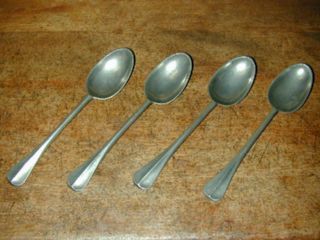 |
20 the century |
Laurits Christian Eichner |
United States |
Pewter |
7 1/2" L |
EICHNER |
Purchase, 1961 |
Purchase, 1961 |
0 |
|
|
6 pewter dessert spoons: molded Hanoverian mid-rib type with "rat-tail" on back of bowl. |
During kitchen inventory, only four spoons (a,b,c,e) have been located. Eichner, Danish American (1894-1967) |
Household Items |
0 |
| TRUE |
Flatware |
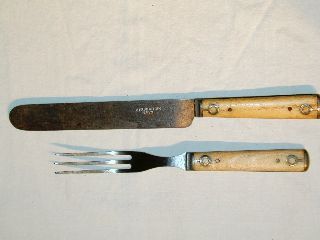 |
late 19th or 20th century |
Unknown |
United States |
bone and steel |
Knives: 9-5/8, Forks: 7-3/4 |
Knives marked "ASSOCIATION / 1879" |
Purchase, 1961 |
Purchase, Mary Allis, Bronson Road, Greenfield Hills, Fairfield, CT, 5/29/61 |
0 |
|
|
3 forks and 8 knives with bone handles and brass circles in handles. Handles attached with six brass pins. |
Displayed on table. |
Household Items |
0 |
| TRUE |
Flatware |
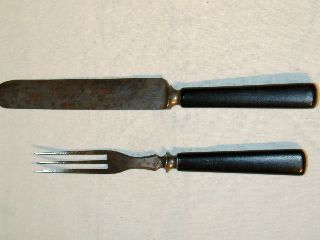 |
19th century |
Star Cutlery |
Oneida, New York |
Steel and wood |
Knife: 8" L Fork: 6 3/4" L |
|
Gift of Howell W. Covert, 1961 |
Gift of Howell W. Covert, 12/14/61 |
0 |
|
|
1 Knife and 2 forks with black wood handles and steel tines and blades. Forks have three tines. |
|
Household Items |
0 |
| TRUE |
Flatware |
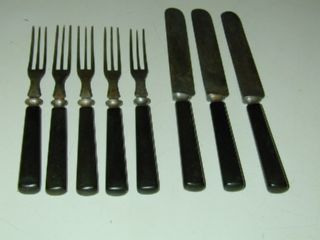 |
1850-1900 |
Unknown |
United States |
Black rubber and steel |
knives are about 8-1/8; forks are about 6-3/4 |
"HARD RUBBER CUTLERY" on knives; "STEEL" on forks |
Gift of Howell W. Covert, 1961 |
Gift of Howell W. Covert, 12/14/61 |
0 |
|
|
4 knives, 5 forks: with black rubber handles and steel blades and tines. Forks have 3 tines. |
|
Household Items |
0 |
| TRUE |
Knife and fork holder |
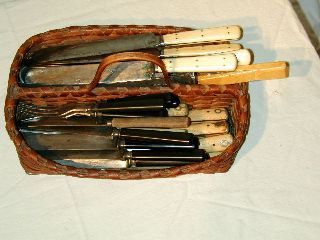 |
19th century |
Unknown |
American |
Wood splints |
10 3/4" L 8 1/4" W 5 1/2" H |
|
Purchase, 1961 |
Purchase, Mary Allis, Bronson Road, Greenfield Hills, Fairfield, CT 5/29/61 |
0 |
|
|
Woven knife and fork holder: splint basket construction, rectangular with divider in center and carrying handle. |
|
Household Items |
0 |
| TRUE |
Grader |
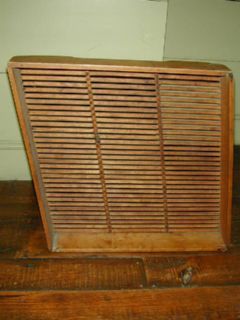 |
Early 19th century |
Unknown |
American |
Wood |
18" L, 3 1/2" H |
|
Purchase, 1961 |
Purchase, William C. Kennedy 6/5/61 |
0 |
|
|
Wooden bean grader: adjustable square frame with slats for grading and drying vegetables. |
This frame can be changed from square to triangular shape, thus narrowing the space between the slats. Metal screw for tightening. |
Household Items |
0 |
| TRUE |
Herb Poles |
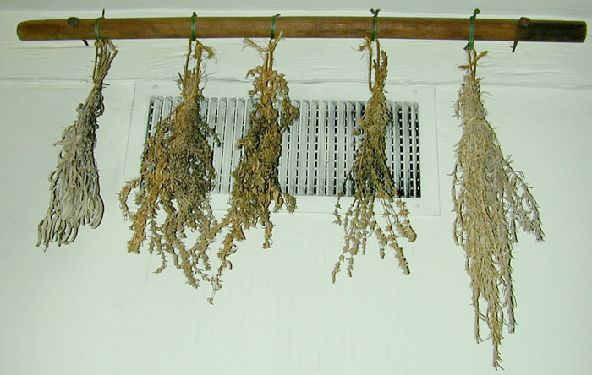 |
c. 1800 |
Unknown |
American |
Wooden poles with metal hooks |
72 and 41" L |
|
Purchase, 1961 |
Purhcase, William C. Kennedy 6/5/61 |
0 |
|
|
Herb poles: two wooden poles for hanging herbs, with hangers and old nails. |
|
Household Items |
0 |
| TRUE |
Jug |
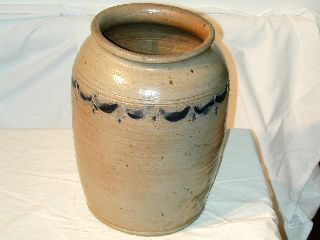 |
1802-19 |
Thomas H. Commereau, Manhattan, NY |
New York City, New York |
Pottery |
13 1/2" H |
Marked: COMMERAWD STONEWARE |
Purchase, 1965 |
Purchase, William C. Kennedy through Paul Weld, 9/15/65 |
0 |
Early Potters and Potteries of New York State. William C. Ketchum Jr. pp 34-35, 227. |
|
Stoneware jug: grey with impressed blue swags and tassels at swelling below incised bands. |
Thomas Commereau operated a pottery at Carlear's Hook, Manhattan, in 1802 and worked there until 1819. However, his appearance in the directories was sporadic after 1811. |
Ceramics |
0 |
| TRUE |
Jar |
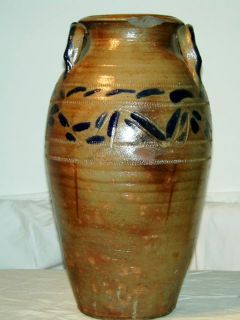 |
c. 1800; pre-1840 |
Unknown |
American; possibly PA |
Pottery |
17 1/2" H |
None |
Purchase, 1965 |
Purchase, William C. Kennedy through Paul Weld 9/15/65 |
0 |
|
|
Honey or all purpose jar: grey glazed redware with blue leaf trim, incised lines around body, blue loop handles and tapered sides; coggle wheel decoration; |
According to George H. Lukacs, author of Poughkeepsie Pottery, the use of extended handles indicates date of piece is pre-1840. |
Ceramics |
0 |
| TRUE |
Redware covers |
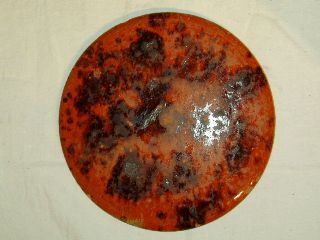 |
c. 1800 |
Unknown |
American |
Pottery |
(a) 7-7/8 D. (b) 7-1/4 D. |
|
Purchase, 1966 |
Purchase, H. Gregory Gulick, Middletown, NJ 1/21/66 |
0 |
|
|
Redware covers: 2 flat covers, glazed and mottled with brown. |
|
Ceramics |
0 |
| TRUE |
Jug |
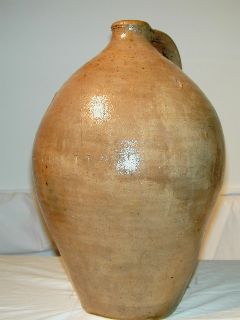 |
1806-1833; near 1815 |
Paul Cushman, Albany |
Albany. New York |
Stoneware pottery |
17" H 16" Dia. |
Incised: PAUL CUSHMAN |
Purchase, 1966 |
Purchase, William C. Kennedy through Paul Weld 2/8/66 |
0 |
Ketchum, William G. Early Potters and Potteries of New York State. Pages 88-89. |
|
Stoneware jug: small mouth, one handle; early ovoid shape |
Ketchum states that the Cushman shop operated from 1806 to 1834, and that his products are eagerly sought by museums and collectors, mainly for their age and variety. He worked in the Albany area of NY. |
Ceramics |
0 |
| TRUE |
Lantern |
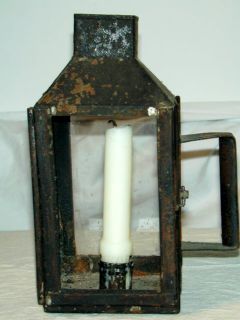 |
c. 1800 |
Unknown |
American |
Tole and glass |
9" H |
|
Purchase, 1961 |
Purchase, Mary Allis, Bronson Road, Greenfield Hills, Fairfield, CT 3/29/61 |
0 |
|
|
Lantern: square tole carrying lantern, glass sides. |
|
Lighting |
0 |
| TRUE |
Jug |
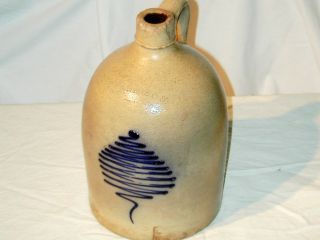 |
1882-90 |
Unknown |
Utica, New York |
Pottery |
11" H |
N.A. WHITE AND SON UTICA NY |
Purchase, 1966 |
Purchase, William C. Kennedy 2/8/66 |
0 |
Potters and Potteries of New York Stae by William C. Kethum, Jr. page 292-296 |
|
Small neck jug: salt glazed stoneware, blue decoration on front with "Christmas tree" decoration. |
This jug is mentioned in an article reprinted from Antiques Magazine, June 1971: "Stoneware made by the White family in Utica, NY." It is available in Boscobel's ceramics file. Nicolas A. White, son of Noah White joined the White Pottery in 1838. In 1867, the company name changed to N.A.White and Son, reflecting the advance to partnership of William N. |
Ceramics |
0 |
| TRUE |
Jug |
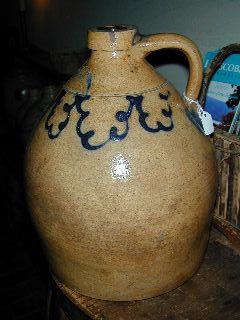 |
1842-43 |
Unknown |
Poughkeepsie, New York |
Pottery |
12 1/2" H |
J B CAIRE & CO. POKEEPSIE |
Purchase, 1966 |
Purchase, Paul Weld 2/8/66 |
0 |
Ketchum, William C. Jr., Early Potters and Potteries of New York State. Funk and Wagnalls, 1970, p. 237. Remensnyder, John. Potters of Poughkeepsie, reprint from Antiques Magazine, p. 92. |
|
Grey stoneware jug: small neck, blue scallops around neck. |
|
Ceramics |
0 |
| TRUE |
Jug |
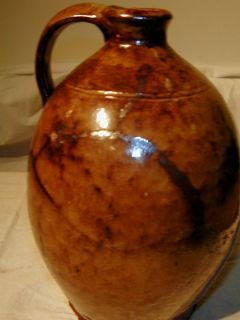 |
c. 1800 |
Unknown |
American |
Pottery |
11" H |
|
Purchase, 1970 |
Purchase, Farmer's Museum, Cooperstown, NY 5/25/70 |
0 |
|
|
Jug: mottled brown, one handle, redware with lead glaze. |
|
Ceramics |
0 |
| TRUE |
Jug |
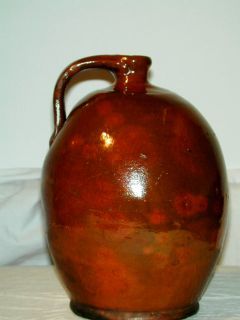 |
c. 1800 |
Unknown |
American; possibly Cornwall, New York |
Pottery |
12" H |
|
Purchase, 1970 |
Purchase, Farmer's Museum, Cooperstown, NY 5/25/70 |
0 |
|
|
Brown jug: glazed redware, one handle, small neck. |
|
Ceramics |
0 |
| TRUE |
Chandelier |
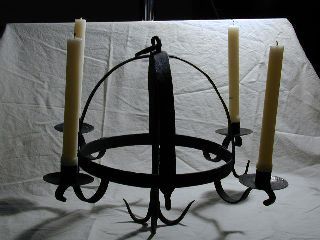 |
c. 1800 |
Unknown |
American |
Wrought iron |
15" H x 20" Dia |
|
Purchase, 1961 |
Purchase, Mary Allis, Fairfield, CT 5/29/61 [CANNOT LOCATED INVOICE AS OF 11/18/03] |
0 |
|
|
Chandelier: wrought iron, dome-shaped top, with four scroll arms with candles. Hooks for untensils around rim. |
|
Lighting |
0 |
| TRUE |
Candlestick |
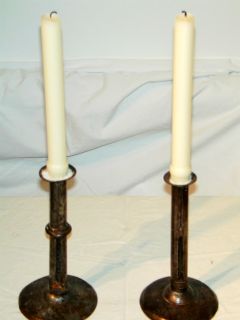 |
c. 1800 |
Unknown |
American |
Iron, tinned |
8" H |
|
Purchase, 1961 |
Purchase, Mary Allis, Fairfield, CT 3/21/61 |
0 |
|
|
Candlesticks: one pair ejector type iron. |
|
Lighting |
0 |
| TRUE |
Candlestick |
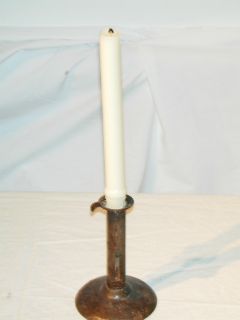 |
c. 1800 |
Unknown |
American |
Iron, tinned |
4 1/2" H |
|
Purchase, 1961 |
Purchase, Mary Allis, Fairfield, CT 3/21/61 |
0 |
|
|
Candlestick: black iron, plain standard with circular base. |
|
Lighting |
0 |
| TRUE |
Rotating Broiler |
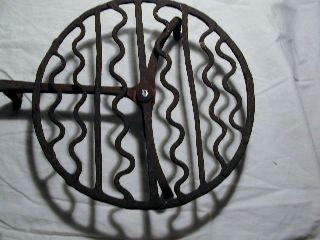 |
Early 19th century |
Unknown |
American |
Iron |
21 1/2" L x 10 5/8" Dia |
|
Purchase, 1961 |
Purchase, Mary Allis, Fairfield, CT 3/21/61 |
0 |
|
|
Rotating broiler: on trivet feet, with wavy bars and long handle. |
|
Household Items |
0 |
| TRUE |
Tongs |
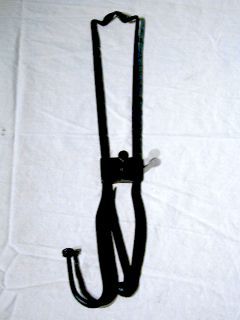 |
c. 1800 |
Unknown |
American |
Iron |
16 1/2" L |
|
Purchase, 1961 |
Purchase, Mary Allis, Fairfield, CT 3/21/61 |
0 |
|
|
Pipe tongs: with spring closing to hold a hot coal for lighting pipes, etc. |
|
Household Items |
0 |
| TRUE |
Skewers |
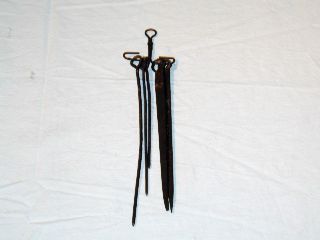 |
c. 1800 |
Unknown |
American |
Iron |
(a) 9" L, (b) 7 1/2" L, (c) 6 1/4" L |
|
Purchase, 1961 |
Purchase, Mary Allis, Fairfield, CT 1961 |
0 |
|
|
Skewers and holder: three skewers in wire holder. |
|
Household Items |
0 |
| TRUE |
Skewers |
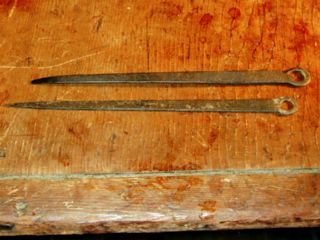 |
Early 19th centruy |
Unknown |
American |
Iron |
8 1/2" L |
|
Purchase, 1961 |
Purchase, 1961 |
0 |
|
|
Skewers: two flattened iron skewers with pointed ends and rat tail loops. |
|
Household Items |
0 |
| TRUE |
Ladle |
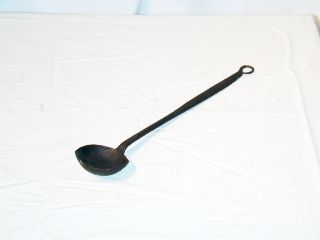 |
c. 1800 |
Unknown |
American |
Iron |
13 7/8" L |
|
Purchase, 1961 |
Purchase, Mary Allis, Fairfield, CT 1961 |
0 |
|
|
Iron spoon: with rat tail handle. |
|
Household Items |
0 |
| TRUE |
Spatula |
 |
Early 19th century |
Unknown |
American |
Iron |
13 7/8" L |
|
Purchase, 1961 |
Purchase, Mary Allis, Fairfield, CT 1961 |
0 |
|
|
Iron spatula: with hanging loop, rat tail shape. |
|
Household Items |
0 |
| TRUE |
Ladle |
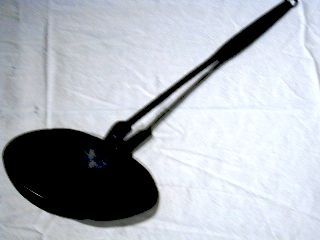 |
c. 1800 |
Unknown |
American |
Iron |
20" L |
|
Purchase, 1961 |
Purchase, William C. Kennedy 6/5/61 |
0 |
|
|
Spoon: iron deep ladeling spoon with long handle, rat tail end. |
|
Household Items |
0 |
| TRUE |
whirling toaster |
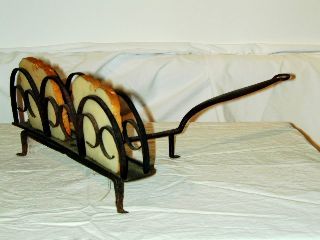 |
18th century |
Unknown |
American |
Iron |
16 3/4" L x 12 1/2" H |
|
Purchase, 1961 |
Purchase, Mary Allis, Fairfield, CT 3/21/61 |
0 |
|
|
Wrought iron rotary toaster with handle and triple arched grill frame with scroll embellishments, supports on legs with shaped feet and rattail hanger. |
|
Household Items |
0 |
| TRUE |
Trammel |
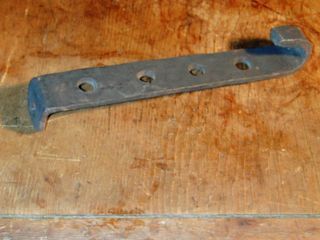 |
Late 18th century |
Unknown |
American |
Wrought Iron |
14" L |
|
Purchase, 1961 |
Purchase, Mary Allis, Fairfield, CT 1961 |
0 |
|
|
Trammel: adjustable pot hook for fireplace crane. |
|
Household Items |
0 |
| TRUE |
Coal Scoop |
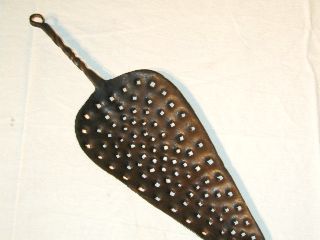 |
Late 18th century |
Unknown |
American |
Wrought Iron |
15" L x 5 3/8" W |
|
Purchase, 1961 |
Purchase, Mary Allis, Fairfield, CT 5/29/61 |
0 |
|
|
Coal Scoop: primative spade- shaped, perforated, with twisted rat tail handle. |
|
Household Items |
0 |
| TRUE |
Skimmer |
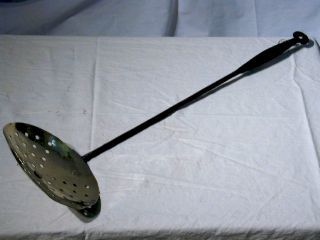 |
c. 1800 |
Unknown |
English |
Brass and iron |
26" L x 6 1/2" Dia |
|
Purchase, 1961 |
Purchase, Mary Allis, Fairfield, CT 3/21/61 |
0 |
English Domestic Brass, 1680-1810. Gentle, Rupert and Field, Rachael. Reprint of illustration of similar skimmer in the Boscobel files. |
|
Skimmer: perforated brass, with iron handle. |
|
Household Items |
0 |
| TRUE |
Griddle |
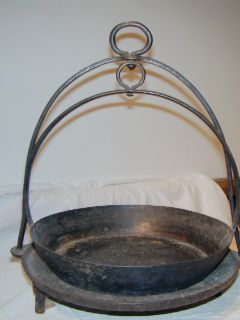 |
Early 19th century |
Unknown |
American |
Wrought iron |
17 3/4" L |
|
Purchase, 1961 |
Purchase, Mary Allis, Fairfield, CT 5/29/61 |
0 |
|
|
Griddle: with fixed bail handle and loop for hanging. |
|
Household Items |
0 |
| TRUE |
Frying Pan |
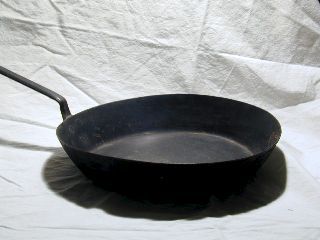 |
Early 19th century |
Unknown |
American |
Iron |
25 1/8" L |
Stamped in handle: WHITFIELD 9 |
Purchase, 1961 |
Purchase, Mary Allis, Fairfield, Ct 6/5/61 |
0 |
|
|
Frying pan: black iron with long handle, rat tail loop. |
|
Household Items |
0 |
| TRUE |
Trivet |
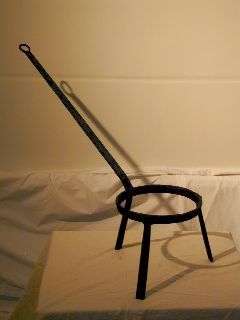 |
Early 19th century |
Unknown |
American |
Iron |
8 3/4" H x 33" L x 9 1/2" Dia |
|
Purchase, 1961 |
Purchase, Mary Allis, Fairfield, CT 6/5/61 |
0 |
|
|
Trivet: three legged with open ring and a long handle. |
|
Household Items |
0 |
| TRUE |
Andirons |
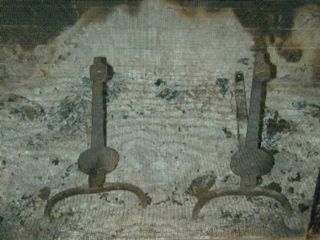 |
Early 19th century |
Unknown |
American |
Wrought iron |
21" H |
|
Purchase, 1961 |
Purchase, Mary Allis, Farifield, CT 5/29/61 |
0 |
|
|
Andirons: wrought iron gooseneck style with flat disk in standard. |
|
Household Items |
0 |
| TRUE |
Crane |
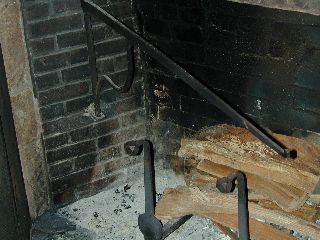 |
Early 19th century |
Unknown |
American |
Wrought iron |
46" L |
|
Purchase, 1961 |
Purchase, Mary Allis, Fairfield, CT 3/21/61 |
0 |
|
|
Crane for fireplaces and two pintles: wrought iron crane, with two pintles to hold it into the brick fireplace. |
|
Household Items |
0 |
| TRUE |
Shovel and tong |
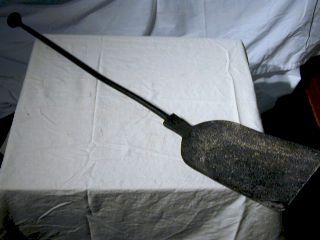 |
Early 19th century |
Unknown |
American |
Wrought iron |
36 1/2" L |
|
Purchase, 1961 |
Purchase, Mary Allis, Fairfield, CT 5/29/61 |
0 |
|
|
Shovel: wrought iron long handles ash shovel with mushroom-shaped handle. |
4/15/03 - Tong has not been located. |
Household Items |
0 |
| TRUE |
Poker |
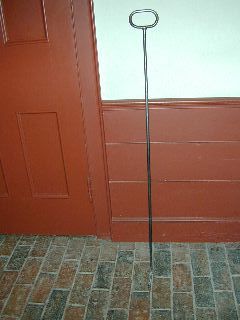 |
Early 19th century |
Unknown |
American |
Wrought iron |
49" L |
|
Purchase, 1961 |
Purchase, 1961 |
0 |
|
|
Poker: wrought iron rod with rectangular loop handle and end bent at right angles. |
|
Household Items |
0 |
| TRUE |
Flesh fork |
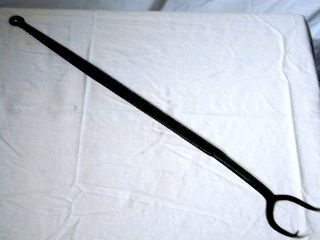 |
1750-1850 |
Unknown |
Probably American |
Iron |
25 1/2" L |
|
Purchase, 1961 |
Purchase, William C. Kennedy 6/5/61 |
0 |
|
|
The wrought iron flesh fork has two tines and a long, flat handle terminating in a hanging loop. The tine tips should be straight. "Flesh fork" is a period term. |
|
Household Items |
0 |
| TRUE |
Kettle |
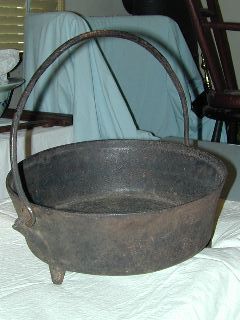 |
c. 1800 |
Unknown |
American |
Iron |
6" H x 12" Dia |
|
Purchase, 1961 |
Purchase, Mary Allis, Fairfield, CT 3/21/61 |
0 |
|
|
Kettle: dutch oven type, without cover, on three legs. |
|
Household Items |
0 |
| TRUE |
Stove |
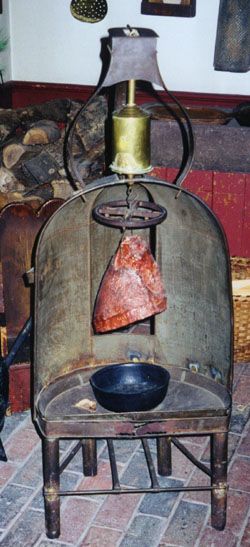 |
1800-1810 |
UnknownJOHN LINWOOD (clock jack) |
England |
Painted and tinned sheet iron, brass |
51" H x 20 1/2" W x 13 1/2" D |
Clock jack marked: "JOHN LINWOOD WARRENTED" |
Purchase, 1961 |
Purchase, Mary Allis, Fairfield, CT 3/21/61 |
0 |
|
|
Stove: tin, painted black, concave shape with a basting door in the rear and a covered drip pan. Brass clock jack for rotating the spit. Referred to as a Liverpool oven. |
|
Household Items |
0 |
| TRUE |
Bowl |
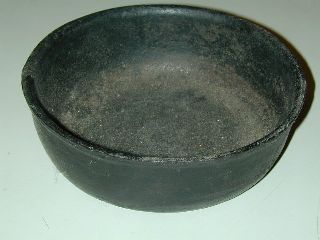 |
c. 1800 |
Unknown |
American |
Cast iron |
8 1/2" Dia |
|
Purchase, 1961 |
Purchase, William C. Kennedy 6/5/61 |
0 |
|
|
Bowl: small iron bowl. |
|
Household Items |
0 |
| TRUE |
Crown Spit |
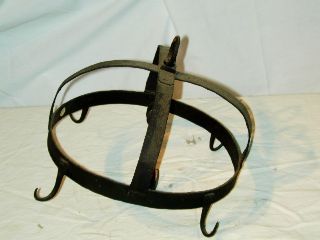 |
Early 19th century |
Unknown |
American |
Wrought iron |
10" Dia |
|
Purchase, 1961 |
Purchase, Mary Allis, Fairfield, CT 3/21/61 Ducks from D.J. Guccione, NYC 1961 |
0 |
|
|
Crown spit: wrought iron crown shaped spit with three pronged hook hanging from the center and two stuffed fowl (brown ducks). |
|
Household Items |
0 |
| TRUE |
Birdcage |
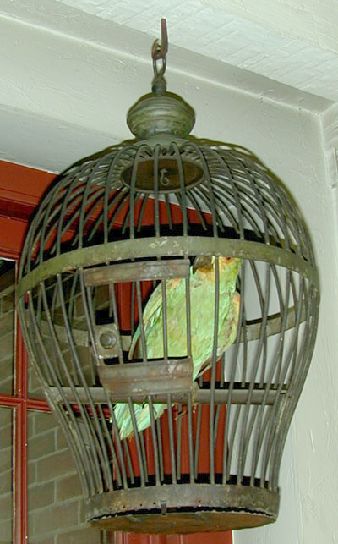 |
c. 1800 |
Unknown |
American |
Tin |
22" H |
|
Purchase, 1961 |
Purchase, Mary Allis, Fairfield, CT 5/29/61 |
0 |
|
|
Birdcage with stuffed parrot: tin balloon-shaped cage with hanging hook included. |
|
Household Items |
0 |
| TRUE |
Flatirons |
 |
c. 1800 |
Unknown |
American |
Wrought iron |
(a) 5" L (b) 4 1/8" L |
|
Purchase, 1961 |
Purchase, Mary Allis, Fairfield, CT 3/21/61 |
0 |
|
|
Sad Irons: two small flatirons with self handles, one losenge shaped and the other wedge shaped. |
|
Household Items |
0 |
| TRUE |
Tinder box |
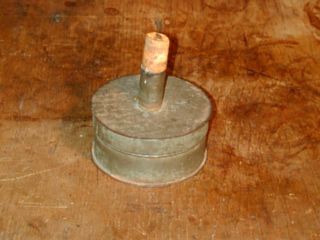 |
1800-1850 |
Unknown |
American |
Tinned sheet iron |
4 3/4" H x 4 3/8" Dia |
|
Purchase, 1961 |
Purchase, Mary Allis, Fairfield, CT 5/29/61 |
0 |
|
|
Tinder box and flint: drum shaped tin box with candle holder on top containing old candle. Inside is a flat disk for a divider and flint, steel and textile fluff. |
|
Lighting |
0 |
| TRUE |
Cooking fork |
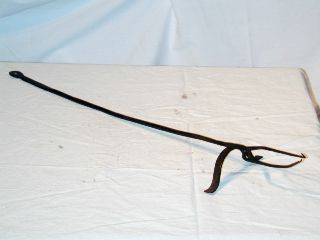 |
1750-1850 |
Unknown |
United States or England |
Iron |
23 1/4" L |
|
Purchase, 1961 |
Purchase, William C. Kennedy 6/5/61 |
0 |
|
|
The wrought iron two-tined fork has two legs riveted near the tines to allow the fork to stand on the floor in a fireplace. |
|
Household Items |
0 |
| TRUE |
Peel |
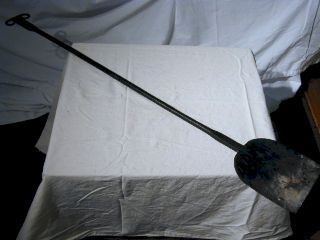 |
c. 1800 |
Unknown |
American |
Wrought iron |
45" L |
|
Purchase, 1961 |
Purchase, Mary Allis, Fairfield, CT 5/29/61 |
0 |
|
|
Peel: long handled flat bladed instrument for removing baked goods from the dutch oven. Ram's head shaped finial on handle. |
|
Household Items |
0 |
| TRUE |
Basin |
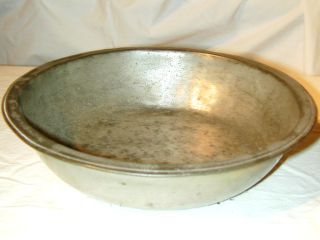 |
Early 19th century |
Unknown |
London, England |
Pewter |
10 3/8" Dia |
Marked: "[?]PIGGOTT[?]" and "[?]NDON" |
Purchase, 1961 |
Purchase, Mary Allis, Fairfield, CT 3/21/61 |
0 |
|
|
The pewter basin has a molded lip. |
|
Household Items |
0 |
| TRUE |
Pail |
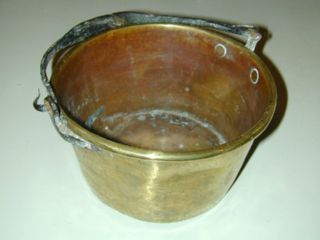 |
Early 19th century |
Unknown |
American |
Brass, iron and copper |
5" H x 8 1/2" Dia |
|
Purchase, 1961 |
Purchase, Mary Allis, Fairfield, CT 5/5/61 |
0 |
|
|
Pail: brass with iron bail handle, rat tail ends attached with copper rivets. |
|
Household Items |
0 |
| TRUE |
Bowl |
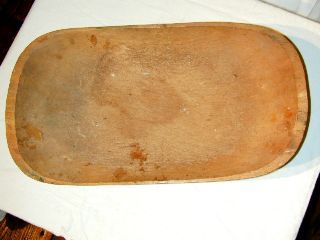 |
Early 19th century |
Unknown |
American |
Wood |
18 1/2" L x 9 7/8" W |
|
Purchase, 1961 |
Purchase, 1961 |
0 |
|
|
Wooden bowl: rectangular in shape. |
|
Household Items |
0 |
| TRUE |
Bowl |
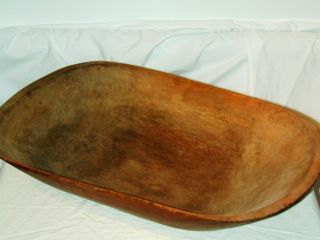 |
Early 19th century |
Unknown |
American |
Wood |
23" L x 15" W |
|
Purchase, 1961 |
Purchase, Mary Allis, Fairfield, CT 5/29/61 |
0 |
|
|
Bowl: rectangular unstained wood. |
|
Household Items |
0 |
| TRUE |
Grater |
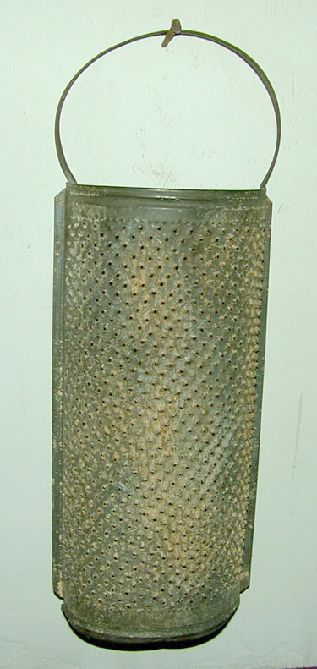 |
1800-1875 |
Unknown |
Probably United States |
Tinned iron |
18" L x 6 5/8" W |
|
Purchase, 1961 |
Purchase, Mary Allis, Fairfield, CT 5/29/61 |
0 |
|
|
Grater: large curved tin grater. |
|
Household Items |
0 |
| TRUE |
Ladle |
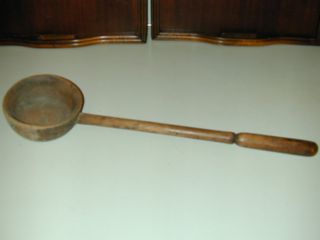 |
Early 19th century |
Unknown |
American |
Wood |
20" L x 5" Dia |
|
Purchase, 1961 |
Purchase, William C. Kennedy 6/5/61 |
0 |
|
|
Ladle: wooden, with turned handle. |
|
Household Items |
0 |
| TRUE |
Sieve |
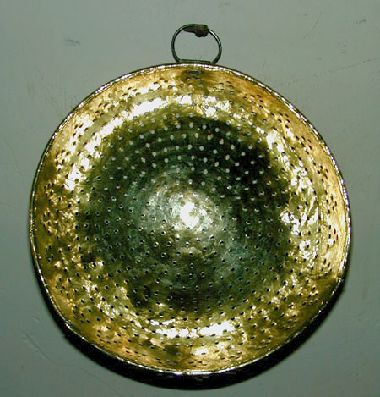 |
Early 19th century |
Unknown |
American |
Brass, iron |
8" Dia |
|
Purchase, 1961 |
Purchase, William C. Kennedy 6/5/61 |
0 |
|
|
Sieive: perforated brass bowl with iron handle on side. |
|
Household Items |
0 |
| TRUE |
Food Chopper |
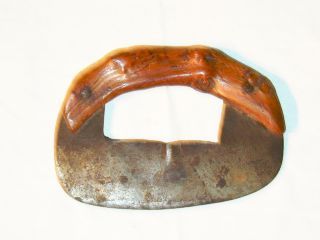 |
Early 19th century |
Unknown |
American |
Wood and iron |
6" L x 5 3/4" W |
|
Purchase, 1961 |
Purchase, Mary Allis, Fairfield, CT 3/21/61 |
0 |
|
|
Food chopper: rounded wooden handle with bumpy surface showing knots in wood. |
|
Household Items |
0 |
| TRUE |
Scouring Board |
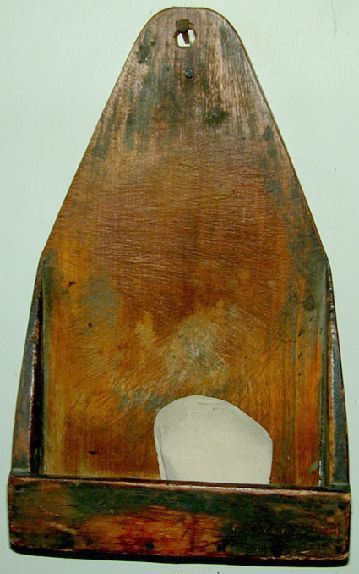 |
c. 1800 |
Unknown |
American |
Wood and pumice shelf |
14 1/2" H x 9" W |
|
Purchase, 1961 |
Purchase, Mary Allis, Fairfield, CT 3/21/61 |
0 |
|
|
Scouring board: with pumice, hanging board with closed shelf for pumice stone. |
|
Household Items |
0 |
| TRUE |
Bread Board |
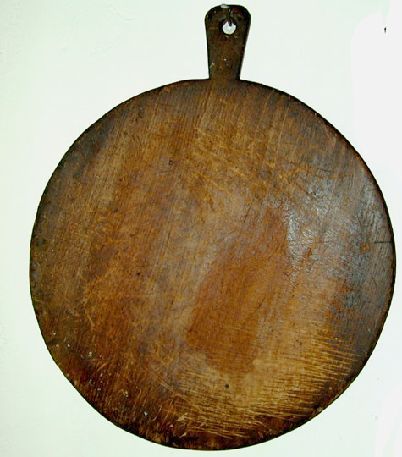 |
c. 1800 |
Unknown |
American |
Wood |
19" Dia |
|
Purchase, 1961 |
Purchase, Mary Allis, Fairfield, CT 1961 |
0 |
|
|
Bread Board: round wooden board with short handle at side. |
|
Household Items |
0 |
| TRUE |
Bread Slicer |
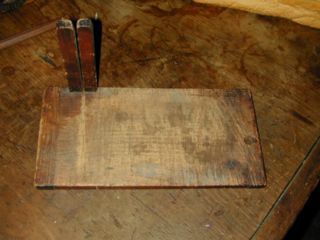 |
c. 1800 |
Unknown |
American |
Wood |
12" L x 5 15/16" W |
|
Purchase, 1961 |
Purchase, Mary Allis, Fairfield, CT 3/21/61 |
0 |
|
|
Bread board: rectangular, with cutting guide protruding vertically from one side. |
|
Household Items |
0 |
| TRUE |
Ladle |
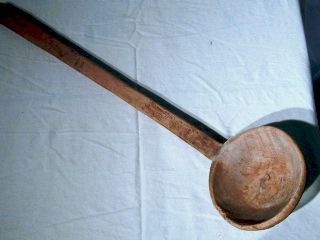 |
1800-1900 |
Unknown |
United States |
Maple (?) |
20" L x 6" Dia |
|
Purchase, 1961 |
Purchase, Mary Allis, Fairfield, CT 5/29/61 |
0 |
|
|
The wooden ladle has a long handle terminating in a round bowl. A notch under the handle and off-center toward the tip hooks the ladle on a bowl side. |
|
Household Items |
0 |
| TRUE |
Bowl |
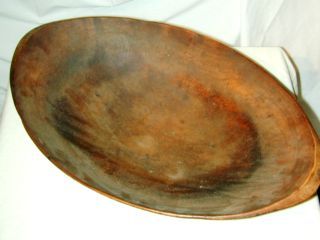 |
Early 19th century |
Unknown |
American |
Wood |
18 1/2" L x 9 7/8" W |
|
Purchase, 1961 |
Purchase, Mary Allis, Fairfield, CT 5/29/61 |
0 |
|
|
Wooden bowl: boat shaped, painted green. |
|
Household Items |
0 |
| TRUE |
Four bottles |
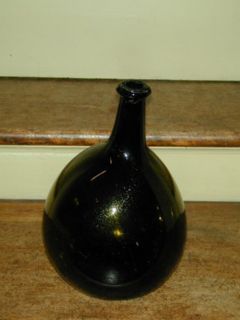 |
1750-1800 |
Unknown |
England or Europe |
Glass |
See description |
|
Purchase, 1961 |
Purchase, William C. Kennedy 5/29/61 |
0 |
|
|
Four bottles: olive-green and olive-amber glass spirit bottles. One larger than the three which are approximately the same size: (A) 11 1/2" H (B) 11 1/4" L (C) 11" L (D) 15 1/4" L (D) is modern. It is blown into a two-part mold with applied lip and no pontil mark on bottom. Stored in Rod House. |
|
Household Items |
0 |
| TRUE |
Mortar and Pestle |
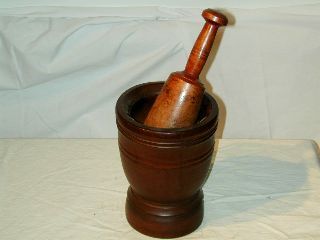 |
Early 19th century |
Unknown |
American |
Maple |
Motar: 8 1/8" H Pestle: 10 1/2" H |
|
Purchase, 1961 |
Purchase, William C. Kennedy 6/5/61 |
0 |
|
|
Mortar and pestle: treenware, painted red. |
|
Household Items |
0 |
| TRUE |
Jar |
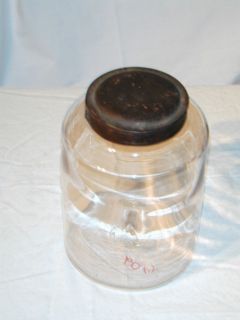 |
|
Unknown |
American |
Glass and tin |
|
|
Purchase, 1961 |
Purchase, Mary Allis, Fairfield, CT 5/29/61 |
0 |
|
|
Seven glass jars: blown glass, with tin covers. |
|
Household Items |
0 |
| TRUE |
Candle box |
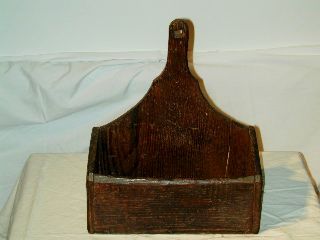 |
1800-1850 |
Unknown |
Probably England |
chestnut |
12-1/2 x 15 x 5-1/2 |
|
Purchase, 1961 |
Purchase, Mary Allis, Fairfield, CT 3/21/61 |
0 |
|
|
The five-board open-top candle box, assembled with nails, has a shaped back with a pierced tab in the center for hanging. The tops of the rectangular sides slope downward from back to front. and closed sides, hanging. The chestnut is worm-eaten. |
Chestnut does not occur as a primary wood in much American furniture. |
Household Items |
0 |
| TRUE |
Basket |
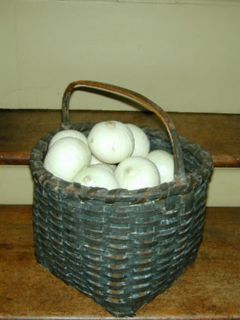 |
Early 19th century |
Unknown |
American |
Splint wood |
13 1/2" H x 11 1/2" D |
|
Purchase, 1961 |
Purchase, 1961 |
0 |
|
|
Splint basket: painted green, with fixed bail handle. |
|
Household Items |
0 |
| TRUE |
Butter Tub |
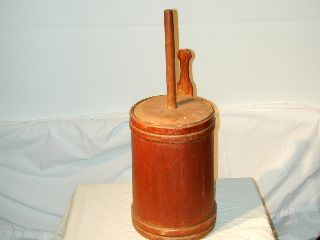 |
Early 19th century |
Unknown |
American |
Painted pine |
14" H x 9 1/2" D |
|
Purchase, 1961 |
Purchase, 1961 |
0 |
|
|
Butter churn: pine, painted red, with cover and dasher. Three pieces. |
|
Household Items |
0 |
| TRUE |
Mortar and Pestle |
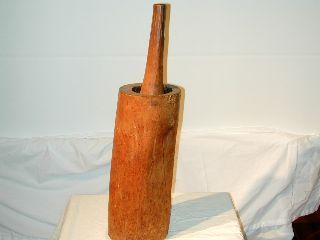 |
c. 1800 |
Unknown |
American |
Wood |
Mortar: 19" H x 6 3/4" D Pestle: 17 7/8" L x 3 3/4" Dia |
|
Purchase, 1961 |
Purchase, Mary Allis, Fairfield, CT 3/21/61 |
0 |
|
|
Wood mortar and pestle: cut from fruit wood trunk. |
|
Household Items |
0 |
| TRUE |
Candle mold |
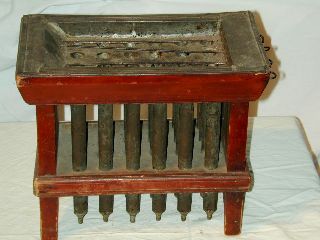 |
Early 19th century |
Unknown |
American |
Wood and tin |
11 1/8" H x 13 1/4" L |
Marked: "J. WALKER" |
Purchase, 1961 |
Purchase, Mary Allis, Fairfield, CT 3/21/61 |
0 |
|
|
Candle Mold: for 24 candles, tin molds fitted into a red painted rectangular wood frame, four rows of six candles with wire across the top for hanging the candles. |
|
Household Items |
0 |
| TRUE |
Peg Board |
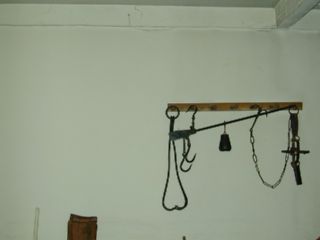 |
Early 19th century |
Unknown |
American |
Wood |
34" L |
|
Purchase, 1961 |
Purchase, Mary Allis, Fairfield, CT 6/5/61 |
0 |
|
|
Clothes hanging strip: unpainted wood with seven pegs with mushroom shaped ends. |
|
Household Items |
0 |
| TRUE |
Lifting hooks |
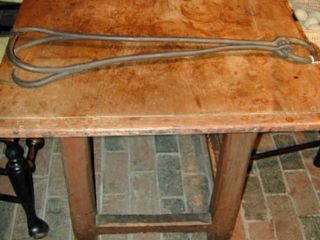 |
1800-1900 |
Unknown |
American |
Iron |
27" L |
|
Purchase, 1961 |
Purchase, Mary Allis, Fairfield, CT 1961 |
0 |
|
|
Lifting hooks: wrought iron, with fork ends, similar to ice tongs. |
|
Household Items |
0 |
| TRUE |
Animal trap |
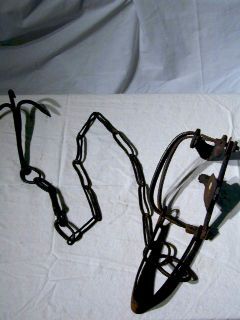 |
Early 19th century |
Unknown |
American |
Wrought iron |
64" L |
|
Purchase, 1961 |
Purchase, Mary Allis, Fairfield, CT 3/21/61 |
0 |
|
|
Animal trap: wrought iron, spring type trap for wolf or other animal, with chain. |
|
Household Items |
0 |
| TRUE |
Animal carrier |
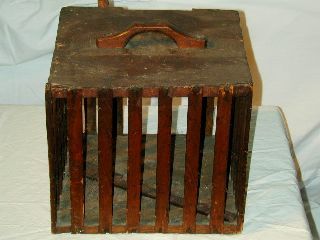 |
Early 19th century |
Unknown |
American |
Wood |
11" H x 11" W |
|
Purchase, 1961 |
Purchase, Mary Allis, Fairfield, CT 3/21/61 |
0 |
|
|
Animal carrier: box form wooden cage with bail handle, vertical sliding door. |
|
Household Items |
0 |
| TRUE |
Firearm |
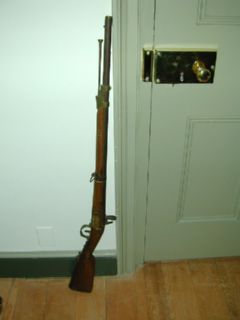 |
1750-1775 |
Unknown |
France |
Walnut, iron, steel, brass |
44" L |
Marked: "MANUFCTD TEMPLE CHARLEVILLE IV", with crown shape stamped into end of stock with T inside. |
Purchase, 1961 |
Purchase, Mary Allis, Fairfield, CT 3/21/61 |
0 |
|
|
Military flint-lock musket with single barrel, wood stock, brass lock plate and trigger guard, iron ramrod. |
|
Household Items |
0 |
| TRUE |
Firearm |
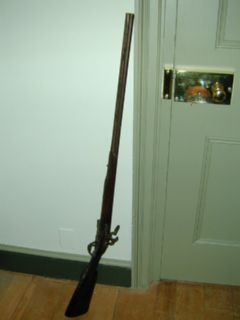 |
1770-1800 |
Unknown |
Europe, possibly German |
Steel, iron, brass, wood, silver |
49" L |
|
Purchase, 1961 |
Purchase, 1961 |
0 |
|
|
Double barrel fowling piece with flint locks, wood stock and ramrod, silver inlay on top of throat. Stock is decoratively carved with foliage motifs. |
|
Household Items |
0 |
| TRUE |
Rolling pin |
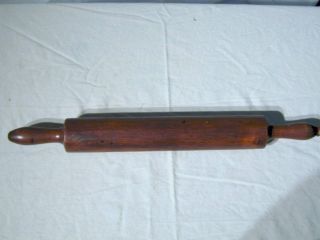 |
Early 19th century |
Unknown |
American |
Wood |
19 1/4" L |
|
Purchase, 1961 |
Purchase, Mary Allis, Fairfield, CT 6/5/61 |
0 |
|
|
Wooden rolling pin: with mushroom shaped end on one handle. |
|
Household Items |
0 |
| TRUE |
Kitchen untensils |
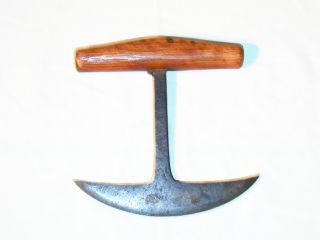 |
Early 19th century |
Unknown |
American |
Wood and steel |
6" H x 6 1/4" W |
|
Purchase, 1961 |
Purchase, Mary Allis, Fairfield, CT 3/21/61 |
0 |
|
|
Food chopper: steel blade with T-shaped wood handle. |
|
Household Items |
0 |
| TRUE |
Kitchen untensils |
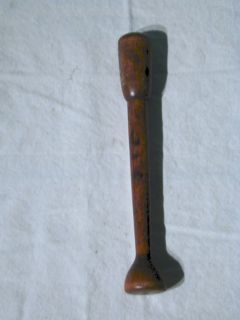 |
c. 1800 |
Unknown |
American |
Wood |
7 5/8" L |
|
Purchase, 1961 |
Purchase, Mary Allis, Fairfield, CT 1961 |
0 |
|
|
Muddler |
|
Household Items |
0 |
| TRUE |
Funnel |
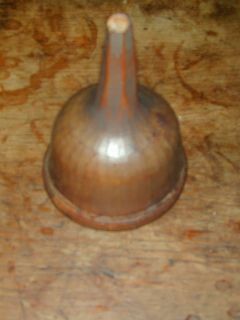 |
c. 1800 |
Unknown |
American |
Wood |
6" H x 4" Dia |
|
Purchase, 1961 |
Purchase, William C. Kennedy 6/5/61 |
0 |
|
|
Wooden funnel |
|
Household Items |
0 |
| TRUE |
Kitchen untensils |
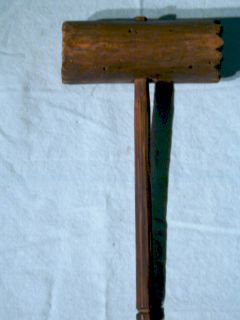 |
c. 1800 |
Unknown |
American |
Wood |
10 1/2" L x 5" W |
|
Purchase, 1961 |
Purchase, Mary Allis, Fairfield, CT 5/29/61 |
0 |
|
|
Meat tenderizer: primative wooden mallet with cross-hatched jags carved into ends of head. |
|
Household Items |
0 |
| TRUE |
Kitchen untensils |
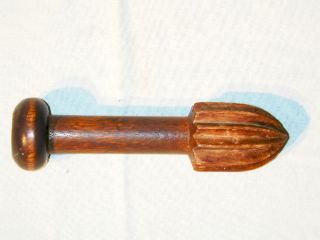 |
19th century |
Unknown |
American |
Wood |
5 3/4" L |
|
Purchase, 1961 |
Purchase, William C. Kennedy 6/5/61 |
0 |
|
|
Reamer: for extracting juice from lemons, treenware. |
|
Household Items |
0 |
| TRUE |
Kitchen untensils |
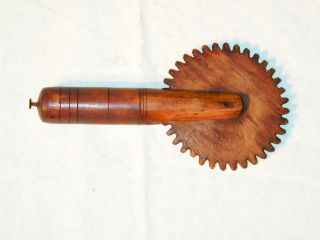 |
c. 1800 |
Unknown |
American |
Wood |
5 3/5" L x 3" Dia |
|
Purchase, 1961 |
Purchase, Mary Allis, Fairfield, CT 5/29/61 |
0 |
|
|
Jagging wheel: treenware, a wheel with saw-toothed edge, with handle for cutting pastry and cakes. |
|
Household Items |
0 |
| TRUE |
Kitchen untensils |
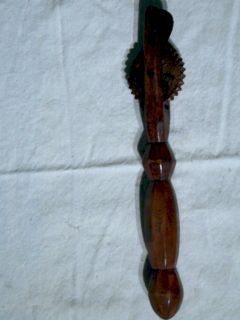 |
c. 1800 |
Unknown |
American |
Wood and iron |
9" L |
|
Purchase, 1961 |
Purchase, Mary Allis, Fairfield, CT 6/5/61 |
0 |
|
|
Jagging wheel with blade: treenware, saw toothed wheel with extending blade and carved handle. |
|
Household Items |
0 |
| TRUE |
Kitchen untensils |
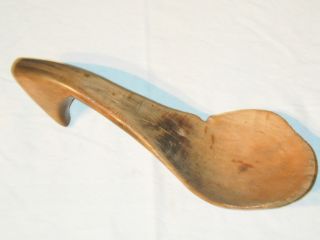 |
c. 1800 |
Unknown |
American |
Wood |
10" L x 5" Dia |
|
Purchase, 1961 |
Purchase, Mary Allis, Fairfield, CT 5/29/61 |
0 |
|
|
Wooden scoop: treenware, with hook on handle. |
|
Household Items |
0 |
| TRUE |
Kitchen untensils |
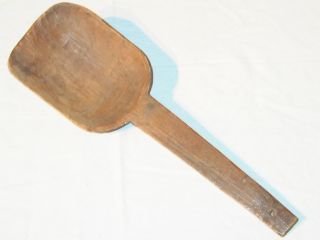 |
Early 19th century |
Unknown |
American |
Wood |
12" L |
|
Purchase, 1961 |
Purchase, Mary Allis, Fairfield, CT 5/29/61 |
0 |
|
|
Scoop: treenware, with rectangular bowl. |
|
Household Items |
0 |
| TRUE |
Ladle |
 |
Early 19th century |
Unknown |
American |
Maple |
14 3/4" L |
|
Purchase, 1961 |
Purchase, Mary Allis, Fairfield, CT 3/21/61 |
0 |
|
|
Ladle: treenware, with hook carved half-way down on back of handle to hold it onto bowl. |
|
Household Items |
0 |
| TRUE |
Kitchen untensils |
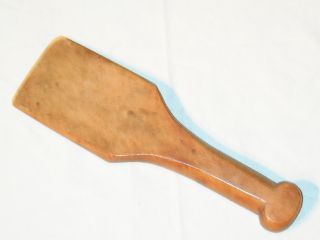 |
c. 1800 |
Unknown |
American |
Wood |
9 3/8" L |
|
Purchase, 1961 |
Purchase, Mary Allis, Fairfield, CT 3/21/61 |
0 |
|
|
Dough scraper: treenware, wedge-shaped paddle with mushroom-shaped handle. |
|
Household Items |
0 |
| TRUE |
Kitchen untensils |
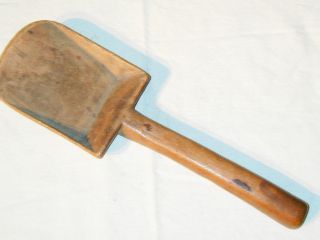 |
Early 19th century |
Unknown |
American |
Wood |
10 1/4" L |
|
Purchase, 1961 |
Purchase, Mary Allis, Fairfield, CT 5/29/61 |
0 |
|
|
Scoop: treenware, shovel-shaped. |
|
Household Items |
0 |
| TRUE |
Bucket |
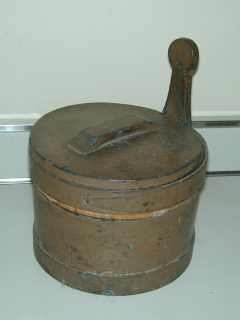 |
Early 19th century |
Unknown |
American |
Cedar |
Piggin: 7" H x 9" Dia Cover: 9" Dia |
|
Purchase, 1962 |
Purchase, Mary Allis, Fairfield, CT 3/30/62 |
0 |
|
|
Piggin with cover: small wooden bucket with one stave extended as handle. |
|
Household Items |
0 |
| TRUE |
Bee Trap |
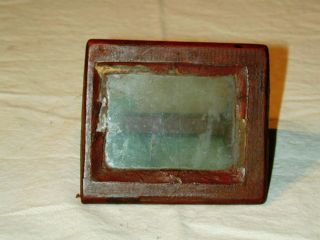 |
Early 19th century |
Unknown |
American |
Painted wood |
2 1/4" H x 3 1/4" W |
|
Purchase, 1962 |
Purchase, William C. Kennedy 6/20/62 |
0 |
|
|
Bee trap: small triangle of glass with wooden ends. One end has a small hole to admit the queen bee, painted red. |
|
Household Items |
0 |
| TRUE |
Flatware |
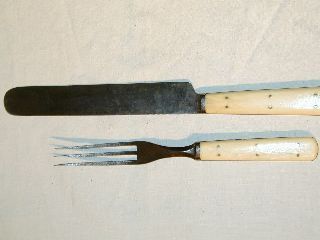 |
after 1834 |
Lamson & Goodnow |
Shelburne Falls, Massachusetts |
Ivory and steel |
Knives: 9-3/4 Forks 7-1/2 |
Marks on knives: "LAMSON & GOODNOW M.FG CO / S.FALLS.WORKS" |
Purchase, 1962 |
Purchase, William C. Kennedy 4/9/62 |
0 |
|
|
Ivory handled knives and forks: three knives and six forks. Forks are three tined and knives have steel blades. Handles of both have six brass pins. |
One fork is missing as of 11/17/09 (PDZ). 2000 inventory listed all 9 items. |
Household Items |
0 |
| TRUE |
Bucket |
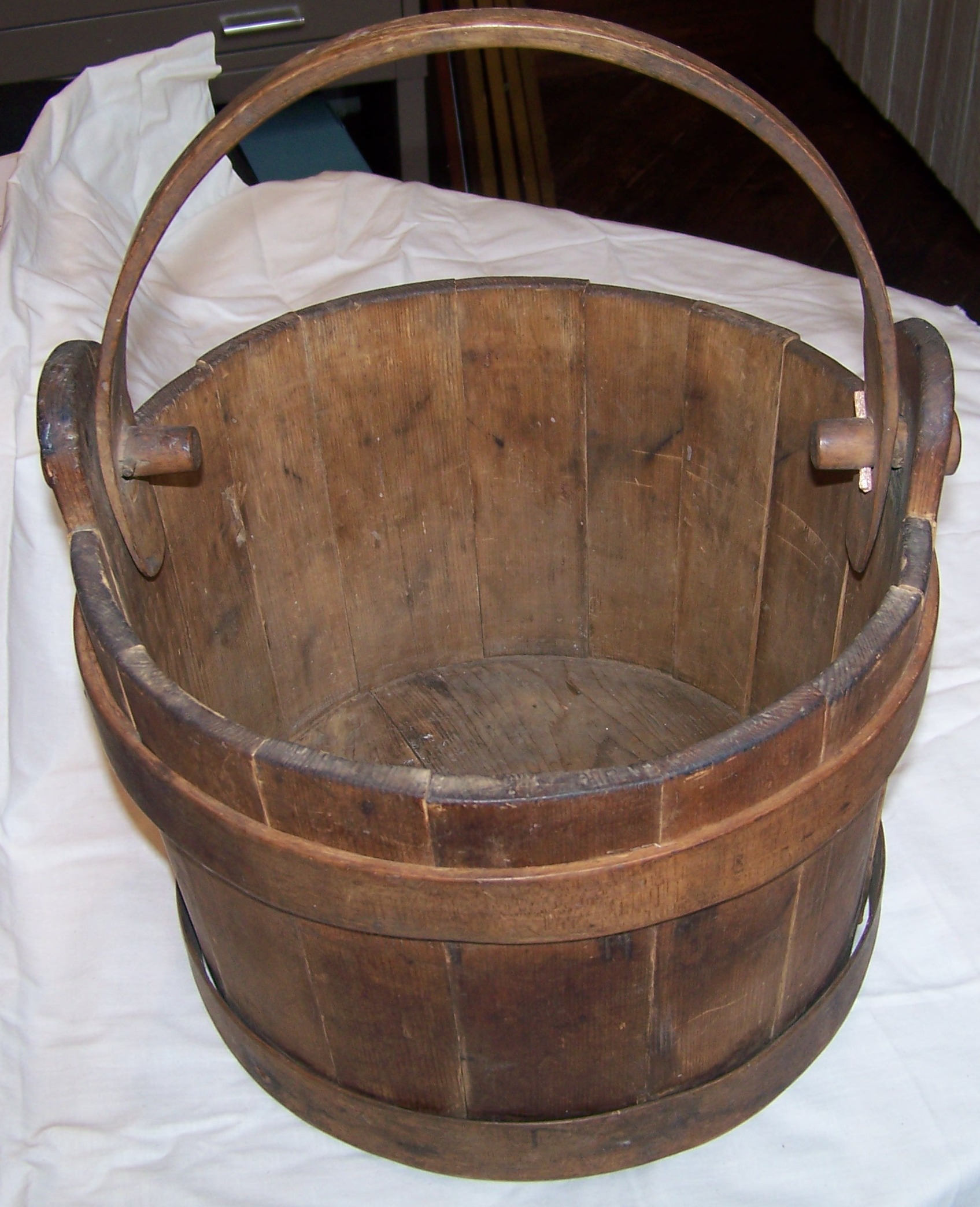 |
19th century |
Unknown |
Northeastern United States |
Atlantic white cedar, unidentified hardwood |
12 1/2" H x 8 1/2" Dia |
|
Purchase, 1962 |
Purchase, Mary Allis, Fairfield, CT 5/30/62 |
0 |
|
|
The wooden bucket is made of cedar staves and bottom, held together by wood bands around the base and top. Wood loops for the handle indicate that this bucket never had a lid or cover. |
|
Household Items |
0 |
| TRUE |
Kettle |
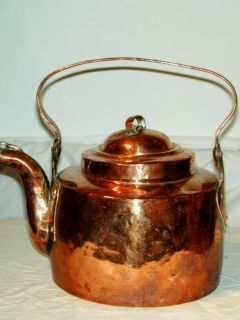 |
1800-1850 |
Unknown |
England or Europe |
Copper |
8 3/4" H x 8 3/4" Dia |
|
Purchase, 1962 |
Purchase, Black Lamb 3/9/62 |
0 |
|
|
The body tea kettle is made of sheet copper and has a dovetail seam opposite the spout. The bottom is domed and not seamed in the typical American manner. The spout is missing a hinged cover. The round handle is hinged to tabs aligned with the spout. The domed cover has a strap finial. |
|
Household Items |
0 |
| TRUE |
Coffee Roaster |
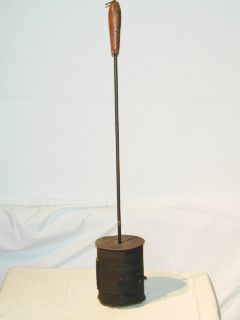 |
1800-1850 |
Unknown |
Probably United States |
Tin, iron and wood |
32 1/" L x 5 1/2" Dia |
|
Purchase, 1973 |
Purchase, Black Lamb 11/29/73 |
0 |
|
|
Coffee Roaster: cylindrical tin, painted black with wrought iron and wood handle. Door in side with latch, wooden hand bar and ring for hanging, spiked so that it could be driven into a log or bed of ashes. |
Identical with ones at Philipsburg and Williamsburg, possibly from Vermont. Could be laid on its side and rotated in bed of coals. |
Household Items |
0 |
| TRUE |
Pail |
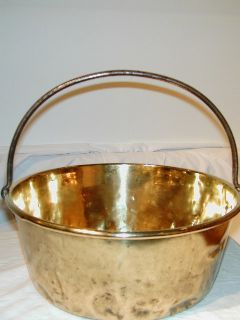 |
1800-1875 |
Unknown |
United States or England |
Brass, iron, and copper |
13 1/4" H x 12" Dia |
|
Purchase, 1975 |
Purchase, Black Lamb 4/25/75 |
0 |
|
|
The spun brass pail has a wrought iron handle attached to the sides with copper rivets. The brass sides are rolled over an iron core at the rim. |
|
Household Items |
0 |
| TRUE |
Pot lifter |
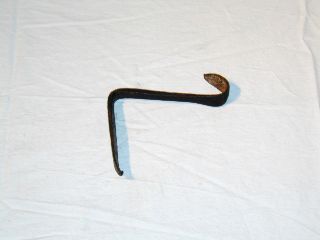 |
1775-1850 |
Unknown |
United States |
Wrought iron |
5 1/2" L |
|
Gift from Mary Allis, 1977 |
Gift from Mary Allis, Fairfield, CT 9/7/77 |
0 |
|
|
The wrought iron pot lifter is a right-angled bar with a flattened, rounded hook at one end. |
|
Household Items |
0 |
| TRUE |
Kettle |
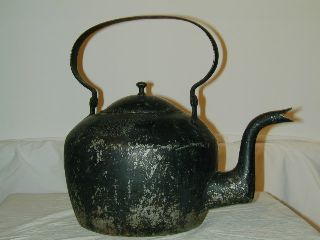 |
1800-1875 |
Unknown |
Probably United States |
Tinned sheet iron |
14 1/2" H x 35" Cir |
|
Purchase, 1977 |
Purchase, Mary Allis, Fairfield, CT through Ray Cox 5/11/77 |
0 |
|
|
Tea kettle made of tinned sheet iron black. Goose neck spout, bail handle and dome cover with bulbous finial. |
|
Household Items |
0 |
| TRUE |
Three pots |
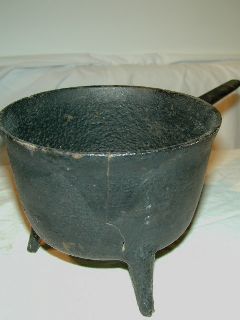 |
Early 19th century |
Unknown |
American |
Wrought iron |
|
|
Purchase, 1977 |
Purchase, Mary Allis, Fairfield, CT, through Hand Hollow Antiques, 1977 |
0 |
|
|
Three pots: three legged iron pots with straight handles. |
3/21/02 Inserted image. Only one pot has been located thus far. 4/16/03 - (c) has not been located. |
Household Items |
0 |
| TRUE |
Peel |
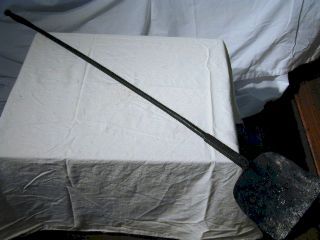 |
Early 19th century |
Unknown |
American |
Wrought iron |
44 3/4" L x 7 1/4" W |
|
Gift of Mary Allis, 1977 |
Gift of Mary Allis, Fairfield, CT 9/7/77 |
0 |
|
|
Peel: long handled iron peel with knob finial on handle. |
|
Household Items |
0 |
| TRUE |
Set of four plates |
 |
c. 1780 |
John Townsend |
England |
Pewter |
9" Dia |
"JOHN TOWNSEND" touchmarks visible on two "A" and "B". |
Purchase, 1961 |
Purchase, Mary Allis, Fairfield, CT 3/21/61 |
0 |
|
|
The pewter plates have molded-bead edges. |
|
Household Items |
0 |
| TRUE |
Skillet |
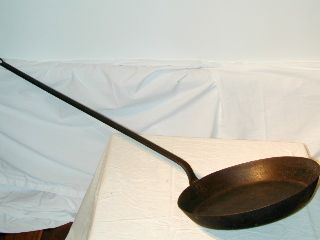 |
Early 19th century |
Unknown |
American |
Wrought iron |
13 1/2" Dia |
|
Purchase, 1961 |
Purchase, Mary Allis, Fairfield, CT 3/21/61 |
0 |
|
|
Iron skillet: with long handle, ring in handle. |
|
Household Items |
0 |
| TRUE |
Skillet |
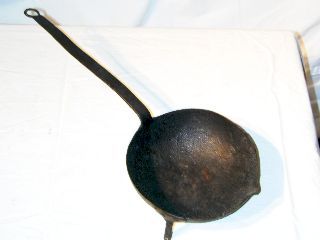 |
Early 19th century |
Unknown |
American |
Iron |
7 1/4" L |
|
Purchase, 1961 |
Purchase, Mary Allis, Fairfield, CT 3/21/61 |
0 |
|
|
Small three- legged pot: with rat tail handle and pouring lip. |
|
Household Items |
0 |
| TRUE |
Sconce |
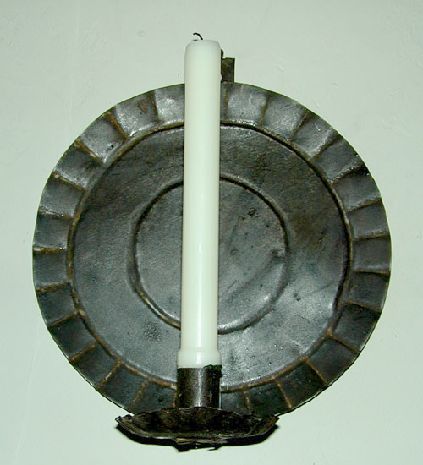 |
c. 1800 |
Unknown |
American |
Tin |
7" H x 10" Dia |
|
Purchase, 1962 |
Purchase, Mary Allis, Fairfiled, CT 5/20/62 |
0 |
|
|
Wall sconces: one pair, tin, circular crimped reflector backs and drip pans. One is wired for electricity, the other holds a wax candle. |
|
Lighting |
0 |
| TRUE |
Sconce |
 |
c. 1800 |
Unknown |
American |
Tin |
10" Dia |
|
Purchase, 1961 |
Purchase, William C. Kennedy 6/5/61 |
0 |
|
|
Wall sconce: one pair, tin, round, crimped edged reflector backs, wired for electricity. |
|
Lighting |
0 |
| TRUE |
Set of four decanters and stand |
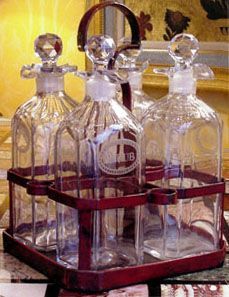 |
c. 1800 |
Unknown |
England |
Glass, leather, iron, brass |
|
|
Gift of The Friends of Boscobel, 1999 |
Gift of The Friends of Boscobel, Garrison, NY 1999 Purchased through Mallett & Son Antiques, 141 New Bond Street, London 12/8/99 |
0 |
|
|
Set of four square, pint -sized decanters with canted corners and cut shoulders, and cut ball stoppers, with engraved labels 'Rum', Shrub', 'Hollands' and 'Brandy'. Polished pontils on bottoms. Red leather covered iron stand with spaces for four square decanters and four stoppers. Base of handle has brass fittings. |
|
Glass |
0 |
| TRUE |
Wine glasses and decanters |
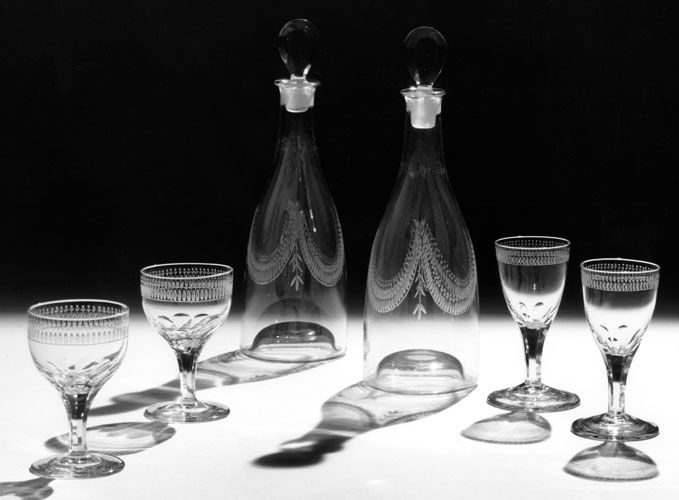 |
c. 1790 |
Unknown |
England |
lead glass |
|
|
Gift of The Friends of Boscobel, 2000 |
Gift of The Friends of Boscobel, Garrison, NY 2000 Purchased through Mallett & Sons (Antiques) LTD., 141 New Bond Street, London 2/18/2000 |
0 |
|
|
The assembled set of tall and short wine glasses with two matching decanters are cut and bordered with floral swags. The decanters have high-domed bottoms with no pontil mark and tear-drop cut stoppers. The taller set of twelve wine glasses has hexagonal-cut stems and pontil marks on the undersides of the feet. The shorter set of eight wine glasses has octagonal-cut stems and polished pontils, except one short wine glass has a nine-sided stem. |
Surviving sets of glasswares are extremely rare. The pattern on these decanters recalls the swags of drapery motif used throughout Boscobel. Also, the glass relates to an entry in the October 1788 invoice from John Blades that itemizes "24 wines 2 sizes cut and bordered" and "2 decanters" purchased by States Dyckman prior to his return to New York after his first extended stay in England. |
Glass |
0 |
| TRUE |
Coffee and milk pots |
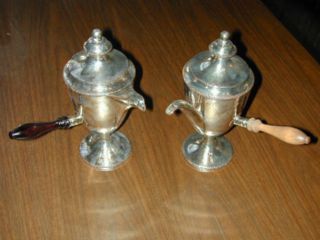 |
1780-1800 |
Unknown |
Sheffield, England |
plated silver on copper |
|
|
Gift of Richard Kelly |
|
0 |
|
|
"Café Au Lait" Service. Left and right hand pots used for simultaneously pouring coffee and milk. Service consists of both a coffee and milk pot. |
|
Silver |
0 |
| TRUE |
Sugar Basket |
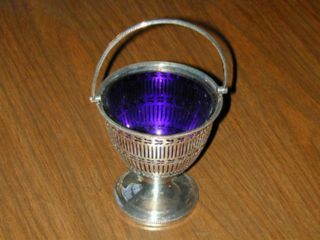 |
1780-1800 |
Unknown |
Sheffield, England |
plated silver on copper, glass |
|
|
Gift of Richard Kelly |
|
0 |
|
|
Pierced sugar basket with handle and blue cobalt glass liner. (Liner probably Bristol glass). Basket is grouped with the Café Au Lait service (S 2001.1 a,b). |
Installed in Butler's Pantry in 2004. |
Silver |
0 |
| TRUE |
Set of fancy chairs |
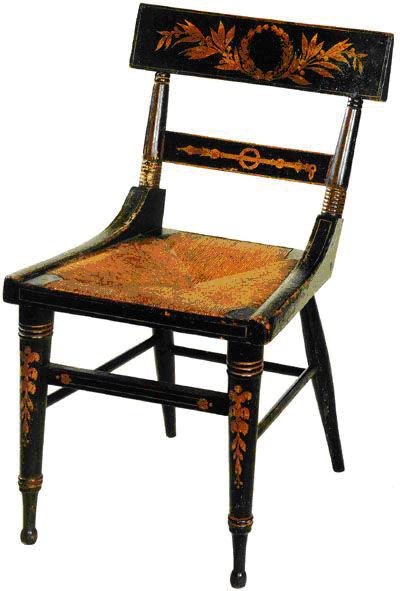 |
1825-40 |
Unknown |
New York |
Maple, ash, tulip poplar |
|
|
|
Among the nine side chairs and one armchair acquired as lot 125 in the Parke Bernet Robinson sale. |
0 |
|
|
Set of six side chairs painted black with decoration. These seem to be en suite with F 62.13 a-d, except they have a different paint history. |
|
Furniture |
0 |
| TRUE |
Side chair, pair of |
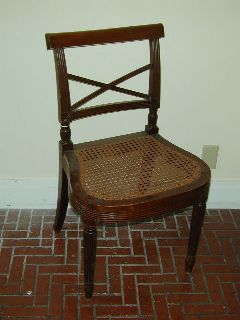 |
1805-15 (later alterations) |
Unknown |
New York City |
Mahogany, cane |
|
|
Purchase, 1962 |
Ex-collection, Douglas Robinson. Purchased at the Parke-Bernet Galleries sale no. 2127, October 5-6, 1962, lot 279. |
0 |
|
|
Pair of balloon seat side chairs with caned seats. Rear stiles are reeded with urn turnings immediately above the seat frame. The chair back originally had double "X"s, although only the lower X remains. Present replacement crest rail overhangs the outsides of the stiles. The seat rails are reeded on the outside. The turned front legs are reeded and end in bulbous tapered feet. |
|
Furniture |
0 |
| TRUE |
Pair of globes |
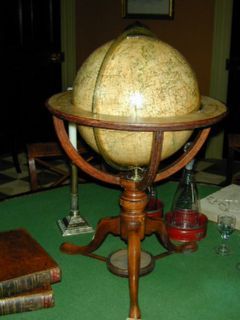 |
1780-1800 |
William T.M. Bardin |
London, England |
Mahogany, oak, fruitwood, brass, paper, glass |
|
|
Partial gift of Robert G. Goelet |
|
0 |
|
|
A pair of celestial and terrestrial globes. |
On September 27, 1787, States Dyckman prepared a hand written list of various purchases of household and other items to be shipped to Kings Ferry. There is a reference of payments to Mr. Adams for "an Extra pair of Globes" and "for packing Case". "Image 1" represents the terrestrial globe. "Image 2" represents the celestial globe. |
Furniture |
0 |
| TRUE |
Charger and Platter |
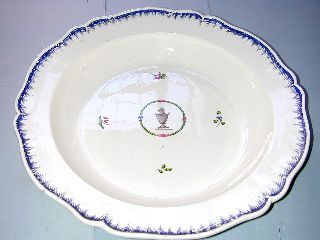 |
c. 1800 |
Probably Herculaneum Pottery |
Liverpool, England |
Creamware |
Charger: 2-5/8 x 17-1/2 (dia); Platter: 1-5/8 x 18-5/8 x 14-1/2 |
|
Purchase, 1981 |
James E. Elliott, 10 North Main Street, Essex, CT 06426, |
0 |
|
|
The round charger and oval platter have scalloped rims decorated in a blue "feather-edge" pattern. A neo-classical two-handled urn is painted in the center and surrounded by a narrow green wreath with red and blue floral motifs at the cardinal points. Four small floral sprays occur outside the wreath at the cardinal points. These two objects appear to be the same pattern as C 61.18. |
|
Ceramic |
0 |
| TRUE |
Saucer |
 |
mid 19th century |
Unknown |
China |
Porcelain |
1-1/4 x 6-1/4 (dia) |
|
Gift of Mrs. Douglas Robinson, Henderson House, 1962 |
Formerly owned by Mrs. Henry Cruger. |
0 |
|
|
The deep saucer stands on a shallow foot ring. The inside of the saucer is decorated in underglaze blue and enamel. The center scene shows four polychromed Chinese figures, one of whom holds a bird in her hand, in front of a tree and Chinese building. Two boats and a house appear in the left background. The border has four C scroll cartouches containing Oriental landscapes in an Imari-like red color. Floral decoration in blue and red, and a blue repeating band at the rim complete the decoration. |
A "jelly" label pasted to the bottom of the saucer states "fine old Chinese / Saucer belonged / to Harriet Douglas / (Mrs Cruger)" |
Ceramic |
0 |
| TRUE |
Frame, needlework |
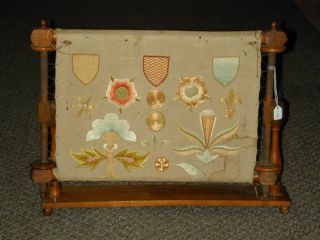 |
1810-1830 |
Unknown |
London, England |
Fruitwood, linen, silk and metallic threads |
15 x 19-1/8 x 3-3/4 |
"Miss Lambert's / 3 New Burlington Street / 3 doors from Regent Street" in ink on bottom of stand. |
|
THE SOURCE OF THIS OBJECT IS UNKNOWN TO PDZ. |
0 |
Lambert, Miss [Frances]. The Hand-book of Needlework: With Numerous Illustrations. London: John Murray, Albemarle Street, 1842. Lambert, Miss [Frances]. My Crochet Sampler: With Numerous Illustrations. New-York: D.M. Peyser, 58 John-St., and 363 Broadway, 1846. |
|
The needlework frame is made of two elongated baluster supports screwed into each end of a rectangular base that stands on four ball feet. The top of each support holds a wooden tab of a double threaded needlework frame post that may be adjusted with a brass wing nut. Round horizontal framing members at the top and bottom of the frame--to which the needlework canvas is attached--have blocked ends that slide over the post ends. The needlework is stretched by adjusting threaded disks against the blocked ends. The needlework is a sampler having three shields across the top, flowers, fleur-di-lis, and circular devices, and two floral compositions across the bottom rendered in different colored silk threads and gold thread. The sides of the needlework are laced to the threaded side posts with string which is gathered at the top around needles. Two decorative elements at the top are drawn but not executed. |
LOCATION UPDATE: MOVED TO FRONT DRAWING ROOM AS OF MARCH 2007 |
Household Items |
0 |
| TRUE |
Pair of candlesticks |
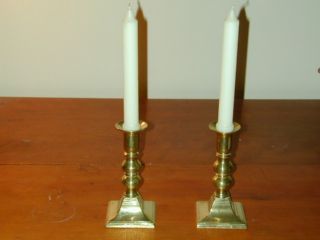 |
1810-1840 |
Unknown |
England |
Brass |
6 x 3 x 3 |
|
Purchase, M. Allis, 3/13/69 |
|
0 |
|
|
The cylindrical candle socket has a flared bobeche above opposing balusters set on a flaring square base. A "push-up" ejector rod runs inside the casting. |
|
Lighting |
0 |
| TRUE |
Shotgun (converted flintlock) |
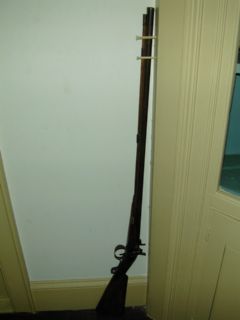 |
1790-1820 |
|
England |
walnut, iron, brass |
49-1/2 x 7 x 3 |
|
Purchase, W.C. Kennedy, 10/15/69 |
|
0 |
|
|
Double-barreled, muzzle-loading percussion shotgun with engraved iron trigger guard, tang, butt plate, and lockplates. Stock has cross-hatched grip and brass inlays, including a squirrel on one side of the stock and an apple with an arrow through it on the other. The shotgun was originally made as a flintlock and was converted to percussion. |
|
Household Item |
0 |
| TRUE |
Lidded jar |
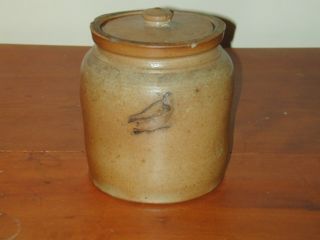 |
1840-1860 |
possibly Jacob Caire |
possibly Poughkeepsie, New York |
Salt glaze stoneware |
7-1/2 x 6-1/2 (dia) |
None |
Purchase, Alan Dewey, 11/6/71 |
|
0 |
Poughkeepsie Potters and The Plague by George H. Lukacs |
|
Small lidded preserve jar with matching knobbed lid; incised (or stamped?) bird on branch. |
George Lukacs, author of Poughkeepsie Potters and The Plague, inspected this jar on 12/21/2006 and believes it to be unlabeled Poughkeepsie Pottery of Jacob Caire. He states the pieces is not labeled, perhaps it would have been too obtrusive to put his name on it. |
Ceramics |
0 |
| TRUE |
Kas or Wardrobe |
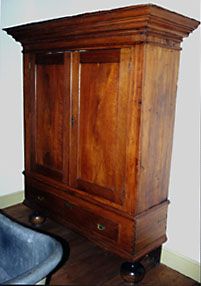 |
1750-1790 |
Unknown |
New York area |
Cherry, tulip poplar, white pine |
75 x 63 1/2 x 23" |
"June 25 C A" and "June 25 Charles / and Asa Commenca / Bould" in pencil on inside of proper left door. |
Gift of Mr. And Mrs. Fred D. Thompson, 1961 |
Reportedly descended to a blacksmith relative of Benjamin Dyckman and the piece was known as States Morris Dyckman's kas. Purchased from John Conover, Ossining, New York, 6/21/61 |
0 |
|
|
The upper cupboard section of this two-part cherry kas has an integral cornice. The upper section rests on a base that is supported by platform feet turned in front and with rectangular stiles in the rear. The cupboard doors are of approximately equal width. They enclose a plain recessed panel which is chamfered on the inside. The single wide drawer in the base has its original brass and slides into a drawer cavity made of top and bottom boards with side boards attached by tongue-and-groove joints, the whole assembly dovetailed to the side boards. |
|
Furniture |
0 |
| TRUE |
Cooler |
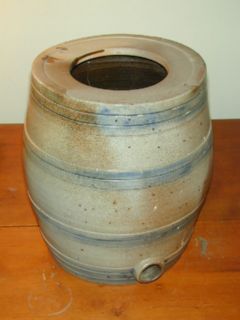 |
19th century |
Unknown |
American; possibly NY or NJ |
stoneware |
13-1/4 x 11-1/2 (dia) |
|
Purchased for $35.00 by William C. Kennedy through Paul Weld. |
|
0 |
|
|
Stoneware barrel-shaped cooler with four flat double rings picked out in pale blue. Large circular hole in top for a lid. Bung hole at bottom. Early accession record notes a wood lid for this cooler. |
Catalog card for this object includes a wood cover. It has yet to be located. |
Ceramics |
0 |
| TRUE |
Jug |
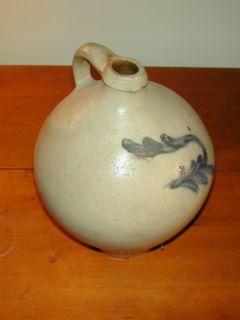 |
1825-1835 |
Unknown |
possibly Poughkeepsie, New York |
stoneware |
13-1/2 x 10-1/2 (dia) |
None |
Purchased, 1966 |
Purchased for $32.50 by William C. Kennedy. |
0 |
Poughkeepsie Potters and The Plague by George H. Lukacs |
|
Salt glaze stoneware with cobalt blue leaf decoration. |
Date and origin given based on shape and decoration by George H. Lukacs who viewed piece on 12/21/2006 |
Ceramics |
0 |
| TRUE |
Jug |
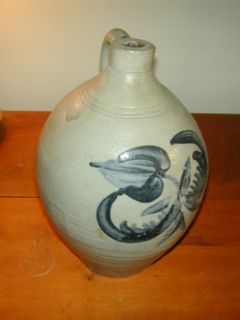 |
19th century |
Unknown |
United States |
stoneware |
16 x 11 (dia) |
None |
Purchased, 1966 |
|
0 |
|
|
Salt glaze, gray ovoid shaped stoneware with cobalt blue flower or sprig. Three incised lines around neck. |
|
Ceramics |
0 |
| TRUE |
Lidded bowl |
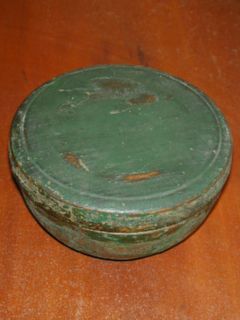 |
19th century |
Unknown |
United States or Europe |
unidentified hardwood, possibly beech |
3-3/4 x 6-1/2 (dia) |
|
Purchase, 1969 |
|
0 |
|
|
The turned bowl has a turned lid that fits over the rim of the bowl. Both lid and bowl are painted green on the outside. |
|
Household Item |
0 |
| TRUE |
Jug |
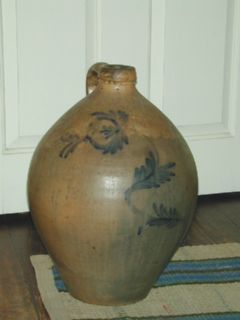 |
19th century |
Unknown |
United States |
Salt glaze stoneware |
18-1/2 x 13-1/2 (dia) |
None |
Purchased, 1971 |
Purchased for $40.00 on 1/6/71 from Kelly. |
0 |
|
|
Gray jug with two cobalt blue sprig motifs on body opposite handle. |
|
Ceramics |
0 |
| TRUE |
Pitcher |
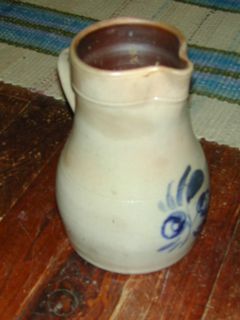 |
19th century |
Unknown |
United States |
Salt glaze stoneware |
10-1/8 x 8 x 7-1/4 (dia) |
|
Purchase, 1966 |
Purchased on 2/8/66 by William C. Kennedy. |
0 |
|
|
Small pitcher with cobalt blue sprig. Brown glaze inside |
|
Ceramics |
0 |
| TRUE |
Pitcher |
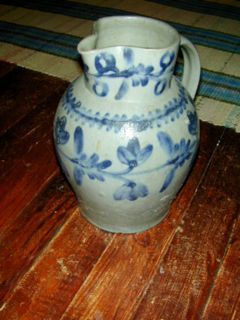 |
19th century |
Unknown |
United States |
Salt glaze stoneware |
13-1.2 x 10-1/2 x 9-1/2 (dia) |
|
Purchase, 1966 |
Purchased for $90.00 on 2/8/66 by William C. Kennedy. |
0 |
|
|
Gray pitcher with cobalt blue floral decoration. |
|
Ceramics |
0 |
| TRUE |
Pair of candlesticks |
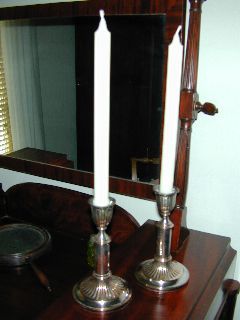 |
1790-1810 |
Unknown |
England |
Silver plate on copper |
|
|
|
Purchase, John Conover, Ossining, NY 5/19/61 |
0 |
|
|
telescoping shaft |
|
Lighting |
0 |
| TRUE |
Pair of standing salts |
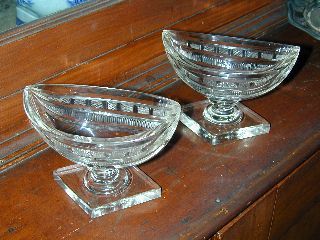 |
1800-1825 |
Unknown |
probably Northern Europe |
nonlead glass |
|
|
|
Included on John Conover list of donations to Boscobel from Mr. And Mrs. Fred D. Thompson |
0 |
|
|
Larger than usual cut and engraved crescent- or boat-shaped salts. Swag cuts in sides of body with ornamental cross-cuts. Square-edged lozenge-shaped foot. |
|
glass |
0 |
| TRUE |
Portrait miniatures |
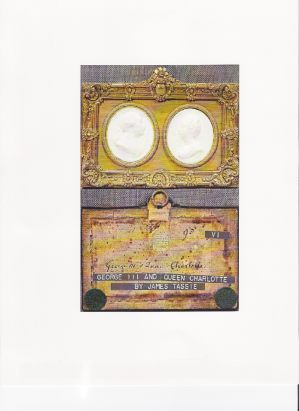 |
probably 1780's |
James Tassie |
|
|
The overall frame size is 4 inches by 5 1/2 inches. |
Labeled on the back "Miers Profile Painter and jeweller, No 111 Strand London, opposite Exeter Change. Miniatures set and framed. Hair-work warrented peculiarly neat." |
Purchased at DuMouchelles auction in Detroit, Michigan, 3/14/2004 |
The miniatures were formerly part of the collection of D.L. Wilkus of Detroit, Michigan . |
0 |
James Tassie by John Smith of Mallets in London James and William Tassie: A Biographical and Critical Sketch by John M. Gray, Edinburgh, 1894, pages 94 and 108 |
|
The oval white miniatures show side profiles of King George III and Queen Charlotte, facing each other, each measuring 2 inches by 1 1/2 inches, in a single gilt bronze and wood frame believed to be the original. |
James Tassie (1735-1799) was a Scot, a member of the Royal Academy, and a friendly rival to Josiah Wedgwood. He is the inventor of the glass-paste composition which he used on many of his miniature portraits. Tassie produced more than 500 portraits, many of them modeled form life, in his glass paste. He also supplied many of the classical portrait medallions available through Wedgwood, and he and Wedgwood occasionally supplied each other with models. SMD estate inventory of 1806 and PCD estate inventory of 1824. lists portrait miniatures of the King and Queen. 1806 inventory lists "the King and queen of England in Ivory" and "1 picture of the King of England in gilt". 1824 inventory lists "Ivory heads of the King and Queen of England $15." |
Prints/Drawings |
0 |
| TRUE |
Work table |
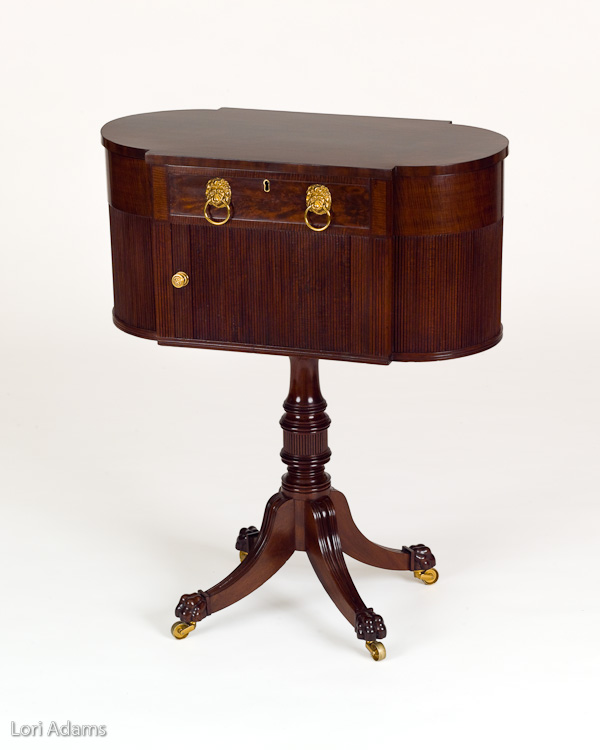 |
1815-1820 |
Probably Duncan Phyfe |
New York City |
Mahogany |
30-5/8 x 24-3/4 x 12-7/8 |
|
Purchased on August 4, 2005 from Waterstreet Antiques LLC, in New Castle, Delaware |
Unknown |
0 |
Jeanne Vibert Sloane, "A Duncan Phyfe Bill and the Furniture it Documents," Antiques 131, no. 5 (May, 1987), 1106-13. Charles Montgomery, American Furniture: The Federal Period (New York: Viking Press, 196), cat. no. 421 |
|
The rectangular work table with astragal ends and tambour sides stands on a turned pillar into which four legs are slotted. The veneered and hinged lid of conforming shape lifts to access the hinged writing board inside. A half-round tray divided into three pie-shaped compartments lifts out of the left side to an open well below. The right side removable tray is fitted for writing implements and opens to another well. Below the false drawer in front, a tambour slide opens to two mahogany trays. The turned pillar has a reeded drum below a flared column. The pillar stands on four reeded "sweep" legs ending in carved animal feet on casters. The tops of the legs are molded, and a wood collar separates the feet from the legs. |
|
Furniture |
0 |
| TRUE |
Mourning Picture |
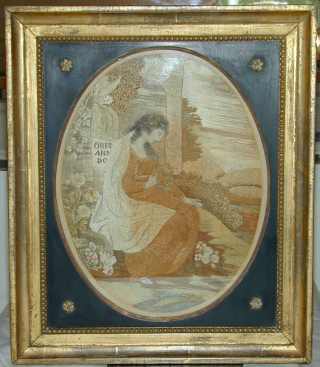 |
circa 1795-1820 |
Unknown |
American |
silk and linen |
12" high, 9" wide |
none |
Purchased, 2/2/1978 from Peter Fredericks, Cold Spring, NY $200.00 |
Peter Fredericks, Cold Spring, NY |
0 |
*Bury, Shirley, An Introduction to Sentimental Jewellery, London: H.M.S.O, 1985 *Cooper, Diana and Norman Battershill, Victorian Sentimental Jewellery, Newton Abbot, David and Charles, 1972. *Curran, Mona, A Treasury of Jewels and Gems, New York: Emerson Book, Inc., 1982. *DeLorne, Maureen, Mourning Art and Jewelry, Shiffer Books, 2004 *Hilary Jay, “Memento Mori: The Museum of Art celebrates life through objects relating to death,” Art & Antiques, no9, 2000. *Schorsch, Anita, Mourning Becomes America, An Exhibition and Catalogue, March 28th-May 23rd 1976 William Penn Memorial Museum and June 1st-July 15th 1976 Albany Institute of History of Art. |
Abigail Walker, Mourning Picture, c. 1810 at Bartow-Pell Mansion Museum Carriage House and Gardens 895 Shore Road Pelham Bay Park, Bronx, New York 10464 |
Embroidered silk mourning picture in oval gilded wood frame; silk embroidery on silk and linen ground stretched over oval wooden strainer. In original frame. |
|
Textiles |
0 |
| TRUE |
Portrait of James Ogilvie |
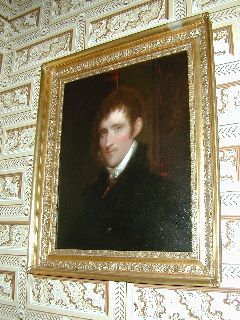 |
c. 1810 |
Attributed to Gilbert Stuart (1755-1828) |
Boston, Massachusetts |
Oil on panel |
|
|
On loan from Timotheus R. Pohl |
Elizabeth Corne Dyckman Cruger (1822-1901) is the first recorded owner of this painting. Several unnamed paintings are listed in the 1824 inventory of Boscobel taken at the death of Peter Corne Dyckman. Rev J. Bolton, History of the County of Westchester (New York, 1881) p. 179 cites Elizabeth Cruger as residing at Boscobel and owner of the painting. In 1919, The Buffalo Fine Arts Academy (now the Albright-Knox Art Gallery) purchased the painting from her daughter, Eliza Corne Cruger (1841-1933). On December 18, 1943, the portrait was then sold by the museum at Parke-Benet Galleries, New York. Artist and writer Ilse Bischof purchased the painting and brought it to her country house in Vermont. When the house was purchased in 1984, the painting passed to its current owner, Timotheus R. Pohl. |
0 |
|
|
"Portrait of James Ogilvie" (1775-1820) |
Ogilvie was a Scotsman who emigrated to Virginia in 1794 where he taught elocution. He also toured the eastern seaboard and gave public lectures. The 1881 edition of Bolton's History of the County of Westchester calls Ogilvie "the intimate friend of Mrs. Staats Dyckman and…A frequent visitor at Boscobel House, and teacher of Elocution in New York City." James Ogilvie (ca. 1775–1820) was born in Aberdeen, Scotland, immigrated to Virginia at the age of nineteen, and soon became professor of humanity and belles lettres at the Fredericksburg Academy. He subsequently opened his own academy near Milton, where he taught Thomas Jefferson Randolph, and he later began a school in Richmond. TJ praised Ogilvie’s oratorical skills, gave him a set of the works of Cicero, and granted him access to the library at Monticello. Ogilvie retired from teaching in 1809, settled for a time in Kentucky, and then traveled throughout the country as a professional lecturer. He eventually returned to Britain to attempt to claim the lapsed earldom of Findlater. After this endeavor failed, Ogilvie committed suicide in Aberdeen (DAB; DNB; ODNB; PTJ, 28:401–4; Ogilvie, Philosophical Essays, to which are subjoined Copious Notes, Critical and Explanatory, and a Supplementary Narrative; with an Appendix [Philadelphia, 1816], esp. the separately paginated, autobiographical “Supplementary Narrative”; Richmond Enquirer, 10 Apr. 1821). |
Paintings |
0 |
| TRUE |
Birdcage |
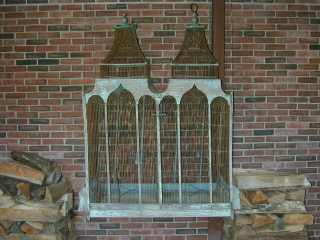 |
Early 19th century |
Unknown |
French |
Wire, tin, wood |
54" H., 40" L., 22" D. |
|
Purchase, 1962 |
Purchased by William C. Kennedy 4/9/62 |
0 |
|
|
Large pagoda shaped wire cage painted green. Sotheby's appraisal says, "Of architectural form, in the Brighton Pavilion style with wirework sides; painted green" |
Former accession number was (J45) |
Household Items |
0 |
| TRUE |
Fork |
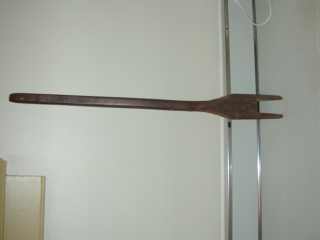 |
Circa 1800 |
Unknown |
American |
Wood |
L. 28" |
|
Purchase, 1961 |
|
0 |
|
|
Wooden fork for clothes washing, two pronged. |
|
Household Items |
0 |
| TRUE |
Soap Dish |
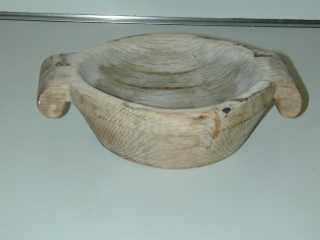 |
Circa 1800 |
Unknown |
American |
Wood |
H. 2 5/8"; L. 9"; W. 6 1/2" |
none |
Purchase, 1961 |
Mary Allis, 3/21/1961 |
0 |
|
|
Soap dish carved from a block of wood, with curled dog-ear handles |
Old accession number (I 62) |
Household Items |
0 |
| TRUE |
Plunger |
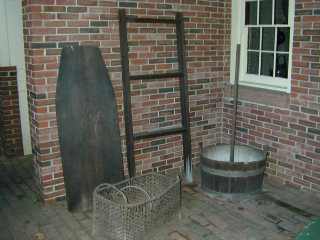 |
Circa 1800 |
Unknown |
American |
Wood |
L.54 1/2"; W. 5 7/8" |
None |
Purchase, 1961 |
|
0 |
|
|
Early wooden instrument for suction washing. Consists of handle with truncated pyramid shaped square base with holes for the water. |
|
Household Items |
0 |
| TRUE |
Ironing board |
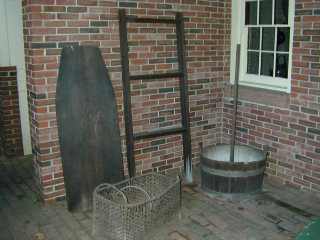 |
Circa 1800 |
Unknown |
American |
Wood |
L. 57"; W. 22 to 13 1/2" |
None |
Purchase, 1961 |
Mary Allis, 1961 |
0 |
|
|
Wooden ironing board fashioned from one piece of board narrower at one end. |
|
Household Items |
0 |
| TRUE |
Drying Rack |
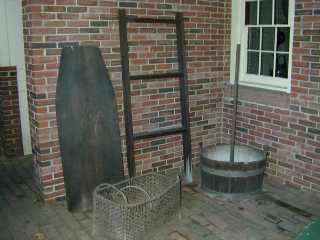 |
Circa 1800 |
Unknown |
American |
Wood |
Ht: 68" |
None |
Purchase, 1961 |
Mary Allis 5/29/1961 |
0 |
|
|
Three fold clothes drying rack |
Old Boscobel accession number (I 115) |
Household Items |
0 |
| TRUE |
Clothes Dryer |
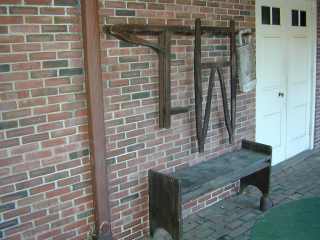 |
Early 19th century |
Unknown |
American |
Wood |
Pants dryer: L. 47"; W. 23" Shirt dryer: L.68"; W. 61" |
None |
Purchase, 1961 |
Leslie Celeste and Edward Koster, Old Chatham, NY 5/30/1962 |
0 |
|
|
Shirt and pants dryer: wooden forms for stretching wet garments. |
Old Boscobel accession number (I121/2) |
Household Items |
0 |
| TRUE |
Scrub Board |
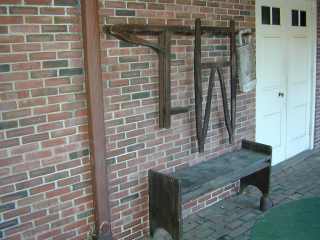 |
18th Century |
Unknown |
American |
Wood |
L.26"; W. 11 1/2" |
None |
Purchase, 1969 |
Purchased by William C. Kennedy, 10/15/1969 |
0 |
|
|
Very primitive board with ridges and hanging handle. |
Old Boscobel accession number (G 61) |
Household Items |
0 |
| TRUE |
Tub |
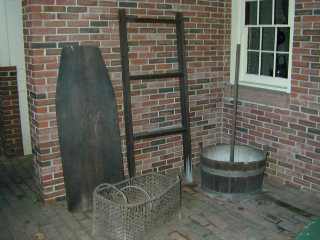 |
Early 19th century |
Unknown |
American |
White cedar |
(a) H. 10", Dia. 19" (b) H. 14 1/2", dia. 27" |
None |
Purchase, 1962 |
|
0 |
|
|
Two wooden tubs; white cedar, with handles formed from extended side slats. |
|
Household Items |
0 |
| TRUE |
Skirt |
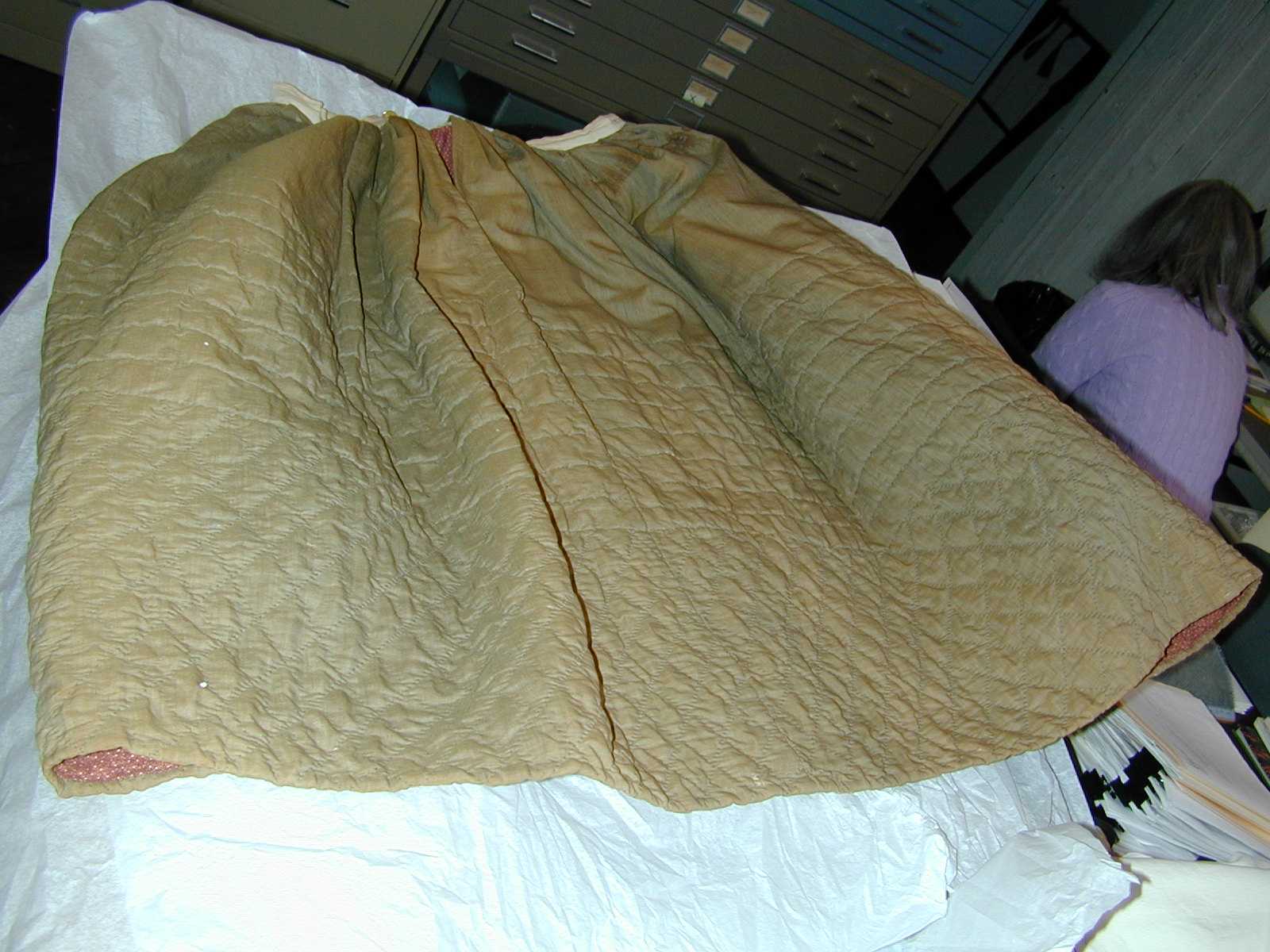 |
Circa 1800 |
Unknown |
American |
Linen |
L.32", Waist 34" |
None |
Purchase, 1969 |
|
0 |
|
|
Green quilted skirt, lined with red calico; hand woven white linen waistband fastened with a brass button and worked buttonhole. |
|
Costume |
0 |
| TRUE |
Cooler |
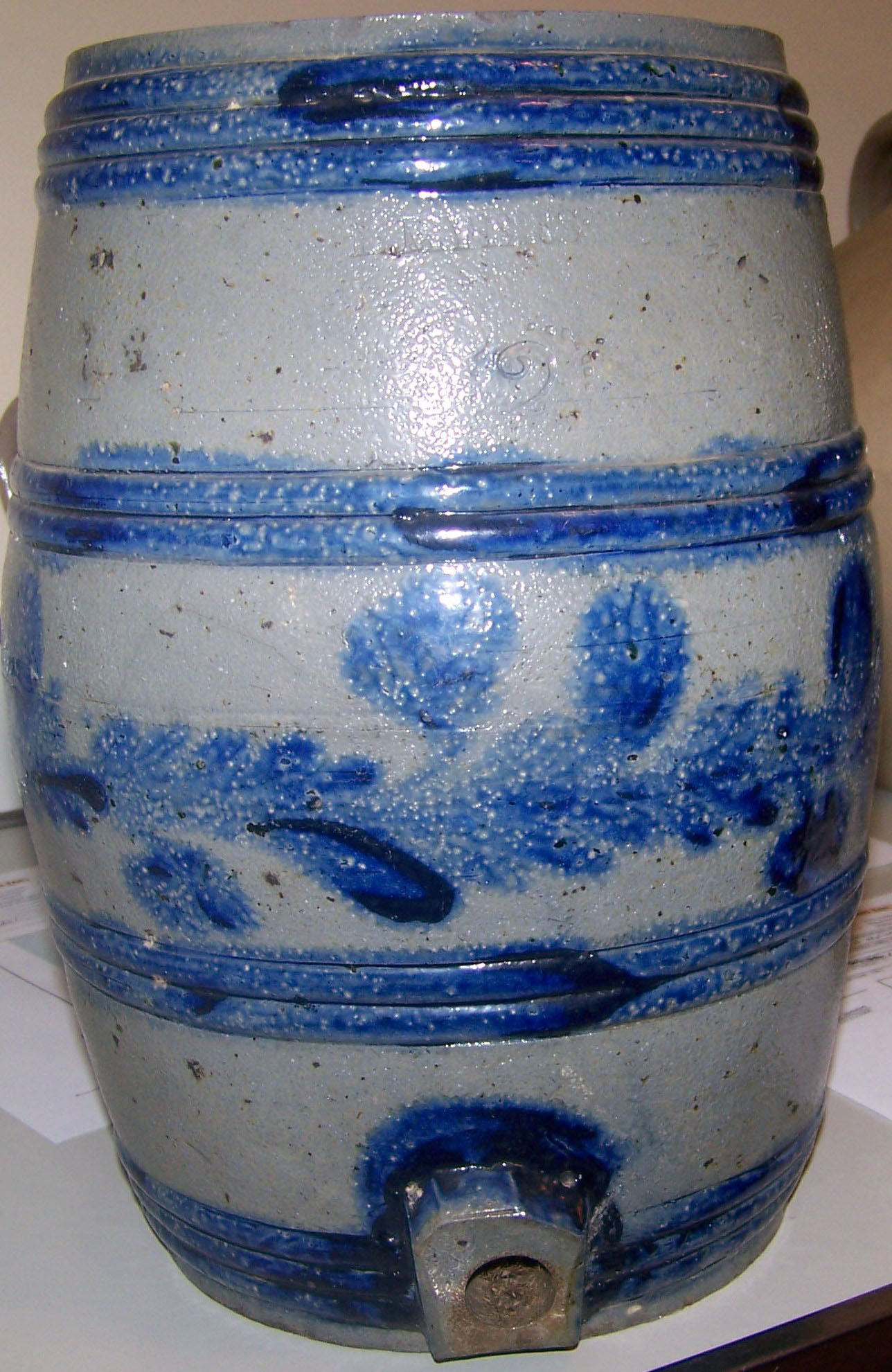 |
1820 or later |
H. Myers |
Baltimore, Maryland |
stoneware |
13 x 9-1/4 (dia) |
"H MYERS / 2" stamped into side above bung hole near top. |
Purchase, 1966 |
Purchase by William C. Kennedy through Paul Weld 2/8/66 for $60.00 |
0 |
|
|
Barrel-shaped container with blue ribs and band of floral decoration around middle; air hole in top, bung hole in side near bottom immediately below air hole. |
Myers owned the Baltimore Stoneware Manufactory in the 1820s, Remmey was the superintendent of the pottery. |
Ceramics |
0 |
| TRUE |
Crock |
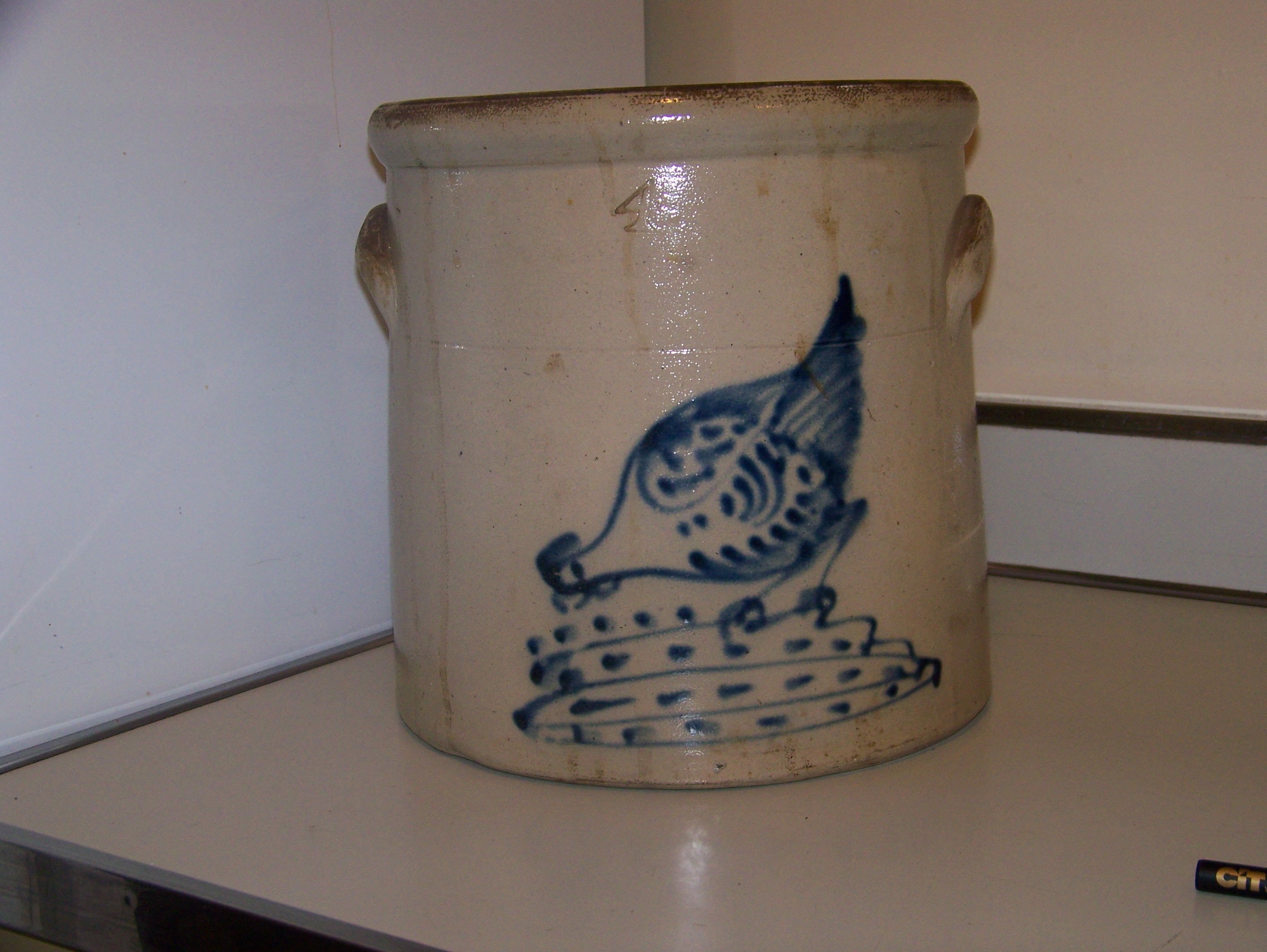 |
Early 19th century |
Unknown |
possibly New York |
stoneware |
11-1/2" h. x 11-1/2" dia. |
"4" stamped into body above bird near rim. |
Purchase, 1971 |
Purchased from Kelly (?) 11/6/1971 $40.00 |
0 |
|
|
Gray stoneware four-gallon crock with hen pecking corn on side in blue, dog ear handles, glazed brown inside. |
Old Boscobel accession number C106 |
Ceramics |
0 |
| TRUE |
Bowl |
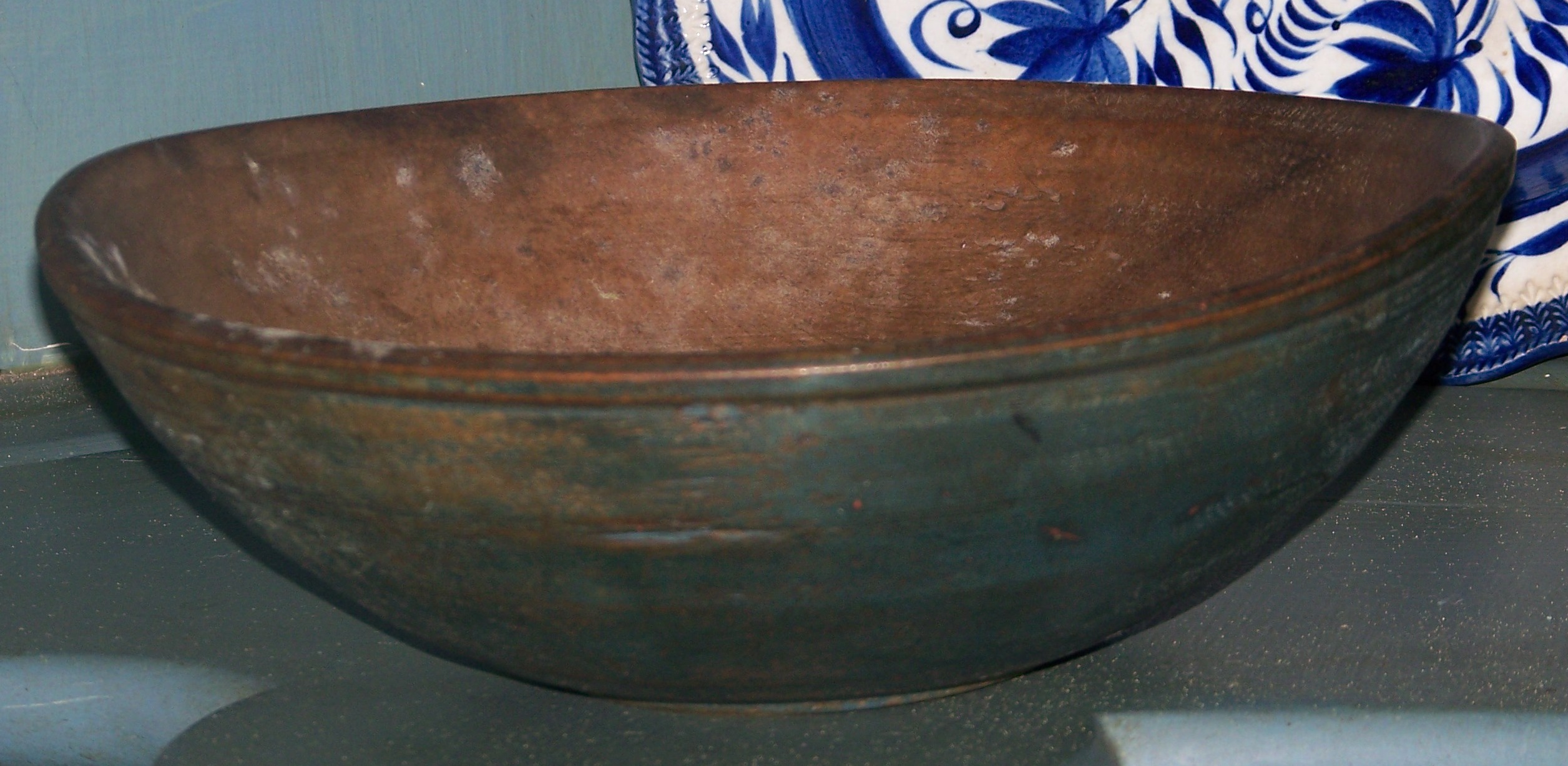 |
1800-1875 |
Unknown |
United States |
probably maple |
3-1/2 x 10-1/4 x 9-7/8 (dia) |
|
Purchase, 1970 |
Purchased through William C. Kennedy 8/10/1970 |
0 |
|
|
The treenware bowl is turned with a shallow foot ring and bead at the rim. painted green on the outside. Originally turned round, the bowl has since warped to an oval shape. It is painted a greenish blue on the outside. |
|
Household Items |
0 |
| TRUE |
Set of knives and forks |
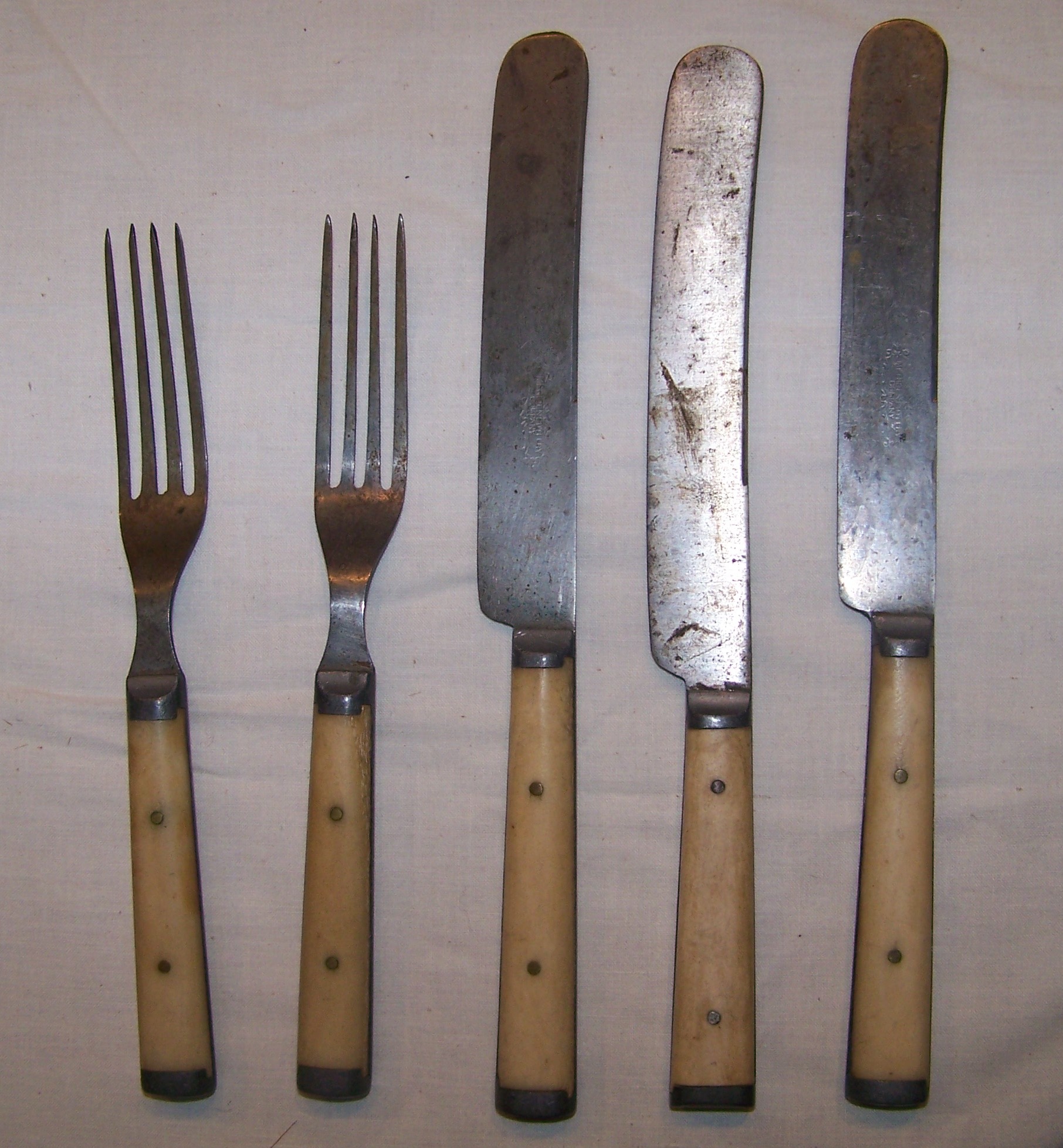 |
after 1855 |
Meriden Cutlery Co. |
Meriden, Connecticut |
steel, bone |
Knives, about 9-1/4" forks, about 7-1/2" |
Marked "MERIDEN CUTLERY / COMPANY" within a cartouche |
Purchase, 1970 |
Purchase through William C. Kennedy, 5/25/1970 |
0 |
|
|
Set of three knives and two forks, each with bone handles attached with two pins; each has an unidentified white metal butt plate. |
One knife and one fork from the set as originally accessioned is missing. |
Household Items |
0 |
| TRUE |
set of dessert knives and forks |
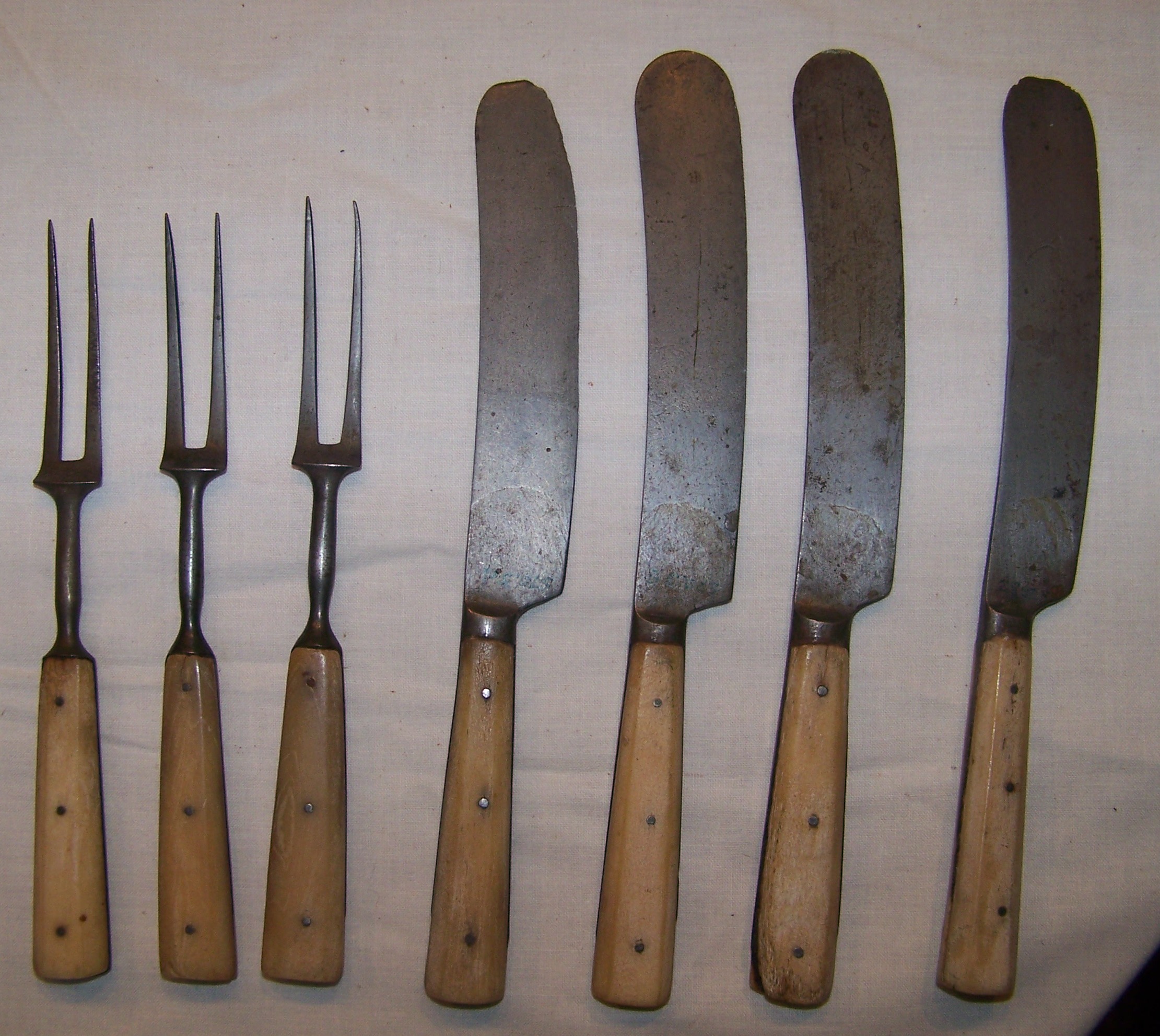 |
after 1809 |
Globe Ibbotson Brothers |
Sheffield, England |
steel, bone |
Knives, about 8-1/4"; forks 6-3/4" |
knive blades marked "GLOBE / IBBOTSON BROTHERS" |
Purchase, 1970 |
Purchased through William C. Kennedy, 5/25/1970 |
0 |
|
|
Four bone-handled dessert knives and three forks; forks have two tines. The handles of each utensil are attached with three steel pins; none have butt plates. |
Ibbotson Bros. & Co., Globe works: makers of steel saws, files and tools. Globe Steel Works, Russell Street Sheffield Yorkshire. Ibbotson Brothers (Globe Works) operated out of Sheffield from before 1828 to after 1900. |
Household Items |
0 |
| TRUE |
Pair of sconces |
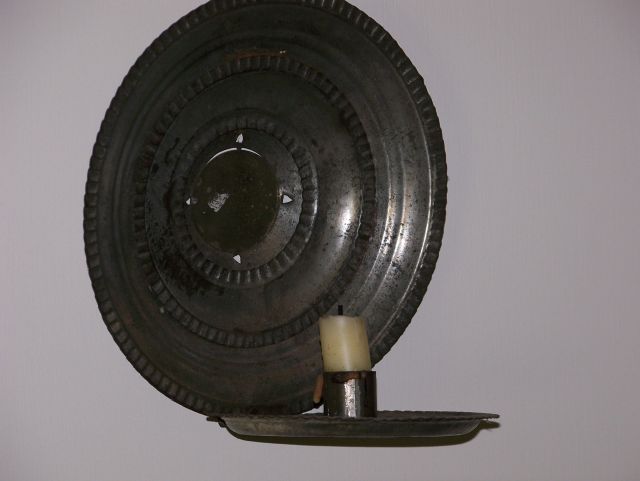 |
1850-1925 |
Unknown |
United States or England |
tin, glass |
8-3/4 x 8 x 4 |
|
Purchase, 1970 |
Purchased through William C. Kennedy, 5/25/1970 for $550.00 |
0 |
|
|
Each sconce has a round stamped tin reflector back having a round mirror in the center. Each back is made of two circular pieces of stamped tin set one within the other. Stamped patterns create three gadrooned rings. A third circular stamping forms the base of the candle holder, which is attached by a tab to the reflector. |
Old Boscobel accession number is B80/2 |
Lighting |
0 |
| TRUE |
Hat box |
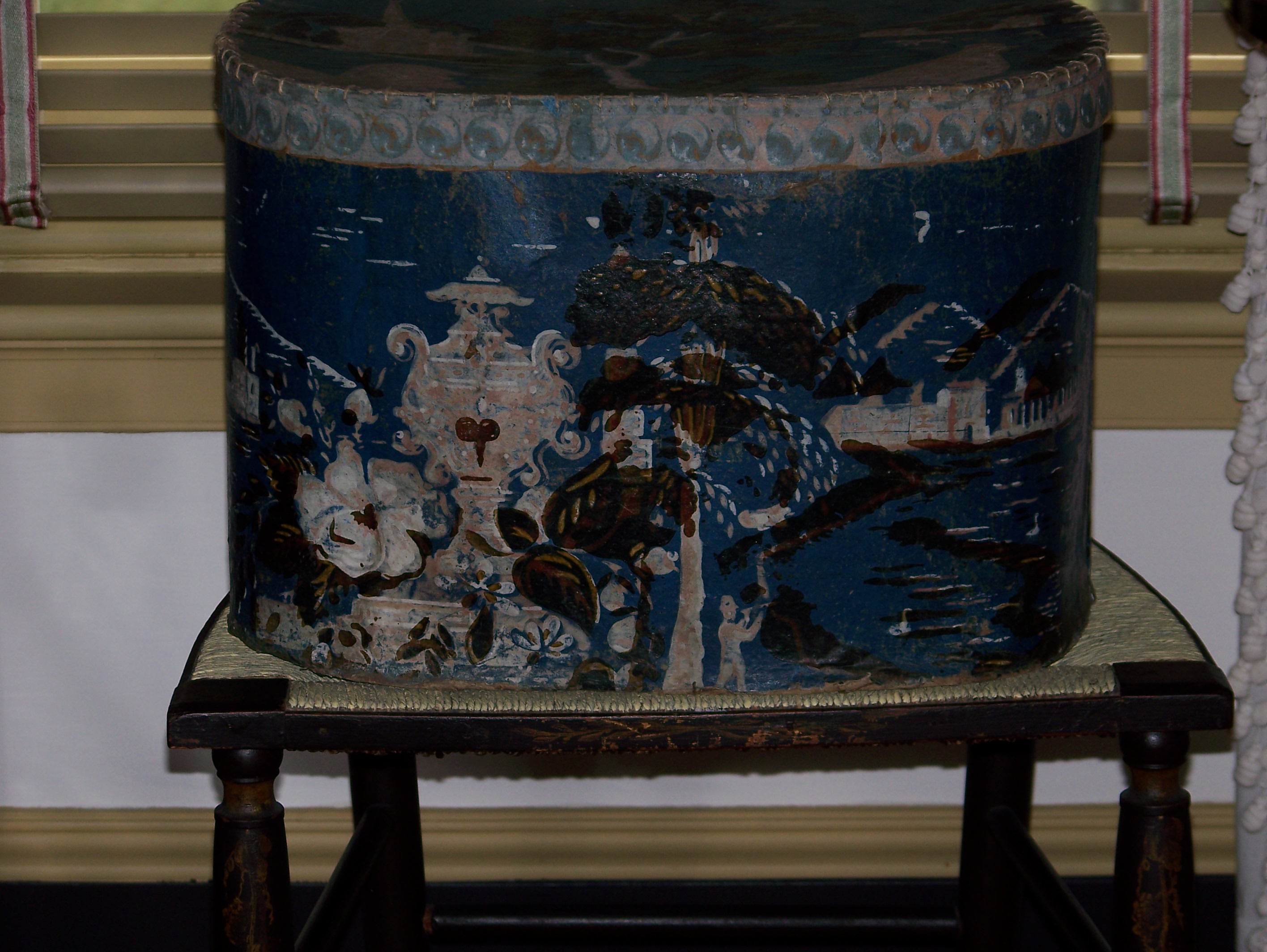 |
Early 19th century |
Unknown |
American |
paper |
H. 10.5"; L. 15.75"; W. 12.5" |
Written in pencil inside cover "Mastin" |
Purchase, 1973 |
Purchased 10/6/1973 from Cal and Bob Smith for $360.00 |
0 |
|
|
Blue pink and wine, rooster, hen and man ploughing on top, sides show man under tree with gun or glass looking across water in which ducks or geese are swimming, at man ploughing. |
LOCATION UPDATE: MOVED TO GUEST ROOM AS OF MARCH 2007 |
Household Items |
0 |
| TRUE |
Hat Box |
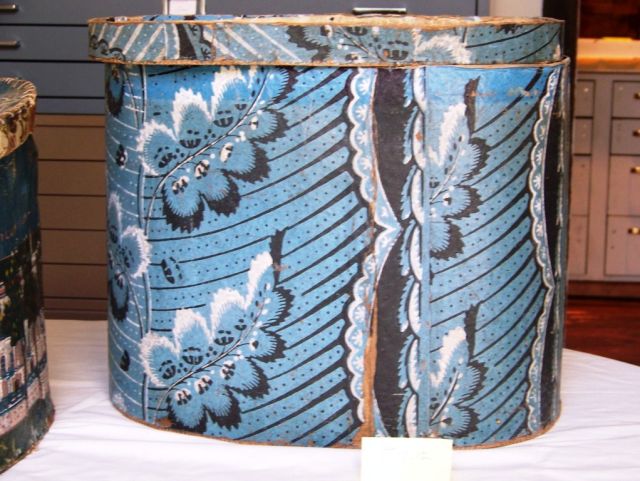 |
Circa 1822 |
Unknown |
American |
Paper |
H. 13 3/4"; L. 18"; W. 13" |
None |
Purchase, Boscobel 1973 |
Purchase at Cal and Bob Smith auction 10/6/1973 for $100.00 |
0 |
Carlisle, Lillian Baker. Hat boxes and band boxes at The Shelburne Museum. |
|
Blue background with lines and dots, "leaf and lace swag" design. Lined with newspapers from both Philadelphia and Boston area in 1822. |
|
Household Items |
0 |
| TRUE |
Urns |
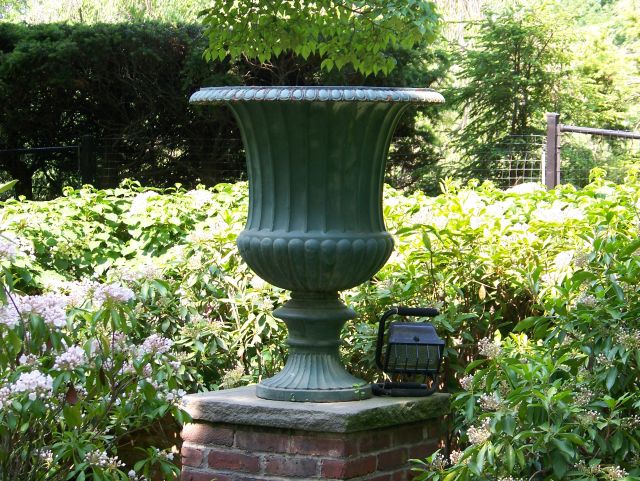 |
1900-1969 |
Unknown |
United States or Europe |
Cast iron |
39 x 32 (dia) |
|
Purchase, 1969 |
Purchased from Ben Garber 10/8/1969 for $4800.00 |
0 |
|
|
5/1/2007: Four large lead urns with wooden loose covers; urns decorated with reverse panels of putti and garlands. 7/29/2009: The large urns have fluted sides with gadrooning on the bottom of the body. They stand on gadrooned reel bases with a mid-ring. Oval bosses decorate the rim. |
|
Outdoor |
0 |
| TRUE |
Urn, garden |
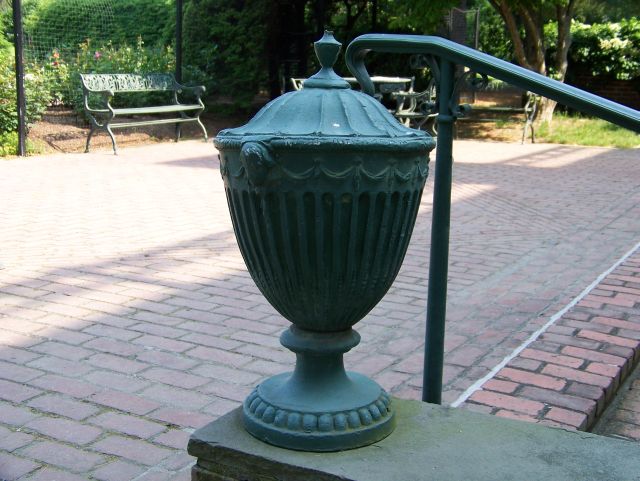 |
Probably 1900-1960 |
Unknown |
United States or Europe |
Cast iron |
23-1/2 x 14 x 13 (dia) |
|
Purchase,1961 |
Purchase, WC Kennedy 6/5/1961 $400.00 |
0 |
|
|
7/29/2009: The fluted lids have urn finials. The fluted bodies have a band of swags just below the rims. Two ram’s heads are cast into opposite sides near the rim. The bodies stand on reels that flare out to a round foot with oval bosses. Painted green. |
|
Outdoor |
0 |
| TRUE |
Easy chair |
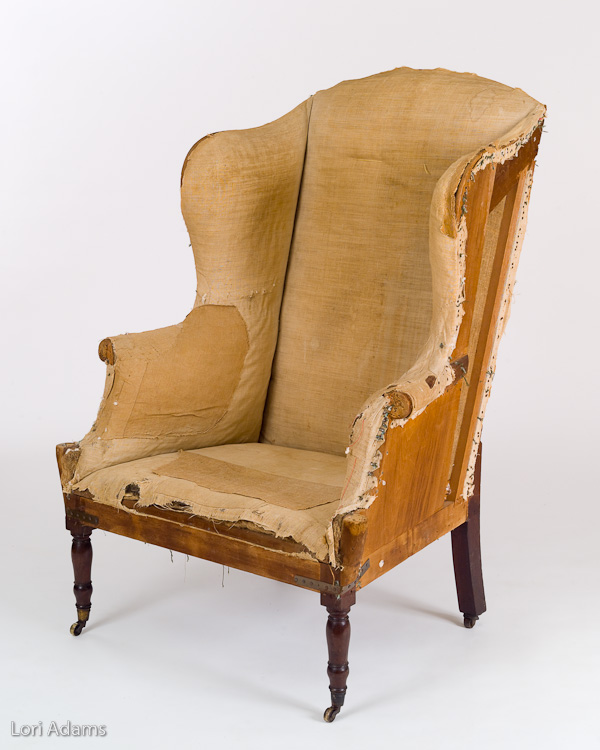 |
1800-1815 |
Unknown |
New York |
Mahogany; cherry (or maple) seat rails and slip seat, white pine frame. |
OH 49, OW 34-1/2, OD 34 |
Paper labels with ink writing record the names E. Emily Hart and Mary A. Hart. |
From the collection of Boscobel Restoration, Inc. |
Acquired from dealer Sanford Levy of New Paltz, New York, who acquired it without provenance in the Ludingtonville, NY area. Paper labels with ink writing record the names E. Emily Hart and Mary A. Hart. Women by those names occur in Christ Church of Poughkeepsie records of 1910. |
0 |
|
Related easy chairs: The closest example is an easy chair sold by Bernard & S. Dean Levy Inc., illustrated and discussed in Mark Anderson and Robert F. Trent, “A Catalogue of American Easy Chairs,” American Furniture 1993, ed. Luke Beckerdite (Milwaukee, Wisc.: Chipstone Foundation, 1993), figs. 24-25, pp. 226-27. Notable similarities include the stiff and vertical shape of the C scroll arms, use of laminations to fill out the vertical cone and horizontal arm roll, and use of a large pine board to form the chair sides. According to Dean Levy, the published chair was known to the authors through photographs only; its current location is unknown. Other similar easy chairs include numbers 123 and 124 in Charles F. Montgomery, American Furniture: The Federal Period (New York: Viking Press, 1966). |
The front leg turnings are a long inverted baluster above a shorter inverted baluster, separated from the top block by a reel. Other New York furniture with this profile includes a set of armchairs made in 1812 by Lannuier for the Common Council Chamber, New York City Hall (Peter M. Kenny, Frances F. Bretter, and Ulrich Leben, Honoré Lannuier: Cabinetmaker from Paris [New York: Metropolitan Museum of Art, 1998], pl. 62) and a sofa attributed by Jones to Phyfe (Edward V. Jones, “Charles-Honoré Lannuier and Duncan Phyfe, Two Creative Geniuses of Federal New York,” American Art Journal 9, no. 1 [May 1977]: fig. 10). The French press at Boscobel (F 76.27, Tracy cat. no. 69) also has similar leg turnings.The easy chair legs stand on brass casters, which appear to be original. That on the proper right front leg has been reinstalled; the earlier screw holes are visible. The proper right front leg has split where the front seat rail tenon enters. The split stops abruptly where the decorative leg turning begins, but grain character continues into the turned section of the leg affirming that it is not a replacement. The joint has been glued relatively recently. Metal straps nailed in place have been added around both front leg stiles to secure the joints. The seat cushion is an upholstered slip seat. The original foundation upholstery remains and includes coarse woven burlap, stuffing of horsehair and tow, and linen. The underside is covered with another piece of burlap, which is an unusual addition but seams to be original. This coarser fabric is similar to the side and back panels of the chair, visible through the frame from the outsides of the chair. As reupholstered in the twentieth century, this chair also had a separate, 3-1/2 inch-high boxed seat cushion. The chair likely had no additional seat cushion originally, since the present upholstered slip seat offers adequate comfort and addition of another cushion raises the seat height significantly higher than the lower, vertical cones of the C scroll arms. Generations of use have probably flattened the loft of the slip seat an inch or so. Removal of the seat cushion exposes a white pine deck nailed to a seat rabbet formed by strips of wood nailed to the insides of the seat rails. A 9-1/2 inch circular wooden lid plugs the center hole. When delivered to Boscobel, the lid was nailed in place. Those nails were removed on September 4, 2009. Wood grain of the lid does not appear to align with that of the deck, although oxidation and tool marks on the underside are generally consistent. The lighter color of the lid may be ascribed to regular washing of the deck but not of the lid. If the lid is not original to this chair, it likely has been associated with the chair for many generations. Originally, the lid probably had a small piece of fabric attached to the center to facilitate removal. All evidence of the fabric is gone, but the nail shaft remains. The undersides of the front and rear seat rails show clear evidence of two rails running front-to-back. The rails were almost certainly rabbeted on the insides to create a track for a sliding frame to hold a chamber pot. A description printed in the 1811 Journeymen Cabinet and Chair Makers Pennsylvania Book of Prices notes a “slider under the frame, to draw out behind, with the pan,” which appears to describe the missing element in this chair. The chamber pot, probably made of pewter, dropped into a hole cut into the sliding frame; the pot was lifted out for emptying and cleaning. (A representative pewter example touchmarked by Frederick Bassett (1740-1800) of New York is in the Yale collection, acc. no. 1931.293. It is 8 inches tall; the diameter of the rim is 12 inches.) A thin strip of wood nailed front-to-back above and inside the missing proper left rabbeted rail remains in place. This single strip probably stabilized the chamber pot by running along the top of the pot rim when it was slid out from underneath the chair. The undercutting of the rear rail appears to be original for several reasons: 1) both front and rear rails exhibit the same square nail holes and glue residue, indicating the original attachment; 2) saw kerfs of the undercutting appear to match saw kerfs where the rear seat rail was notched; and 3) oxidation on the underside surfaces of the rail and the undercut portion appear consistent. The undercutting of the rear rail may have been necessary to allow the chamber pot rim to pass underneath the rail when it was slid back for emptying. The second undercut notch in the center of the rear rail may have provided room for a chamber pot lid of some kind. Both possibilities are speculative since details of the sliding frame and the pot are irretrievably lost. The height of the front rail to the floor is approximately 10-5/8 inches, whereas the height of the rear rail is almost 11 inches. This discrepancy may have been caused by differently designed casters installed in front and rear. It may be resolved by removal of the casters to determine original lengths of the wood legs. |
Conservation issues: Preservation of the foundation upholstery is essential. The back and wings are presently partially detached because of wear from original tacking to the frame. Additionally, linen has worn away from portions of the C scrolls, exposing the hair and tow stuffing. These areas need to be stabilized and protected from further damage. The split in the proper front leg can be reglued, but it appears to be stable as is. The later metal straps are unsightly, but they do not interfere with presentation of the chair. When slip-covered, they will be invisible. If the chair is shown without a slip cover, these repairs can be noted for viewers. Removal of the straps will leave scars that would also require explanation. At some point it may make sense to reconstruct the missing slider and tracks based on existing physical evidence and related examples. A slip cover should probably be made of some kind of printed cotton, tailored to display the wings and C scroll arm shapes, and having a deep ruffle along the entire base that would have hidden the chamber pot, slider rails, and most of the legs. |
Furniture |
0 |
| TRUE |
Pair of side chairs |
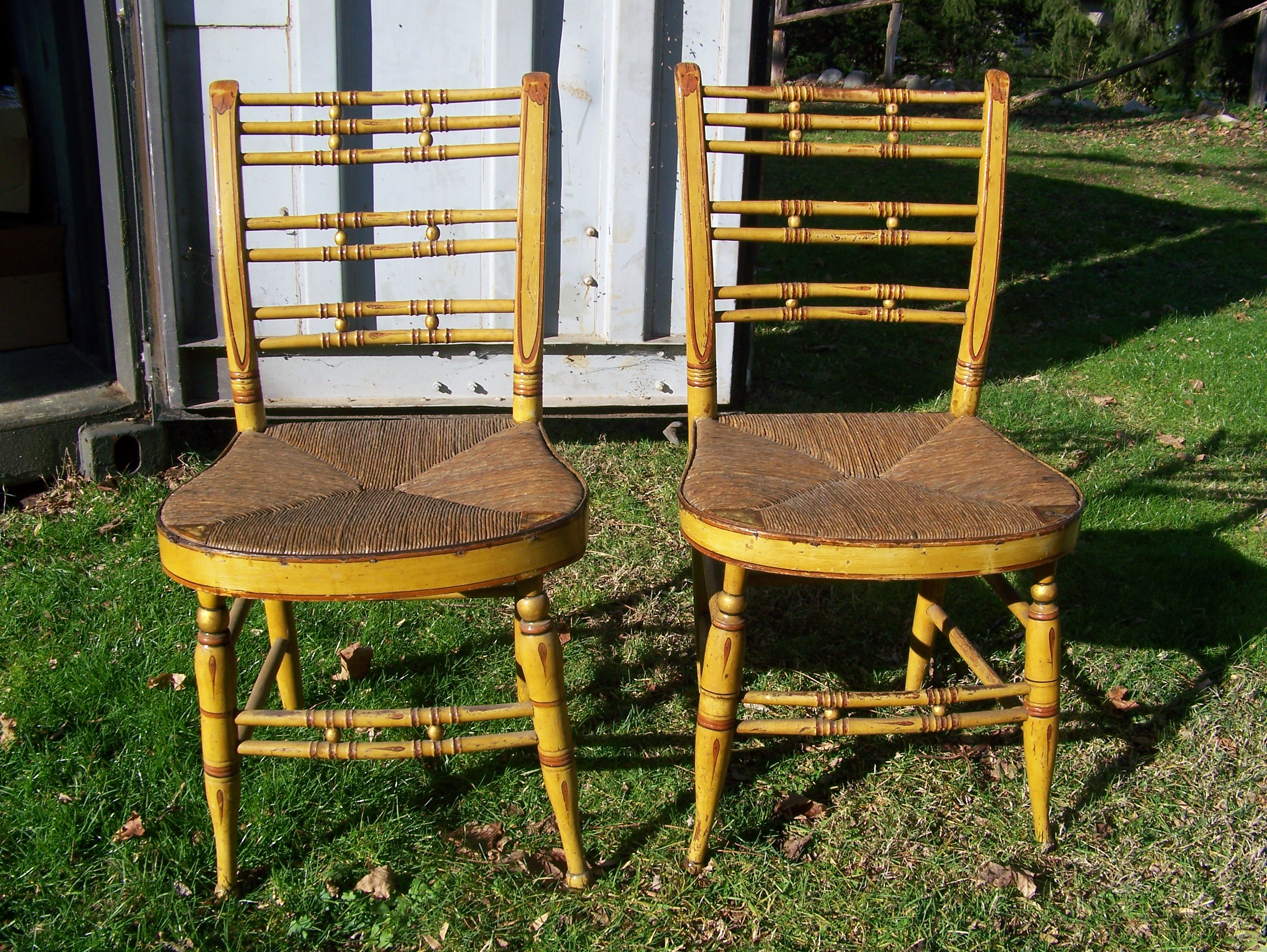 |
1810-20 |
Unknown |
New York |
Maple, ash, rush seat |
33-1/2 x 17-7/8 x 20 |
Marked "#47 6/11/75 Simone Odell" in green paint on inside of rear seat casing. |
Purchase, 2009 |
Acquired from the Odell House, Hartsdale, NY through the Sons of the American Revolution, Inc. Robert Stackpole |
0 |
|
See Nancy Goyne Evans, American Windsor Chairs, p. 217, fig. 5-41. |
The rear posts have flat faces ending in "thumb backs," with three turned cross-pieces at the top and two pairs below. Each of the cross pieces has two pairs of spool turnings; a ball turning separates the cross-pieces at this location. The balloon shape rush seat has thin casings nailed to the outsides. The turned front legs have rings and balls at the top and tapered legs with a slight flare at the feet, which are ball turnings. The pair of turned stretchers in the front mimic the cross-pieces of the back. The chairs have two round stretchers at each side and one in the rear. The chairs are painted a mustard yellow with red highlights outlined in narrow black lines. |
|
Furniture |
0 |
| TRUE |
Urn |
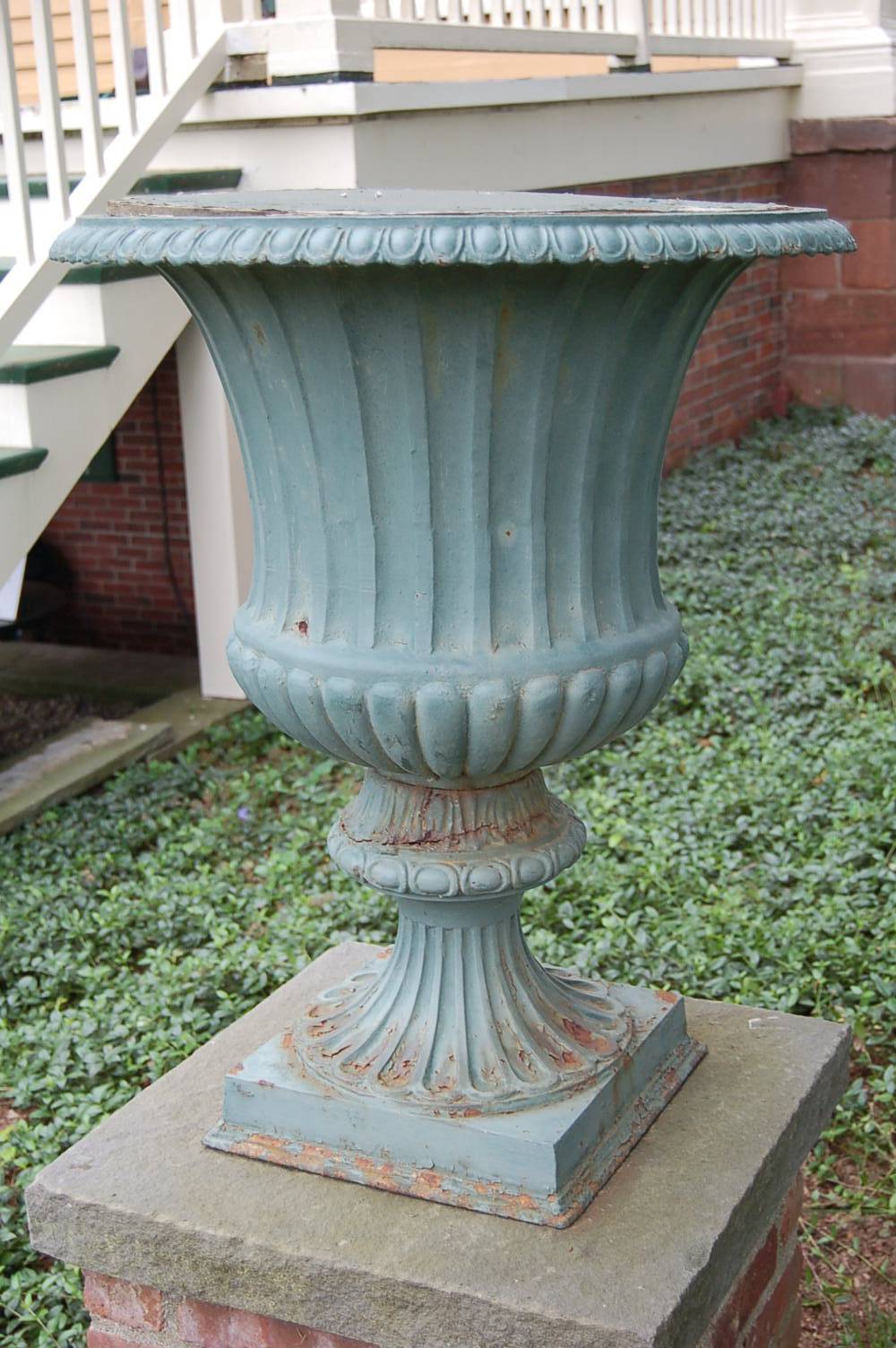 |
1900-1960 |
Unidentified |
United States or Europe |
Cast iron |
31 x 25 (dia) |
|
|
Probably purchased by William Kennedy during the early 1960's [ |
0 |
|
|
The urn has fluted sides with gadrooning on the bottom of the body. The urn sets on a flared and fluted stem with gadrooned ring and leaf-grass at top, all above a square base. Oval bosses decorate the rim. |
Accession number is unknown, painted over. Old accession numbers J 61.42/6 and J 13/6 were assigned to urns but record does not exist to inform which they are. New accession # assigned 8/4/2010 [JP] |
Outdoor |
0 |
| TRUE |
Urns, pair of lidded |
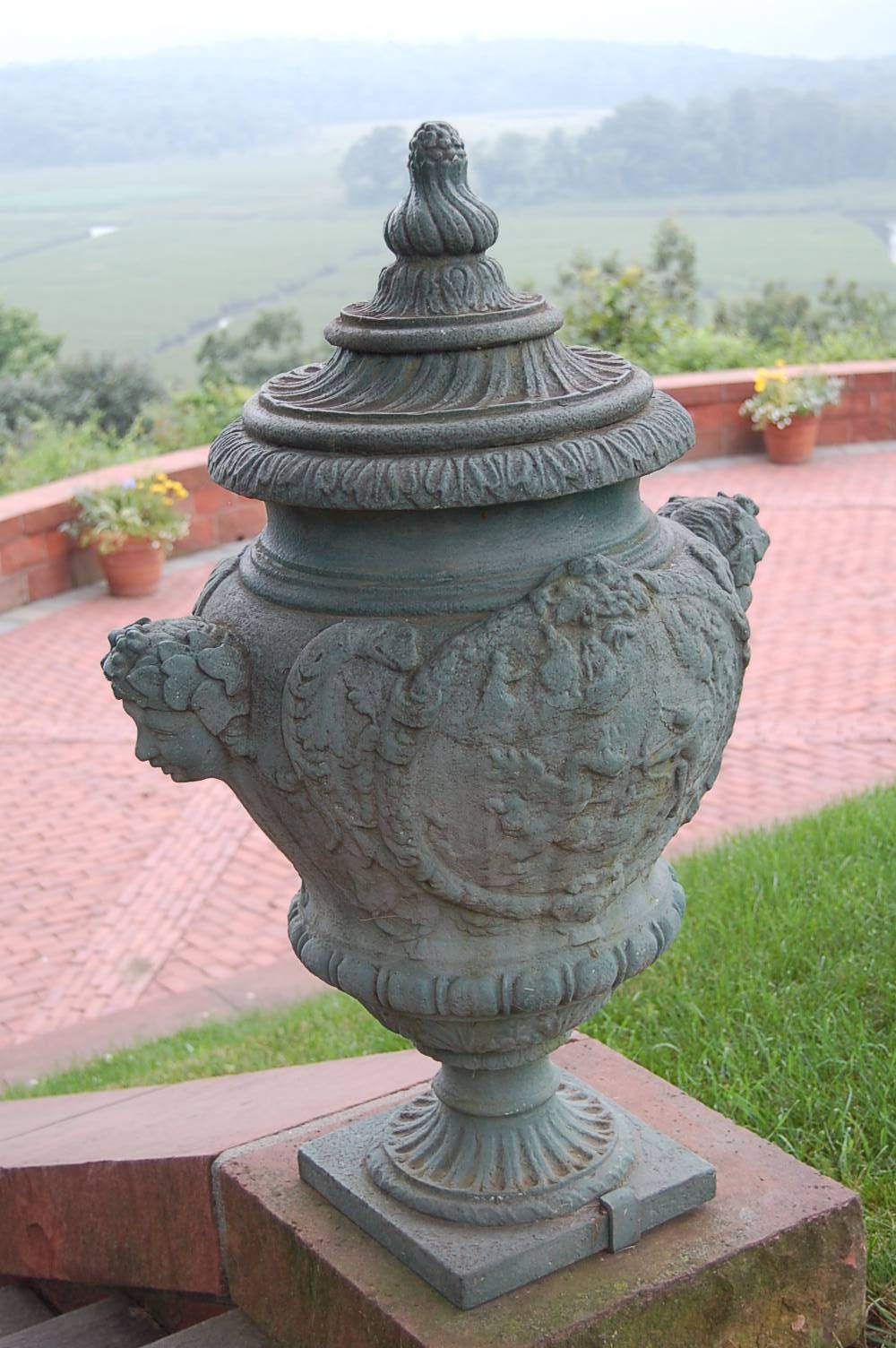 |
1900-1960 |
Unidentified |
United States |
Cast iron |
39-1/2 x 26 x 19 (dia) |
|
|
Possibly through William Kennedy, June 5, 1961 |
0 |
|
|
Two putti heads are cast into opposite sides of the baluster-shaped body. Sides have pictorial panels within floral borders. Swirled finial atop stepped lid. Leaf-grass molding around rim. Oval bosses around bottom of body. Fluted reel foot on square base. Painted pale green. |
No accession number is associated with these urns. New accession number assigned 8/4/2010 [JP] Evidence of number has been painted over. |
Outdoor |
0 |
| TRUE |
Urn |
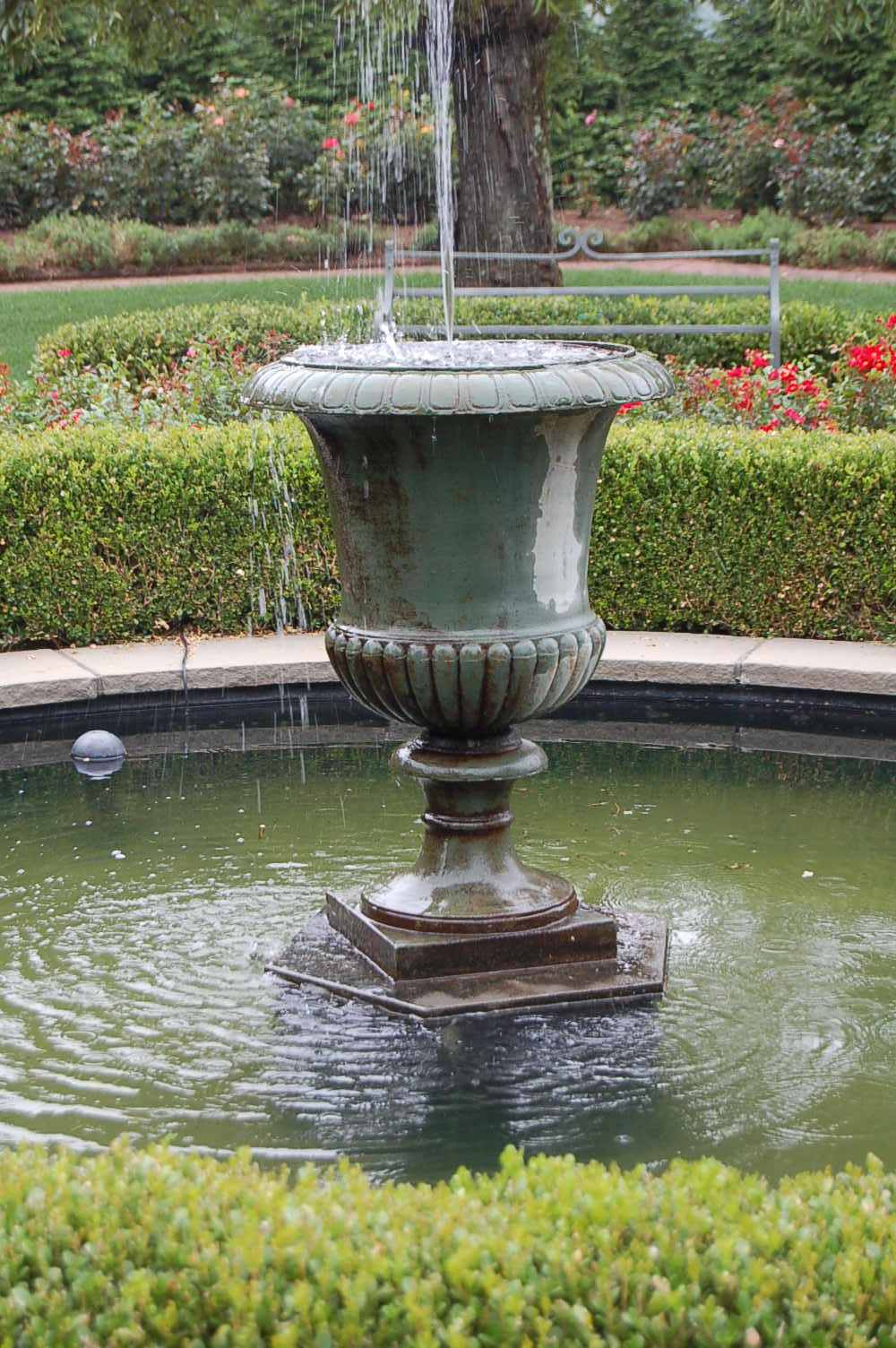 |
1900-1960 |
Unidentified |
United States |
Cast iron |
NOT MEASURED |
|
|
Probably one of the many urns purchased by William Kennedy, June 5, 1961. See invoice in file. |
0 |
|
|
Urn has a ovoid panels around rim and reeding around the bottom of the body, which stands above a reel on a square base. |
No known accession is associated with this urn, it has been painted over. New accession number assigned. |
Outdoor |
0 |
| TRUE |
Side Chair |
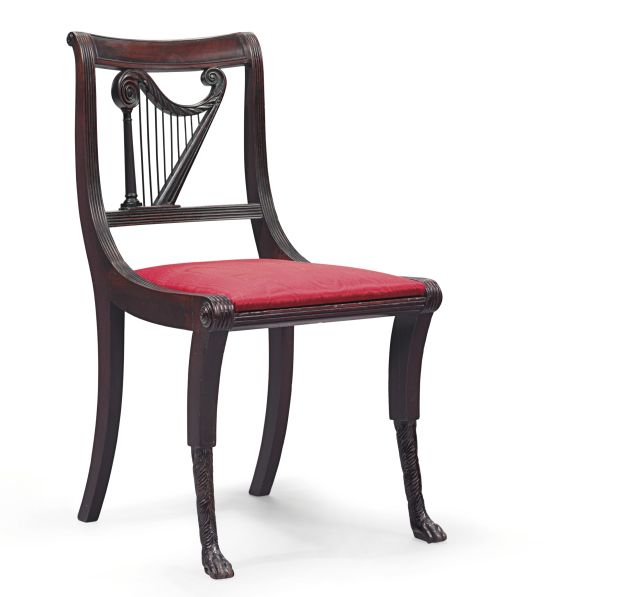 |
1815-1820 |
Unknown, possibly Duncan Phyfe (1770-1854) |
New York City |
Mahogany; front and rear seat rail, ash; brass; reproduction upholstery |
32-3/4" x15" x 18-3/4" |
VII incised on seat and seat rail |
Purchase, 2013 |
Sold, Christie's, New York, 23 January 1988, lot 347 Ronald S. Kane, New York Sold, Christies's, New York, The Ronald S. Kane Collection, 22 January 1994, lot 388 |
0 |
Peter M. Kenny and Michael K. Brown, Duncan Phyfe: Master Cabinetmaker in New York (New York 2011) pp. 189-190 Charles F. Montgomery, American Furniture The Federal Period, (New York 1966) plate 74 |
Sold, Christie's, New York, 25 September 2013, lot 103 One side chair, George and Linda Kaufman Collection at the National Gallery A pair in the collections at Winterthur One at Bayou Bend One at the Metropolitan accession 1972.136 Two offered at Sotheby's New York, 26 September 2008 A pair once owned by Mr. and Mrs. Jennings illustrated in the Girl Scout's Loan Exhibition catalogue |
The crest rail rolls back and is bowed in center. The rear stiles are reeded from the stay rail to the crest with boldly scaled harp back. The reeded seat frame has two front-to-back braces. Original slip seat is covered in reproduction red silk. Standard rear legs and front hairy shanks terminate in paw feet. |
No specific documentation is known that links this chair to Phyfe workshop. |
Furniture |
0 |
| TRUE |
Linen press |
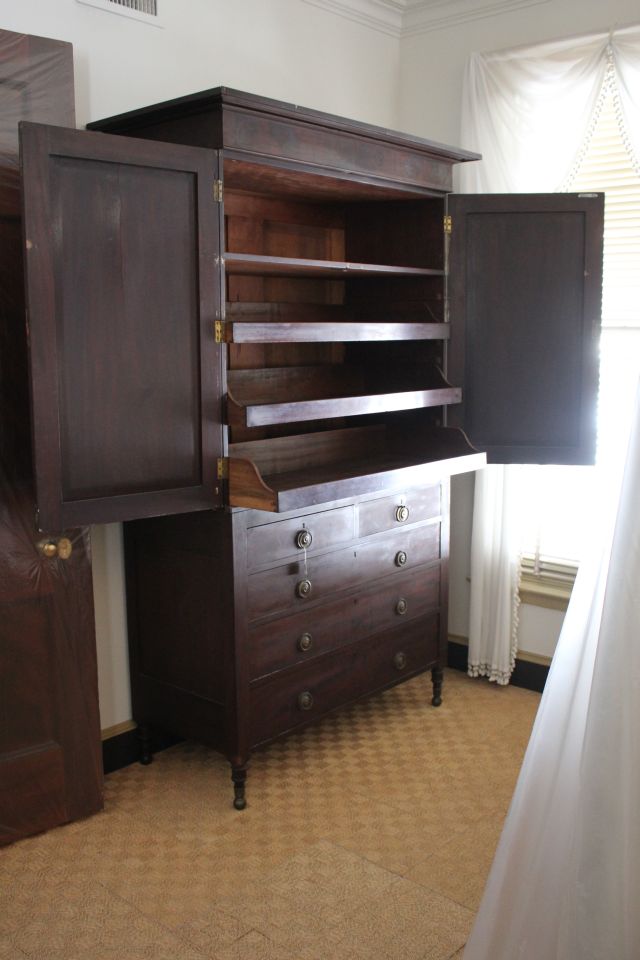 |
c. 1820 |
Duncan Phyfe (1768-1854) |
New York City |
Mahogany, Mahogany veneer |
Overall: 87 1/4 x54 x 25 inches |
|
Gift of funds from Lila Acheson Wallace and others, by exhange |
Descended in the family of Mary Phyfe Whitlock (1795-1870) ( Eldest child of Duncan and Rachel Lowzada (d.1851) Phyfe and widow of Capt. Sydney B. Whitlock (1794-1849)) to Dr. and Mrs. Vincent Giuseffe to Sotheby's Important Americana sale, 1/25/2014, Lot 403 $9,500.00 plus 25% premium =$11,875.00 |
0 |
Peter M. Kenny and Michael K. Brown, Duncan Phyfe: Master Cabinetmaker in New York, (New Haven: Yale University Press for Metropolitan Museum of Art, 2011). Fig. 2.12. p.284 |
Peter M. Kenny and Michael K. Brown, Duncan Phyfe: Master Cabinetmaker in New York, (New Haven: Yale Universtiy Press for Metropolitan Museum of Art, 2011). Fig. 2.18, p. 286; Also see Peter M. Kenny and Michael K. Brown, Duncan Phyfe: Master Cabinetmaker in New York, (New Haven: Yale University Press for Metropolitan Museum of Art, 2011). Fig.81 and 91, Pl.19, 27,30, 31 |
The mahogany linen press is in two pieces. The flat cornice consists of triple reeded moulding and a frieze of book-matched crotch mahogany veneer. The upper case has book matched mahogany veneer doors with cross banding. It has one fixed shelf and three sliding linen drawers. The lower case has two drawers over three full width drawers. The legs with reeded veneered cylinders terminate in brass ball capped feet in the front and turned feet in the rear. |
|
Furniture |
0 |
| TRUE |
Scenice landscape chair, one of six |
|
c. 1815 |
Unknown |
New York |
Maple, paint, unidentified secondary wood, modern upholstery |
|
|
Gift of funds from Lila Acheson Wallace and others, by exhange |
|
|
|
|
|
|
Furniture |
|
| TRUE |
Dressing Table |
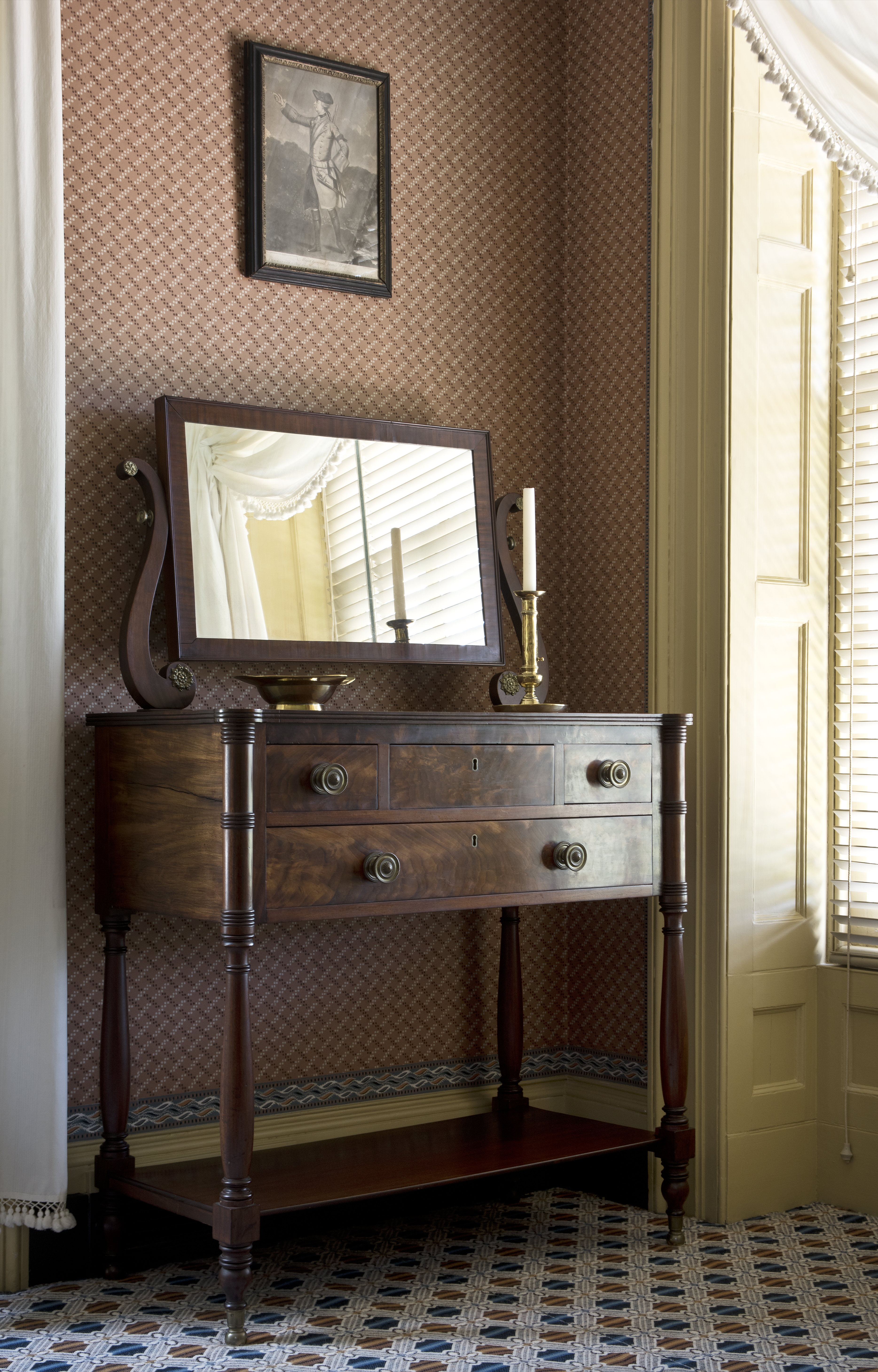 |
|
Duncan Phyfe (1768-1854) |
|
Mahogany, mahogany veneer, brass, looking-glass plate |
58H x 37-1/2W x 18-3/4D |
|
Gift of funds from Barnabas McHenry in honor of Jennifer Carlquist; and others, by exhange |
Bernard and S. Dean Levy (via unknown intermediaries) 2017 Estate of Glorianna Howell Gibbon (c. 1929-2016) by descent: -Virginia Adelaide Vail (1897-1973) and J. Bertram Howell (1893-1968) -Ida Mary McLaurie Vail (1867-1952) and Frederick Percy Vail (1861-1948) -Eliza Phyfe Vail (1803-1890) and William Vail, Jr. (1802-1887) |
0 |
Museum of the City of New York, An Elegant Assortment: The Furniture of Duncan Phyfe and His Contemporaries, 1800 to 1840, 1987 Nancy McClelland, Duncan Phyfe and the English Regency 1750-1830, 1939 |
Winterthur owns this same form without the mirror, formerly owned by collector Louis Guerineau Myers and lent repeatedly to the Metropolitan Museum of Art |
Male dressing table. Mahogany table has a rectangular, adjustable mirror on half-lyre brackets mounted atop a rectangular case holding a long drawer with two pulls and three narrower drawers. The left and right drawers each have one pull and the center drawer has no pull and only opens with a key.The center drawer has three square compartments inside with removable lids. The case has columns that extend down to become the legs. Legs support an open rectangular shelf. Table stands on ball feet. |
|
Furniture |
0 |
| TRUE |
Girandoles- pair |
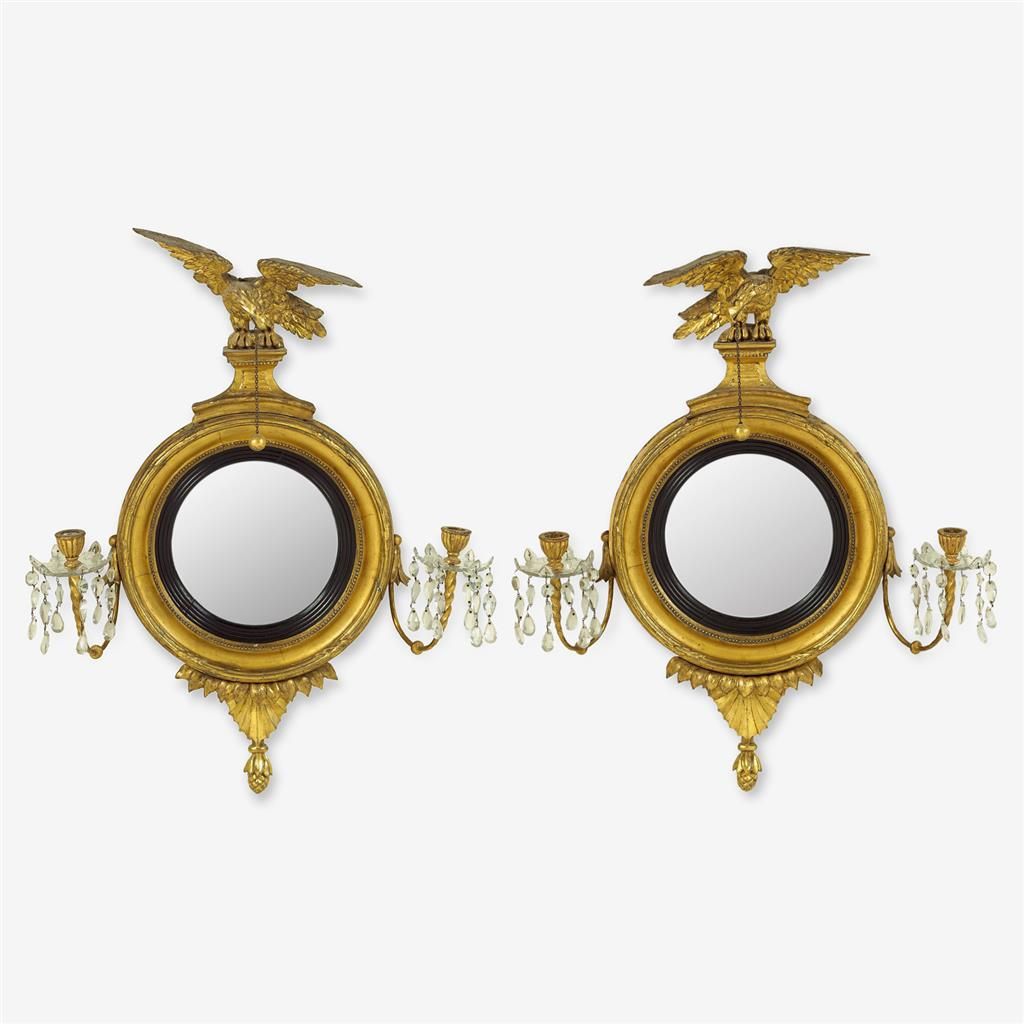 |
about 1810 |
Henry Banks, London |
England |
Mirrored glass, wood, gesso, gilding, blown and cut glass, metal |
28-1/4/29"H x 11-1/2"W x 6-1/2"D |
Signed and inscribed: Henry Marks/CARVER AND GILDER/Looking Glass and Picture Frame/Maker and General Undertaker/93 Blackman St. Boro./Bed and Window Cornices and Gold Mouldings for Rooms/Old frames Regilt, Old Glasses Re-polished & Silvered/on the lowest terms |
Gift of funds from Lila Acheson Wallace and others, by exhange |
-Hirschl & Adler -Freeman's, sale November 13, 2014; lot 284 )10,000-20,000 estimate, realized $31,250) -Louis Alan Tally (Washington, D.C.), c. 1984-2014 -Robert Helyer Thayer, 1959-84. (Thayer, 1901-1984, was Asst. United States Ambassador to France from 1950-54; Minister ot Rumania 1955-58, the Asst. Secretary of State for Cultural and Educational Affairs until 1962.) -Israel Sack, Inc. (recorded on reciept dated April 17, 1959 and correspondence describing the previous owner as "an old time dealer in Philadelphia.") |
0 |
Magazine Antiques, April 1957, inside front cover, advertised (and erroneously described as American) by Sack. |
Many major collections of American Neoclassical decorative arts include large, eagle-crested English mirrors with or without candle arms, including the Metropolitam Museum of Art's Richmond Room (as installed by Berry Tracy and Peter Kenny), Museum of the City of New York, Bartow-Pell Mansion, Gracie Mansion, the White House, Diplomatics Reception Room of the U.S. State Department, Bayou Bend (Houston), Winterthur (Delaware), Historic Odessa (Delaware), Drayton hall (Maryland), Museum of Fine Arts Boston, and the Harrison Gray Otis House (Boston). |
Opposite pair of diminutive girandoles with eagles. One eagle faces left, one eagle faces right. Eagles have chain hanging from beak with a ball on the end of the chain. Convex mirrors with candle branches. Wooden gessoed and gilded with glass drip pans, blown and cut, and glass prisms. Gilt-brass candle cups and bobeches. Convex mirror plate. |
|
Lighting |
0 |
| TRUE |
Piano |
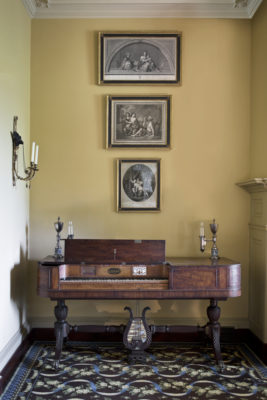 |
c. 1812-1816 |
Thomas Gibson & Morgan Davis; Case possibly Phyfe |
New York |
Mahogany, brass, satinwood, rosewood |
36 1/2" x 71 1/4" x 30" |
Stenciled label: Patent Grand, Gibson & Davis New York |
Gift of Dick Button in memory of Berry Tracy |
Owned by Mr. Richard T. Button Antiques dealers Carl & Celia Jacobs, Deep River, CT. c. 1966 (Advertisement in the Magazine Antiques, October 1966, pg. 446) |
0 |
Advertisement in the Magazine Antiques, October 1966, pg. 446 Girl Scout Loan Exhibition catalog of 1929 (No. 782) Ginsburg & Levy advertisement Magazine Antiques, March 1975, pg. 381 Israel Sack advertisement in the Magazine Antiques, September 1990, pg. C2 (almost identical to the example at the Metropolitan Museum as is the piano at Columbus) |
The Metropolitan Museum of Art (Accession # 63.205)- The Met's piano's dust board is marked: "No. 22 / GD / Bordered with Flowers". The case is attributed to Duncan Phyfe although there is no documentary evidence that supports the theory that Phyfe made cases for any piano makers in New York. Museum of Fine Arts, Houston/ Bayou Bend Collection (Accession # B.57.4) Henry Ford Museum, Dearborn Michigan The Columbus Museum, Columbus, Georgia |
Rectangular satinwood and rosewood inlaid and brass-mounted case of front-corner 'sideboard' design. The cross-banded, hinged top with brass-banded edge and hinged keyboard cover open to an apple-green painted shade board with hand-painted gilt vine and floral border and an ebony and rosewood-inlayed satinwood name board centering an ebonized oval medallion framed with patterned stringing and hand-painted floral garlands bearing the inscription "Patent-Grand,/ Gibson & Davis/ New York.," flanked by open fretwork reserves centering a musical stringed instrument. It is backed by mirrors above the keyboard which has 40 ivory and 28 ebony keys. The case is raised on a trestle or 'cheval' base with water-leaf-carved urn standards at each end above saber legs with water-leaf carving and reeding terminating in brass paw toe caps and casters. The pedestal ends joined below the urns by a turned, reeded and water-leaf carved stretcher. A water-leaf carved and mirror-backed lyre with five brass strings centered on the stretcher and connecting the two foot pedals to the piano. The bottom side of the shade board bears a graphite inscription "G & D no. 47 / /to be bordered with flowers" |
|
Musical Instruments |
0 |
| TRUE |
Bidet |
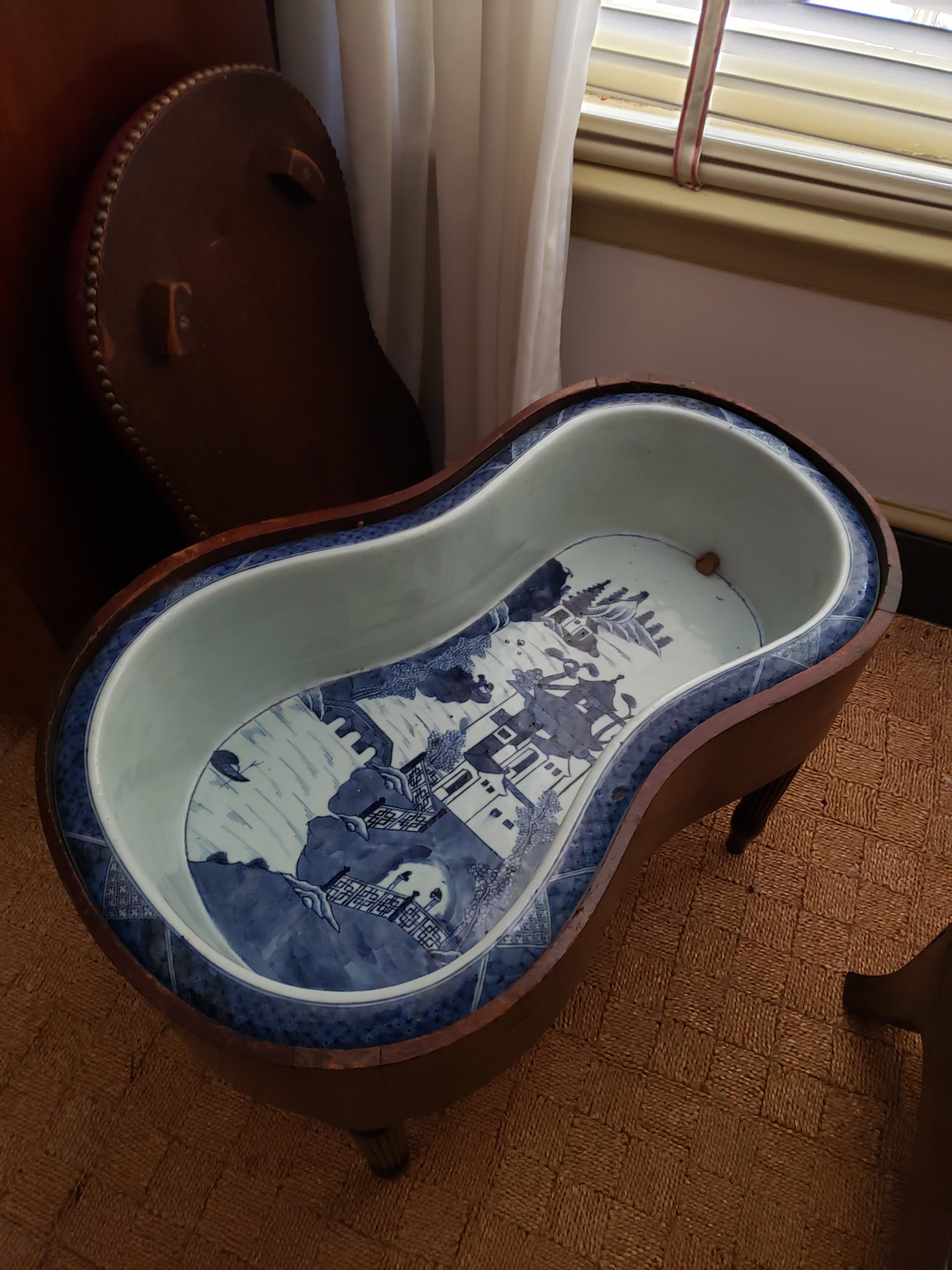 |
c. 1810-1815 |
|
|
Mahogany, secondary woods, porcelain, modern upholstery with brass tacks |
H: 19" W: 25" D: 15.5" |
|
|
Important American Furniture: The Collection of the Late Berry B. Tracy, catalogue of sale 52.85 at Sotheby's, New York, February 1, 1985 |
0 |
Important American Furniture: The Collection of the Late Berry B. Tracy, catalogue of sale 52.85 at Sotheby's, New York, February 1, 1985 |
|
Mahogany secondary construction, with leather-covered cover and original Chinese Export porcelain insert hand-decorated in blue cobalt underglaze |
|
Furniture |
0 |































































































































































































































































































































































































































































































































































































